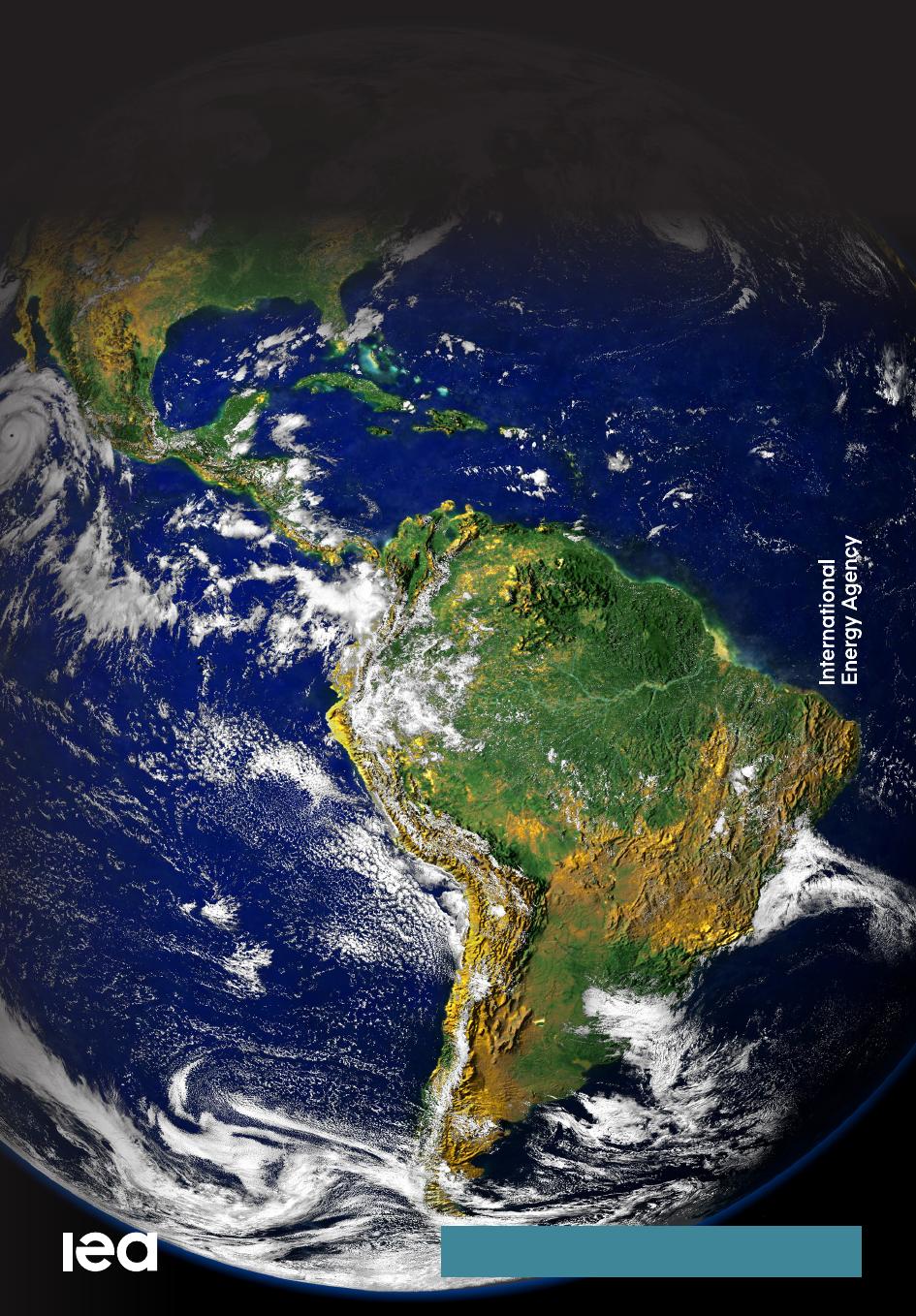LatinAmericaEnergyOutlookWorldEnergyOutlookSpecialReportINTERNATIONALENERGYAGENCYTheIEAexaminestheIEAmemberIEAassociationfullspectrumcountries:countries:ofenergyissuesincludingoil,gasAustraliaArgentinaandcoalsupplyandAustriaBrazildemand,renewableBelgiumChinaenergytechnologies,CanadaEgyptelectricitymarkets,CzechRepublicIndiaenergyefficiency,DenmarkIndonesiaaccesstoenergy,EstoniaKenyademandsideFinlandMoroccomanagementandFranceSenegalmuchmore.ThroughGermanySingaporeitswork,theIEAGreeceSouthAfricaadvocatespoliciesHungaryThailandthatwillenhancetheIrelandUkrainereliability,affordabilityItalyandsustainabilityofJapanenergyinitsKorea31membercountries,Lithuania13associationLuxembourgcountriesandMexicobeyond.NetherlandsNewZealandPleasenotethatthisNorwaypublicationissubjecttoPolandspecificrestrictionsthatlimitPortugalitsuseanddistribution.TheSlovakRepublictermsandconditionsareSpainavailableonlineatSwedenwww.iea.org/termsSwitzerlandRepublicofTürkiyeThispublicationandanyUnitedKingdommapincludedhereinareUnitedStateswithoutprejudicetothestatusoforsovereigntyTheEuropeanoveranyterritory,totheCommissionalsodelimitationofinternationalparticipatesinthefrontiersandboundariesandworkoftheIEAtothenameofanyterritory,cityorarea.Source:IEA.InternationalEnergyAgencyWebsite:www.iea.orgForewordAcrossmanyindicators,theLatinAmericaandCaribbeanregionstandsoutforitsextraordinaryendowmentofnaturalresources–bothfossilfuelandrenewableenergy–anditshistoryofpolicymakingthathasnotablydeliveredoneofthecleanestelectricitysectorsintheworld.Theexpansionofrenewableenergytechnologiessuchashydropowerandbioenergy,initiallydrivenbyanemphasisonenergysecurity,hasmorerecentlybeenpropelledbyadeepeningcommitmenttosustainability.Sixteenof33countriesintheregionhavepledgedtoreachnetzeroemissionsbymid-centuryorearlier,andmosthavepresentedupdatedandincreasinglyambitiousclimatetargetstiedtothe2015Parisclimateagreement.OurLatinAmericaEnergyOutlook,theInternationalEnergyAgency’s(IEA)firstin-depthandcomprehensiveassessmentofLatinAmericaandtheCaribbean,buildsondecadesofcollaborationwithpartnersacrosstheregion.InsupportofLatinAmericaandtheCaribbean'senergygoals,thisreportexplorestheopportunitiesandchallengesthatlieahead,providinginsightsintothewaysinwhichtheregion’senergyfutureandmajorglobaltrendsaredeeplyintertwined.Akeyassetforregionisitslow-emissionselectricitysupply.Thislaysthegroundworkforotherkeyaspectsofenergytransitions,includingextensivecleanmanufacturingofindustrialgoodsandtheproductionoffuelssuchaslow-emissionshydrogen.Resourcesanddeepexpertiseinsustainablebioenergyalsopositiontheregiontoleadonsustainabletransportfuels–athomeandworldwide.Meanwhile,theglobalelectrificationoftransportandexpansionofelectricitygridsisgeneratingaboomindemandforcriticalmineralssuchascopper,lithium,rareearthelementsandgraphite.Theregion’samplereservesofthesemineralsplaceitinpolepositiontoexpandproductiontosupplytheneedsoftheglobalcleanenergytransition,withadditionalpotentialtomoveupthevaluechainintorefiningandprocessing.Reapingthesebenefitswillrequireclearstrategicvision,robustpublicpoliciesandbroadpartnershipsbetweengovernmentsandotherstakeholders.Countriesintheregionneedtodesignandimplementpoliciesandregulationsthatattractsubstantialinvestment,ensuresustainabilityanddeliverjustandequitabletransitions.Thisincludesovercomingremainingenergyaccesschallengeswhilecreatingjobsandspurringinnovationinemergingcleanenergysectors.Oilandgasremainimportantintheregion.Naturalgasbalancessupplyforpowersystemsandisakeyfuelforindustry,whilemostvehiclesontheroadrelyonoil,despitetheprevalenceofbiofuels.LatinAmericaandtheCaribbean–hometoanabundanceofoilandgasresources–willcontinuetoplayavitalroleinsupplyinginternationalmarkets,eventhoughglobaldemandforbothoilandgasisexpectedtopeakthisdecadeundercurrentpolicysettings.Managingthistransitionwillrequiretheco-operationofabroadsetofstakeholdersthatarewillingtoadaptandinnovateaslocalandglobalneedschangeintheyearsahead.IEA.CCBY4.0.Foreword3ThisreportisatestamenttotheIEA’sstrongrelationshipswithcountriesinLatinAmericaandtheCaribbean,includingfivemembersoftheIEAfamily:Argentina,Brazil,Chile,ColombiaandMexico.Furthermore,thisOutlookreflectsinputfromgovernmentofficials,expertsandstakeholdersfrom17countriesacrosstheregion.ItalsoprovidesabasisforourongoingcollaborationwithotherinternationalinstitutionsintheregionsuchastheInter-AmericanDevelopmentBank,theLatinAmericanEnergyOrganization,andtheUnitedNationsEconomicCommissionforLatinAmericaandtheCaribbean.IwouldliketowarmlythanktheIEAcolleagues–ledbyStéphanieBouckaertandBrentWanner–whocarriedouttheresearch,modellingandanalysisthatresultedinthisimportantmilestoneinourAgency’sworkwiththeregion,whichwillcontinuetoexpandinthecomingyears.Ilookforwardtofurtherregionalandbilateralco-operationinspiredbythefindingsofthisreport.TheIEAstandsreadytosupportcountriesacrosstheregionastheyadvancetheircleanenergytransitions,buildingamoresecureandfairerglobalenergysystemintheprocess.DrFatihBirolExecutiveDirectorInternationalEnergyAgencyIEA.CCBY4.0.4InternationalEnergyAgencyLatinAmericaEnergyOutlookAcknowledgementsIEA.CCBY4.0.ThisstudywaspreparedbytheWorldEnergyOutlook(WEO)teamintheDirectorateofSustainability,TechnologyandOutlooks(STO)inco-operationwithotherdirectoratesandofficesoftheInternationalEnergyAgency(IEA).ThestudywasdesignedanddirectedbyLauraCozzi,Director,Sustainability,TechnologyandOutlooks.Theleadauthorsandco-ordinatorsoftheanalysiswereStéphanieBouckaertandBrentWanner.JoergHusarledoninstitutionalrelations,withsupportfromAlejandraBernal.ThereportbenefitedfromsupportandinputsfromtheInter-AmericanDevelopmentBank.PrincipalIEAauthorsofthereportwere:OskarasAlšauskas(transport),LucilaArboleyaSarazola(leadoninvestment),DanielCrow(leadonclimatemodellingandland-usesector),JulieDallard(leadonChapter5,power),AmritaDasgupta(leadonChapter1,criticalminerals),TomásDeOliveiraBredariol(leadonfuelsupply,criticalminerals),EricFabozzi(power),VíctorGarcíaTapia(buildings,energyefficiency),BrunoIdini(people-centredtransitions),JavierJorqueraCopier(regionalpowerintegration),MartinKueppers(leadonChapter2,industry),JenniferOrtiz(water),DianaPerezSanchez(leadonpolicies,industry),ApostolosPetropoulos(leadonChapter5,leadontransport),AmaliaPizarro(leadonhydrogen),MaxSchoenfisch(power,hydrogen),RyotaTaniguchi(power,climatepolicy),NataliaTriunfo(transport),andAnthonyVautrin(demand-sideresponse).Otherkeycontributorswere:YasmineArsalane,PraveenBains,ClaraCamarasa,PedroCarvalho,OliviaChen,YunyouChen,ChiaraD’Adamo,DavideD'Ambrosio,MichaelDrtil,JérômeHilaire,PaulHugues,HyejiKim,YunYoungKim,PeterLevi,JinsunLim,YannickMonschauer,JeremyMoorhouse,AnaMorgado,MaximilianOlmosVanVelden,AlessioPastore,FrancescoPavan,MatthieuPrin,ArthurRogé,GabrielSaive,LeonieStaas,MatthieuSuire,GianlucaTonolo,ChristophWinklerandPeterZeniewski.MarinaDosSantosandRekaKoczkaprovidedessentialsupport.EdmundHoskercarriededitorialresponsibility.DebraJustuswasthecopy-editor.ValuablecommentsandfeedbackwereprovidedbyotherseniormanagementandnumerousothercolleagueswithintheIEA.InparticularMaryWarlick,AraceliFernández,RebeccaGaghen,TimGould,TimurGül,DennisHesseling,PabloHevia-Koch,Tae-YoonKim,ChristopheMcGlade,BrianMotherway,UweRemme,ThomasSpencerandDanielWetzel.ThanksgototheIEACommunicationsandDigitalOfficefortheirhelpinproducingthereportandwebsitematerials,particularlytoJethroMullen,PoeliBojorquez,CurtisBrainard,JonCuster,HortensedeRoffignac,AstridDumond,MerveErdil,GraceGordon,JuliaHorowitz,OliverJoy,IsabelleNonain-Semelin,JuliePuech,RobertStone,SamTarling,ClaraVallois,LucileWall,ThereseWalshandWonjikYang.IEAOfficeoftheLegalCounsel,OfficeofManagementandAdministrationandEnergyDataCentreprovidedassistancethroughoutthepreparationofthereport.Acknowledgements5ValuableinputtotheanalysiswasprovidedbyAnaLepure,LuizGustavoSilvadeOliveiraandDavidWilkinson(independentconsultants).SupportforthemodellingofairpollutionandassociatedhealthimpactswasprovidedbyPeterRafaj,GregorKiesewetter,LauraWarnecke,KatrinKaltenegger,JessicaSlater,ChrisHeyes,WolfgangSchöpp,FabianWagnerandZbigniewKlimont(InternationalInstituteforAppliedSystemsAnalysis).Valuableinputtothemodellingandanalysisofgreenhousegasemissionsfromlanduse,agricultureandbioenergyproductionwasprovidedbyNicklasForsell,ZuelcladyAraujoGutierrez,AndreyLessa-Derci-Augustynczik,StefanFrank,PekkaLauri,MykolaGustiandPetrHavlík(InternationalInstituteforAppliedSystemsAnalysis).TheIEACleanEnergyTransitionsProgramme–theflagshipinitiativetotransformtheworld’senergysystemtoachieveasecureandsustainablefutureforall–supportedthisanalysis.ThanksalsogototheLatinAmericanEnergyOrganization(OLADE)andtheUnitedNationsEconomicCommissionforLatinAmericaandtheCaribbean(UNECLAC).AdditionalsupportwasprovidedbytheInter-AmericanDevelopmentBank’sseniormanagement,inparticularArielYépezGarcía(Manager,InfrastructureandEnergySector)andMarcelinoMadrigal(Head,EnergyDivision).PeerreviewersManyseniorgovernmentofficialsandinternationalexpertsprovidedinputandreviewedpreliminarydraftsofthereport.Theircommentsandsuggestionswereofgreatvalue.Theyinclude:IEA.CCBY4.0.OscarÁlamosISAINTERCHILETúlioAlvesComisiónDeIntegraciónEnergéticaRegionalCarlosAresAsociaciónArgentinadeHidrógenoKimberlyBallouUSDepartmentofEnergyGustavoBarbaránSecretaríadeEnergía,ArgentinaEstebanBarrantesMinisteriodeAmbienteyEnergía,CostaRicaLuizBarrosoPSR-EnergyConsultingandAnalyticsHarmeetBawaHitachiEnergyIsabelBeltranGlobalEnergyAllianceforPeopleandPlanetIlseBerdellansEscobarInternationalAtomicEnergyAgencyFernandoBrangerCAFBancodeDesarrollodeAmericaLatinaLucianoCaratoriInstitutoyFundaciónTorcuatoDiTellaJorgeCárcamoMinistryofEnergyofHondurasJoanaChiavariClimatePolicyInitiative(CPI/PUC-Rio)FionaClouderClouderVista6InternationalEnergyAgencyLatinAmericaEnergyOutlookIEA.CCBY4.0.SuaniCoelhoUniversidadedeSãoPauloPatriciaColaferroAlacero,AsociaciónLatinoamericanadelAceroManlioCovielloTERNAPlusGustavoNaciffdeAndradeEnergyResearchOfficeNelsonDelgadoAsociaciónMexicanadeEnergíaSolarFotovoltaica,A.C.NicolasDiSbroiavaccaFundaciónBarilocheEstebanEcheverríaAlianzaporelHidrógenoRamónFiestasLatinAmericaCommitteeoftheGlobalWindEnergyCouncilEdwardEnriqueFuentesMinisteriodeEnergíayMinasdeGuatemalaSebastianGalarzaCentroMovilidadSostenibleElbiaGannoumBrasilianAssociationofWindEnergyCarlosGaribaldiRegionalAssociationofOil,GasandBiofuelsSectorCompaniesinLatinAmericaandtheCaribbeanFelipeGonçalvesGetulioVargasFoundationPatriciaCostaGonzalezdeNunesEnergyResearchOfficeFrancescaGostinelliENELAndreaHeinsWorldEnergyCouncilArgentineCommitteeSebastianKindGreenmapMarcosKulkaH2ChileAntonioLevyGermanAgencyforInternationalCooperationRosilenaLindoNationalEnergySecretariatofPanamaFernandoLlaverSplightAlvaroLorcaPontificiaUniversidadCatólicadeChileAidaLorenzoBioenergyCommunityofPractice/LEDSLACNatachaMarzolfInter-AmericanDevelopmentBankAlbertMeloRiodeJaneiroStateUniversitySebastianNietoParraOECDDevelopmentCentreLuisAlbertoOrjuelaLópezMinisteriodeMinasyEnergíadeColombiaBrendanOviedoPeruvianRenewableEnergyAssociation–AsociaciónPeruanadeEnergíasRenovablesCamiloPabónInternationalTransportForumGiovanniPabónTransformaJuanRobertoParedesInter-AmericanDevelopmentBankGlennPearce-OrozSustainableEnergyforAllJoaquínPerezTorresSecretaríadeEnergíaJoséIgnacioPerez-ArriagaComillasPontificalUniversity'sInstituteforResearchinTechnology,SpainAcknowledgements7VickyPollardDGforClimateAction,EuropeanCommissionRayénQuirogaComisiónEconómicaparaAméricaLatinayelCaribeVanderleiaRadaelliInter-AmericanDevelopmentBankRicardoRaineriPontificiaUniversidadCatólicadeChileAndresRebolledoOrganizaciónLatinoamericanadeEnergíaCarlaRequeMinisterioDeHidrocarburosYEnergías,BoliviaMauricioRoitmanITBAUniversityAnaLíaRojasAsociaciónChilenadeEnergíasRenovablesyAlmacenamientoMarinaRueteInternationalInstituteforSustainableDevelopmentCarlosSalgadoUnitedNationsDevelopmentProgrammeIgnacioSantelicesAsociacióndeDistribuidorasdeEnergíaEléctricaLatinoamericanasClaudioSeebachGeneradorasdeChile/WorldEnergyCouncilRoxanaSerpaVargasIndependentConsultantPaulSimonsYaleUniversityLeonardoStanleyCentrodeEstudiodeEstadoySociedadWilmarSuárezC40CitiesJavierToroCabreraComisiónNacionaldeEnergía,ChileJoaquinUboguiMcKinsey&CoPatriciaVenturaNicolasIPDLatinAmericaArnaldoVieiradeCarvalhoEsconsultInternationalCarlosVillalobosUniversidaddeTalcaVeronicaVukasovicGermanAgencyforInternationalCooperation,Chile/H2LACVirginiaZalaquettPontificiaUniversidadCatólicadeChileTheworkreflectstheviewsoftheInternationalEnergyAgencySecretariat,butdoesnotnecessarilyreflectthoseofindividualIEAmembercountriesorofanyparticularfunder,supporterorcollaborator.NoneoftheIEAoranyfunder,supporterorcollaboratorthatcontributedtothisworkmakesanyrepresentationorwarranty,expressorimplied,inrespectofthework’scontents(includingitscompletenessoraccuracy)andshallnotberesponsibleforanyuseof,orrelianceon,thework.Thisdocumentandanymapincludedhereinarewithoutprejudicetothestatusoforsovereigntyoveranyterritory,tothedelimitationofinternationalfrontiersandboundariesandtothenameofanyterritory,cityorarea.IEA.CCBY4.0.8InternationalEnergyAgencyLatinAmericaEnergyOutlookCommentsandquestionsarewelcomeandshouldbeaddressedto:LauraCozziDirectorateofSustainability,TechnologyandOutlooksInternationalEnergyAgency9,ruedelaFédération75739ParisCedex15FranceE-mail:weo@iea.orgMoreinformationabouttheWorldEnergyOutlookisavailableatwww.iea.org/weo.IEA.CCBY4.0.Acknowledgements9TableofContentsForeword.................................................................................................................................3Acknowledgements.................................................................................................................5Executivesummary...............................................................................................................151Stateofplay211.1Overview.......................................................................................................221.1.1Economic...........................................................................................241.1.2Demographics....................................................................................311.2Investmentandfinancing..............................................................................331.2.1Investment.........................................................................................331.2.2Financing............................................................................................351.3Energyandemissionstrends.........................................................................371.3.1Energydemand..................................................................................371.3.2Electricitygeneration.........................................................................421.3.3Resourcesandsupply........................................................................441.3.4Environment......................................................................................491.4Energypovertyandaffordability...................................................................521.4.1Accesstomodernenergy..................................................................521.4.2Affordabilityandinequality...............................................................531.5Energypolicies,climatepledgesandNationallyDeterminedContributions562Energyandemissionsoutlook612.1Introduction...................................................................................................632.1.1Populationandeconomicgrowth.....................................................652.2Totalenergysupply.......................................................................................672.3Finalenergyconsumption.............................................................................722.3.1Transport...........................................................................................732.3.2Industry..............................................................................................782.3.3Buildings............................................................................................842.4Electricitysector............................................................................................882.4.1Electricitydemand.............................................................................882.4.2Electricitygeneration.........................................................................912.4.3Installedpowercapacity....................................................................93IEA.CCBY4.0.2.4.4Powersectorinvestment...................................................................942.4.5Powersystemflexibility.....................................................................95TableofContents112.5Energyproduction.........................................................................................972.5.1Fossilfuels.........................................................................................972.5.2Bioenergyandhydrogen.................................................................1022.6Emissionsandairpollution..........................................................................1052.6.1Energy-relatedCO2emissions..........................................................1052.6.2Airpollution.....................................................................................1063Keyareasforpolicyaction1093.1Sustainableurbantransportandcities........................................................1113.1.1Developlow-carbonurbanmobility................................................1123.1.2Urbanairpollution..........................................................................1143.2Tapintoenergyefficiencypotential............................................................1173.2.1Potentialoffueleconomytoreducetransportoildemand............1183.2.2Buildingenergycodesandminimumenergyperformancestandardsforappliances..................................................................1193.2.3Increaseefficiencyinnon-energy-intensiveindustries...................1223.3Criticalminerals:amajorcontributortoglobalmineralsecurityandregionaleconomicgrowth...........................................................................1233.3.1Supplyprospects..............................................................................1233.3.2Responsibleandsustainablemining................................................1263.3.3Movingalongthesupplychain........................................................1273.4Hydrogen:Anewenergyfrontier................................................................1293.4.1Demandoutlookforlow-emissionshydrogenandhydrogen-basedfuels......................................................................1303.4.2Low-emissionshydrogenproduction..............................................1343.5People-centredtransitions..........................................................................1373.5.1Energyaccess...................................................................................1373.5.2Energyaffordability.........................................................................1403.5.3Employmentintheenergysector...................................................1413.6Electricitysecurityandregionalpowerintegration....................................1443.6.1Rationaleforhigherregionalpowerintegration.............................1453.6.2Benefitsandchallengestoenhanceregionalpowerintegration....1483.7Transitionsinproducereconomies.............................................................1503.7.1Balanceshort-andlong-termdemandoutlook...............................150IEA.CCBY4.0.3.7.2Reducegreenhousegasemissions..................................................1533.7.3Diversifyeconomies.........................................................................15512InternationalEnergyAgencyLatinAmericaEnergyOutlook3.8Bioenergy:Asustainableopportunity.........................................................1563.8.1Liquidbiofuels.................................................................................1563.8.2Biogasandbiomethane...................................................................1613.8.3Bioenergysupply.............................................................................1633.9Achievenetzeroemissions:Investmentandfinance.................................1643.9.1Sourcesoffinance...........................................................................1653.9.2Challengesandwaystomobilisemoreinvestment........................1674Implicationsforglobaltransitionsandenergysecurity1714.1RoleofLatinAmericaandtheCaribbeaninshapingglobalenergytrends.1724.1.1Energydemand................................................................................1724.1.2Energy-relatedCO2emissions..........................................................1744.1.3Greenhousegasemissionsfromlanduseandagriculture..............1754.2RoleofLACinachievingglobalcleanenergytransitionsandsupportingenergysecurity............................................................................................1784.2.1Diversityoffossilfuelsupply...........................................................1784.2.2Low-emissionshydrogen,hydrogen-basedfuelsandrelatedproducts..............................................................................1834.2.3Criticalminerals...............................................................................1905Regionalandcountryenergyprofiles193Introduction.........................................................................................................193LatinAmericaandtheCaribbean.........................................................................194Argentina..............................................................................................................200Brazil.....................................................................................................................206Chile......................................................................................................................212Colombia..............................................................................................................218CostaRica.............................................................................................................224Mexico..................................................................................................................230Notes....................................................................................................................236AnnexesAnnexA.Tablesforscenarioprojections............................................................................241AnnexB.Definitions............................................................................................................255AnnexC.References...........................................................................................................277IEA.CCBY4.0.TableofContents13ExecutiveSummaryLatinAmericaandtheCaribbeaniswellplacedtothriveastheworldmovesintoacleanenergyageHowLatinAmericaandtheCaribbeanusesitsvastresourceswillshapetheregion’senergyfutureandtheroleitplaysintheglobalenergysystem.LatinAmericaandtheCaribbeanencompassesaregionthatisbothlargeanddiverseintermsofeconomicdevelopmentandnaturalresources.Itisrichinfossilfuelsandrenewableenergy,aswellascriticalminerals.WhetheritisharnessingbiofuelsinBrazil,hydropowerinBrazil,Venezuela,Mexico,Colombia,ArgentinaandParaguay,orhigh-qualitysolarandwindresourcesinBrazil,Mexico,ChileorArgentina;producingcopperorlithiuminChile,PeruandArgentina,mineralsessentialtocleanenergytechnologies;ortappingthevastoilandnaturalgasresourcesinVenezuela,Brazil,Colombia,Argentina,MexicoorGuyana,LatinAmericaandtheCaribbeaniswellplacedtothriveascleanenergytransitionsmoveforwardandtocontributetoglobalenergysecurityandclimategoals.Fossilfuelsaccountforaroundtwo-thirdsoftheregion’senergymix,considerablylowerthanthe80%globalaverage,thankstothe60%shareofrenewablesinelectricitygeneration.Hydropoweraloneaccountsfor45%ofelectricitysupplyintheregion.InCostaRicaandParaguay,almostallelectricitysupplyisfromrenewablesources.Fossilfuelsdominateinmanyend-usesectors,andoilisnotablytheprimaryfuelusedintransport.However,theshareofbiofuelsinroadtransportistwicetheglobalaverage.LatinAmericaandtheCaribbeanaccountedfor5%ofallglobalenergy-relatedgreenhousegas(GHG)emissionssince1971,whilerepresenting9%ofglobalGDPovertheperiod.Today,theregionisanetexporterofcrudeoilandcoal,butanetimporterofoilproductsandnaturalgas.LatinAmericaandtheCaribbeantodayrepresents8%oftheglobalpopulationand7%oftheglobaleconomy,butitcanplayanoutsizedroleinthenewenergyeconomy.Withlargeoilandgasresources,theregioncanhelpdiversifyoilandgassupplyinthenearterm.Itisalsomakingstridesindevelopingandexportingadvancedbiofuelsandlow-emissionshydrogen,andisrampinguptheproductionofcriticalmineralsessentialtocleanenergytechnologies.Theregionhasalltheingredientsforsecure,affordableandrapidtransitions.Moreover,successinLatinAmericaandtheCaribbeancanbringmanybenefitstotheworld.CleanenergytransitionsofferopportunitiesforstrongereconomicgrowthTheeconomyinLatinAmericaandtheCaribbeanisemergingfromaperiodofsluggishgrowthoverthepasttenyears.Theregion’srateofexpansionhasbeenathirdoftheglobalaverageduringthisperiod.Substantialdebtburdens,fiscaldeficits,highinflationandtheglobalenergycrisishaveallputbrakesoneconomicgrowth.Thishasgeneratedechoesoftheso-called“lostdecade”inthe1980swhenregionalGDPgrewslowlyamiddebtcrisesandfallinginvestment.IEA.CCBY4.0.ExecutiveSummary15Strongereconomicgrowthcanbeunlockedwithsoundenergypoliciesandresourcedevelopments.Economicgrowthisexpectedtopickupinthenextdecadetomorethantwicetherateofeconomicdevelopmentobservedoverthepastdecade,ascountriesstrengthentheirindustrialandservicessectors,focusonhighervalueproducts,andleveragetheregion’svastenergyandmineralresources,whichwillalsoboosttheeconomiccompetitivenessofenergy-intensivesectors.Arangeofmeasuresareneededtoattractforeigndirectinvestment,suchasimplementingclearregulatoryframeworks,streamliningadministrativeproceduresandworkingcloselywithdevelopmentinstitutions.OurLatinAmericaEnergyOutlook2023–thefirstIEAoutlookfortheregion–containsin-depthcountryandregionalanalysisofenergyandclimatetrends,identifyingopportunitiesandkeychallenges,asmorerobustgrowthreturns.Thisreportexploresthreescenarios.ItfocusesontheStatedPoliciesScenario(STEPS),reflectingtoday’spolicysettings,andtheAnnouncedPledgesScenario(APS),whichassumesallpledgesandtargetsareachievedinfullandontime,includingclimategoalsestablishedbyNationallyDeterminedContributions.TheAPSalsoreflectsthenetzeroemissionspledgesmadeby16countries–AntiguaandBarbuda,Argentina,Barbados,Brazil,Chile,Colombia,CostaRica,Dominica,DominicanRepublic,Grenada,Guyana,Jamaica,Panama,Peru,SurinameandUruguay–whichtogethercover60%ofenergy-relatedcarbondioxide(CO2)emissionsandtwo-thirdsofGDPintheregion.ProgressisalsobenchmarkedagainsttheNetZeroEmissionsby2050(NZE)Scenario,whichlaysoutapathwaytodecarbonisetheglobalenergysystembymid-century.IEA.CCBY4.0.Cleanelectricityprovidesaspringboardfortheregion’stransitionAmplerenewableresourcespresentanopportunitytomaketheelectricitysectorinLatinAmericaandtheCaribbean–alreadyoneofthecleanestintheworld–evencleaner.Renewableelectricitysourcesoutpaceelectricitydemandgrowthinallscenarios,raisingtheirshareofelectricitysupplyfromjustover60%todaytotwo-thirdsin2030and80%in2050withtoday’spolicysettings.Hydropower,thefoundationoftheregion’selectricitysupplyfordecades,providesthebulkofelectricitytodayinBrazil,Colombia,CostaRica,Ecuador,Panama,ParaguayandVenezuela.Whileitsgrowthprospectsaremorelimitedinthefutureduetoenvironmentalandsocialconcerns,hydrorepresentsahugesourceofflexibility.ThiswillbecriticalastheshareofsolarPVandwindinelectricitygenerationdoublesby2030,from11%today,andreaches40%by2050.Brazil,Mexico,ChileandArgentinaareleadingthewayinsolarPVandwinddevelopment.Naturalgascontinuestogenerateaboutaquarterofelectricityto2030,whilecoalandoildeclinerapidly.IntheAPS,theregionacceleratestheshifttorenewables,exceedinga70%sharein2030,10yearsbeforetheSTEPS,andover90%in2050.Regionalintegrationoffersadditionalsecurityandcostbenefitsastheelectricitymixevolves.Whilethebenefitsarewellunderstoodandprogresshasbeenmadewithbilateralinterconnectionsandjointlyownedpowerplants,cross-borderelectricitytraderemainslimitedtoday.OuranalysisfindsthatthebenefitsofstrongerregionalintegrationinLatinAmericaandtheCaribbeanwillincreaseduetoseveralfactors:linkingcountrieswith16InternationalEnergyAgencyLatinAmericaEnergyOutlookdifferentsharesofwindandsolarPVreducesflexibilityneeds;tappingawidersetofdispatchableresourcesimprovestheflexibilityofsupply;andlinkingelectricitydemandandsupplyfromdifferentclimatezonesprovidesmoreresiliencetochangingconditions.ElectricitybecomesmorecentraltotheregionaleconomyandisthefastestgrowingfinalformofenergyinLatinAmericaandtheCaribbean.Electricitydemandgrowsby90%to2050withtoday’spolicysettingsandby180%tofulfilallpledgesandtargets,whichdoublestheshareofelectricityintotalfinalconsumption.Cheaprenewablesintheregiongiveelectricityacostadvantageinmanyapplicationsoverotherfuels,particularlynaturalgasinimportingcountries.IntheAPS,themaindriverofelectricitydemandgrowthishydrogenproduction,followedbybuildings(includingforappliancesandairconditioners),theelectrificationoftransport(withalmost16millionelectricvehicles,includingbuses,ontheroadsby2030),andgrowthinindustrytoproducecleanerironandsteel,aluminiumandchemicals.Peakelectricitydemandrisesevenfasterthanaveragedemandinbothscenarios,highlightingtheneedfordispatchablecapacityandstoragetomaintainelectricitysecurity.IEA.CCBY4.0.PoliciesdeterminethepathaheadfortheenergymixinLatinAmericaandtheCaribbeanToday’spolicysettingssetacourseformodestgrowthinfossilfueluseintheregioninthelongterm,complementedbyrenewableenergy.Astotalenergydemandoutpacesthegrowthoffossilfuels,theirshareoftheenergymixfallsfrom67%todayto63%in2030and54%in2050.Onthispath,oiluseseesmodestgrowth,remainingfarandawaythedominantfuelintransport,despitemorebiofuelsuseandelectricvehiclesgainingtraction.Naturalgasalsocontinuestogrow,withnewdemandfromindustryproducingchemicals,ironandsteelinMexico,ArgentinaandBraziladdingtogrowinguseintransportandbuildings,andstabledemandintheelectricitysector.Coalremainsasmallpartoftheenergymixintheregionasdemandforitdeclines,withreductionsintheelectricitysectorinChile,BrazilandMexicopartlyoffsetbyhigheruseinindustry.Despitethegrowthinfossilfuels,renewablesmeetthevastmajorityofnewenergydemandintheregionwithtoday’spolicysettings–ledbytheexpansionofrenewableelectricity,plusadoublingofbiofuelsuseintransportandgreateruseofbioenergyinindustry.Thisraisestheshareofrenewablesfrom28%in2022toover40%in2050.FulfillingallpledgesandtargetsontimesetsoutadifferentpathwayforLatinAmericaandtheCaribbean,leadingtoadeclineinfossilfueluseinfavouroflow-emissionssources.Onthispath,consumptionofeachfossilfuelpeaksthisdecadeandthensteadilydeclines.Theuseofoiliscutbymorethanhalfby2050,withmostreductionsintransportduetoincreasedavailabilityofpublictransit,electricvehicles,efficiencygainsandcleanerfuels.Brazilleadsthewayonexpandingsustainablebiofueluse,whileChileandMexicogrowtheirelectricvehiclefleets.Onthispath,naturalgasuseintheregiondeclinesbyone-thirdby2050,withthelargestreductionsinthepowersectorinArgentina,Brazil,Mexico,ChileandColombia.Decarbonisingelectricityinthesecountriestofulfilpledgesandtargetsisalsothemaindriverfordeepercoalreductionsandfasterrenewablesgrowthintheregion.ExecutiveSummary17Energyefficiencymeasuresinthebuildings,transportandindustrysectorskeepenergydemandgrowthincheckwhiledeliveringawiderangeofsocialbenefits.Todate,energyefficiencypoliciesarenotwidespreadintheregion.Lessthanathirdofcountrieshaveminimumenergyperformancestandardsinplaceforindustrialmotorsorhouseholdappliancesandfewhavemandatorybuildingenergycodes.Bettercoverageofperformancestandardsacrosssectors,tighterfueleconomystandardsandupdatedenergy-relatedbuildingcodescutfinalenergyconsumptiongrowthbyafifthin2030.Adoptingthebestavailabletechnologiesforproductssuchasairconditioners,moderatesenergydemandgrowthatlittleornocosttoconsumers.IEA.CCBY4.0.LargeresourcesenableadynamicanddiversifiedtraditionalandcleanerfuelsupplyintheregionLatinAmericaandtheCaribbeanproducedover8millionbarrelsofoilperday(mb/d)in2022,exceedingregionaldemandwithaproductionvalueofUSD230billion,withmoreresourcesavailabletostepupproduction.Thelargestproducersofoilintheregioncurrently-Brazil,Mexico,Colombia,Venezuela,andArgentina–areatvariousstagesofresourcedevelopment.InVenezuelaoilproductionhasdeclinedbythree-quarterssince2010;conventionalsourcesinArgentinashowsignsofdecline;outputinBrazilincreasedbycloseto40%since2010andproductionrecentlystartedinGuyanaafterasurgeofoffshorediscoveries.Includingthose,theregionholdsabout15%ofworldoilandgasresources.To2030,oilproductionintheregionoutpacesdemandgrowth,addingabout2mb/dofnetexports.BrazilandGuyanabothincreaseoilproductionbymorethan1mb/d,givingthemtwoofthetop-threelargestincreasesinnetexportsintheworldto2035.However,anynewprojectswouldfacemajorcommercialrisksiftheworldisontracktodelivernetzeroemissionsby2050,asoildemanddeclinesrapidly.Theregionproducedabout5%ofglobalnaturalgasin2022butwasanetimporterofgasanditremainssointheoutlookdespitelargeresources.Naturalgasproductiondeclinesslightlyto2030intheregionundertoday’spolicysettings,raisingnetimports.Ifpledgesandtargetsaremetinfull,includingtoreduceflaringandmethaneemissions,naturalgasproductiondeclinessteadilybutdemandfallsfaster,particularlyafter2030,reducingimportneedsby30billioncubicmetres(bcm)in2050fromtheleveltoday.Argentinaexpandsgasproductioninbothcasesbyexploitingunconventionalresources,withmostofthegasconsumedintheregion.Productionfallsinseveralothercountries,notablyTrinidadandTobago.Argentina,Brazil,Mexico,ColombiaandVenezuelaallhavemoregasresourcesthatcouldbeexploitedifwarrantedbyhigherdemand,attractivemarketpricesandlower-than-expectedproductioncosts.LatinAmericaandtheCaribbeanhashugepotentialtoexpandtheproductionoflow-emissionsfuels.Bioenergyisagrowingindustryintheregionandbiofuels,inparticular,canhelpmeetbothenergysecurityandclimatetargets.Brazilisaprominentproducerandconsumerofbiofuels,withbioethanolusedheavilyinroadtransport.Withfurtherpolicysupport,biogasandbiomethaneusecouldalsoexpandinelectricitygenerationand18InternationalEnergyAgencyLatinAmericaEnergyOutlooktransport.Advancedbiofuelshavesignificantpotential,asaneconomiccompetitiveexportofbiojetkerosene.Withabundantrenewableenergyresources,theregionhasthepotentialtobecomeamajorproduceroflow-costandlow-emissionshydrogenandrelatedfuels,particularlyinArgentina,Brazil,ColombiaandChile.Therearealreadyannouncementsforsignificantlow-emissionshydrogenprojects.Beyondtraditionalapplicationsforhydrogenlikerefiningandchemicals,low-emissionshydrogenwouldalsoenableemissionsreductionsinotherindustryapplications.Forexample,developingcost-competitivelow-emissionsironcouldprovideamajorboosttotheregionaleconomyandattractforeigninvestment.GlobaltransitionsopenlargemarketsforLatinAmericaandtheCaribbeanSignificantmineralresourcesofferopportunitiestodiversifyglobalsupplyanddelivereconomicgrowthwhileenablingglobalcleanenergytransitions.Theregionhasathirdormoreoftheglobalreservesforlithium,copperandsilver.Revenuefromcriticalmineralsproduction(graphite,bauxite,nickel,zinc,lithium,copperandneodymium)totalledaroundUSD100billionin2022.IntheAPS,itovertakesrevenuefromfossilfuelproductionbefore2050.Exportsofcopperandlithiumaresettobeespeciallysignificant:copperasanessentialcomponentofelectricitynetworks,whichneedtobestrengthenedandexpanded,andlithiumtodrivetheuptakeofelectricvehiclesandbatterystorageasmorevariablerenewablesareintegratedintopowersystems.Theregionhasresourcesthatpositionitwellforachangingenergysystem,fromtightoilandshalegastorenewables,mineralsandmetals.Progressingfromrawmineralandoreexportsupthesupplychaintoproducerefinedandprocessedmaterialscanbenefittheregion’seconomyandfostertechnologydevelopment.Producersneedtobeagileandreadmarketswelltotakeadvantageofnewopportunities.Inallcases,highstandardsofenvironmental,social,governanceissues–includingattentiontomethaneemissions–willmakeahugedifferencetoprospects.Tofulfilnationalgoalsandseizeglobalopportunities,theregionmustclosepolicygaps,raiseinvestmentandputpeopleatthecentreofitsstrategiesThereisasignificantimplementationgapinLatinAmericaandtheCaribbean,astoday’spolicysettingsleadtorisingCO2emissionswhileclimatepledgescallfordeepcuts.PolicygapsneedtobefilledtobridgethegapbetweentheCO2emissionstrajectoryintheSTEPS,whichrisesfrom1660milliontonnes(Mt)todayto1850Mtin2050,andthatintheAPS,whereemissionsfallbelow800Mtby2050.Ouranalysispointstorenewables,electrification,energyefficiencyandothermeasurestoreducedemandasthekeyareasformoreattentionfrompolicymakersandstrongerimplementationmeasures.BeyondtacklingCO2emissions,majorproducersintheregioncanreducemethaneemissionsfromoilandgasoperationsbynearly80%atlowcost,andaround40%withnonetcosts,supportingtheGlobalMethanePledgethatmostcountriesintheregionhavesigned.IEA.CCBY4.0.ExecutiveSummary19Alongsideenergy,approachestocutemissionsintheregionmustalsogiveseriousattentiontolanduseandagriculture.Today,landuseandagricultureproduce45%ofregionalGHGemissions.Afterdecadesoftreecoverloss,pledgesintheAPSleadtoan80%reductioninprimaryforestdeforestationby2030andnetforestgrowthof100millionhectaresby2050.Togetherwithimprovedresourcemanagementpractices,landuseandagriculturereachnetzerogreenhousegasemissionsby2030,withafforestationeffortsinBrazilandMexicoplayingakeyrole.Investmentincleanenergyneedsamajorboosttoreachtheenergy-relatedemissionsreductionsgoalsandtopursueinternationalopportunities.IntheAPS,cleanenergyinvestmentdoublesby2030toUSD150billionandrisesfivefoldby2050.Theratioofinvestmentincleansourcestounabatedfossilfuelsrisesfromaround1:1todayto4:1inthe2030s.Attractingprivatecapitalwillbecriticaltoachievethis,butchallengesincludehighfinancingcosts,politicalandregulatoryinstability,andlimiteddomesticcreditcapacity.Overcomingthesehurdlesrequiressupportivepolicies,tailoredsolutionssuchashedginginstruments,andmoreconcessionalfinancing,especiallyforenergyefficiencyandemergingtechnologies.Apeople-centredandinclusivetransitioncallsforuniversalaccesstomodernenergyataffordableprices.LatinAmericaandtheCaribbeanhasoneofthehighestlevelsofincomeinequality,withtherichest10%ofthepopulationaccountingfor40%oftotalemissions.About17millionpeopleremainwithoutaccesstoelectricityand74millionlackaccesstocleancooking.Moreneedstobedonetoachieveuniversalaccessonbothfronts.Affordableenergyisalsoakeyconcern.Afastertransitiontocleanenergycouldreduceenergycostsforhouseholds,makingiteasiertoendfossilfuelsubsidies.However,lowerincomegroupsmayneedsupportgiventhehigherupfrontcostsofsomecleanenergytechnologies.Cleanenergytransitionsalsooffernewemploymentopportunitiesforworkersintheregion,withenergyjobssettoincreasebyover15%to2030,notablyincleanenergytechnologiesandinthecriticalmineralsector.IEA.CCBY4.0.20InternationalEnergyAgencyLatinAmericaEnergyOutlookIEA.CCBY4.0.Chapter1StateofplayAglobalcleanenergypowerhouse–readytoshiftgearsSUMMARY•LatinAmericaEnergyOutlook2023isthefirstIEAoutlookfortheregion.Itcontainsin-depthcountryandregionalanalysisoftheenergyoutlook,opportunitiesandkeychallengesinthisvastanddiverseregionwhichishometoabout8%oftheworldpopulation,7%ofglobalGDPandaround6%ofglobalenergysupplyanddemand.•LatinAmericaandtheCaribbean’s(LAC)economyisnaturalresourceintensive,anditshighlevelofdependenceontheseresources,suchasfuelsandminerals,exposesitseconomytovolatilityininternationalmarketsandpricecycles.Pursuingopportunitiesinthenewenergyeconomycouldhelpboostitseconomicdevelopment.Itslow-emissionspowersector,criticalmineralresourcesandpotentialforcleanenergydevelopmentmeanthattheregioncouldplayakeyroleincleanenergytransitions.Highenvironmental,socialandgovernance(ESG)standardsareneededtosustainablyharnessthisopportunity.•LACisrichinenergyresourcesrangingfromhydropowertounconventionalgas.Thereissignificantpotentialforfurtherdevelopmentofbioenergyandhighqualitysolarandwindresources.Brazil,Mexico,Argentinaandothersaremajoroilandgasproducers.Someproducersfacedecliningproduction,suchasVenezuela,whileothersareseeingasurgeofnewsupply,suchasGuyana.Colombiaisthemaincoalsupplierintheregion,andChile,Peru,ArgentinaandBrazilproducelargevolumesofcriticalmineralssuchaslithium,copperandgraphite.•Theregionaccountsforjust5%ofglobalcumulativeenergy-relatedgreenhousegasemissionstodate.Thisreflectsthelongstandingrelianceoftheelectricitysectoronhydropower.Butfossilfuelsarestillthemainsourceofenergy,andoilremainsthedominantfuelinmanycountries,primarilyforuseintransportandindustry.•LAChasoneofthehighestlevelsofincomeinequalityintheworld.Thisisevidentintheenergy-relatedemissionsprofileinwhichtherichest10%ofthepopulationaccountfor40%oftotalemissionswhileabout17millionpeopleremainwithoutaccesstoelectricity.Ajusttransitioncallsforuniversalaccesstomodernenergyataffordablepricesandshouldinvolvecommunitiesandethnicgroups.•Halfofthecountriesintheregionhavepledgedtoachievenetzeroemissionsbymid-centuryorearlier.Theyrepresentaround65%ofGDPintheregionand60%ofitsenergy-relatedCO2emissions.Theregionneedstoboostinvestmentincleanenergytechnologiestoreachitsenergy-relatedemissionsreductionsgoals.Effortstoreduceemissionsintheregionmustalsolooktoagricultureandland-usechange,whichaccountrespectivelyfor25%and20%ofitstotalgreenhousegasemissions.Thishighlightstheimportanceoftacklingdeforestation.Chapter1Stateofplay211.1OverviewLatinAmericaandtheCaribbean(LAC)isadiverseregionwhichishometoabout8%oftheworldpopulationandgeneratesabout7%ofglobalgrossdomesticproduct(GDP).Around8%ofthepopulationisindigenous.Theregioncoversabout15%oftheearth’slandsurfacefromMexicotothesoutherntipofPatagonia.ItincludesmajoranddiverseecosystemssuchastheAmazonRiverBasin,Andesmountains,AtacamaDesert,LlanosandPampasgrasslands,andthehighlandsofBrazilandGuyana.Ithasoneofthehighestratesofurbanisationintheworld,82%,andmostofitscitiesandeconomicactivityareconcentratedalongthecoasts.LACcountriesareresponsibleforabout6%oftotalglobalenergysupply,demandandrelatedemissions.Renewables,mainlyhydropower(45%),generateover60%ofitselectricity,makingitspowersectoroneoftheleastcarbonintensiveintheworld.InCostaRicaandParaguay,almost100%ofelectricitysupplyisfromrenewablesources(Table1.1).Theregionhasaburgeoningbioenergyindustrywhichexpandedby30%inthelastdecade.Renewablespresentabigopportunityfortheregion.Ithasextensivecoastlinesforwindpower,amplesunshineforsolar,highgeothermalpotentialalongtheAndes,andmightyriversforhydropower.However,makingthemostofthispotentialrequiresrenewablepowertobetransferredoverlargedistancesanddifficultterrainfromthelocationsofthebestrenewableresourcestothecentresofpopulationandeconomicactivity.Intheelectricitysector,investmentinrenewableshashistoricallybeenhigherthanforfossilfuels,butoverallinvestmentinoilandnaturalgassupplyremainshigherthanallspendinginthepowersector,althoughthegapisnarrowing.LACholds15%ofglobaloilandgasresources,andlessthan1%ofglobalcoalresources.Itisalsohometolargeunconventionaloilandgasresources,suchastightoilandshalegas,whicharebeingactivelypursuedfordevelopmentinArgentina.Bothnetproducerandconsumerhydrocarboneconomiesarerepresentedintheregion:Brazil,VenezuelaandColombiaareamongtheleadingexportersofoil,whileChile,theDominicanRepublicandPanamaaresomeofcountriesthatarehighlydependentonoilandgasimportstomeetdomesticenergydemand.LACisoneofthemostdemocraticregionsintheworld(EconomistIntelligence,2023),however,ithasoneofthehighestlevelsofincomeinequalityintheworld.OverfifteenLACcountriesregularlyhaveaGinicoefficient1higherthan40,and17millionpeoplestilllackaccesstoelectricity.Regionalintegrationschemes,suchasMERCOSUR,CAN,OLADEandSICA2,sofarhavehadlimitedsuccessintermsofenergywiththenotableexceptionofthedesignandimplementationoftheRegionalElectricityMarketinCentralAmerica.IEA.CCBY4.0.1TheGinicoefficientmeasureshowmuchthedistributionofincomeamongindividualsorhouseholdsdeviatesfromaperfectlyequaldistribution.Avalueof0representsabsoluteequality,whereas100representsthehighestpossibledegreeofinequality.Thehighestscoreforanycountryintheworldin2022was63.2MERCOSUR=MercadoComúndelSur(SouthernCommonMarket);CAN=ComunidadAndina(AndeanCommunity);OLADE=OrganizaciónLatinoamericanadeEnergía(LatinAmericanEnergyOrganization);SICA=SistemadelaIntegraciónCentroamericana(CentralAmericanIntegrationSystem).22InternationalEnergyAgencyLatinAmericaEnergyOutlookTable1.1⊳KeyindicatorsforselectedLACcountriesandtotalindictorsfortheregion,20221PopulationGDPpercapita(millionthousandUSDFossilRenewablesImportdependenceratiofuelsinelectricitypeople)(2022,PPP)inTESgenerationOilGasArgentina46.02785%33%0.07-0.15Bolivia12.21084%38%-0.360.76Brazil215.31846%88%0.30-0.40Chile19.82969%59%-0.98-0.81Colombia51.91973%78%0.63CostaRica5.22550%99%-1.00Cuba11.2N/A85%5%-0.66DominicanRepublic11.22389%17%-0.99-1.00Ecuador18.01381%81%0.55ElSalvador6.31152%84%-1.00-1.00Guatemala17.31137%70%-0.94Guyana0.84295%2%0.67-0.89Haiti11.6325%13%-1.00Honduras10.4752%61%-0.97Jamaica2.81291%13%-1.00-1.00Mexico129.82389%19%0.21-0.56Nicaragua6.9742%69%-0.96Panama4.43776%78%-1.00-1.00Paraguay6.81629%100%-0.97Peru34.01573%62%-0.420.35Suriname0.61889%49%-0.09TrinidadandTobago1.528100%0%0.720.35Uruguay3.42844%85%-0.93-1.00Venezuela28981%80%0.70LAC6581867%61%Notes:GDPexpressedinyear‐2022USdollarsinpurchasingpowerparityterms(PPP);TES=totalenergysupply.Renewablesincludesgeothermal,hydropower,marine,modernbioenergyandrenewablewaste,solarandwind.Importdependenceisrepresentedastheratioofnetimportstodemandfornetimporters,andnetexportstoproductionfornetexporters.Forexample,forGuyana,anetexporterofoil,itsoilimportdependencewouldbenetoilexports(3.9milliontonnesofoilequivalent[Mtoe])dividedbyoilproduction(5.9Mtoe).Importdependenceratioisbasedon2021data.Sources:IEApopulationestimatesarebasedonUNDESA(2022);WorldBank(2023a);IEAdatabasesandanalysis.GDPisbasedonOxfordEconomics(2023a)andIMF(2023a).FossilfuelsinTESandrenewablesinelectricityareestimatesbasedondatafromIEAWorldEnergyBalancesIEA(2023a).Ofcourse,challengesvaryfromcountrytocountry,butoveralltheyincludepervasivecorruption(corruptionperceptionindex3scoresofaround30andlessisnoexception),lackIEA.CCBY4.0.3CorruptionPerceptionIndex(CPI)foracountryistheperceivedlevelofpublicsectorcorruptiononascaleof0-100,where0meanshighlycorruptand100meansveryclean.In2022,Denmarkhadthehighestscoreof90,whileSomaliahad11(TransparencyInternational,2023).Chapter1Stateofplay23IEA.CCBY4.0.oftransparencyandopendata,andhighratesofunemploymentandinformalemployment.Theseaffectenergyservicesanddevelopmentprospects.Forexample,despitetherisksinvolved,thetheftofcoppercablesandofoilfrompipelinesisacommonoccurrence.LatinAmericaandtheCaribbeanhassufferedfromunderinvestmentinenergyformanydecades,andhighdebtconstrictsgovernmentcapacitytoacceleratecleanenergytransitions.EnhancedregionalandinternationalpartnershipscanhelpLACtoovercomemanyofthesechallengesandexpanditsroleintheglobalenergyeconomy.LACisinauniquepositioninwhichitcanbecomeanexampleofsustainabledevelopmentandprogressifitcanovercomethechallengesthatlieintheway.Inparticular,theregionhassignificantopportunitiestouseitsnaturalresourcestobecomealeaderinlow-emissionshydrogenproductionandcriticalmineralsdevelopment.Thisinturncouldhelpittore-industrialiseanddiversify.Responsibleextractionandproductionpracticesneedtobestrengthenedtoprotectthenaturalenvironmentandlocalandindigenouscommunities,andtoadequatelymanagelanduseanddeforestationinthefaceofecosystemtippingpoints,suchassavannisationintheAmazonandcoralreefdie-off.LatinAmericaEnergyOutlook2023istheIEA’sfirstin-depthanalysisoftheenergyoutlookspecificfortheregion.Itexaminestheoutlookforenergydemand,supplyandrelatedemissionsandlooksatkeyopportunitiestoexpanditsroleintheemergingnewworldenergyeconomy.Inaccordancewithstandardinternationalpractice,itpresentsenergydataandprojectionsforallofLatinAmericaandtheCaribbean.However,thefocusofthisanalysisisonLatinAmerica.TheCaribbeanisanimportantsub-regioninitsownright,withitsownspecificenergychallengesandopportunities(Box1.5).Thisreportisstructuredinfivechapters.ThisinitialchapterdiscusseshowLatinAmerica’senergyandeconomiclandscapehasevolvedoverthedecadesandwhereitstandstoday.Thesecondpresentstheoutlookforenergydemand,electricitygenerationandenergysupplyinvariousscenariosfromtheIEAWorldEnergyOutlook(WEO)(IEA,2023b).Thethirddetailsnineimportantthemesfortheenergysector.ThefourthchapterconsiderstheglobalimplicationsoftheenergyoutlookforLACandhighlightsitsimportanceintermsofenergyandclimategoals.Chapterfiveprovidesanin-depthprofileoftheregionaswellascountryprofilesforArgentina,Brazil,Chile,Colombia,CostaRicaandMexico.MoreextensiveversionsoftheseprofilesareavailableontheIEAwebsiteat:http://www.iea.org.1.1.1EconomicEconomicstrategyintheLACinthe1950ssoughttoreducedependenceonimportsandtodevelopruralcommunities.Thisbroughtanexpandingmiddleclass,especiallyinArgentina,BrazilandMexico,aswellasrapidurbanisation.Inmorerecentdecades,theregionaleconomyhasseenawaveofderegulationandprivatisationwiththeaimtostimulateeconomicactivityandincreaseexports.Nonetheless,itscontinuinghighdegreeofdependenceoncommodityexportsmeansthattheregionremainsexposedtoeconomicshocks(Figure1.1).24InternationalEnergyAgencyLatinAmericaEnergyOutlookFigure1.1⊳ShareofcommoditiesintotalmerchandiseexportsandGDPbycountryinLAC,2021Suriname1Venezuela7%BoliviaJamaicaPeruChileGuyanaPanamaColombia49%AntiguaandBarbudaTrinidadandTobagoEcuadorBrazilDominicanRepublicParaguayNicaraguaBelizeMexicoGuatemalaHondurasDominicaElSalvador44%BarbadosUruguayArgentinaCostaRicaHaitiGrenada20%40%60%80%100%ShareofGDPFuelsMineralsandmetalsIEA.CCBY4.0.LACeconomiesarehighlyexposedtocommodityexports;thoserelyingoncommoditiesformorethanathirdoftheirexportsaccountfor56%ofregionalGDPIEA.CCBY4.0.Note:ShareofGDPontherightbarreferstothecontributionofeachgroupofcountriestothetotalregionalGDP.Sources:IEAanalysisbasedoncountrymerchandisetradedatafromUNCTAD(2022).GDPdataisbasedonOxfordEconomics(2023a)andIMF(2023a).Chapter1Stateofplay25IEA.CCBY4.0.Today,theregion'seconomyiscloselytiedtotheproductionofcommodities(fuelsandminerals),foodforexport(suchassoyandbeef)andotherrawmaterials(UNCTAD,2022).Theregionisheavilyaffectedbyinternationalmarkets,foreigncurrencyandpricecycles.Intheregion’sso-called“lostdecade”,fromaround1980to1990,debtcrisesandfallinginvestmentaffectedindustrialproductioninmanyLACcountriesandregionalGDPremainedrelativelyflatataroundUSD5trillion.Sincethen,theregionhasseensignificantgrowthandprogress:theregionaleconomyhasmorethandoubledinthethreedecadessince1990toaroundUSD12trillionin2022.Mostofthisgrowthwasinthemid-2000swhenhighcommoditypricescontributedtoincreasedinvestmentandproductivitygains.LAChashistoricallybenefitedfromglobalcommoditysuper-cycles,butthesehavetendedtodivertattentionfromtheneedformajorreformstosustainlong-termgrowth.WiththeonsetoftheglobalCovid-19pandemicin2020andtheinvasionofUkrainebytheRussianFederation(hereinafterRussia)in2022,theLACeconomyisagainshowingsignsofaslowdown,althoughnotinahomogenouswayacrosscountries.Theyear-on-yearGDPgrowthratefortheregionfellfrom7%between2020and2021to4%between2021and2022,andearlyestimatesshowafurtherdropinthegrowthratein2023.Whilethepricepressuresthataccompaniedthe2022globalenergycrisisappeartohavepeaked,underlyinginflationremainsstubbornlyhighanditsimpactonfoodpricesaffectsthemostvulnerable(Box1.1).Box1.1⊳ImpactofRussia’sinvasionofUkraineonfoodpricesinLACCountriesinLACexportaround10%oftheiraggregatedomesticsupplyofmajorcereals(maize,rice,wheatandbarley),mostlyfromArgentina.Foroilcropssuchassoy,andfruitsandvegetables,theregionisanevenrichersourceofexports,producing25-60%morethanitsdomesticconsumption.Andthenthereiscoffee–LACaccountsfornearly60%ofworldcoffeeproduction–withBrazilandColombiabeingparticularlylargeproducers.Despitethisabundantdomesticfoodsupply,manyintheregiongohungry:6.5%ofpeoplesufferedfromundernourishmentin2022,37.5%ofpeopleintheregionfacemoderate/severefoodinsecurity;andafurther13%faceseverefoodinsecurity(UNFAO,2023a).AnimportantissueinthiscontextisLACdependenceonimportsoffertiliserforfoodproduction,andinparticularonimportsofureaandothergranularfertilisers,whicharecommonlyusedwhereeaseoftransportandusearekeyfactors.ThesignificanceofthisdependencewasheightenedbytheenergycrisisrelatedtoRussia’sinvasionofUkraine.Mineralnitrogenfertiliserpricesarecloselylinkedtonaturalgasprices,withthefuelaccountingfor70to80%ofthecostofproduction(Figure1.2).Russia’sinvasiondroveEuropeanhubandinternationalliquefiednaturalgas(LNG)spotpricestoall-timehighs,whichledtohugeincreasesinfertiliserpricesonworldmarkets.Infirst-half2022,thepriceoffertiliserimportstoLACincreasedbyalmost190%comparedtothesameperiodin2021,whilethevolumetradedonlyincreasedby4%(IICA,2023).Forexample,Mexico26InternationalEnergyAgencyLatinAmericaEnergyOutlookexperiencedupto300%increaseinfertiliserprices(TheEconomist,2023).Domesticproductionoffertiliserswasbadlyaffectedbynaturalgaspricerises,whichledtoanincreaseinrelianceonimports.Brazilbecametheworld’slargestimporterofgranular1fertilisersforthefirsttimein2021,whileArgentinaenteredthetop-tenlargestimportersin2020(IFA,2023).Figure1.2⊳Index(January2020=100)Food,fertiliserandnaturalgaspriceindicesforLAC1800FoodFertiliser1200BrazilnaturalgasLNGspotpriceIndustryprice6002020202120222023IEA.CCBY4.0.Surgingnaturalgaspricesin2022droveupfertiliserpricesworldwideandinLACcountriesithadprofoundeffectsonlocalfoodpricesNotes:LNG=liquefiednaturalgas.FertiliserpricebenchmarkcorrespondstoUreaBrazilGranularCFRSpotPrice(CFR=costandfreight).FoodpricebenchmarkcorrespondstoUNFAO(2023b)foodpriceinflationdataforLatinAmericaandtheCaribbean.Naturalgas(Brazil,industryend-userprice)pricebenchmarkcorrespondstoanaverageofregulatedpricesforindustrialusersofvarioussizes.Naturalgas(Brazil,LNGspotprice)pricebenchmarkcorrespondstotheimportpriceforLNG.Thecurrentglobalenergyandfoodcriseshavebothshort-andmedium-termimplications.Governmentswillneedtodecidehowtoreact.Inthenearterm,policymakersinLACcouldfocusondesigningsustainablesupportstructuresforinsulatingthemostvulnerablecitizensfromhighfoodprices.Inthemediumterm,theycouldincentivisefoodgrowerstoincreasetheefficiencyofnutrientuseandredoubleeffortstoreplacetheuseoffossilfuelsinthefoodsupplychainwithsecure,sustainablesourcesofenergy.IEA.CCBY4.0.Thesepressures,togetherwithinstitutionalchallengesandinternationalcompetition,threatentoleadtoasecondlostdecadefortheregion(Figure1.4)(ECLAC,2023a).ButLACcouldyetrebound,especiallyifitisabletocurbhighratesofinflationandcapitaliseonitspotentialasakeyhubfortheemergingglobalcleanenergysystem(Box1.2).Re-industrialisationoftheregiontoproducevalue-addedandprocessedorrefinedgoodsisoneofthemainchallengesfortheregiontoday.Chapter1Stateofplay27Box1.2⊳InflationatrecordhighsinLACInflationisaconcernforwageandpensionearners,whoseincomeandwealthdeterioratesinrealtermsasindexationsaresloworpartial,aswellasinvestorsthatlookforpredictablecashflowsandmaybewaryoftakingondebt.HighinflationisarecurrentprobleminmostLACeconomiesandakeyimpedimenttohighereconomicgrowth.LAC(excludingVenezuela)hadanaverageannualinflationrateof7%between2000and2022,comparedwith5.9%inSouthAsia,5.4%insub-SaharanAfrica,2.5%intheUnitedStatesand2.3%intheEuropeanUnion(Figure1.3).Afterhavingrisentoabout15%in2022,inflationinLACeconomiesissettoslowtobelow12%in2023(comparedwithcloseto7%atthegloballevel),butthisdecreasereflectsdeclinesincommoditypricesratherthanprogressinbringingdowncoreinflation.Figure1.3⊳Annualinflationinselectedcountriesandregions,2000-2022SelectedregionsArgentina20%100%15%75%10%50%5%25%200020102022200020102022LACSub-SaharanAfricaEuropeanUnionUnitedStatesSouthAsiaIEA.CCBY4.0.HighinflationisaconstantchallengeforLACeconomies,andreachedalmost100%inArgentinain2022Note:InflationmeasuredbytheConsumerPriceIndex.Inthisfigure,LACexcludesVenezuela.SouthAsiaincludesAfghanistan,Bangladesh,Bhutan,India,Maldives,Nepal,PakistanandSriLanka.Sources:ECLAC(2023b);IMF(2023c);WorldBank(2023a).Thisissueismoreacuteinsomecountriesthanothers.ItisparticularlyimportantinArgentina,whereinflationsurpassed50%in2021andreachedalmost100%in2022.Thiswas16-timestheannualinflationinBrazilin2022,12-timesthatofMexicoand7-timesthatinColombia.Inflationwaslowerbetweentheearly2000sandearly2010s,averaging9%between2003and2013,butreachedalmost25%in2014andhasbeenconsistentlyabovethatsincethen.IEA.CCBY4.0.28InternationalEnergyAgencyLatinAmericaEnergyOutlookFigure1.4⊳AnnualrateofchangeinGDPinLAC,1972-2022AnnualrateofchangeinGDP8%1World4%LAC0%-4%CAAGRoveradecade-8%1981-19902013-2022197220221980199020002010IEA.CCBY4.0.AveragerateofGDPgrowthoverthelasttenyearsisabouthalftherateofgrowththeregionhadinthe“lostdecade”ofthe1980sNote:CAAGR=compoundaverageannualgrowthrate.Figure1.5⊳RelativechangeineconomiccomplexityrankingsforselectedLACcountries,1995-202120IncreasingeconomiccomplexityIndex(ECIrankingin1995=0)Argentina0Bolivia-20BrazilChile-40ColombiaCostaRicaEcuadorMexicoPeruUruguayVenezuela-60Decreasingeconomiccomplexity-8020002005201020152021IEA.CCBY4.0.ManyLACeconomieshavebecomelesscomplexovertime,withashiftinexportsfromvalue-addedproductstorawmaterialsandcommoditiesIEA.CCBY4.0.Notes:ECI=economiccomplexityindex,whichisanindextorankcountriesbasedonthediversificationandcomplexityoftheirexportbasket.Eachmilestoneyearisdepictedasafall/riseinrankingsrelativeto1995.Source:IEAanalysisbasedondatafromHarvardUniversity(2023).Chapter1Stateofplay29LAC’sroleintheglobaleconomyhasshiftedovertime.Somecountriesareexportingfewervalue-addedandprocessedgoodsthanthreedecadesago.Instead,theyhavebecomeexportersofrawagriculturalproduce,crudeoil,naturalgasandunprocessedmineralsandmetals,thusreducingthecomplexityoftheirdomesticeconomiesandsignificantlyhamperingtheirprospectstoenterintomarketsfortradingvalue-addedgoods(Figure1.5).WiththeexceptionofCostaRicaandMexico,whichhavesucceededindiversifyingtheirexportstoacertainextent,theresultisthatmostmajoreconomiesintheregionhavesimplifiedthenatureofgoodstheyexportandreducedthecomplexityoftheirdomesticeconomies(HarvardUniversity,2023).Thisriskstrappingtheminacore-peripheryrelationshipwithmoreindustrialisedeconomieswhereadvancedmanufacturing,processingandrefiningoperationsaretakingplace.CopperexportsfromChileprovideacaseinpoint.Adecadeago,refinedcopperandcopperalloysaccountedforaround30%ofitsexportrevenues,makingitChile’slargestsourceofexportincomein2010.Butby2021,almost30%ofitsexportrevenuecamefromcopperoreandunrefinedcopper,whiletheshareofhighervaluerefinedcopperandalloyshadfallento19%(HarvardUniversity,2023).SimilartrendshavebeenobservedinseveralotherLACcountries.Figure1.6⊳AnnualaverageglobalsteelproductionsharesoftopproducersandsteelproductioninLACcountriesGlobalshareCountryproductionChinaBrazilMexicoIndiaArgentinaUnitedColombiaStatesChileLACPeru20%40%60%102030402001-20102011-202020221991-2000MtIEA.CCBY4.0.IncreasingenergycostsandcompetitionintheglobalmarkethavereducedsteelmarketsharesofLACproducersandincreasedimportdependencyNote:Mt=milliontonnes.Source:WorldSteelAssociation(2023).IEA.CCBY4.0.Aconsequenceofthisshifttolesscomplexeconomiesovertimehasbeenafallinexportsofhighvaluegoods.Dueinparttoincreasingenergycosts,LACasawholehasbeenlosingglobalmarketshareforkeyhighvalueindustrialgoodssuchassteel,eventhoughBrazilstill30InternationalEnergyAgencyLatinAmericaEnergyOutlookranksastheninth-largeststeelproducerintheworld(Figure1.6).Asaresult,theregionhasbecomeincreasinglydependentonimportsofenergy-intensiveproducts.Thetransitiontocelxepaonrtesn.eArgffyocrdoaubldlehealnpdcoculenatnrieesnienrgthye,troeggeiotnhetorbwriitnhgsaubsotuaitncahbalengaenidntrheespiroencsoibnloemmieisneanradl1production,couldsupportre-industrialisation,boosttheregion’sinternationalcompetitiveness,andhelptoreverserecenteconomictrends.1.1.2DemographicsTodayjustsixcountries–Brazil,Mexico,Colombia,Argentina,PeruandVenezuela–accountformorethanthree-quartersofthepopulationof658millionpeopleinLatinAmericaandtheCaribbean(Figure1.7).Itspopulationincreasedinrecentyears,butmoreslowlythaninmostcountriesinAfricaandSoutheastAsia.ThepopulationofLACwas12%largerin2022thanitwasin2010,comparedwithanaveragefigureof16%foremergingmarketanddevelopingeconomiesoverthisperiod.LAC’spopulationisalsoyoungerthanmanyadvancedeconomies,withamedianageofaround30years,whichiseighttotenyearslowerthanthatoftheUnitedStatesandCanada.Figure1.7⊳PopulationandurbanisationbycountryinLAC,2022BrazilMexicoRuralColombiaOtherLAC215million130millionLAC658million52million93millionRuralUrban82%Urban81%RuralArgentinaCaribbeanPeruVenezuelaUrban82%46million40million34million28millionUrban88%Urban71%Urban79%Urban88%RuralRuralRuralRuralRuralUrban82%Urban92%Chile20millionRuralRuralUrban88%IEA.CCBY4.0.Justsixcountriesaccountformorethanthree-quartersofLAC’s658millionpeople;theregionisoneofthemosthighlyurbanisedintheworldSource:PopulationestimatesarebasedonWorldBank(2023b)andUNDESA(2022)databases.IEA.CCBY4.0.LACisoneofthemosthighlyurbanisedregionsintheworld,witharegionalaverageof82%ofthepopulationlivingincities.Brazil,Mexico,Colombia,Argentina,ChileandPeruareChapter1Stateofplay31hometomanyofthelargesturbancentresintheregion,withBrazilalonehavingsixofthefifteenlargestcitiesinLAC,whichtogetheraccountforalmost33%oftheGDPofBrazil(Figure1.8).ThismakestheroleofcitiesincleanenergytransitionsinLACextremelyimportant,andopenstheprospectofthemactingashubsforcleanenergyinnovation.Manyoftheselargeurbanareasfacechallengesrelatedtoinformalhousingsettlementsthatlackbasicservices,havehighlevelsofinformalemploymentandenergypoverty.Thesechallengesunderlinethepotentialbenefitstobegainedfrominvestmentinelectricitydistributionnetworks,wasteandwatermanagement,constructionofsafeandsustainablepublictransitandenergy-efficientbuildings.Theyalsoillustratetheneedforworktoimproveurbanplanning,createsustainablecitiesandinvestintheinfrastructureneededtomakethemsafer,moreefficientandmoreresilientinthefaceoftheimpactsofclimatechangeandnaturaldisasters.Figure1.8⊳Populationofthe15largestcitiesinLACandtheirshareinnationalurbanpopulationandGDP,2022Millionpeople510152025MegacitiesSaoPauloMexicoCityBuenosAiresRiodeJaneiroLimaBogotaSantiagoMonterreyGuadalajaraBeloHorizonteSantoDomingoRecifeMedellínFortalezaPortoAlegre10%20%30%40%50%PopulationNationalshare(bottomaxis):UrbanpopulationGDPIEA.CCBY4.0.LACishometosixmegacities,includingthreecitieswithapopulationofover15millionIEA.CCBY4.0.Note:Citiesinthisfigurereferstometropolitanareas,whichareurbancentresconsistingofthecityanditssurroundings.Sources:ThepopulationdataformetropolitanareaswastakenfromDermographiaWorldUrbanAreas(2023).ThecalculationsfortheshareofthemetropolitanareainthenationalGDParebasedondatafromOxfordEconomics(2023b).32InternationalEnergyAgencyLatinAmericaEnergyOutlookIEA.CCBY4.0.1.2InvestmentandfinancingLinimveitsetmdefnistcafrlasmpeawceoraknsdhamveaccrooenctroinboumteidctporolobwleminsv,egstomveernntanancedisslsouwesgraonwdthinicnomenpelergtey1supplyinLatinAmericaandtheCaribbeanandhavealsoaffectedthedevelopmentofseveralinfrastructureprojects.Resolvingissuesrelatedtoinvestmentandfinancingneedsandboostinginvestmentcouldplayacrucialroleinhelpingtheregiontorebound.1.2.1InvestmentGlobally,LAChasoneofthelowestlevelsofenergyinvestmentasashareofGDP.Itstoodatbelow3%between2014and2022,comparedwith5%inEurasia,theMiddleEastandNorthAfricaandnearly4%insub-SaharanAfrica.Severalcountriesintheregionfacechallengesrelatedtoenergyinfrastructure,includingoutdatedandinefficientelectricitygridsandlimiteddeploymentofmodernenergystorageanddistributionsystems.GovernmentsinLAChavespentaboutUSD14billiononcleanenergytransitionsince2020,whichisabout15%ofwhathasbeenspentintotalinemergingmarketanddevelopingeconomies.Mostofthishasbeenforcleancookingtechnologies,low-emissionselectricitygenerationandnetworks.Sincetheenergycrisisin2022,theprimaryfocushasbeenonkeepingenergyservicesaffordable,withaparticularemphasisontransportfuels.AsofJune2023,USD33billionhadbeenmobilisedforthispurpose.Refiningthescopeofthesupportprovidedwouldhelptoprovidemoreleverageforgovernmentstoboosttheuptakeofcleanenergytechnologiesintheregion(IEA,2023c).Besideslimitedfiscalspace,reducedinvestmentinoilandgassupplygloballyhasplayedasignificantroleintheregion.Capitalspendingonoilandgassupplyhasreducedconsiderablysincethecommoditiesboomendedaround2014.AverageannualinvestmentinenergysupplyintheregionwasaroundUSD110billionbetween2010and2014.ThisfelltoanaverageofUSD65billioninthefollowingsevenyearsafter2014,beforejumpingtoUSD80billionin2022(Figure1.9).However,investmentintheelectricitysectorhaspickedupoverrecentyears,risingfromanaverageofUSD45billioninthefirstfiveyearsofthe2010stoUSD50billioninthethreeyearsto2022,thoughthisincreasewasnotbigenoughtomatchthedropinoilandgassupplyinvestment.Still,prospectsforcleanenergyareshowingmajorsignsofimprovement,withincreasedcapitalspendingonsolarandwindinparticular.Capitalinvestmentinrenewableshasbeenfarhigherthaninfossilfuelgenerationduringthelastdecade.Itwasalmostten-timeshigherin2022,withsolarphotovoltaics(PV)accountingforamajorpartofthisincreaseinspending.Afterlanguishingforadecade,foreigndirectinvestment(FDI)inLACrosetoalmostUSD225billionin2022,amassiverecoverythatsurpassedpre-pandemiclevels(ECLAC,2023c).FDIannouncements–anindicatoroffutureinvestments–havehadastrongfocusoncleanenergy,especiallyrenewablepowergeneration.CompaniesintheUnitedStatesandtheEuropeanUnionhavebeenthemajorinvestorsinLAC.TheUnitedNationsEconomicChapter1Stateofplay33CommissionforLatinAmericaandtheCaribbeanestimatesthatinvestmentfromtheUnitedStatesandtheEuropeanUnionrepresented55%oftotalFDIinLACin2022,andabout50%ormoresince2015(ECLAC,2023c).Figure1.9⊳InvestmentinelectricityandoilandgassupplyinLAC,1202002-2022ElectricityOilandgassupply120BillionUSD(2022,MER)10010080806060404020202002202220022022GridsSolarPVWindHydroOtherlow-emissionssourcesFossilfuelsOilNaturalgasIEA.CCBY4.0.Oilandgassupplyinvestmentremainshigherthaninvestmentinelectricitysupply,butthegaphasnarrowedinrecentyearsNote:Otherlow-emissionssourcesincludeotherrenewables,nuclear,batteriesandfossilfuelswithcarboncapture,utilisationandstorage.Developmentbankshavealsobeenimportantfinanceprovidersintheregion,especiallyforenergy-relatedprojects.Multilateralandregionaldevelopmentsbanks–notablytheWorldBank,theInter-AmericanDevelopmentBankandtheCorporaciónAndinadeFomento–haveplayedacriticalroleinprovidinglong-termdebtaswellastechnicalassistanceforprojectdevelopmentandpolicyadvice.Nationaldevelopmentbanks,suchastheBrazilianDevelopmentBank(BNDES),havealsomadeimportantcontributions,includingthroughtheprovisionoflocallydenominatedloanstoenergyprojects.ThePeople’sRepublicofChina(hereinafterChina)hasprovidedconsiderablesovereignlendingtoenergyandinfrastructureprojectsinLAC,thoughitsleveloflendinghasdeclinedinrecentyears(Box1.3).TheChinaDevelopmentBankandChinaExport-ImportBankprovidedmorethanUSD136billioninsovereignloansbetween2005and2020,withVenezuelaalonereceivingovertwo-fifthsandBrazilmorethananotherfifth(RayandMyers,2023).IEA.CCBY4.0.34InternationalEnergyAgencyLatinAmericaEnergyOutlookBox1.3⊳SovereignlendingtoLACbyChinesedevelopmentbanksOverthelastdecade,Chinesedevelopmentbankshavebeenanimportantsourceof1financeforsomegovernmentsinLAC(Ray&Myers,2023).Suchlendingappearstohavepeakedin2010andhasbeendecliningrapidlysince2016.Thevastmajorityoftheloans–mainlyprovidedbytheChinaDevelopmentBankandtheChinaExport-ImportBank–havegonetowardsenergyand,inparticular,tooilprojects.About45%oftotalloansbetween2005and2020weretoVenezuela,whichreceivedroughlyUSD60billion,withagreementthatdebtrepaymentwouldtaketheformofoilexports.OilproductioninVenezueladeclinedafter2010andplummetedfurther2016,however,andforyearsChinahasrefusedtoloanVenezuelaanymoremoney,therebyreducingChina’soverallinvestmentintheregion(BostonUniversityGlobalDevelopmentPolicyCenter,2022).BrazilandEcuador,twoothermajoroilproducers,werethenextbiggestrecipientsofChineseloanshavingreceivedUSD31billionandUSD18billionrespectivelysince2007.Argentinahasfinancedsomemajorinfrastructureprojects,railwaysandmetrolines,withtheUSD17billionitborrowedfromChina.Atthesametime,ChinahasbecomeoneoftheLAC’slargesttradepartners.Forexample,whiletherehasnotbeenmassadoptionofelectricvehicles(EVs),nearlyallelectricbusesandmanyelectriccarsinLACcomefromChina(Ugarteche,deLeon,&Garcia,2023).BrazilinparticularhassignificantlystrengtheneditstradepartnershipswithChinaoverthelasttwodecades:in2000,Chinawasthedestinationforonly2%ofBrazil’stotalexportswhichincreasedto16%by2010andto32%oralmostUSD98billionby2021(HarvardUniversity,2023).IEA.CCBY4.0.1.2.2FinancingAsignificantobstaclethathinderstheflowofmoremoneyistheregion'shighcostofcapital.DatafromtheIEACostofCapitalObservatory(IEA,2023d)showsthatthecostofcapitalforatypicalsolarPVplantinBrazilwasbetween12.5%and13.5%(nominal,aftertax)in2021,whichwasthehighestamongawidesetofemergingeconomies.ForMexico,thesamerangewasbetween9.5%and10%,whichwascomparabletotherangebetween9%and10.5%inIndia.ThecostofcapitalinBrazilandMexicowasabouttwo-to-three-timeshigherthaninChina,EuropeandUnitedStates.Economy-widefinancingcostsarehighinLAC.Thecostofcapitallargelydependsonanassessmentoftwosetsofrisks:thoseassociatedwiththecountryandthoseassociatedwiththesectororprojecttype.Thesearereflectedinabaserateforthecountryplusapremiumforthesectororproject.Long-termgovernmentbondyieldsareabenchmarkindicatorusedtoestimateacountry’sbaserate.Theten-yeargovernmentbondyieldsofLACcountriesaregenerallyhigh.Forexample,yieldsofBrazilianbondsinreaiswereabove12%in2023forsovereignandlocallydenominatedbonds,andalmost9%inMexico(Figure1.10).TheseyieldsareclosetothoseinSouthAfrica(above10%in2023),andhigherthanthoseinChapter1Stateofplay35IndonesiaandIndiaforsovereignbondsindomesticcurrencies(between6.5%and7.5%in2023).Theyarealsotwo-timesorhigherthanintheUnitedStatesorEuropeancountries.Figure1.10⊳Long-termgovernmentbondyieldsandcompositionoflevelisedcostforautility-scalesolarPVplantwithFIDin202110-yeargovernmentbondyieldCompositionofLCOEforsolarPV12%BrazilBrazil10%SouthAfricaMexicoIndonesia8%IndiaMexico6%IndiaChinaIndonesiaSouthAfrica4%EuropeChina2%UnitedStates0%UnitedStatesEurope25%50%75%100%-2%FinancingcostsCapitalcosts20192020202120222023OperationandmaintenanceIEA.CCBY4.0.HighlendingcostsinLACmeanallprojectshavetoreachahighbartobeapproved,anobstacletoinvestmentincleanenergyassetslikesolarPVthatrelyheavilyondebtNote:FID=finalinvestmentdecision;LCOE=levelisedcostofelectricity.Source:IEAanalysisbasedonRefinitiv(2023).IEA.CCBY4.0.Highinterestrates,largelystemmingfromhighinflation,inturntendtoleadtoahighbarforinvestment,makingitchallengingtoobtaindebtfinance(loansorbonds)andtomeetthehurdleratesofinvestors(equityproviders).ThisisakeyconcernintheregionastheenergytransitionrequiresalotofinvestmentinassetssuchassolarPVandwindwhichrelyheavilyondebt,reflectingthefixedelementincostandrevenuestructures(IEA,2021).Forinstance,financingcostsaccountedforalmost60%ofthetotallevelisedcostsofasolarPVplantthatreachedfinalinvestmentdecision(FID)inBrazilin2021,comparedto30%inChinaand25%inEurope.Theabilitytoobtainlowcostdomesticcapitaldependslargelyontheunderlyingleveloffinancialsystemdevelopmentasmeasuredforexamplebythecapacitytoraisedebt,theabilitytoobtainequityfromprivateinstitutions,theliquidityanddepthofdomesticcapitalmarketsandthescopetoaccessadiversepoolofsourcesoffinance.TheshareofprivatebankcredittoGDPandtheshareofstockmarketcapitalisationtoGDP–twokeyindicatorsoffinancialsectordevelopment–arelowinLAC(seeSection3.9).Onenewsourceofcapitalthatcouldbehelpfulissustainablefinance(Box1.4).Thisisarelativelynewformoffinancing,mainlyintheformofdebt,thatispotentiallyavailableforprojectsthatembed36InternationalEnergyAgencyLatinAmericaEnergyOutlookenvironmental,socialandgovernanceperformanceindicators.Greenbondsareusedtofinancegreenprojects;sustainabilitybondsaresimilarandareusedtofinancesustainableprojects.1Box1.4⊳Green,social,sustainabilityandsustainability-linkeddebtinLACEmergingmarketanddevelopingeconomiesotherthanChinahavecontributedonly10%ofthegreen,social,sustainabilityandsustainability-linkeddebtthathassofarbeenissuedglobally.BySeptember2023,LACaccountedforabove3%oftheglobaltotal,aboutUSD225billion.Almost45%ofallissuancesinLAChavebeenintheformofgreenbonds.Sustainabilitybondsandloansandsustainability-linkedbonds(SLBs),wherereturnsarelinkedtoperformanceindicators,havebeenonarisingtrend,andeachaccountsforafifthoftheissuances.Privatecompaniescontributedhalftheissuances,whilecommercialbanksaccountedforaround15%(comparedwithaglobalaverageofalmostaquarter).Ontheotherhand,theshareofissuancesbygovernmentsinLACisslightlyhigherthantheglobalaverageandhasbeenclimbinginrecentyears.Themajorityofthesovereignissuancehasbeenthroughdebtdefinedbytheuseofproceeds,especiallysocialandsustainabilitybonds,withChileandMexicointheforeintermsofthetotalamountissuedbygovernments.Chile,MexicoandthegovernmentofUruguay,werethefirstintheregiontoissueSLBsovereignbonds.TheSLBissuedbyUruguayisthefirstofitskindbecauseitinvolvesbothrewardsandpenalties.Underitsterms,thegovernmenthastopayahigherlevelofinteresttobondholders(a“stepup”)ifitdoesnotmeetitssustainabilitygoalsby2025andalowerlevelofinterest(a“stepdown”)ifitexceedsthem.ThesustainabilitygoalsinquestionaretoreducetheintensityofgreenhousegasesperunitofGDPandtomaintainnativeforests.ThebondwasissuedinOctober2022foratotalofUSD1.5billionandwasoversubscribedbyaboutthree-times,showingstrongmarketinterest.SLBsmayproveusefulinLACasasourceofadditionalfinanceforgovernmentsthatmaynotbeavailablethroughconventionalbonds.IEA.CCBY4.0.1.3Energyandemissionstrends1.3.1EnergydemandEvenwithabundantrenewableenergyresources,includingsolar,wind,geothermal,hydropowerandbioenergy,todaymostLACcountriesrelyheavilyonfossilfuelstomeettheirenergyneeds.Onaverage,oilremainsthemainfuelused,accountingfor40%ofthetotalenergysupply(TES)inLatinAmericaandtheCaribbean(Figure1.11).Demandforoilisdrivenbythetransportandindustrysectors.Chapter1Stateofplay37Figure1.11⊳TotalenergysupplybysourceinLAC,1971-2022IEA.CCBY4.0.161971EJ198012199020002010202284OilCoalNaturalgasHydroBioenergyOtherIEA.CCBY4.0.OilhasbeenthemainfuelinLAC’senergymixforoverfivedecades,whilenaturalgashasbeenthefastestgrowingfuelNote:Otherincludesrenewablesexcludinghydroandbioenergy,nuclear,non-renewablewasteandothersources.Whiledemandforoilappearstobegraduallyflattening,naturalgashasexperiencedanincrease,notablyintheelectricitysector.NaturalgasshareinTEShasincreasedfrom19%in2000to23%in2022.Coaldemandhasbeenstagnantforthepastdecade:itsuseissignificantinindustryandpowergeneration.Renewablesalsoplayaverysignificantroleinelectricitygeneration,particularlyhydropower,thoughtherenewablesshareofTESvariesmarkedlybycountry.BioenergyshareofTEShasbeenrelativelyconstantintheregionsince2010ataround20%.Aswithrenewables,thequalityofbioenergyresourcesandpatternsofusevarywidelybetweencountries.Yet,LACasawholeistheworld’ssecond-largestproducerofbiofuels,thankstothesizeofitsforestsandthescaleofitscornandsugarcaneproduction.Whileoilisthedominantfuelintheregion,therearewidedifferencesinitsuse,rangingfromonly7%ofTESinTrinidadandTobagoto95%inGuyana.Thispatternappliestootherfuels,withnaturalgasaccountingforlessthan5%ofTESincountriessuchasCostaRica,Ecuador,ElSalvador,Guatemala,Guyana,SurinameandUruguay,butover30%inotherssuchasArgentina,Bolivia,Mexico,PeruandVenezuela.TogetherBrazilandMexicoaccountforalmosttwo-thirdsoftheregion’sTES.WhiletheshareofrenewablesinTESvariesacrosstheregion,hydropowerisdominant(Figure1.12).LACisoneofthegloballeadersinhydropowercapacity,althoughitsshareinTEShasnotchangedsincearound2010.SolarPVandwindareemergingpowergenerationsourcesinLAC.38InternationalEnergyAgencyLatinAmericaEnergyOutlookFigure1.12⊳TotalenergysupplymixinLACandselectedcountries,2022100%Other175%Bioenergy50%HydroNaturalgasOilCoal25%LACArgentinaBoliviaBrazilChileColombiaCostaRicaEcuadorGuatemalaMexicoPanamaParaguayPeruUruguayVenezuelaCaribbeanIEA.CCBY4.0.IEA.CCBY4.0.Averageshareoffossilfuelsintheenergymixwasaround65%in2022,butitvariedbetweencountriesdependingontheirdomesticresourceendowmentsNote:Otherincludesrenewablesexcludinghydroandbioenergy,nuclear,non-renewablewasteandothersources.Box1.5⊳SpecificenergychallengesandopportunitiesintheCaribbeanThecountriesintheCaribbeanfaceuniqueenergychallengesrelatedtolocation,suchaslackofenergyinterconnections,limitedinfrastructureandclimatechangevulnerability.ComparedwithLatinAmerica,theCaribbeanhasahigherdegreeofrelianceonimportedfossilfuelsforallenergyneeds,includingelectricitygeneration(Figure1.14).Thesefactorsaddtoconcernsofenergysupplysecurityandexposuretovolatilepricecyclesintheglobalmarket.Intheelectricitysector,allancillaryservicesneedtobeputinplacelocallyandthefluctuationsrelatedtohighandlowtouristseasonsrequirehighreservepowergenerationcapacity.ThesefactorsunderpinrelativelyhighelectricitytariffswhichsurpassUSD0.40/kWhincertainCaribbeancountries.ThisimpedesachievementofuniversalmodernenergyaccessforallandhamperscompetitivenessofCaribbeancounties(Burunciuc,2022).Energysystemsonislandstypicallyrelyonlimitedgridinfrastructure,whichmakesitdifficulttointegratevariablerenewableenergysourcesintothegrid(Flessa,2023).Inaddition,obtainingfundingforprojectsisdifficultsincemostCaribbeancountriesarecategorisedasmiddleorlowermiddle-incomeeconomies,makingaccesstoconcessionalfinancechallenging(Mohan,2022).However,Caribbeancountrieshavesetthemselvesambitiouscleanenergytargetstoovercomethe“fossillock-indilemma”(Kersey,Blechinger,&Shirley,2021).In2013,membersoftheCaribbeanCommunity(CARICOM)agreedonaregionalenergypolicywhichaimsatachievingsettargetsfordecarbonisationandenergyefficiencywhileenhancingenergysecurity.TheCaribbeanChapter1Stateofplay39countrieshaveexcellentrenewableenergyresourceswhichcouldevenallowtheregiontobecomeanetexporterofenergy.AccesstoenergyremainsachallengeinsomepartsoftheCaribbean.Insomecountriesthereisstillmuchtobedone,andHaitiisanextremecase(Figure1.22).InotherslikeJamaicathereisalreadynearuniversalaccess.Inthosecountrieswhereonlyafewsmallpocketsofunconnectedcommunitiesremain,theincreasingdeploymentofdistributedgenerationhasthepotentialtoprovideaccesstomodernenergyforallinthenearfuture.HurricaneshaveseverelydamagedelectricitysupplyandeconomicactivityinseveralCaribbeancountriesinrecentyears.Investmenttoimprovetheresilienceofgeneration–forexamplebyplacingsomekeyelementsofthenetworkunderground,increasingtheuseofminigridsandboostingstoragecapacity–couldyieldnetbenefitsworthoverUSD4billion(IDB,2020).ThespecificanduniquechallengesandopportunitiesintheCaribbeanarenotablydifferentthantherestofLACandthetotalenergyneedsfortheCaribbeanarerelativelysmall(around5%oftheLACtotalin2022).ThisreportthereforedoesnotattemptcovertheCaribbeaningreatdepth,thoughitdoesciteCaribbeanexampleswheretheyareparticularlyrelevant.IEA.CCBY4.0.End-usesectorsTransportisthelargestsourceofenergydemandinLatinAmericaandtheCaribbean,accountingfor36%oftotalenergyconsumptionfromtheend-usesectors(Figure1.13).Roadtransportaccountsfor94%oftotaltransportenergydemand,mostlyintheformofgasoline(46%ofroadtransportuse)anddiesel(41%).ThecarfleetinLAChasexpandedaround2.5-timessince2000.BrazilaccountedforalmosthalfandMexicoforjustoverone-fifthofthetotalcarfleetin2022.Risingincomesandmiddleclassarethedriversoftheexpandingcarfleet,thoughthelackofadequatepublictransportationalsostimulatesgrowth.Bioenergyaccountsfor10%ofenergyconsumptionintransport.Itssharevariesacrosstheregion.ItisparticularlynotableinBrazil,wherearound80%ofthecarfleetconsistsofflex-fuelvehiclesthatcanoperatewithhighlevelsofethanolblending.RailisrelativelylessdevelopedinLACorisusedlessthaninthepastincountrieswhereitwasonceprominent,notablyArgentina.Theshareofrailintotaltransportenergydemandintheregionisabouthalftheglobalaverage.Industryisthesecond-largestsectorforend-useenergydemand,accountingfor33%ofthetotal.Theindustrysectorisresponsiblefor31%ofLAC’sGDP,almostUSD2trillionofproductioneachyear(WorldBank,2022).Thechemicalsindustryhasthelargestenergydemandinthesector.Butitsshareoftotalenergydemandintheindustrysectorfellfrom21%in2000to17%in2022asoverallenergydemandinthesectorreflectedthedecliningcompetitivenessofenergy-intensiveindustries,notablysteelandchemicals.Ontheincreaseisenergydemandinfoodproductionandminingactivities,withtheircombinedshareintotalindustryenergydemandrisingfrom15%in2000to21%in2022,muchabovetheglobal40InternationalEnergyAgencyLatinAmericaEnergyOutlookaverageof7%.Today,almosthalfofenergydemandinindustryintheregionisfromnon-energy-intensiveindustriescomparedwith30%globally.Thisresultsinlowenergyintensityintheindustrysectorcomparedwithotherregionsorcountries.1Figure1.13⊳Totalfinalconsumptionbyfuelandend-usesectorinLACandselectedcountries,2022100%80%60%40%20%LACArgentinaBoliviaBrazilChileColombiaCostaRicaEcuadorGuatemalaMexicoPanamaParaguayPeruUruguayVenezuelaCaribbeanFuelsOilCoalNaturalgasElectricityBioenergyOtherfuelsSectorsTransportIndustryBuildingsOtherIEA.CCBY4.0.Oilisthedominantfuelinend-usesectors,mainlyintransportandthenforindustryinmostcountriesNote:Otherfuelsincludesolarthermalandgeothermaluseddirectlyinend-usesectors.Otherincludesagricultureandothernon-energyuse.IEA.CCBY4.0.Electricityandbioenergyhavesupplantedoilasthedominantfuelsinindustryoverthelastcoupleofdecades:oildemanddeclinedbymorethan0.2millionbarrelsperday(mb/d)since2000.Increasednaturalgasproductionintheregionandthediscoveryofnewgasfields,e.g.,Brazil,ColombiaandArgentina,togetherhaveledtoa58%increaseinnaturalgasuseinindustryonaverageinthesecountries.Thisincreaseismainlyinlightindustries,wherenaturalgascaneasilysubstituteforotherfuelssuchasoil.Naturalgasdemandhasalmostdoubledinlightindustries,thoughitsusehasmadefewerinroadsinmining,whereoilmeets43%ofenergydemandwhilenaturalgasaccountsfor9%.Thebuildingssectorhasseenincreasedenergydemandashousing,infrastructure,appliancesandamenitieshaveexpanded.Forexample,ownershipofappliancesandairconditionerswentup20%inthe2010-2022period,reflectingrisingincomesandimprovinglivingstandards.Spaceheatingenergydemandislowcomparedwithcolderclimateregionsandaccountsforlessthan10%ofthebuildingssectorenergyconsumptioncomparedwitharound50%inNorthAmericaandEurope.However,spaceheatingenergydemandissignificantinsomecountriesduringcoldperiods.InChile,therearenowpoliciestousedryChapter1Stateofplay41woodtoreduceindoorairpollution,whileinArgentina,naturalgasisthemajorfuelforspaceheating.Overall,energydemandinthebuildingssectorismetmostlybyelectricity(43%).1.3.2ElectricitygenerationOverall,LAChasoneofthelowestemissionselectricitysystemsintheworld,withrenewablesaccountingforabout61%ofelectricitygenerationin2022(Figure1.14).Hydropoweraccountedfor45%oftotalgeneration,windfor8%,solarPVfor4%andbioenergyfor4%.Nuclearaccountedfor2%.Fossilfuelsaccountedfor36%ofelectricitygenerationin2022,ofwhich24%wasfromnaturalgas,8%fromoilandnearly4%fromcoal.Thecarbondioxide(CO2)emissionsintensityofelectricitygenerationintheregionwas215grammesofCO2perkilowatt-hour(gCO2/kWh)in2022.Thisisamongthelowestlevelsintheworld,andlessthanhalftheglobalaverage.Figure1.14⊳ElectricitygenerationbysourceinLACandselectedcountries,2022100%Other80%Otherrenewables60%SolarPVandwind40%Bioenergy20%HydroNaturalgasOilLACArgentinaBoliviaBrazilChileColombiaCostaRicaEcuadorGuatemalaMexicoPanamaParaguayPeruUruguayVenezuelaCaribbeanIEA.CCBY4.0.IEA.CCBY4.0.Morethan60%shareofrenewables,mostlyhydro,giveselectricitygenerationinLAConeofthelowestemissionsprofilesintheworldNote:Otherrenewablesincludegeothermal,concentratingsolarpowerandmarinepower.Otherincludesnuclear,non-renewablewasteandothersources.EachcountryinLatinAmericaandtheCaribbeanhasauniqueelectricitygenerationmix.Manyareabletodrawonvastrenewableenergyresources.Somecountriesrelyheavilyonhydropower.Brazil,Colombia,CostaRica,Ecuador,Panama,ParaguayandVenezuelaeachproduceatleast60%oftheirelectricityfromhydro.WindandsolarPVgenerallymakeupasmallerpartoftheLACgenerationmix,thoughtheyaccountfor25-35%ofelectricitygenerationinChileandUruguay.OnlyArgentina,BrazilandMexicohavenuclearreactors,whichrespectivelyprovide6%,2%and3%ofgeneration.Othercountriesrelymoreonfossilfuels,whichaccountedforover35%ofelectricitygenerationintwenty-twocountriesinLACincludingnearlyallCaribbeancountries.Naturalgasisthedominantfuelforelectricity42InternationalEnergyAgencyLatinAmericaEnergyOutlookgenerationinArgentina,Bolivia,DominicanRepublic,Jamaica,Mexico,TrinidadandTobago,whilecoalalsoplaysimportantroleinChile,DominicanRepublic,Guatemala.Oilisusedforelectricitygenerationinmanycountriesintheregion,thoughinmostcontinentalLAC1countriesitsshareofgenerationisbelow20%.Hydropoweraccountsforabout45%oftotalelectricitygenerationinLACwhichishigherthanmorethan110countriesintheworld.CountriessuchasColombia,CostaRica,Ecuador,Panama,ParaguayandVenezuelahaveespeciallyhighhydrosharesabove60%,andonlyahandfulofcountriessuchasNorway,Canada,SwitzerlandandIcelandhaveacomparablelevel.Whilehydropowerhasbroughtenormousbenefitstotheregion,includingprovidingalargeamountofenergystorage,countriesneedtocarefullyconsidertheimplicationsofclimatechangeeffectsonprecipitationandtemperatureonbothitsexistingandplannedhydropowerprojects(seeChapter2).Figure1.15⊳AnnualpowercapacityadditionsbysourceinLAC,2000-2022GW25OtherOtherrenewables20SWoilnadrPVBioenergy15HNyudclreoarNaturalgas10OilCoal5200020102022IEA.CCBY4.0.Fordecades,LAClookedtohydro,naturalgasandoiltomeetelectricitydemandgrowth,butintherecentyearsithasturnedsharplytowardswindandsolarPVNote:GW=gigawatts.Otherrenewablesincludegeothermal,concentratingsolarpowerandmarinepower.Otherincludesnon-renewablewasteandothersources.IEA.CCBY4.0.HydropowermaintainsitsdominantshareofrenewableselectricitygenerationinLAC,thoughwindandsolarPVcapacityadditionshavebeenacceleratingsharplyinrecentyearswhichmaymarkaturningpointintheelectricitysupplymix(Figure1.15).Inthetwodecadespriorto2019,hydropower,naturalgasandoilcollectivelyaccountedformorethanhalfoftotalcapacityadditionseachyear.Inthelastthreeyears,windandsolarPVhavebeenresponsibleformorethanhalfofannualcapacityadditions.Theshareoffossilfuelsintotalcapacityadditionshasbeendeclining,withalmostnoconstructionofcoal-firedoroil-firedpowerplantsinrecentyearsandfewernewnaturalgas-firedplantsparticularlyinthelastfewyears.Chapter1Stateofplay431.3.3ResourcesandsupplyLACisrichinenergyresourcesfromcriticalmineralstounconventionalgas,hydropower,bioenergyandotherrenewables.Potentialareasofgrowthincludesolarandwind,advancedethanol,low-emissionshydrogenandbiojetkerosene.Resourcesanddevelopmentprospectsvarymarkedlybycountry.Chile,BrazilandPeruproducesubstantialvolumesofcriticalmineralssuchascopper,lithiumandgraphite,whileBoliviaandArgentinaarelookingtofurtherexploretheirlargelithiumresources.Brazil,MexicoandArgentinaarethelargestofanumberofoilandgasproducers.Someareseeingtheirproductiondecline,notablyVenezuela,whileotherslikeGuyanahavescopetoprovidenewsupply.Colombiaisthemaincoalsupplierintheregion,thoughrecentpublicannouncementshaveindicateditisonapathawayfromcoalasareitsmainexportmarkets.LACplaysanimportantpartinenergy-relatedandotherglobaltradereflectingitsgeographiclocation,naturalresourcewealthandtraderelationships.TradeagreementssuchasMERCOSUR,thePacificAlliance,theUS-Mexico-CanadaAgreementandbilateralagreementsfacilitatetradeflowsbetweenLACandtheUnitedStates,Canada,Europe,AsiaandAfrica.Theregionisamajorsupplierofcommodities,includingoilandgasaswellascriticalminerals,andiswellpositionedtocontributetotheemergingnewglobalenergyeconomy.IEA.CCBY4.0.FossilfuelsLatinAmericaandtheCaribbeanhassubstantialoilandgasresources.Theseresourcesarespreadunequallybetweencountries,andmanyofthemarehardtoaccessanddevelopataneconomicprice.Italsohassomecoalresources,mostlyinBrazilandColombia(Figure1.16).Fossilfuelsarecurrentlyresponsiblefortwo-thirdsoftotalenergysupplyinLAC,oil(40%),naturalgas(23%)andcoal(4%).GuyanaandBrazilhaveincreasedtheiroilandnaturalgasproductioninrecentyearsandtogetherwereresponsibleforaround15%oftheincreaseinglobaloilsupplybetween2019and2022(Figure1.17).OilandgasproductioninLACrosesharplyin2022,byaround5%asfossilfuelpricessurgedinresponsetopost-pandemicdemandandtheenergycrisisduetoRussia’sinvasionofUkraine.Furthergrowthisexpectedin2023inviewofmarkettightness,OPEC+cutsandnewprojectscomingonline.CurrentmajorprojectsincludeworktodevelopunconventionalproductioninArgentinaaswellasnewoffshorefieldsinBrazilandGuyana.Potentialsourcesofnewhydrocarbonsupplyhaveraisedenvironmentalconcernsintheregion.ThedevelopmentofunconventionalresourcesthroughfrackinghasbeenbannedinregionsofBrazilandUruguay,andamoratoriumisunderdiscussioninColombia.ArgentinaiscurrentlytheonlycountryinLACthathasdevelopedtightoilandshalegasatscale.Environmentalconcernsarenotlimitedtounconventionalhydrocarbonproduction.FollowingmajordiscoveriesbyExxonMobilinGuyana,acourtdecisionrequiredthecompanytoprovideunlimitedfinancialguaranteestodealwithpotentialoilspillsinitsexplorationactivities,thoughthishassincebeenlimitedtoUSD2billion.InanearbyoffshoreareaunderBrazil’sjurisdiction,apermitfordrillingwasrecentlydenied,withtheenvironmentalagencycitingthelackofadequatestructurestodealwithpotentialimpactsfromoilspillsasoneofthekeyreasons.44InternationalEnergyAgencyLatinAmericaEnergyOutlookFigure1.16⊳FossilfuelresourcesinLAC,2022OilNaturalgasCoal920billionbarrels105trillioncubicmetres55billiontonnes1VenezuelaArgentinaVenezuela64%24%23%MexicoBrazilColombia7%44%27%OtherLAC6%Argentina5%OtherLAC12%BrazilGUYCOLBrazilMexicoOtherLACVenezuela13%19%18%17%12%COL2%BOL2%IEA.CCBY4.0.LAChasnearly15%ofglobaloilandgasresources,andlessthan1%ofglobalcoalresourcesNotes:GUY=Guyana;BOL=Bolivia.COL=Colombia.Resourcescorrespondtothevolumeofremaininghydrocarbonsthatcouldstillbeproduced.Thisincludesvolumesalreadyidentifiedasreservesandvolumesthatarenotfinanciallyviabletorecoverforanumberofreasons,includingprice,lackofavailabletechnologyorresourcesthatarebasedongeologicalresearchbutareyettobediscovered.Sources:BGR(2021);BP(2022);CEDIGAZ(2022);OGJ(2022);USDOE/EIA(2015);USDOE/EIA(2013);USGS(2012a);USGS(2012b);IEAdatabasesandanalysis.Figure1.17⊳Oilsupplychangesforselectedcountries,2019-2022NigeriaRussiaIndiaVenezuelaColombiaCanadaUAEBrazilGuyanaIranChinaSaudiArabiaUnitedStates-1.0-0.50.00.51.0mb/dIEA.CCBY4.0.IEA.CCBY4.0.IncreasedproductioninLACaccountedfornearly20%ofglobalgrowthinoilsupplyNote:mb/d=millionbarrelsperday;UAE=UnitedArabEmirates.Chapter1Stateofplay45Coalproductionisrelativelysmallscale,exceptinColombia,whichaccountsforaround90%ofsupplyinLAC.Colombiaexportedcloseto60milliontonnesofcoalequivalent(Mtce)in2022,mostofitintheformofsteamcoaltoEuropeforthepowersector.Productionfellfromaround80Mtceto50Mtcein2020whentheCovid-19pandemicledtoafallinenergydemand,andsincethenithasremainedbelow60Mtce.LACisanetexporterofcrudeoilandcoalandanetimporterofnaturalgas(Figure1.18).Brazil,ColombiaandVenezuelaaretheleadingnetexportersofcrudeoilwithChinaandtheUnitedStatesastheirmaincustomers.Mexicoisbyfarthebiggestimporterofnaturalgas,mostofwhichcomesfromtheUnitedStates.Argentinaisexpectedtoswitchfromnetnaturalgasimportertoexporterasitdevelopsitsunconventionalgasresources.Colombiaistheonlysignificantexporterofcoal.RegionaltradeplaysanimportantroleinLAC:forexample,coalgoesfromColombiatoBrazilandChile;BrazilsuppliesoiltoChileandotherneighbouringcountries;andBoliviadeliversnaturalgasviapipelinetoBrazilandArgentina.Somecountries,suchasPanamaandCuba,relyheavilyonimportsandarehighlyvulnerabletopricecycles.Figure1.18⊳NetimportsandexportsoffossilfuelsinLAC,2010and2021ImportersExportersOil2010Chile(mb/d)2021BrazilVenezuela-6-3036MexicoCoal2010Colombia(Mtce)2021BoliviaTrinidadandTobago-80-4004080PeruGas2010Argentina(bcm)2021OtherLAC(Imp)OtherLAC(Exp)-90-4504590IEA.CCBY4.0.Brazil,ColombiaandVenezuelatogetheraccountforaround70%ofnetfossilfuelexportsintheregionNotes:Mtce=milliontonnesofcoalequivalent;bcm=billioncubicmetres.LNGisincludedingas;Imp=Importers;Exp=Exporters.IEA.CCBY4.0.Whiletheregionisanetexporterofcrudeoil,itisanetimporterofoilproducts,mainlyfromtheUnitedStates.Countrieswithlimiteddomesticoilresources,suchasChileandUruguay,relyheavilyonimportsofcrudeoilandrefinedoilproductstomeettheirneeds.Severalofthemainproducershavesubstantialrefiningcapacity,includingBrazil,Mexico,VenezuelaandArgentina,buttheyalsoimportsomeoilproductstoaddressdemandforspecific46InternationalEnergyAgencyLatinAmericaEnergyOutlookproductgradesorqualityortobridgetemporarymismatchesbetweendomesticsupplyanddemand.Venezuelahasseenitsrefiningcapacitydeclineduetopoormaintenanceandunderinvestment,leadingtoshortfallsinthedomesticsupplyofgasolineanddiesel.1RenewablesRenewableenergyoffersasignificantopportunityforLatinAmericaandtheCaribbean.Hydropowerhasbeenamajorsourceofelectricitygenerationinmanycountries,butmuchoftheremainingpotentialforhydroisconcentratedintheAmazonBasin,whichisalreadysufferingfromdeforestation,climatechangeandillegalmining.Biofuelsalsoplayasignificantrole,supplying10%oftheenergyusedforpowergenerationandintransport(comparedtolessthan5%atagloballevel).Thereispotentialovertimeforbiofuelstoincreaseproductivity,tapintoadvancedfeedstocks,helptodecarbonisehard-to-abatesectorsandenablenetnegativeenergysupply.Figure1.19⊳AveragesimulatedsolarPVandwindcapacityfactorsinLACIEA.CCBY4.0.IEA.CCBY4.0.NorthernChile,PeruandMexicohavethebestsolarPVconditionsintheregion,whilewindpotentialishighestinPatagonia,Colombia’sGuajiraandinnorth-easternandsouthernBrazilNotes:SolarPVcapacityfactorsarecalculatedassumingutility-scalesolarPVplantswithpolycrystallinesiliconmodules(bestavailabletechnology[BAT]in2030),single-axistrackingandsiteadaptedtiltangle.Onshorewindcapacityfactorsarecalculatedbasedonawindturbinewitharotordiameterof160metres(m),withahubheightof80-150mandacapacityof3-6megawatts(MW),bothsiteadapted(BATin2030).Offshorewindcapacityfactorsarecalculatedbasedona220mrotordiameterwindturbinewithahubheightof100-170mandacapacityof10-17MW,bothsiteadapted(BATin2030).SolarPVandwindcapacityfactorsarecalculatedbasedonaveragecapacityfactorsfor2000-2019.Chapter1Stateofplay47ThescopefordevelopmentofsolarPVandonshoreandoffshorewindresourcesisanotherenormousopportunity(Figure1.19).Brazil,Mexico,Colombia,ChileandPeruaredrivingawaveofnewsolarPVcapacityadditions,andhaverecentlyaddedmorecapacitythanAfrica,MiddleEastandEurasiacombined.Forwindpower,Brazil,Chile,Colombia,MexicoandArgentinaareattheforefrontofdevelopingnewcapacity.Inthelongerterm,tappingthewindresourcepotentialcouldenableLACcountriestobecomecompetitiveproducersoflow-emissionshydrogen.MineralsManycountriesinLACaremajorproducersofcriticalminerals(Figure1.20).Chileisthelargestcopperproducerintheworldandaccountsforaround30%ofgloballithiumsupplytoday.Brazilisamajorbauxiteandgraphiteexporter.Peruandothercountriesintheregionplayakeyroleinthesupplyofothercriticalmineralssuchasnickelandsilver.Theregionalsohassubstantialunderexploredreserves,forexamplelithiuminBoliviaandrareearthsinBrazil.Astrongresourcebaseofferstheopportunitytomovefurtheralongthesupplychaintomineralrefiningandprocessing,capturingmorevalue,creatingjobsandhelpingtodiversifyglobalsupplyofrefinedminerals.Figure1.20⊳ShareofLACcountriesinglobalproductionandreservesofselectedminerals,2022SilverChileCopperPeruLithiumBrazilMexicoTinArgentinaZincOtherLACBauxiteShareofglobalreservesNickelGraphite10%20%30%40%50%IEA.CCBY4.0.LACishighlysignificantfortheproductionoflithiumandothercriticalmineralsrequiredforcleanenergytransitionsIEA.CCBY4.0.Toseizetheseopportunities,miningactivitiesmustadheretohighenvironmental,socialandgovernance(ESG)standardsandbenefitlocalcommunities.Manyofthemineralresourcesareinsensitiveecosystemsthatalreadyaresubjecttoanumberofstresses.Someofthe48InternationalEnergyAgencyLatinAmericaEnergyOutlooklargestcopperminesareinnorthernChile,wherewaterscarcityisacriticalissue.Thisisalsoanareaoflithiumdevelopment,andthewaterrequiredtoproducelithiumrisksaddingtoAthmeapzroonbBleamsino.fSwtraotnegrEscSaGrcpiteyr.foSremvearnaclebaisuoxiftecraitnicdalraimrepeoartrathnscedetopossaiftesgiunaBrdratzhilelireeigniotnh’es1biodiversity,localcommunitiesandindigenouspeoples(seeChapter3).Therearealreadysomesuccessstoriestodrawupon.Forexample,theLosBroncescoppermineupgradedawatertransportsystemanddeployedanautomatedcircuitforrecirculationtorecycleover78%ofthewaterituses(CopperAlliance,2023).Moresuccessstoriesareneededtoshowthewayforward.1.3.4EnvironmentCountriesinLACaresomeofthemostbiodiverseintheworldandhostsensitiveecosystemsfacingarangeofchallenges.Limitedenforcementcapacityandeconomicpressuresmakeforadelicatepathtojusttransitions.Internationalcollaborationcanbringmajorbenefitsforallinvolved,helptotackleenergypoverty,reduceemissionsandaccelerateprogresstowardstheSustainableDevelopmentGoals.EmissionsLACwasresponsibleforaround5%oftotalglobalenergy-relatedgreenhousegas(GHG)emissionsfrom1970to2022.In2019,itaccountedforaround8%oftotaleconomy-wideGHGemissions.Atthegloballevel,theenergysectorisestimatedtoberesponsibleformorethanthree-quartersofGHGemissions.InLAC,itaccountsforlessthanhalfoftheseemissions(Figure1.21).Thisunderscoresthesignificanceoflanduseandagricultureintheregion,whichwasresponsibleforaround45%ofeconomy-wideGHGsin2022.Low-emissionssourcesofpowerhavehelpedtolimittheregion’shistoricalcontributiontoclimatechange,butacleanenergytransitionwillinvolvetacklingemissionsintransportandindustryaswellasmakingfurtherprogressinthepowersector.Roadtransportwastheleadingsourceofenergy-relatedCO2emissionsin2022(around550milliontonnes[Mt]ofCO2,about33%ofthetotal),followedbypowergeneration(380MtCO2,23%)andindustry(370MtCO2,22%).Reducingmethaneemissionsfromoilandgasproductionoffersanearlyandimportantopportunitytolimitnear-termglobalwarming.OilandgasoperationsinLACemittednearly8Mtofmethanein2022,equivalenttomorethan230MtCO2.Weestimatethataround80%oftheseemissionscouldbereducedwithexistingtechnologiesand40%couldbeavoidedatnonetcostbecausetheoutlaysfortheabatementmeasuresarelessthanthemarketvalueoftheadditionalgasthatiscaptured(seeChapter3).IEA.CCBY4.0.Chapter1Stateofplay49Figure1.21⊳GHGemissionsbysectorinLAC,2022,andenergy-relatedGHGemissionsbycountry,2002-2022GHGemissionsbysector,2022Energy-relatedGHGemissionsWasteGtCO₂-eq2.5Transport6%14%2.0Power9%1.5LanduseEnergy1.0and45%6%agriculture6%Industry0.54%9%MethaneIPPUOtherenergy20022022MexicoArgentinaColombiaBrazilOthersChileIEA.CCBY4.0.MexicoandBrazilaccountforoverhalfofenergy-relatedGHGemissions,emissionsintheregionhadbeenfallingsince2015,butthistrendreversedafter2020Notes:IPPU=industrialprocessesandproductuse;GtCO2-eq=gigatonnesofcarbon-dioxideequivalent.Onetonneofmethaneisconsideredtobeequivalentto30tonnesofCO2basedonthe100‐yearglobalwarmingpotentialandonetonneofnitrousoxideisconsideredtobeequivalentto273tonnesofCO2basedonthe100‐yearglobalwarmingpotential(IPCC,2021).Energycombustion-relatedemissionsareincludedintheenergysegment.IPPUcorrespondstoprocessemissions,theuseofgreenhousegasesinproductsandnon-energyusesoffossilfuelcarbon.Methaneonlyincludesmethaneemissionsfromoil,gasandcoaloperations.Methaneemissionsfromend-useequipmentareincludedinconsumingsectors.Otherenergycoverstheuseofenergybytransformationindustriesandtheenergylossesinconvertingprimaryenergyintoaformthatcanbeusedintheend-usesectors.Sources:EmissionsfortheenergysectorarefromIEAdatabasesandlanduseandagricultureemissionsarebasedonmodellingbytheInternationalInstituteforAppliedSystemsAnalysis(IIASA).EstimatesofemissionsfromothersectorsarefromClimateWatch(2023).IEA.CCBY4.0.LandusechangeLand-usechangeisasignificantsourceoftotalGHGemissionsinLACandisamajorsourceofbiodiversityloss.Worsecouldbetocome:naturalhabitatsfaceillegalloggingandpressurefromagriculture,miningandurbanexpansion(Box1.6).Brazil,Colombia,Ecuadorandmanyothercountriesintheregionhavepledgedtohaltdeforestationby2030,butthejourneytowardsthisgoalisprovingtobeslow(UNFCCC,2021).Ontheotherhand,Uruguay,ChileandCostaRicahavemanagedtoreversedeforestationsince2000throughaseriesofmeasures,includingincentivesforafforestation,promotionofprotectedareasandengagementwithlocalcommunities.Therearepotentialeconomicaswellasclimatechangerelatedgainstobehad.Restorationofdegradedlandandproductivitygainscouldallowbioenergyproductiontokeepexpandingwithoutaffectingforestedareas,especiallyiftheregionmakesprogressontheuseofwasteandadvancedfeedstocks.Land-usechangecouldturnfromemissionssourcestosinks.50InternationalEnergyAgencyLatinAmericaEnergyOutlookBox1.6⊳WhatdoesthefutureholdfortheAmazon?TheAmazonrainforestistheworld'slargesttropicalrainforestandanecologicalhotspot.1Itisalsohometoabout400indigenousethnicgroups,manyofwhichhavenocontactwithmodernsociety,aswellashundredsoflocalcommunitieswithpooraccesstoenergyandinfrastructure(WorldBank,2019).Itspansninecountriesandcoversanareaofapproximately7millionsquarekilometres,nearlythesizeofAustralia.Itplaysamajorroleinsustainingglobalclimatepatterns,servingasacarbonsinkandregulatingregionalandglobalwatercycles.Vastruralareas,severalurbancentressuchasSãoPaulo,andhydropowerplantsrelyonwaterfromtheevapotranspirationoftheforestcarriedsouthbywindcurrents.TheAmazonBasinisalsohometoimportantenergyresourcesrangingfromoilandgasreservoirstodepositsofcriticalmineralsandsubstantialuntappedhydropowerpotential.Developingandusingtheseresourceswithoutdoingharmhasnotprovedtobestraightforward.EcuadorandColombiahavedevelopedhydrocarbonresourceswithintheAmazonregionandwitnessedtheimpactsofoilspillsonitsrivers,forestsandpeople.Brazilhasestablishedlarge-scaleminingoperationsforbauxiteextractionandsmall-scaletinminingintheAmazonwhichhavebeenthecauseofconcernsaboutdeforestationandhabitatdisruption.Brazil’sdevelopmentoftheBeloMontehydropowerproject,a11.2GWplantintheXinguRiver,wascontroversialinitspotentialimpactsonindigenouscommunitiesandecologicalwaterflows.Around15-20%oftheoriginalAmazonForesthasbeenlost.Mostofthedeforestationtookplaceonitsborders,oftenfollowingthedevelopmentofroadsandotherinfrastructure.Facedwithmultiplestresses–fromdeforestationtoextremedroughtsandfloodscausedbyawarmingclimate–evidencesuggeststhattheAmazonForestmightbenearingatippingpoint(Boulton,Lenton,&Boers,2022).Accordingly,thereisriskthatthepressuresthattheAmazonForestisfacingcouldleadlargepartsofittolosetheabilitytobouncebackfromdroughtorrecoverfromdeforestation,andasaresulttoturnintoasavannah.Thiswouldcausemajordisruptiontotheregionalandglobalclimate,andbringaboutirremediablelossofbiologicaldiversity.IEA.CCBY4.0.Muchattentionisbeinggiventoeffortstofindsynergiesbetweeneconomicdevelopmentandenvironmentalconservationandtoensurethelong-termhealthoftherainforestandthewell-beingofitsinhabitants.In2023,BrazilheldanAmazonSummit,whereministersfromnationsintheregionagreedonasetofenvironmentalpoliciesandmeasurestobolsterregionalco-operationandtostoptherainforestfromreaching“apointofnoreturn”.Arangeofinitiativesaimtopromotesustainableforestmanagementpractices,agroforestryplans,paymentforecosystemservices,andindigenousandcommunity-ledinitiativesthatexploresustainableproductionofforestproducts.Internationalcollaborationhasanimportantroletoplayinsupportingsuchinitiatives.Forexample,theAmazonFundcreatedbyBrazilandNorwayenablescountriesaroundChapter1Stateofplay51theworldtocontributetofinancingprojectsthatreducedeforestation,strengthenprotectedareas,promotesustainablelivelihoodsforlocalcommunities,orenhancescientificresearchandmonitoringefforts.AirpollutionReducingGHGemissionsalsobringsmajorbenefitstoairquality.Morethan84000prematuredeathseachyearinLACcanbeattributedtoambient(outdoor)airpollution.Leadingsourcesofairpollutionincludeindustry,powergenerationandroadtransport.Transportisamajorsourceofairpollutioninurbanareas.AshiftawayfrominternalcombustionenginecarstoEVsandmoremasstransitoptionswoulddomuchtoimproveairqualityincitieswhilealsoreducingemissions.InfrastructuretosupportmodalchangestorailandwaterwaysforthetransportofgoodswherethisisfeasiblewouldreduceairpollutionaswellascutenergyuseandGHGemissions.Improvementsinhouseholdairpollutionlevelsdependondedicatedeffortstoexpandaccesstocleancookingandheating,includingforisolatedcommunitiesthatstillrelyongatheringbiomassforcookingand/orheating(seeChapter3).1.4Energypovertyandaffordability1.4.1AccesstomodernenergyEnsuringaccesstoreliableandaffordableenergyforallremainsacrucialchallengeforLACcountries,particularlyinruralandremoteareas.ProgresshasbeenmadetowardsachievinguniversalaccesstoelectricitythroughgovernmentpoliciessuchastheLuzparaTodosprogrammeinBrazil,whichhascontributedtothe95%reductionofthenumberofpeopleinBrazilwithoutaccesstoelectricityinthelast20years(Figure1.22).Theincreasingavailabilityanduseofoff-gridtechnologieshasbeenhelpful.Yet,around3%oftheLACpopulation(17millionpeople)remainwithoutaccesstobasicelectricityservices,andthissituationhasnotimprovedinaboutadecade.Moreover,qualityandreliabilityofserviceremainsaconcernevenforthosewithaccess.Meanwhile,theglobalenergycrisisthatledtoincreasednaturalgaspriceshasseverelyhamperedtheregion’sprogressrelatedtoaccesstocleancooking.About11%ofthepopulationinLACarewithoutaccesstocleancooking.Infact,thenumberofpeoplethatlackaccesstocleancookinghasbeengoingupinMexico,Haiti,HondurasandGuatemala.Alackofaccesstocleancookingfuelsdisproportionatelyimpactsthemostvulnerablepartsofthepopulationsuchaswomenandchildren,andsignificantlydeterioratesindoorairquality.IEA.CCBY4.0.52InternationalEnergyAgencyLatinAmericaEnergyOutlookFigure1.22⊳PopulationwithoutaccesstoelectricityandcleaningcookingsolutionsinLAC,2000-2022MillionpeopleElectricityCleanCooking11220Bolivia915BrazilColombia610GuatemalaHaitiHondurasMexicoPeru35200020102022200020102022IEA.CCBY4.0.Whiletherehasbeenconsiderableprogressinimprovingaccesstoelectricity,nearlyone-in-eightpeoplestilllackedaccesstocleancookingin2022Source:IEAanalysisbasedonIEA(2023e);OLADE(2022);WHO(2022).1.4.2AffordabilityandinequalityAffordabilityBeforetheenergycrisis,highorvolatilefossilfuelpriceswerealreadyaconcern,disproportionatelyaffectingthepoorestandmostvulnerableconsumersthatspendahighershareoftheirincomesonenergy(IEA,2022).TheenergycrisisduetoRussia’sinvasionofUkraineledtomuchhigherpricesandconsiderablevolatility.Naturalgaspriceincreasedbyover40%inArgentina,BrazilandUruguayin2022,whileliquefiedpetroleumgas(LPG)pricesrosebetween10-20%inmostcountries.Electricitypricesweregenerallylessaffectedthankstohighlevelsofhydropowergenerationinmanycountries,andreplenisheddamsevenbroughtdownelectricitypricesinBrazil(Figure1.23).Arangeofcountriesrespondedbyintroducingvouchers,subsidiesandothermeasuresalongwithexistingsupportschemestoshieldconsumersfromrisinghouseholdenergybills(IEA,2023f).Sharplyincreasedfuelcostsfortransportputadditionalpressureonhouseholds.Somecountriesprovidedprotectionthroughexistingmeasures:fuelpriceshavebeenfrozenforyearsinBolivia,forexample.Othercountriestamedpricesbytemporarilycuttingtransportfueltaxesorcompensatingfuelproducersandimportersforkeepingpriceslow.MostlowincomehouseholdsinLACdonothavethefinancialmeanstoownacar,thoughmanyofthosehouseholdswereaffectedbythecostoffuelfortwo-wheelersorbyrisingbusfares,sincetwo-thirdsofalltripsintheregionaremadebypublictransport(SLOCAT,2022).IEA.CCBY4.0.Chapter1Stateofplay53Figure1.23⊳EnergypriceincreasesforhouseholdsinselectedLACcountriesin2022relativeto202160%ElectricityGasoline50%40%Argentina30%ElSalvador20%10%ColombiaNicaragua0%-10%UruguayMexicoChileCostaRicaEcuadorBrazilParaguayArgentinaChilePanamaPeruGuatemalaCostaRicaNicaraguaHondurasGuyanaUruguayElSalvadorEcuadorMexicoBrazilColombiaBoliviaIEA.CCBY4.0.Despitemeasuresintendingtodampengasolinepriceincreases,theyincreasedmoresharplythanelectricitypricesin2022Notes:Pricechangesareshownatthenominalrate.ElectricitypricesinEcuadorandgasolinepricesinBoliviaremainedstable.ConsumerpriceincreasesinArgentinawerealsoexceptionallyhighforothergoods(Box1.2).Sources:IEA(2023g),IEAestimatesandGlobalPetrolPrices(2023).Figure1.24⊳FossilfuelandelectricityconsumptionsubsidiesinselectedLACcountries,2015-2022BillionUSD(2022,MER)60TrinidadandTobagoBoliviaColombiaEcuador40MexicoArgentinaVenezuela2020152016201720182019202020212022IEA.CCBY4.0.Fossilfuelconsumptionsubsidiesincreasedsharplyin2021and2022inresponsetorisingenergycostsIEA.CCBY4.0.Notes:MER=marketexchangerate.Electricityconsumptionsubsidiesshowninthisfigureareonlythoselinkedtopowergeneratedfromfossilfuels.Source:IEA(2023h).54InternationalEnergyAgencyLatinAmericaEnergyOutlookOverall,theCovid-19pandemicunderpinnedatriplingoffossilfuelconsumptionsubsidesin2021relativeto2020,andtheyrosesignificantlyfurtherin2022(Figure1.24).Whiletheymsuabysihdaievseaprreovnidoetdavgaoluoadblleonsgu-ptpeormrtisnotluhteiofanc:ethoefyshdairsppreonpeorrgtyiopnraicteelryisbese,nbelfaitnkthetefowsesailltfuhey,l1andtheircostsplaceanadditionalburdenongovernmentsthatarealreadytacklingmajordebtissues.Thispointstotheneedtofindwaystotargetsubsidiestothosethatmostneedthem.Despiteincreasinginflationandglobalturbulenceinenergymarkets,thesubsidieshavekepttheshareofmonthlyincomethataveragehouseholdsspendonenergyuselargelystableat3-8%,thoughtransportfuelexpendituresrosesharply.InequalityThereareinequalitiesamongregionsacrosstheworldintermsofCO2emissions.Onapercapitabasis,LatinAmericaandtheCaribbeanhasacomparativelylow-carbonfootprint,averaging2.5tonnesofCO2(tCO2)in2022,abouthalftheglobalaverageof4.6tCO2percapita.Africaistheonlyregionwithlowerpercapitaemissions.TherearelargeinequalitieswithinLACacrossincomegroups.Therichest10%–thoseearninganaverageannualincomeofUSD35500–emitcloseto12tCO2percapitaperyearandaccountfor40%oftheregion’sentirecarbonfootprint.Inotherwords,therichest10%emitfive-timesmorethanthemedianindividualinLAC.Bycontrast,thepoorest10%areestimatedtoemitamere0.5tCO2percapitaperyear(Figure1.25).Figure1.25⊳Energy-relatedCO2emissionspercapitabyregionandincomegroupinLAC,2022tCO₂percapitaRegionalaveragesByincomegroupinLAC15151212996633AfricaBottomTopLAC10%10%AsiaPacificEuropeMiddleEastEurasiaUnitedStatesandCanadaIEA.CCBY4.0.AveragepercapitaemissionsinLACarelowerthaninanyotherregionexceptAfrica,butitsrichest10%areresponsiblefor40%ofregionalemissionsIEA.CCBY4.0.Chapter1Stateofplay55Theseregionalinequalitiesarenotunlikethoseseenatagloballevel,wherethetop-emittingdecileareresponsiblefornearlyhalfofglobalemissions(IEA,2023i).Thelargestinequalitiesareassociatedwithpersonaltransport,particularlyaviationandroadtransport,whicharethemostincome-elasticenergyuses.Bycontrast,residentialenergyuseisgenerallymoreequalacrossincomegroups,thoughtheuseofairconditionersissignificantlyhigherforwealthierhouseholds(EPE,2023).Low-incomehouseholdscontributetheleasttoenergy-relatedemissionsbutspendthehighestshareoftheirincomeonenergybillsandarethemostlikelytolackaccesstomodernenergy.Todeliverpeople-centredtransitions,governmentsneedtoadoptclimatepoliciesthatalsoalleviateinequality,suchasmeans-testedincentivesforthepurchaseofcleanenergytechnologies(IEA,2023j).Gettingthisrightdependsonhavingagoodunderstandingoftheemploymentandequalityimplicationsoftransitions,plusitrequiresvariousagenciesacrossgovernmenttoco-ordinateeffectively.AnexampleisinPanamawhereanEnergyTransitionCouncilhasbeencreatedtoprovideaccountabilityandstrategicadviceontargetsincludingenergyaccess(RepublicofPanamaCabinetCouncil,2020).1.5Energypolicies,climatepledgesandNationallyDeterminedContributionsMid-termandlong-termclimatecommitmentshaveevolvedinLatinAmericaandtheCaribbeansincetheParisAgreementin2015.Sixteenofits33countrieshavepledgedtomeetnetzeroemissionstargetsbymid-centuryorearlier.Togethertheyaccountforaround65%oftheregion’sGDPandabout60%ofitsenergy-relatedCO2emissions(Table1.2).Someofthesenetzeroemissionstargetsareconditionaloninternationalsupport,includingincreasedclimatefinanceusingcarboncreditingmechanismslikeArticle6andsectoralprogrammessuchasREDD+.4InthecontextoftheParisAgreement,NationallyDeterminedContributions(NDCs)aredesignedtoenablecountriestosetouttheirmitigationandadaptationambitions,policyframeworks,plansandtargetswithamid-termhorizon.AllcountriesinLAChavesubmittedtheirfirstNDC,and29countriessubsequentlyhaveupdatedtheirNDCstopursuemoreambitiousmitigationtargetsortoenhancetransparencybyprovidingmoredetailsabouttheirpolicies.Thevastmajorityoftheregion’scurrentsetofNDCsincludeaquantifiableemissionsreductiontarget.One-thirdexplicitlymentionanabsoluteorrelativetarget,andtherestrelyonacounterfactualbusiness-as-usualscenariotospecifytheirpotentialemissionreductions.TheaimshouldbeformorecountriestoadoptabsoluteemissionreductiontargetsfortheupcomingroundofNDCsintheleaduptotheCOP30in2025,includingtargetsfor2035.IEA.CCBY4.0.4CountriesestablishedtheREDD+frameworktoprotectforestsaspartoftheParisAgreement.REDDstandsforreducingemissionsfromdeforestationandforestdegradationindevelopingcountries.The+standsforadditionalforest-relatedactivitiesthatprotecttheclimate,namelysustainablemanagementofforestsandtheconservationandenhancementofforestcarbonstocks.56InternationalEnergyAgencyLatinAmericaEnergyOutlookTable1.2⊳Mid-termandlong-termemissionscommitmentsinLACEconomy-wideemissionsFuelcombustionemissions12019shareofGHGemissionsbysectorCountry2030GHGNetzero20212030NDCemissionstargettarget(MtCO2)targetyear(MtCO2)Absolutetarget(max.levels)Argentina349MtCO2-eq2050166168Chile95MtCO2-eq20508565Colombia169.4MtCO2-eq205077112CostaRica9.11MtCO2-eq20507.57.1PeruUruguay179MtCO2-eq20504644RelativetargetBrazil0.96MtCO2-eq20507.51.3-50%from2005levels2050439435Dominica-45%from2014levels20300.170.10Grenada-40%from2010levels20500.310.19Panama-11.5%from2017levels20501111SaintKitts-61%from2010levels-0.240.09andNevisSaintLucia-7.2%from2010levels-0.510.45Business-as-usualscenario-basedtargetBahamas-30%frombaseline-2.41.4Barbados-70%frombaseline20301.30.45Dominican2050Republic-27%frombaseline2732Ecuador-11.9%frombaseline--34ElSalvador(in2025)34-6%frombaselineSectors:Energy(in2025)AgricultureOther6.98.1IEA.CCBY4.0.LULUCFContinuedonnextpage…Chapter1Stateofplay57Economy-wideemissionsFuelcombustionemissionsCountry2019shareof2030GHGNetzero20212030NDCGuatemalaGHGemissionsemissionstargettarget(MtCO2)targetyearbysector(MtCO2)-22.6%frombaseline-1817Haiti-25.5%frombaseline-3.12.3Honduras-16%frombaseline-9.212JamaicaMexico-28.5%frombaseline20506.05.0-40%frombaseline-375474Nicaragua-10%frombaseline-4.812Paraguay-20%frombaseline-8.36.2SaintVincentand-22%frombaseline0.25theGrenadines-0.27TrinidadandTobago(in2025)(in2025)Venezuela-45%frombaseline-1322Noquantifiabletarget-20%frombaseline-45177AntiguaandBarbudan.a.20400.64n.a.Belizen.a.-0.67n.a.Bolivian.a.-20n.a.Cuban.a.-21n.a.Guyanan.a.Already2.8n.a.Surinamenetzeron.a.Already2.6n.a.netzeroSectors:EnergyLULUCFAgricultureOtherIEA.CCBY4.0.NotcoveringLULUCFintheNDCtarget.Notes:LULUCF=landuse,land-usechangeandforestry.TargetsreflectunconditionalandconditionaleffortsmentionedintheNDC.LULUCFemissionarenotdisplayedwhenpositive.Energy-relatedCO2emissionstargetsby2030areIEAestimates,adjustingtheNDCenergyoreconomy-widetargetstoIEAhistoricaldata.Sources:AnalysisbasedondatafromIEAestimates;Climatewatch(2023);Ritchie,RoserandRosada(2020).58InternationalEnergyAgencyLatinAmericaEnergyOutlookCO2emissionsfromfuelcombustioninLatinAmericaandtheCaribbeanwereabout1.5gigatonnes(Gt)CO2in2022.IfallNDCsarefullyimplemented,includingtheirconditionalcomponenttiedtointernationalsupport,theIEAestimatesthatemissionswouldriseto11.7GtCO2by2030.IfonlyunconditionalNDCsmitigationtargetsarereached,emissionswouldriseto1.8GtCO2,equivalenttoan18%increasecomparedwith2022.Thisindicatestheneedforhigherambition,andformoretobedoneincountrieswithlongertermnetzeroemissionsgoalstoputthemoncoursetoachievethem.Detailedmeasuresembeddedinawell-definedpolicyframeworkincludingfinancingneedswouldhelptoimprovetransparencyandbuildconfidenceforthefuture.ThisshouldbeseenasessentialnextstepsfortheupcomingroundofNDCs.IEA.CCBY4.0.Chapter1Stateofplay59IEA.CCBY4.0.Chapter2EnergyandemissionsoutlookFromstrengthtostrength?SUMMARY•ThisoutlookexploresthreescenariosforLatinAmericaandtheCaribbean(LAC),focussingontheStatedPoliciesScenario(STEPS),whichreflectscurrentpoliciesandmeasures,andtheAnnouncedPledgesScenario(APS),whichachievesinfullandontimeallambitionsandpledgesbycountriesandindustries,notablyintheirNationallyDeterminedContributionsandnetzeroemissionsgoals.Whereappropriate,progressisbenchmarkedagainsttheNetZeroEmissionsby2050(NZE)Scenario.•Populationandeconomicgrowtharefundamentalfactorsthatinfluenceenergyconsumption.TheLACpopulationisexpectedtoincreasefrom658milliontodaytonearly700millionby2030and750millionby2050,alongwithcontinuingurbanisation.Emergingfromaperiodofslowgrowth,theregion’sGDPgrowthacceleratesdueinparttogrowthinservicesandre-industrialisation.•CO2emissionsinLACincreaseslightlyfrom1660milliontonnes(Mt)in2022tojustover1690Mtin2030intheSTEPS,thoughtheyare200MtloweronthetracktomeettheannouncedlongertermpledgesandtargetsintheAPS.Acceleratingthedeploymentofrenewablescanclosenearly40%ofthegap,complementedbyelectrification,avoideddemandandenergyefficiency.To2050,theCO2emissionsgapwidensfurther,reaching1850MtintheSTEPS,butfallingto800Mtby2050intheAPS.AmbientairpollutionworsensintheSTEPS,butimprovestosomeextentintheAPS;householdairpollutionimprovesinbothscenariosasprogressismadeincleancooking.•Whiletotalenergydemandincreasesineachscenario,itscompositionvarieswidely.IntheSTEPS,fossilfuelconsumptionrisesslowly,buttheycontinuetomeetthebulkofenergydemand,thoughthefossilfuelshareintheenergymixfallsfrom67%in2022to63%in2030.IntheAPS,consumptionofallfossilfuelspeakinthemid-2020sandtheirshareintheenergymixdeclinesto57%in2030.Renewablesmeet80%ofdemandgrowthto2030intheSTEPS,raisingtheirshareintheenergymixfrom28%in2022to33%in2030,whilestronggrowthintheAPSputsrenewablesontracktoovertakefossilfuelsinLACbefore2040.IntheNZEScenario,fasteruptakeofrenewablesandlargerenergyefficiencygainspushtheshareoffossilfuelsto50%by2030.•FinalenergyconsumptioninLACincreasesby1.5%peryearto2030intheSTEPS.Theannualrateofincreaseis0.8%intheAPSreflectingimprovedenergyandmaterialefficiency.Bothscenariosseeadeclineintheshareofoilinenergydemand,whichfallsfrom48%todayto41%intheSTEPSand23%intheAPSin2050,largelyduetotheuptakeofelectricvehiclesanduseofbiofuels.TheshareofcoalinfinalenergyChapter2Energyandemissionsoutlook61consumptionremainslowintheregioninallscenarios,mainlyusedinindustry.Countriesimplementarangeofdecarbonisationstrategies.Brazilleadsthewayonexpandinguseofbiofuels,forexample,whileChileandMexicopromoteelectricvehiclesandArgentinaraisesthenumberofcompressednaturalgasvehicles.•Electricitydemandgrowthissettoincreaseitsshareoftotalenergydemandfrom20%todayto21%by2030intheSTEPSand23%intheAPS.Thebuildingsandindustrysectorsseedemandgrowfastestasairconditionerownershipincreasesby40%by2030andindustryisprogressivelyelectrified.Minimumenergyperformancestandardsandenergy-relatedbuildingcodeshelptopartiallyoffsetdemandgrowth,especiallyintheAPS.By2050,electricitydemandinLACincreasesbynearly90%intheSTEPSandby180%intheAPS.Peakelectricitydemandgrowsevenfaster.•Expandingrenewablesourcesofelectricityareprojectedtooutpaceelectricitydemandgrowthintheregionandtoraisetheirshareinthepowermixfromjustover60%todaytoovertwo-thirdsin2030intheSTEPSandover70%intheAPS.Therenewablessharecontinuestorisethroughto2050.Todayhydropoweristhelargestsourceofelectricity,butsolarPVandwindpowerinstallationsmeetthemajorityofnewdemand.Nuclearpoweraccountsforasmallamountofgenerationinsomecountries,notablyBrazil,ArgentinaandMexico.Naturalgascontinuestoprovideaboutone-quarterofelectricitysupplyinLACto2030,whilecoal-firedandoil-firedgenerationdeclinerapidly,furtherreducingtheemissionsfootprintofwhatisalreadyoneoftheleastemissions-intensivepowersectorsintheworld.Powersectorinvestmentfocussesonrenewables,gridexpansionandmodernisation,andnewsourcesofsystemflexibility,includingbatteriesanddemand-responsemanagement.•Theenergyproductionlandscapeintheregionissettoundergosignificantchanges.IntheSTEPS,oilproductionincreasesthroughto2050,withnotablejumpsinproductioninGuyanaandBrazil,andnaturalgasproductionswellsstronglyafter2030asArgentinaexploitsitsunconventionalreserves.IntheAPS,oilproductionintheregiondeclinesafter2030inthefaceoflowerglobaldemand.Naturalgasproductionintheregionfallsbymorethan10%by2030andanother20%by2050intheAPS,despitenotablegrowthinArgentina.Inbothscenarios,coalproductiondeclinesrapidly,andbioenergyaccountsforasubstantialportionofenergysupply,withstronggrowthinliquidbiofuelsandbiogases.Low-emissionshydrogenproductiongrowthtakesoffafter2030inbothscenarios,butitrisesten-timeshigherby2050intheAPSrelativetotheSTEPS.IEA.CCBY4.0.62InternationalEnergyAgencyLatinAmericaEnergyOutlook2.1IntroductionThisLatinAmericaEnergyOutlookbuildsontheWorldEnergyOutlook-2023.Itincludesthreescenariosthatexploredifferentpathwaysfortheenergysectorto2050.Thesescenariosincludethelatestenergymarketandcostdataandbuildonthelatestprojectionsforeconomic,populationanddemographictrends.Theyconsiderenergy-andclimate-related2policiesandindustrialstrategiesandexploretheimplicationsofnationalplans,targetsandNationallyDeterminedContributions(NDCs)acrossLatinAmericaandtheCaribbean(LAC)andtheworld.Thevariationsbetweenthescenarioslargelyreflectthedifferentpolicychoicesmadebygovernments.Thethreescenariosare:StatedPoliciesScenario(STEPS)isdesignedtoprovideasenseoftheprevailingdirectionofenergysystemprogression,basedonadetailedreviewofthecurrentpolicylandscape.OutcomesintheSTEPSreflectadetailedsector-by-sectorreviewofthepoliciesandmeasuresthatareactuallyinplaceorthathavebeenannounced;aspirationalenergyorclimatetargetsarenotautomaticallyassumedtobemet.TheSTEPSisnowassociatedwithatemperatureriseof2.4°Cin2100(witha50%probability).AnnouncedPledgesScenario(APS)assumesthatgovernmentswillmeet,infullandontime,alloftheclimate‐relatedcommitmentsthattheyhaveannounced,includinglongertermnetzeroemissionstargetsandpledgesinNDCs,aswellascommitmentsinrelatedareassuchasenergyaccess.Pledgesmadebybusinessesandotherstakeholdersarealsotakenintoaccountwheretheyaddtotheambitionsetoutbygovernments.WhereastheSTEPSlooksindetailatwhatgovernmentsareactuallydoingtoreachtheirtargetsandobjectivesacrosstheenergyeconomy,theAPSreflectswhatgovernmentssaytheywillachieve.Sincemostgovernmentsarestillveryfarfromhavingpoliciesannouncedorinplacetodeliverinfullontheircommitmentsandpledges,thisscenariocouldberegardedasgivingthemthebenefitofthedoubt,andveryconsiderableprogresswouldhavetobemadeforittobeachieved.Countrieswithoutambitiouslong-termpledgesareassumedtobenefitinthisscenariofromtheacceleratedcostreductionsthatitproducesforarangeofcleanenergytechnologies.TheAPSisassociatedwithatemperatureriseof1.7°Cin2100(witha50%probability).IEA.CCBY4.0.NetZeroEmissionsby2050(NZE)Scenarioisanormativescenariothatportraysapathwayfortheenergysectortohelplimittheglobaltemperatureriseto1.5°Cabovepre‐industriallevelsin2100(withatleasta50%probability)withlimitedovershoot.TheNZEScenariohasbeenfullyupdatedandisthefocusoftherecentlyreleasedNetZeroRoadmap:AGlobalPathwaytoKeepthe1.5°CGoalinReach(IEA,2023a).TheNZEScenarioalsomeetsthekeyenergy‐relatedUNSustainableDevelopmentGoals(SDGs):universalaccesstoreliablemodernenergyservicesisreachedby2030,andmajorimprovementsinairqualityaresecured.EachpassingyearofhighemissionsandlimitedprogresstowardstheSDGsmakesachievingthegoalsoftheNZEScenariomoredifficultbut,basedonouranalysis,therecentaccelerationincleanenergytransitionsmeansthatthereisstillapathwayopentoachievingitsgoals.Chapter2Energyandemissionsoutlook63Noneofthescenariosshouldbeconsideredaforecast.Instead,theyaredesignedtoexplorevariouscoursesofactionandtheirimplicationsforenergysecurity,developmentandtheenvironment.1Bydoingso,theyaimtoprovidepolicymakersinLACandelsewherewithinsightsintotheimpactofpolicychoicesandadeeperunderstandingoftheleversthatcouldproducedifferentoutcomes.Ouranalysisfindsthatcurrentpolicieswouldleadtoasmallincreaseintotalenergy-relatedcarbondioxide(CO2)emissionsintheregionfrom2022to2030,butthatthereareopportunitiestoreduceemissionssoastofulfilannouncedpledges.Closingthisimplementationgap–thegapbetweentheSTEPSandtheAPS–couldsavearound200milliontonnesofcarbondioxide(MtCO2)by2030(Figure2.1).Figure2.1⊳ImplementationgapofCO2emissionsreductionsbymitigationmeasureandsector,STEPSrelativetotheAPS,2030RenewablesElectrificationAvoideddemandEnergyefficiencyHydrogenandCCUSOtherreductionsTotalreductions50100150200IndustryMtCO₂PowerTransportBuildingsOtherenergysectorOthersectorsIEA.CCBY4.0.IncreasingtheuseofrenewablesthroughfasterdeploymentofsolarPV,windandbiofuelsclosesnearly40%oftheimplementationgapNotes:MtCO2=milliontonnesofcarbondioxide;CCUS=carboncapture,utilisationandstorage;solarPV=solarphotovoltaics.Otherenergysectorincludesthetransformationofenergyintoanotherformortheproductionoffuels.Otherreductionsincludesotherfuelswitching,processemissionsandfugitiveemissions.Buildingsincludesagriculture.ThekeyactionsneededtoclosetheimplementationgapinLatinAmericaandtheCaribbeanby2030are:Themostimportantmitigationmeasureistoincreasetheuseofrenewables,whichaccountsforalmost40%ofthegap.IntheAPS,solarPVandwindexpandby35%moreIEA.CCBY4.0.1Informationonthemodellingapproach,scenariodesignandinputparametersisavailableat:IEA(2023b):iea.li/model.64InternationalEnergyAgencyLatinAmericaEnergyOutlookthanintheSTEPS,reaching280gigawatts(GW)ofinstalledcapacityandgeneratingalmost30%ofelectricity.Inthetransportandindustrysectors,steppinguptheuseofbioenergyalsocontributestoahighershareofrenewables.Directelectrificationofend-usesclosesanother20%oftheimplementationgap.Thisentailsincreasingtheshareofelectriccarsandbusesintotalsalesto20%by2030and2increasingtheuseofelectricityforlow-andmedium-temperatureheatprocesses,thusincreasingtheshareofelectricityinnon-energy-intensiveindustriesfromtodaybythreepercentagepointsto40%.Furtherelectrificationbecomesincreasinglyeffectiveasawayofcuttingemissionsastheshareofrenewablesinpowergenerationexpands.Measuresthatreducedemandforenergy,i.e.avoideddemand,closeabout20%ofthegap.Theyincludeincreaseduseofpublictransport,materialefficiencystrategiesinindustry,andimprovedaccesstoefficientcleancookstoves.Increasedenergyefficiencyclosesabout5%ofthegap.Thesesavingsresultfromimprovedfueleconomyinvehicles,especiallytrucks,andincreasedenergyefficiencyinindustrialprocesses:theprocessimprovementscanbeachievedbyincreasingthestringencyandcoverageofminimumenergyperformancestandards(MEPS)formotorsaswellassupportingcompaniestoundertakeenergyefficiencyauditsanddevelopimplementationplans.Theremaininggapisclosedbyavarietyofmeasures,suchasthereductionoffugitiveemissions(10MtCO2)andthereductionofindustrialprocessemissionsthroughtheuseofnewmethodsofproduction.Carboncapture,utilisationandstorage(CCUS)andhydrogenplayaminorrole(lessthan5%)fortherestofthedecadebutbecomeincreasinglyimportantafter2030.Inordertoclosetheimplementationgap,countriesneedtoadoptpoliciesthatdriveemissionsreductionsintheseareasandtounderpinthosepolicieswithparallelactiontostrengthenenergysystems,forexamplebyaddingnewgridtransmissionlinesandensuringadequatesystemsflexibilityinpowersystemsastheuseofvariablerenewablesgenerationincreases.ThischapterpresentsdetailedoutlooksandanalysesforBrazil,Mexico,Argentina,Chile,ColombiaandCostaRica.Thefirstfivearethelargesteconomiesintheregion:togethertheyaccountforaround80%ofLACgrossdomesticproduct(GDP),totalenergysupplyandenergy-relatedCO2emissions.CostaRicaisafast-growingcountrythatalreadyhasafullydecarbonisedpowersector.TheremainingLatinAmericaandtheCaribbeancountriesarecollectivelyreferredtoasOtherLACinthischapter.IEA.CCBY4.0.2.1.1PopulationandeconomicgrowthTheLACpopulationis658milliontoday.Inthecomingdecade,thepopulationisprojectedtoincreasebyaround0.7%peryear,reachingnearly700millionby2030.Growththencontinuesataslowerrate,withthepopulationreachingalmost750millionby2050.TherateChapter2Energyandemissionsoutlook65ofpopulationgrowthishigherthaninadvancedeconomiesbutlowerthaninotheremergingmarketanddevelopingeconomies,especiallythoseinAfrica(Figure2.2).AmongtheLACcountries,Guatemala,HondurasandBoliviaexperiencethehighestpopulationgrowthratesandArgentinahasthehighestrateamongthefocuscountries.ThepopulationgrowthratesinJamaicaandCubaarethelowestintheregionwhileChileseesthelowestgrowthamongthefocuscountriesinthischapter.CitiescontinuetodominateLACsettlements.Theruralpopulationshrinksovertime,continuingatrendsince1993,whiletheurbanpopulationsteadilyincreases.Thepercentageofthepopulationlivinginurbanareasrisesfrom82%todayto83%in2030and88%in2050,bywhichtimeanadditional120millionpeopleliveincities.Ofthebiggercountries,theshifttocitiesisparticularlypronouncedinGuatemala,Bolivia,MexicoandPeruwhichcurrentlyhaveurbanisationratesbelowtheregionalaverage.Figure2.2⊳PopulationgrowthbyeconomicgroupingandinLAC,2022-2050PopulationgrowthLatinAmericaandtheCaribbean130Emergingmarketand800Index(2022=100)OtherLACMillionpeopledevelopingeconomiesCostaRica120600BoliviaChileWorldPeruLACArgentinaColombia110400AdvancedeconomiesMexicoBrazil1002009020502022UrbanRural2050IEA.CCBY4.0.2022PopulationgrowthrateinLACisbetweentheaverageinadvancedeconomiesandinemergingmarketanddevelopingeconomies,withallthegrowthcominginurbanareasSources:UNDESA(2018,2022);WorldBank(2023);IEAdatabasesandanalysis.IEA.CCBY4.0.Afteradecadeofrelativelyloweconomicgrowth,economiesinLACaresettoovercomethedifficultiescausedbythecurrentenergycrisisandhighinflationandtoregainmomentum.AverageGDPgrowthmorethandoublesinallscenariosfromlessthan1%overthelastdecadeto2.2%intheperiodto2030,drivenbystrongdemandgrowthintheservicesandindustrysectors.GDPgrowththenedgesuptoanannualaverageof2.4%peryearbetween2030and2050.Thissteadygrowthmeansthattheregion’sGDPrisesby2050todoublecurrentlevels.LACremainsamiddle-incomeregion,withalevelofGDPpercapitathatishigherthaninmostemergingmarketanddevelopingeconomiesbutbelowthatinadvancedeconomies.66InternationalEnergyAgencyLatinAmericaEnergyOutlookTherateofGDPgrowthvariesamongtheLACcountriesdependingtoalargeextentontheircurrentincomelevelsandeconomicstructure.Thetwolargesteconomies,BrazilandMexico,togetheraccountformorethanhalfofGDPinLAC.TheirannualGDPgrowthraterisesto1.8%intheperiodto2030andthenacceleratestoaround2.3%peryearto2050(Figure2.3).Chile,ColombiaandCostaRicaallhaverelativelyhighGDPpercapitatoday–aboveUSD8000(2022,purchasingpowerparity[PPP])percapita–andtheirGDPgrowsat2between1.8%and3.1%peryearoverthenextdecade,drivenbyexpansionintheservicessector:itthendropstoaround1.5%-2.2%eachyearto2050inlinewithotheradvancedeconomies.Countrieswithlowerincomepercapitatoday,includingBoliviaandPeru,maintainGDPgrowthratesofaround3%peryearthroughto2050.Figure2.3⊳AverageannualGDPgrowthinLACandselectedcountries,2012-20504%2012-223%2022-302030-502%1%0%-1%ArgentinaBoliviaBrazilChileColombiaCostaRicaMexicoPeruOtherLACLACWorldIEA.CCBY4.0.Afteradecadeofslowgrowth,GDPannualgrowthratemorethandoublesinthecomingdecade,withstrongdevelopmentprojectedinBrazil,CostaRicaandPeruNote:CalculatedbasedonGDPexpressedinyear‐2022USdollarsinpurchasingpowerparityterms.Sources:IEAanalysisbasedonOxfordEconomics(2023)andIMF(2023).IEA.CCBY4.0.2.2TotalenergysupplyDrivenbypopulationandeconomicgrowth,totalenergysupply(TES)inLACintheSTEPSis10%higherin2030thanitistoday,and35%higherin2050.Growthinthelessenergy-intensiveservicessectorandmoreefficientend-usesleadtoadecreaseintheenergyintensityof7%intheperiodto2030andalmost30%by2050:withoutthisdecrease,thegrowthindemandforenergywouldbehigher.Whiletheabsolutedemandforfossilfuelsincreases,itsshareintheenergymixdecreasesfrom67%todayto63%in2030asaresultofcurrentpoliciesandthefallingcostsofrenewablesourcesofenergy.Chapter2Energyandemissionsoutlook67ThereisasignificantgapbetweenthetotalenergysupplyintheSTEPSandtheAPS.ReflectingincreasedclimateambitioninnetzeroemissionspledgesandNDCs,totalenergysupplyincreasesbyonly9%in2030and14%by2050intheAPS.EnergyintensityintheAPSis2%lowerthanintheSTEPSby2030and9%lowerby2050.Theshareoffossilfuelsintheenergymixfallstobelow60%in2030andtoonlyaroundone-quarterby2050intheAPS,ofwhich13%isusedasfeedstockand3%iscapturedbyCCUS.IntheNZEScenario,additionalefficiencygainsacrosstheenergysystemlimitthegrowthoftotalenergysupplyfromcurrentlevelstoonly2%by2030and6%by2050.Energyintensityimprovementstripleby2030comparedto2010-2022andenergyintensityisalmosthalvedby2050.Fossilfuelsupplydeclinesto50%ofTESin2030andunder10%in2050,ofwhichalmost40%isusedfornon-energypurposesand20%iscapturedbyCCUS.Withsignificantimprovementsinenergyintensityloweringoveralldemand,renewablesenergysupplyisonly10%higherthanintheAPSin2050.Fossilfuelsseevariedtrajectoriesovertime.OilremainsthelargestenergysourceintheSTEPSanduntil2040intheAPS,primarilyusedfortransport.NaturalgasincreasesslightlyfasteroilintheSTEPSbutdeclinesintheAPSasthepowersectorshiftsawaymorequicklyfromgastolow-emissionssources(Figure2.4).CoaldemandremainsbroadlyconstantintheSTEPS,withhigheruseintheindustrialsectorroughlyoffsettingdeclininguseinthepowersector,whileintheAPSitdeclinesinallsectors.However,coalremainstheleastusedfossilfuelintheregionandcontinuestoaccountforlessthan5%oftotalenergysupply.Figure2.4⊳TotalenergysupplybyfuelandscenarioinLAC,2022-2050Oil(mb/d)Naturalgas(bcm)Coal(Mtce)Renewables(EJ)204010001000105005002020222050202220502022205020222050STEPSAPSNZEIEA.CCBY4.0.FossilfueldemandincreasesintheSTEPS,whilenetzeroemissionspledgesandNDCsintheAPSleadtoadecreasefromthisdecadeonward;renewablesgrowstronglyNotes:mb/d=millionbarrelsperday;bcm=billioncubicmetres;Mtce=milliontonnesofcoalequivalent;EJ=exajoule;STEPS=StatedPoliciesScenario;APS=AnnouncedPledgesScenario;NZE=NetZeroEmissionsby2050Scenario.TheY-axesarescaledtoequivalentenergeticvalues.IEA.CCBY4.0.68InternationalEnergyAgencyLatinAmericaEnergyOutlookRenewables,particularlyhydropowerandbioenergy,alreadyplayasignificantpartinenergysupplyinLAC,buttheymakeabiggercontributioninthefuture,mostlyfromrapidexpansionofwindandsolarPVandincreaseduseofbioenergy.Currentpoliciesleadtoadoublingofrenewableenergysupplyby2050intheSTEPS,withgrowthevenfasterintheAPS,especiallyafter2030.IntheNZEScenario,theuseofrenewablesalmostdoublesby2030.Renewablesarealsoincreasinglyusedtoproducehydrogenandhydrogen-basedfuels.Whilethecreation2ofdomesticdemandisapriority,severalcountriesintheregionexporthydrogen-basedproductstotheglobalmarketinboththeAPSandNZEScenario.Nuclearcontinuestoplayasmallroleinallscenarios,increasingitsshareslightlytoaround3%ofTESby2050.Figure2.5⊳TotalenergysupplybyfuelandscenarioinLACandselectedcountries,2022-2050LACBrazilMexicoArgentina100%60EJ80%4860%3640%2420%1220222030205020302050202220302050203020502022203020502030205020222030205020302050100%STEPSAPSSTEPSAPSSTEPSAPSSTEPSAPS80%ChileColombiaCostaRicaOtherLAC60%40%15EJ20%1296320222030205020302050202220302050203020502022203020502030205020222030205020302050STEPSAPSSTEPSAPSSTEPSAPSSTEPSAPSOilCoalNaturalgasNuclearHydroBioenergyOth.renewablesTES(rightaxis)IEA.CCBY4.0.Renewablesdisplacefossilfuelsinallcountries,especiallyafter2030;naturalgasseesparticularlydivergenttrendsdependingonnationalpoliciesIEA.CCBY4.0.Note:TES=totalenergysupply.Oth.Renewables=otherrenewables.Chapter2Energyandemissionsoutlook69IEA.CCBY4.0.ShiftsinthefuelmixdifferamongLACcountriesaccordingtoresourceavailability,currentenergyuseandgovernmentpolicies(Figure2.5).IntheSTEPS,ArgentinaandMexicoincreasenaturalgasproductiontomeetrisingdomesticdemandandtheshareoffossilfuelsintotalenergysupplyinthesecountriesdecreasesonlyby2-4percentagepointsby2030.BioenergyhelpsdisplacefossilfuelsinsomecountriesandmakesaparticularlylargecontributiontoBrazil’senergytransition.ProgressinChiletowardstargetssuchasphasingoutcoal-firedpowergenerationdiminishestheshareoffossilfuelsinitsTESfrom69%todayto61%in2030.IntheAPS,theroleoffossilfuelintheprimaryenergymixinChileevenfallstobelow50%by2030.InBrazilandCostaRica,itfallsfromaround50%todaytolessthan40%by2030,comparedwith40-50%intheSTEPS.WithoutanetzeroemissionspledgeandwithalessambitiousNDC,Mexicoisthecountrythatseestheleastchangeinitsprimaryenergymixby2030.SPOTLIGHTClimateresilienceofenergyinfrastructureEnergyinfrastructureinLatinAmericaandtheCaribbeanisalreadyexposedtoclimatechangeimpacts.Theregionhashadtocontendwithchangesinprecipitationandmeantemperatures,aswellasincreasinglyextremeweathereventssuchasfloods,droughts,heatwavesandhurricanes.Theseposechallengestoenergysupply,demandandenergyinfrastructuresecurity.AmidheatwavesinJune2023,electricityconsumptioninMexicorose9%higherthanthemaximumdemandrecordedthepreviousyear,andthepowersystemoperatingreservemarginfellbelow6%(GovernmentofMexico,2023).Duringadroughtin2021,whichwastheworstin91years,Brazil’shydropowergenerationdecreasedsignificantly,withdamsrecordingreservoirlevelsatonly24%ofcapacity,leadingtoincreasedenergypricesandahigherleveloffossilfuelconsumption(TheWallStreetJournal,2021).Increasingvariabilityinprecipitationpatternsisamajorconcern,makingsomelocationswetterandothersdrier(Figure2.6).Over70%ofinstalledhydropowercapacityisprojectedtoseeadrierclimatebymid-centurycomparedwithpre-industrialyears,andgenerationfromexistingplantsintheregionisprojectedtobeonaverage8%lowerinthe2020-2060periodthanin1970-2000,withreducedrainfallinmanypartsoftheregiononlypartlyoffsetbyincreasesintheAndeanareaandsomeothers(IEA,2021).Over65%ofinstalledfossilfuelpowercapacityisalsoprojectedtoseeadrierclimatebymid-century,makingitmorechallengingtosecurethecoolingwaterneededforplantoperations.Similarly,over70%oflithiumandcopperminescouldseeadrierclimatebymid-century,posingrisksforwater-intensivecriticalmineralsextractionandprocessingoperations(seeChapter3,section3.3).Theavailabilityofbioenergycouldalsobeaffectedbydroughtswhichthreatenconsistentandhighcropyields,reducephotosynthesisandchangethechemicalcompositionofcrops.70InternationalEnergyAgencyLatinAmericaEnergyOutlookIncreasingtemperaturesarealsoaconcerninmostpartsofLAC,particularlyinBrazil,northernChileandsouthernPeru.TheprojectedincreaseinthefrequencyofhotdayscoulddecreasetheefficiencyofsolarPV,windandthermalpowerplants,unlessadditionalresiliencemeasures,suchasreinforcedcoolingsystemsforthermalpowerplantsandimproveddesignsforsolarpanelsandwindturbines,areadoptedingoodtime2(IEA,2022).Risingtemperaturesarealsolikelytoincreaseelectricityconsumptionforspacecooling.InLAC,coolingdegree-days(anindextoindicatetheexcessoftemperatureaboveathresholdwherecoolingisrequired)areprojectedtoincreaseby29-43%in2041-2060comparedwith1990-2000.Increasingneedforcoolingissettoaddtothedemandimposedonelectricitygridsatatimewhenhigherambienttemperaturesarelikelytoreducethecapacityoftransmissionanddistributionnetworks.Figure2.6⊳PrecipitationchangesinLACintheSSP2-4.5scenario,2040-2060IEA.CCBY4.0.IEA.CCBY4.0Over70%ofexistinghydropowerplants,lithiumandcopperminesand65%offossilfuelpowerplantsneedtobepreparedtocopewithdrierclimatesbymid-centuryNotes:SSP2-4.5isanemissionsscenariointheIntergovernmentalPanelonClimateChange(IPCC)SixthAssessmentReport.AmongtheIPCCscenarios,itistheonemostcloselyalignedwiththeSTEPS.TheStandardizedPrecipitationIndexcomparescumulativeprecipitationoverafixedtimeagainstlong-termprecipitationdistributionforthesameplaceandtimetocharacterisemeteorologicaldroughts.Onlypowerplantswithaninstalledcapacityabove100megawattsareshown.Drought:increaseinconsecutivedrydaysby10daysormore.Flood:over10%increaseinone-daymaximumprecipitation.Chapter2Energyandemissionsoutlook712.3FinalenergyconsumptionFinalenergyconsumptioninLatinAmericaandtheCaribbeanisdominatedbyoil,whichaccountsforalmosthalfoftotalfinalconsumptiontoday.Theotherhalfismostlysplitbetweenelectricity(20%),bioenergy(18%)andnaturalgas(11%).Coalaccountsforonly3%.Transportaccountsfor36%,industryfor33%andbuildingsfor24%offinalenergyconsumption.Oilisdominantintransport.Finalenergyconsumptionrisesbyanannualaverageof1.5%to2030intheSTEPS,withtheindustryandtransportsectorsseeingfastergrowththanthebuildingssector(Figure2.7).After2030,growthinfinalenergyconsumptionslowsto1.1%peryearaspopulationgrowthslowsandenergyefficiencyimprovesevenmorerapidly.Despitecontinuousincreasesintransportenergyconsumption,currentpoliciesintheSTEPSleadtoagradualshiftfromoiltoelectricityandbioenergy.Theshareofoilintotalfinalconsumptionisreducedfrom48%todayto46%in2030and41%in2050.Figure2.7⊳Totalfinalconsumptionbymainfuel,sectorandscenarioinLAC,2022-2050TransportIndustryBuildings15IEA.CCBY4.0.12EJ963202220502022205020222050FuelsOilElectricityTotalScenariosSTEPSAPSIEA.CCBY4.0.ElectrificationandincreaseduseofbiofuelsleadtransportoilconsumptiontopeakintheAPS;electrificationrisessteadilyintheindustryandbuildingssectorsIntheAPS,meetingtheambitionssetoutintheNDCscutstotalfinalconsumptiongrowthto0.8%peryearthroughto2030.Growthisdrivenbytransportandindustry,whileimprovedenergyefficiencyandaccesstocleancookingleadbuildingsenergyconsumptiontoplateauby2030.Increasingbioenergyandelectricityusereducethefossilfuelshareintotalfinalconsumptiontounder60%by2030and35%in2050,withtheshareofoilin2050fallingtoone-quarter.72InternationalEnergyAgencyLatinAmericaEnergyOutlookOilconsumptionfallssharplyinLACintheAPS,withhighratesofdeclineeveninsomeproducereconomies.Thishelpsgovernmentstodeliveronclimate-relatedpledgesand,inthecaseofoilimporters,toboostenergysecurity.Meanwhile,naturalgasplaysanimportantroleasatransitionfuel,particularlyinproducereconomies.Gasisprimarilyusedforindustrialprocesses,butinsomecountriesitalsoprovidesenergyforcooking,heatingandtransport.Electricityconsumptionincreasesinbothscenarios,andinallsectorsand2countries,drivenbyincreasedownershipofairconditionersandappliances,andbyelectrificationinindustry.AdditionallyintheAPS,acceleratedelectricvehicle(EV)deploymentleadstoelectricityconsumptionfortransportmorethandoublingcomparedtotheSTEPSin2030.Theeffectofthesechangesonfinalenergyconsumptionpercapitavariesbycountry.Asaverageincomesincreaseandhouseholdsbuymoreappliances,airconditionersandvehicles,energyconsumptionpercapitarisesrelativelyfastovertimeinallcountries.Insome,suchasChile,Brazil,MexicoandArgentina,whereindustrialproductionplaysamoreprominentrole,theirenergyconsumptionpercapitatodaytendstobehigherthaninmanyotherLACcountries,buttonotriseasfastovertimeasenergyefficiencygainstemperenergydemandinindustry.IEA.CCBY4.0.2.3.1TransportRoadtransportaccountsfor95%oftransportsectorenergyconsumptioninLAC.Inroadtransport,carsandlightcommercialvehiclesaccountformorethan55%ofenergydemand,withtheremainderfromheavy-dutytrucks(morethan30%),buses(nearly10%)andtwo/three-wheelvehicles(lessthan5%).Onaverage,86%oftransportinLACcountriesdependsonoil,whichisbelowtheglobalaverageof91%.Theremaining14%oftransportdemandismetbybiofuels(10%oftransportdemand),naturalgas(3.5%)andelectricity(lessthan0.5%).Brazilhasthehighestshareofbiofuelsintransportintheworld.ArgentinaandColombiaalsohaverelativelyhighsharesofbiofuelsandnaturalgas(mainlyArgentina)useintransport.ThesmallsizeofthecontributionmadebyelectricityintheLACregionreflectsboththelowuptakeofEVssofarandtheverylimitedroleofrail.ActivityHigherincomes,highurbanisationratesandrelativelylimitedpublictransportoptionsinmanycountriesleadtorisingownershiplevelsofcarsandtwo/three-wheelers.Acrosstheregionasawhole,carownershipincreasesfromaround140carsperthousandpeopletodayto230in2050intheSTEPS,andownershipoftwo/three-wheelvehiclesrisesfromnearly95perthousandpeopletodaytoover130in2050.Carownershipratesvarybycountry:ChileandCostaRicaseefastgrowthintheregionandhaveacomparablyhighnumberofcarspercapitaby2050.Two/three-wheelvehicleownershipalsovaries,withhighownershipratesinColombiaandArgentinaandlowratesinChile,althoughownershipratestherestillincrease2.5-timesbetween2022to2050(Figure2.8).Chapter2Energyandemissionsoutlook73Figure2.8⊳Carandtwo/three-wheelvehicleownershipinselectedcountries/regionsintheStatedPoliciesScenario,2022-2050500400CarsTwo/three-wheelers300200Vehiclesperthousandpeople200Colombia100Argentina160OtherLACCostaRica120MexicoBrazilChile80WorldEMDEAdvanced40economies2022205020222050IEA.CCBY4.0.Ownershipofcarsandtwo/three-wheelersexpandsmorerapidlyinLACthantheglobalaverage;ChileandCostaRicaseehighgrowthratesforcarsNote:EMDE=emergingmarketanddevelopingeconomies.Betweendifferenttransportmodes,aviationseesthefastestgrowth,followedbyrail,privatepassengertransportandbuses.Roadfreightincreasesfasterthanrailfreight,withtotalfreightactivitymorethandoublingby2050.IEA.CCBY4.0.OutlookCurrentpoliciesdonotleadtofundamentalchangesinenergydemandintransport.IntheSTEPS,energyconsumptionrisesby1.9%annuallyto2030,drivenbymorevehicleownershipandincreasedfreighttransport.Oilremainsthedominantfuel,evenascountriesdeployvariouspoliciestoreplaceoilconsumption(Figure2.9).Theshareofoilinroadtransportconsumptiondecreasesfrom86%todayto82%in2030,mainlyasaresultofincreaseduseofbiofuelsinBrazilandsomeelectrification.Blendingmandatescausetheshareofbiofuelstoincreaseinothercountries,notablyArgentinaandColombia,albeittoalesserextentthaninBrazil.Electricitymakesfewinroads:by2030,only1-in-20carsandabout1-in-4two/three-wheelerssoldareelectric,withelectricityaccountingforonlyabout1%oftransportenergyconsumption.NaturalgasuseintransportintheSTEPSislargelyunchangedwithpolicysupportinArgentinaforcompressednaturalgasvehiclesoffsettingstagnatingdemandinothercountries.IntheAPS,theimplementationofmoreambitiousmeasurestoreachNDCstargetsleadstodifferentoutcomes.Electrificationandhigherfueleconomystandardsreduceenergydemandgrowthintransportto1.3%peryearto2030.Oilconsumptionpeaksinthemid-74InternationalEnergyAgencyLatinAmericaEnergyOutlook2020sanditsshareintransportsectordemandfallsbelow80%by2030,largelyduetoacceleratedEVdeploymentandbiofueluseinmajoroilconsumingcountriesincludingBrazil,Mexico,ArgentinaandColombia.Two/three-wheelvehiclesarethefirsttobeelectrified,followedbybusesandcars:by2030,almosteverysecondtwo/three-wheelvehicleand1-in-5carsandbusessoldiselectric,thoughonly3%ofmediumandheavyfreighttrucksalesareelectric.Theincreasingnumberofelectricbuseshelpstoreduceurbanairpollution.2Figure2.9⊳EnergyconsumptionintransportbyfuelandscenarioinLACandselectedcountries,2022-2050LACBrazilMexicoArgentina100%15EJ80%1260%940%620%320222030205020302050202220302050203020502022203020502030205020222030205020302050STEPSAPSSTEPSAPSSTEPSAPSSTEPSAPSChileColombiaCostaRicaOtherLAC100%4EJ75%50%325%2120222030205020302050202220302050203020502022203020502030205020222030205020302050STEPSAPSSTEPSAPSSTEPSAPSSTEPSAPSOilNaturalgasBioenergyElectricityHydrogenTransportdemand(rightaxis)IEA.CCBY4.0.OilconsumptionfortransportdecreasesasColombia,Mexico,ChileandCostaRicaramp-upEVdeploymentandBrazilincreasesitsuseofbiofuelsIEA.CCBY4.0.ThedifferencebetweentheSTEPSandtheAPSwidensafter2030.IntheSTEPS,energyconsumptiongrowthintransporttapersto1.2%peryearthankstofueleconomygainsandincreasedEVdeployment.Theshareofoilindemandfallsslightlybelow80%by2050,whiletheshareofelectricityrisesto4%.IntheAPS,EVsalesanddeploymentofbiofuelsaccelerate,Chapter2Energyandemissionsoutlook75IEA.CCBY4.0.leadingtoapeakintransportenergydemandby2035andtotheshareofoilintransportenergyconsumptionnearlyhalvingto40%by2050.Around60%ofallcarsandbusesareelectricby2050,thoughlessprogressismadeinreducingoilconsumptionandemissionsfromthemediumandheavyfreighttrucksandespeciallyinaviation,whichrequiretargetedpolicysupporttodecarbonise.Hydrogenproducedintheregionaccountsforaround10%ofroadtransportenergyconsumptioninChileandCostaRicaby2050.PoliciesanddecarbonisationstrategiesCountriesfollowvariousstrategiestoreducetheirdependencyonoilproductsandemployamixofincentives,targetsandcarbontaxes,butallstrategieshavesomecombinationofmeasuresrelatedto:Fueleconomy:Stringentfueleconomystandardshelptoreduceoilconsumptioninroadtransport.WhilecurrentaveragefuelconsumptioninLACisonlyslightlyabovetheworldaverage,onlyfivecountrieshavefuelefficiencystandardsforlight-dutyvehiclesandonlyArgentina,ColombiaandMexicoalsoforheavy-dutytrucks(Table2.1).TougherfueleconomystandardsformediumandheavyfreighttrucksinparticularhaveanimpactintheAPSleadingtoan11%improvementinaveragefuelconsumptionofsalesby2030comparedwiththeSTEPS.Electrification:Mexico,CostaRicaandChilehavethemostambitiousEVpledges:intheAPS,themarketshareofelectriccarsrisesineachto30%ormoreby2030,farabovetheLACaverageof20%.However,EVsdonotmakeuphalfofthevehiclestockintheregionuntilthelate2040sintheAPS,underliningtheneedtomakeprogressasearlyaspossibleandtofacilitatetheuptakeofEVsthroughpoliciesthataimtobuildthenecessarycharginginfrastructureandtoenhanceelectricitynetworks.Biofuels:Brazilcontinuestobefarabovetheglobalaverageforuseofbiofuels.Todayover80%ofnewcarscanoperatewithgasolineblendedwithhighsharesofethanol,evenabovethecurrentmandateofbetween20%and27%(Bloomberg,2023).ThistapsintoBrazil’sabilitytoproduceethanolonalargescale.Argentina,Colombia,PeruandUruguayareamongothercountriesthathavebiofuelblendingtargetsandconsequentlyincreasetheshareofbiofuelinbothscenarios.Sustainableaviationfuel(SAF):AviationisthefastestgrowingtransportmodeinLAC.Itisahard-to-abatesectorintermsofemissionsdueitsheavyrelianceonoil.IntheAPS,energydemandforaviation,includinginternationalbunkers,doublesby2050andoilmeetsalmost80%ofthatdemand.Biojetkeroseneaccountsforafurther18%,butitspotentialislimitedbytheamountoffeedstockthatcanbesustainablysourced(seeChapter3,Box3.3).SynthetickeroseneproducedfromhydrogenandbiogenicoratmosphericCO2accountsforonly2%ofdemandby2050:itisexpensivetoproduce,andonlyBrazilhasmeasuresinplacetosupportitsuptakethroughitsRenovaBiobiofuelpolicyandaSAFmandateplannedfor2027.ColombiaisjuststartingconsultationsonaSAFroadmaplinkedtoitsClimateActionAct.76InternationalEnergyAgencyLatinAmericaEnergyOutlookTable2.1⊳KeytransportpoliciesinselectedcountriesFueleconomyEVpoliciesBiofuelLow-emissionsstandardsforandtargetsmandatesaviationfuelslight-dutyvehiclessupportBrazil2Argentina,Colombia,MexicoBolivia,CostaRica,Ecuador,Panama,Paraguay,UruguayChileCuba,DominicanRepublic,ElSalvador,Nicaragua,TrinidadandTobagoHonduras,PeruPolicyimplemented:NoYesIEA.CCBY4.0.Argentinaalsoseesarolefornaturalgastoreduceoildependencyandincreasetheuseofdomesticenergyresources.InArgentina,over10%oftrucksrunonnaturalgasby2050intheAPS.However,bettingonnaturalgasrequirescarefulplanningtoavoidemissionslockin,includingbydesigningenginesthatarereadytorunonhighsharesoflow-carbongaseousfuels.Therearealsoopportunitiesformodalshiftstopublictransporttoreducethenumberofcarsandtherebyboostemissionsreductions:Electrifiedbusrapidtransitsystemshavethepotentialtoserveurbanmobilityneedsinasustainableway.Morethan45citiesintheregionhavealreadyinvestedinthem.BogotaisthecitywiththelargestelectricbusfleetintheworldoutsideChina(seeChapter3,section3.1).Expandingtherailnetworkisanotheroptiontocuttransportsectoremissions,thoughitrequirescapital-intensiveinvestmentandcarefulplanning,giventhechallengespresentedbytheregion'sgeography.Thecurrentrailnetworktotalsaround95000kilometres(km),whichaccountsforlessthan7%oftheworld’srailnetwork.Inthepast,partsofLAChadsignificantrailnetworks,sothereisapossibilityofre-openinghistoricaltracks.Toreducecomplexityandcosts,theycouldpotentiallybeconvertedtolightrailratherthanstandardheavyrail.Togetherwithbusrapidtransitsystems,theexpansionofurbanrailcouldhelpreducecongestionandairpollutionproblems,whiletheintroductionofhigh-speedrailintheregionhasthepotentialtoshiftdemandfromaviation,thoughthispotentialislimitedbygeographicalconstraintsinsomecountries.Increasingtheshareofpassenger-kilometrestravelledbyrailfrom2%currentlyinLACclosertotheglobalaverageof7%canreducethedependencyonoilproductsastheregion’srailwaysareoverfive-timeslessoil-intensiveperpassenger-kilometrethanroadtransport.Chapter2Energyandemissionsoutlook772.3.2IndustryLACeconomieshavebecomelesscomplexovertime(seeChapter1,section1.1.1),andoneresultisthattheindustrysectorintheregionislessenergy-intensivethantheglobalaverage.Non-energy-intensiveindustries,orotherindustry,accountforalmosthalfofenergyconsumptionintheindustrysector,muchabovetheglobalaverageof30%.Thefoodandminingindustriesarethemostsignificant,accountingfortwo-thirds(food)andaquarter(mining)ofenergyconsumptioninthelightindustrysector.Chemicalsandironandsteelarethelargestenergyconsumersamongtheenergy-intensiveindustries.MorethanhalfofLACsteelproductionisinBrazil,followedbyMexico(30%)andArgentina(8%).Brazilalsoranksfirstinhigh-valuechemicals2production(70%),whilethelargestshareofammoniaandmethanolproductionisinTrinidadandTobago(over70%).Theprevalenceofnon-energy-intensiveindustriesindicatesthattheindustrysectorinLACcanmainlysatisfyenergydemandwithlow-andmedium-temperatureheat,whichdoesnotnecessarilyrequirefossilfuels.Todayaquarterofenergyuseinindustryiselectricityandanotherquarterfrombioenergy.Fossilfuels,mostlyforhigh-temperatureprocesses,accountforaround50%ofenergyuseinindustryinLAC,whichiswellbelowtheglobalaverageof65%,withoilandnaturalgaseachaccountingforaround20%andcoalfor10%.ActivityAresurgenceofmanufacturingisoneofthedriversofeconomicrecoveryinLAC,after20yearsofdisparitybetweendemandformanufacturedgoodsandthecapacityofindustrytomeetit.Ineachofourscenarios,industrialvalueaddedincreasesbymorethan2%peryearthroughto2050,almosttwicetheratesince2000butstillslightlybelowtheglobalaverage.Productionofgloballytradedgoodssuchassteel,aluminiumandprimarychemicalsincreasesparticularlyfast,whichenablestheregiontoreduceimports(Figure2.10).Steelproductiondoublesby2050intheSTEPS,withnotableincreasesinColombia,ChileandPeru,where,insomecases,productiondeclinedinrecentyearsbutexistingcapacitycanbetappedtorampitup.AluminiumproductionseesparticularlyrapidgrowthinMexicoandBrazil,whichisfacilitatedbytheavailabilityofscrapthatenableslowerenergyintensityproductionprocessestobeused.PrimarychemicalsproductioninLACexpandsinlinewiththeglobalaverage.Cementproductionincreasesmoreslowly,risingatanannualaveragerateof1.3%peryearto2050;itrisesfastestinCostaRicaandotherLACcountrieswheredemandpercapitaiscurrentlylow.IEA.CCBY4.0.2High-valuechemicalsincludeethylene,propyleneandaromatics.78InternationalEnergyAgencyLatinAmericaEnergyOutlookFigure2.10⊳Industrialproduction/outputbyselectedmaterialandcountryintheStatedPoliciesScenario,2022-20505Index(2022=1)42321ARGBRACHLCOLCRIMEXOtherLACWorldAluminiumPrimarychemicalsValueaddedbyindustryCrudesteelCementIEA.CCBY4.0.Aluminiumandsteelproductionincreasesignificantly,reducingtheregion’simportneeds;industrialvalueaddedgrowthremainsslightlybelowtheglobalaverageNotes:ARG=Argentina;BRA=Brazil;CHL=Chile;COL=Colombia;CRI=CostaRica;MEX=Mexico.Primarychemicalsincludeammonia,methanol,ethylene,propyleneandaromatics.OutlookIntheSTEPS,industrialproductionexpandsinallsub-sectorswithenergyconsumptionincreasingbyanaverage1.7%peryearto2030.Thefuelmixremainsbroadlyconsistent.MexicoandColombiaseeparticularlyrapidincreasesinenergydemandinindustry,drivenbystronggrowthinaluminium,chemicalsandsteelproduction.By2030,Brazilstillaccountsforalmosthalfofenergyconsumptionintheindustrysector.IntheAPS,announcedpledgesresultinfurtheractiontomoderatedemandgrowthintheindustrysectorandbringaboutshiftsinthefuelmix.Energyandmaterialefficiencymeasurescutthegrowthofenergyconsumptioninindustryto1.3%peryearto2030,whichis0.4percentagepointslowerthanintheSTEPS.Additionalelectrificationleadstoareductionintheshareoffossilfueluse,mainlyinnon-energy-intensiveindustries.ChileelectrifiesitsindustryfasterthanotherLACcountries,drivenbyitstargettoachievea70%reductioninemissionsby2050relativeto2018levels,withtheshareofelectricityinindustrialenergydemandincreasingfrom36%todayto45%by2030.CostaRicaandColombiaalsoseebigincreasesintheelectrificationofindustrialenergydemand,risinginbothfrommorethan20%todaytoalmost30%in2030.TheuseofbioenergyincreasesbymorethantwopercentagepointsinArgentinaandColombia.IEA.CCBY4.0.Chapter2Energyandemissionsoutlook79From2030onwards,thepathwaysintheSTEPSandAPSincreasinglydiverge.Bothscenariosseefurthergrowthinenergy-intensiveindustrieswhichdecreasestheshareofnon-energy-intensiveindustriestoaround40%oftheindustrysectortotal.However,increasedenergyandmaterialefficiencieslowerenergyconsumptionby10%intheAPScomparedwiththeSTEPSby2050(Figure2.11).Aswell,increaseddeploymentofrenewables-basedsources,suchasbioenergyorsolarthermal,andelectricheating,suchasuseofheatpumps,inlightindustriesandswitchingfromfossilfuel-basedtoinnovativeproductionroutes,suchas100%electrolytichydrogen-basedproductionofammoniaandiron(H2-DRI),decreasetheshareoffossilfuelsinindustrysectorenergydemandfrom45%intheSTEPStoonly30%intheAPS.Figure2.11⊳EnergyconsumptioninindustrybyfuelandscenarioinLACandselectedcountries,2022-2050LACBrazilMexicoArgentina100%15EJ80%1260%940%620%320222030205020302050202220302050203020502022203020502030205020222030205020302050STEPSAPSSTEPSAPSSTEPSAPSSTEPSAPSChileColombiaCostaRicaOtherLAC100%2.5EJ80%60%2.040%20%1.51.00.520222030205020302050202220302050203020502022203020502030205020222030205020302050STEPSAPSSTEPSAPSSTEPSAPSSTEPSAPSIndustrydemand(rightaxis)CoalOilNaturalgasBioenergyElectricityOtherIEA.CCBY4.0.Amixofelectrification,bioenergyanddemandreductionisneededtomeetannouncedpledges;somecountriesaimtousenaturalgasasatransitionfuelforheavyindustriesIEA.CCBY4.0.Note:Otherincludessolarthermal,geothermal,hydrogenandhydrogen-basedfuels.80InternationalEnergyAgencyLatinAmericaEnergyOutlookPoliciesanddecarbonisationstrategiesLACcountriesmakeuseofarangeofstrategiestoboostindustrialdevelopmentwhilereducingCO2emissionsbyimplementingincentives,mandatesand,insomecases,carbontaxes.Financialincentives:Reducingtheuseoffossilfuelsinindustrialproductionrequires2substantialinvestment.Anumberofcountrieshavemeasuresinplacetostimulateinvestment:examplesincludetheexemptionofrenewableenergyequipmentfromimportdutiesinCostaRica;theuseofdecarbonisationcreditsintheRenovaBioprogrammeinBrazil;andtargetedsupportfordecarbonisationinthepetrochemicalandotherstrategicindustriesinBolivia.IntheAPS,furthermeasuresofthiskindmeanthatcumulativeinvestmentsare10%higherintheAPSthanintheSTEPSby2030.Efficiency:IncreasedenergyefficiencyandmaterialefficiencyreduceindustrialenergyconsumptionintheAPSto10%belowthelevelintheSTEPSby2050.ImportantmeasuresforimprovingenergyefficiencyinlightindustriesaremorestringentMEPSforelectricmotors,energymanagementsystemsandaudits.OnlylessthanathirdofcountriescurrentlyhaveMEPSinplace(Table2.2).CollaborationandknowledgesharingcouldhelptoextendcoverageofMEPS(seeChapter3,section3.2).Materialefficiencyapproaches,suchaslifeextensionsofbuildingsorminimisingmanufacturinglosses,reducematerialproduction,otherthanaluminium,by6-9%intheAPSandtherebyalsoreducesenergyconsumption.Chileprovidesagoodexample:ithasmandatedcompulsoryenergyauditsandtheadoptionandimplementationofenergymanagementsystemsforsomeindustrialproducerssoastodelivera4%energyintensityreductionfrom2019levelsby2026.Criticalmineralmining:Mining,especiallyforcriticalminerals,isasignificantindustrialsub-sectorinLAC.IntheAPS,CO2emissionsfromminingin2030arereducedbyalmost10%comparedwiththeSTEPSmainlyduetoincreasedelectrification.Manyproducercountries,suchasBoliviaandChile,havealreadyputregulationsinplacetoensurethattheprojectedincreaseincriticalmineralproductioninLACtomeetglobaldemandisachievedinasustainableway(seeChapter3,section3.3).Hydrogenstrategy:Low-emissionshydrogen3enablesthedecarbonisationoftheindustrialsector,especiallyforapplicationsthatcannotbeeasilyelectrified.EightcountriesinLAChaveroadmapsorstrategiesinplacetoproduceandusehydrogen,althoughwidespreadimplementationisnotexpecteduntilafter2030intheAPS.Intime,low-emissionshydrogendisplacesnaturalgas-basedhydrogeninthechemicalindustryforammoniaandmethanolproduction(seeChapter3,section3.4),andisalsousedinnewapplications,suchasH2-DRIinsteelmakingandheavymachineryinmining.Inaddition,materialproductionbasedonlow-emissionshydrogencreatearegionalopportunitytoexporthigh-valuegoodsandovercomethechallengeoftransportandIEA.CCBY4.0.3Low-emissionshydrogenisdefinedinChapter3,section3.4andthedefinitionsinAnnexA.Chapter2Energyandemissionsoutlook81storageofpurehydrogen(seeChapter4,section4.2.2).By2050,electrolytichydrogenfuelsathirdofammoniaproductioninLACandaround15%ofitsironproductionintheAPS,thanksinparttoenhancedfundingtoadvanceprojectswithtechnologiescurrentlyatprototypeordemonstrationstage(Box2.1).Table2.2⊳KeyindustrypoliciesinselectedcountriesFinancialMEPSforCriticalmineralIndustry-wideHydrogendecarbonisationmotorsminingefficiencystrategymandatesincentivesregulationsChile,CostaRicaBrazilColombiaMexicoBoliviaEcuadorPanamaPeruArgentinaUruguayPolicyimplemented:NoYesNote:MEPS=minimumenergyperformancestandards.ElectrificationofindustrialprocessesisanotheressentialelementtoachievetheambitionsintheAPS.AllcountriesinLACwithnetzeroemissionspledgesareprojectedintheAPStoboosttheshareofelectricityintheenergymixincreasebyatleasttenpercentagepointsby2050.Whilenaturalgasissettoserveasatransitionfuelinsomecountries,itisimportanttoconfineitsuseintheindustrysectorduringenergytransitionstoenergy-intensiveindustriesthatrequirehigh-temperatureheatinordertoremaininlinewithannouncedclimatepledges.Lowertemperatureprocessesinlightindustriesoffermoreimmediatescopefornon-fossilfuelsourcessuchasheatpumpsandbioenergy.IntheAPS,naturalgasconsumptioninnon-energy-intensiveindustriesinLACdeclinesby40%by2050butincreasesinenergy-intensiveindustriesby17%,drivenbythesteelandcementbranches.CCUS,animportanttechnologyforthedecarbonisationofenergy-intensiveindustries,isanotherelementofthetransition.ItismainlyusedinLACtoreducecombustionandprocessemissionsfromcementproduction.IEA.CCBY4.0.82InternationalEnergyAgencyLatinAmericaEnergyOutlookBox2.1⊳UnlockfinancingforinnovativedecarbonisationinindustryInLatinAmericaandtheCaribbean,emissionsfromheavyindustries–steel,cementandchemicals–declinebyaaroundquarterby2050intheAPS,comparedwithareductioninoverallenergysystememissionsof50%overthesameperiod.Heavyindustriesarethesourceofsomeoftheregion’smoststubbornemissions,dueinlargeparttothefactthat2thetechnologiesneededtotacklethemareatearlystagesofdevelopment–withalowertechnologyreadinesslevel(TRL)–thaninothersectorssuchaspowergenerationandpassengertransportation.Forheavyindustry,theseincludetechnologiesattheprototypeanddemonstrationphase,suchaselectrolytichydrogen-baseddirectreducediron(DRI)production,electricsteamcrackersandcementkilnsequippedwithCCUStechnologies.GovernmentfundingforRD&D,provisionofenablinginfrastructure,policiestocreatedifferentiatedmarkets,greenpublicprocurementandbroadmeasureslikecarbonpricingwillhelptobringthesetechnologiestofruition.Suchmeasuresneedtobeaccompaniedbyde-riskedfinancinginordertomobilisetheenormouscapitalinvestmentrequiredduringtheearlystagesofdeployment.Non-reimbursablegovernmentfundingmaywellbeappropriateinspecificinstances,butthescaleoffinancingrequired(billionsofdollarsforasinglecommercial-scaleplantinmanyinstances)pointstoamajorrolefortheprivatesector,particularlygiventhecash-strappedbalancesheetsofmanyLACcountriestoday.Governmentsstillhaveapivotalroletomobiliseprivatesectorcapitalfortheinvestmentrequired,boththroughtheprovisionofreimbursablefinancemechanismsandpublic-privatepartnershipsthattakeonsomeofthefinancialriskofearlyprojects.Suchmechanismscouldincludeconcessionalandsubordinatedloans,insurance,debtguarantees,performance-basedmarketandtaxincentives,andearly-stageequityinvestment.Internationalfinancehasanimportantroletoplaytosupplementactionstakenbyindividualgovernmentsandthusfacilitatecleanenergytransitionsinemergingmarketanddevelopingeconomieswhereitisparticularlydifficulttoaccessaffordablepublicorprivatesectorfinanceonthescalethatisneeded.Internationalfinancetosupportindustrialdecarbonisationcantakevariousforms,includingcontributionstofundsadministeredbymultilateralinstitutionsanddevelopmentbanks,blendedfinance,bilateralagreementsandofficialdevelopmentaid.Suchfundsalreadyexist:theClimateInvestmentFundsIndustryDecarbonisationprogramme,forexample,wasannouncedin2021andcurrentlycoversmorethan100projectsinLAC.Butasuccessfulglobalcleanenergytransitionwillrequireadvancedeconomiestoscaleupdonorsupportsubstantiallyinordertomakeasignificantimpactonemergingeconomytransitions(ClimateInvestmentFunds,2023).IEA.CCBY4.0.ThisboxwaspreparedincollaborationwithV.Radaelli,N.Pufal,S.López,G.Cárdenas,P.HenriquezandA.CathlesoftheInter-AmericanDevelopmentBankGroup.TheopinionsexpressedinthisworkarethoseoftheauthorsanddonotnecessarilyreflecttheviewsoftheInter-AmericanDevelopmentBank,itsboardofdirectorsorthecountriestheyrepresent.Chapter2Energyandemissionsoutlook832.3.3BuildingsHouseholdscurrentlyaccountforthree-quartersofenergyconsumptioninthebuildingssector,withtheremainingquarterusedinnon-residentialbuildings.Inresidentialbuildings,cookingandapplianceseachaccountforalmostone-fifthofenergyconsumption,whilewaterheatingconsumesaround15%.Spaceheatingandcoolingeachaccountfor6-7%,althoughthereissignificantvariationacrosscountries.InArgentinaandChile,countrieswithamongthehighestpercapitaheatingdemandintheregion,spaceheatingaccountsformorethan20%(Chile)andupto35%(Argentina)ofenergyconsumptioninthebuildingssector.Electricityisthemostsignificantenergysource,accountingforalmost45%oftotalconsumptioninthebuildingssector.CostaRicahasaparticularlyhighshareofelectricityinenergyconsumptioninbuildings,at77%.Thetraditionaluseofbiomassandoileachaccountforaroundone-fifthofenergyconsumptioninthebuildingssector,naturalgasfor10%andrenewablesfortheremaining5%.Oil,mostlyintheformofliquefiedpetroleumgas,ismainlyusedforcookingand,toalessextent,waterheating.About74millionpeopleinLAC,slightlymorethan10%ofthepopulation,stilldonothaveaccesstocleancookingfacilitiesandmostofthemrelyonthetraditionaluseofbiomass.ActivityFigure2.12⊳Refrigerationandairconditionerownershipinselectedcountries/regionsintheStatedPoliciesScenario,2022-2050RefrigeratorsAirconditionersUnitsperhousehold2.02.0MexicoArgentina1.51.5BrazilOtherLAC1.01.0CostaRicaColombia0.50.5ChileWorldEMDEAdvancedeconomies2022205020222050IEA.CCBY4.0.Ownershipofrefrigeratorsincreasesmodestlywhileairconditionerownershipsurges,withthehighestgrowthratesinColombiaandMexicoIEA.CCBY4.0.Economicprogressandrisingtemperaturesincreasethesignificanceofairconditioningonenergydemand.Todayownershipofairconditionersperhouseholdintheregionisaroundhalfoftheglobalaverage,butitquadruplesby2050intheSTEPStoaroundtheglobalaverage,whichitselfrisesovertheperiod(Figure2.12).Thenumberofcoolingdegree-days84InternationalEnergyAgencyLatinAmericaEnergyOutlookmoreoverisprojectedtoincreaseinthecomingdecades,implyingthateachairconditionerwillbeusedmoreoften–dependingalsoonprogressinclimatemitigation.AirconditionerownershipperhouseholddoubleseveninArgentina,whichcurrentlyhasarelativelyhighownershiplevelandseeslessgrowthinairconditionerownershipthanalmostanyotherLACcountry.Ownershipofotherappliances,suchasdishwashersandrefrigerators,increasesmoremodestlyacrosstheregion,forthemostpartinlinewithglobaltrends.2Theservicessectorgrowsbyanannualaverageof2.4%to2050,contributingstronglytoGDPgrowth.GDPgrowthratesareamonghighestincountriessuchasMexicowhereeconomicstructuresareshiftingtowardsmoreservices-orientedactivities,andCostaRicawherewell-establishedservicessectorsareexpandingrapidly.OutlookIntheSTEPS,energyconsumptioninthebuildingssectorincreasesbyaround0.7%peryearto2030.Inresidentialbuildings,progressoncleancookinginvolvesswitchingfromthetraditionaluseofbiomasstomoreefficientalternatives,andthisreducesoveralldemandgrowth.Nonetheless,around61millionpeopleremainwithoutaccesstocleancookingin2030,fallingshortofthetargetinSDG7.1toachieveuniversalaccesstoaffordable,reliableandmodernenergyservices(seeChapter3,section3.5).Residentialelectricitydemandisdrivenhighertoserveincreasinguptakeofairconditionersandappliances.Electricityreachesashareofalmost50%ofenergyconsumptioninbuildingsby2030asitalsodisplacesthetraditionaluseofbiomassandoilforcookingandwaterheating.Naturalgasusealsodisplacesoiluse.MexicoandChileseethebiggestincreasesinelectrification:theirshareofelectricityinoverallenergyconsumptioninbuildingsrisesfrom38%and36%respectivelytodayto46%and42%by2030.IntheAPS,accesstocleancookingoptionsaccelerates,decreasingenergyconsumptioninthebuildingssectorby5%by2030comparedtotoday.ElectrificationalsoacceleratescomparedtotheSTEPSreachingmorethan50%by2030.ArgentinaandChile,countrieswithrelativelyhighbuildingssectorenergydemandpercapitatoday,limitbuildingsenergyconsumptiongrowthinthisperiodtoonly0.2-0.3%peryearintheAPS,mainlyasaresultofusingmoreefficientboilersforspaceheatingandupgradinginsulation.IEA.CCBY4.0.Improvementsincleancookingandenergyefficiencyreduceannualenergyconsumptiongrowthto0.4%peryearto2050intheAPS,comparedto1%intheSTEPS.Electricityconsumptionincreasessignificantlyinbothscenarios,accountingfortwo-thirdsofallenergyusedinbuildingsintheSTEPSandthree-quartersintheAPS.Inbothscenarios,therapidexpansionofairconditionerownershipleadsspacecoolingtomorethandoubleitsenergyconsumptioncomparedtocurrentlevelsby2050andbecomethesecond-largestend-useafterappliances.Togethercoolingandappliancesaccountformorethanhalfoftotalenergyconsumptioninbuildingsin2050.IncreasedelectrificationintheAPSreducestheshareofoilandgastoaround15%comparedwithone-quarterintheSTEPS(Figure2.13).Inbothscenarios,by2050theremainingfossilfuelsaremainlyusedforwaterandspaceheating,especiallyinArgentina,ChileandMexico,andforcooking.TheshareofrenewablesinspaceandwaterheatingincreasesintheAPSfrom11%todaytomorethanaquarterby2050.Chapter2Energyandemissionsoutlook85Figure2.13⊳EnergyconsumptioninbuildingsbyfuelandscenarioinLACandselectedcountries,2022-2050LACBrazilMexicoArgentina100%108EJ80%660%440%220%20222030205020302050202220302050203020502022203020502030205020222030205020302050100%STEPSAPSSTEPSAPSSTEPSAPSSTEPSAPS80%ChileColombiaCostaRicaOtherLAC60%40%2.5EJ20%2.01.51.00.520222030205020302050202220302050203020502022203020502030205020222030205020302050STEPSAPSSTEPSAPSSTEPSAPSSTEPSAPSOilNaturalgasCoalBioenergyElectricityOth.RenewablesBuildingstotal(rightaxis)IEA.CCBY4.0.Increasingelectricityusedisplacestheuseofoilandtraditionalbiomassinbuildings,andefficiencygainsreduceenergyconsumptionintheAPSNote:Oth.Renewables=otherrenewables.IEA.CCBY4.0.PoliciesanddecarbonisationstrategiesTheenergymixinthebuildingssectorvariesamongLACcountries,andsodopoliciestomoderatedemandgrowthandreduceCO2emissions.Energyefficiency,however,playsakeypartinallthenationalstrategiestocounterbalancetheupwardpressureondemandandtoclosetheimplementationgapbetweentheSTEPSandAPS(seeChapter3,section3.2).Giventhehighlevelofurbanisation,policyguidelinesforcitiescanplayanessentialroleincleanenergytransitionsinadditiontopolicies,measuresandprogrammesatthenationallevel.AgoodexampleisthetargetsettingfornetzeroemissionsbuildingssignedbyMexicoCityaspartoftheC40Citiesinitiative(C40Cities,2021).86InternationalEnergyAgencyLatinAmericaEnergyOutlookTwoenergyefficiencystrategiesstandoutinparticular:Minimumenergyperformancestandards:ManycountriesalreadyhaveMEPSand/orlabelsfordomesticapplianceswhichdeliverefficiencygainsintheSTEPS(Table2.3).AdditionalefficiencyeffortsintheAPSreduceelectricityconsumptioninend-usessuchasappliances,spacecoolingandlightingfromthelevelsintheSTEPSbyaround250terawatt-hours(TWh)by2030and170TWhby2050.Thishastheeffectofreducingpeakelectricitydemandby5%in2050.Buildingenergycodes:Improvementsinbuildingenvelopesandinsulationcanbeincentivisedbybuildingcodes,whichcanalsoincreaseresilienceincaseofcatastrophicevents.Currently,onlyfewLACcountrieshavemandatorybuildingenergycodes,whichisamuchlowerproportionthaninmostotherregions.SomecountriessuchasBrazilandArgentinahaveestablishedvoluntaryperformancestandards,butexperienceelsewheresuggeststhatprogressdependsonmandatorycodesthatareeffectivelyenforced.Buildingcodesarebeingdevelopedorimprovedinanumberofcountries,withPerurecentlyupdatingitscodeandtheDominicanRepublic,Guyana,andTrinidadandTobagocurrentlyintheprocessofdevelopingnewcodes.Table2.3⊳KeybuildingssectorpoliciesinselectedcountriesCountryBuildingcodesAppliancesCoolingMandatoryVoluntaryMEPSLabelsMEPSLabelsArgentina,Ecuador,PeruBrazil,CostaRica,MexicoChile,CubaColombiaUruguayBoliviaHonduras,Panama,VenezuelaParaguayNicaraguaPolicyimplemented:NoYesNote:MEPS=minimumenergyperformancestandards.Electricityandrenewablesourceshelptodisplacetheuseoffossilfuelsforspaceandwaterheatinginthebuildingssector.IntheAPS,electricityprovides31%ofspaceheatingand38%ofwaterheatingby2050andisaccompaniedbyrisingsalesofheatpumpsandotherelectricheatingequipment.SalesofheatpumpssurgeinMexico,BrazilandChile.Solarthermaldevicesexpandtoprovidealmostone-quarteroftheenergyneededforwaterheatingby2050intheAPS,comparedto7%today.IEA.CCBY4.0.Chapter2Energyandemissionsoutlook87Naturalgascontinuestobeusedforheatinginparticular,butitsroledecreasesovertime.InArgentina,theshareofnaturalgasinspaceheatingdecreasesintheAPSfrom88%todayto73%in2050.Bycontrast,inChile,whichalsoconsumesasignificantamountofenergyforspaceheating,theshareofnaturalgasincreasesintheAPSfrom5%todayto15%in2050asitreducesrelianceonfirewoodforheating.Thisreplacementrequirespoliticalsupportastheshiftfromfreefirewoodtonaturalgasincreasescostforhouseholds.TodaydistrictheatingsystemsdonotplayaroleinLAC.Theregionhasrelativelylowspaceheatingneedsanddistrictsystemsrequiresignificantinvestment.Yet,highlevelsofurbanisationandincreasingcoolingneedssuggestpotentialfordistrictcoolingsystems.Recentlyanumberofcountrieshaveinitiatedfeasibilitystudiestoassessopportunities.Colombiacurrentlyhasafewpilotprojects:theseincludetheLaAlpujarraproject,whichisdeliveringcoolingtoseveralpublicbuildingswiththegoalofpromotingenergyefficiencyandreplacingairconditionersthatoperatewithozonedepletingrefrigerants(EPM,2022).InTrinidadandTobago,twodistrictcoolingpilotprojectswerelaunchedattheendof2022supportedbyaGlobalEnvironmentFacilitygrant(MinistryofPlanningandDevelopmentTrinidadandTobago,2022).IEA.CCBY4.0.2.4Electricitysector2.4.1ElectricitydemandElectricitydemandinLatinAmericaandtheCaribbeanissettoincreasebyanannualaverageof2.3%from2022to2050intheSTEPScomparedwithjust1.8%overthepastdecade.Inthepasttenyears,electricitydemandgrewby235TWh.IntheSTEPS,itincreasesoverthenextdecadebyover360TWh,andoverthenextthreedecadesbyover1300TWh,whichisequivalentto2.3-timesthetotalelectricitydemandinBrazilin2022.Asaresult,theshareofelectricityintotalfinalconsumptionintheSTEPSincreasesfrom20%in2022toover25%by2050.IntheAPS,electricitydemandrisesbymorethantwiceasmuchinabsolutetermsto2050(Figure2.14),withmorerapidelectrificationoftransportandotherend-usesalongsidehydrogenproductionraisingtheshareofelectricityintotalfinalconsumptionto40%in2050.Insectoralterms,totalelectricitydemandgrowthintheSTEPSisdrivenprimarilybythebuildingsandindustrysectors.Theyaccountforover90%ofgrowthby2030andcontinuetoaccountforthemajorityofgrowththroughto2050.Buildingsaloneaccountforhalfoftotalelectricitydemandgrowthto2030,dueinlargeparttoincreasesindemandforcoolingandappliances.Theelectrificationoftransportandtheuseofelectricityforhydrogenproductionarelesssignificant:despiterapidgrowth,theyaccountforacombined10%oftotalelectricitydemandgrowthto2030,and20%to2050.IntheAPS,however,demandgrowthisdrivenmuchmoreheavilybytransportandhydrogenproduction,whichrampupmuchfasterthanintheSTEPS:theyareresponsiblefor40%ofoveralldemandgrowthto2030and80%to2050.Increaseddemandinbuildings,althoughmoderatedbyimprovementsinenergyefficiency,risesnearlyasmuchasintheSTEPS.88InternationalEnergyAgencyLatinAmericaEnergyOutlookFigure2.14⊳ElectricitydemandbysectorinLACintheAnnouncedPledgesandStatedPoliciesscenarios,2022-20505000TWh40002Other3000Hydrogenproduction2000STEPSTransport1000IndustryBuildings20102020203020402050IEA.CCBY4.0.Electricitydemandincreasesrapidlyintheindustryandbuildingssectors,andfromthe2030salsointransportandhydrogenproductionNote:TWh=terawatt-hours.Figure2.15⊳ElectricitydemandbysectorandscenarioinLACandselectedcountries,2022and2030LACBrazilMexicoArgentinaColombiaChileCostaRicaTWh2000200Other15001000Hydrogen150productionTransportIndustry100Buildings5005020222022STEPSSTEPSAPSAPS20222022STEPSSTEPSAPSAPS20222022STEPSSTEPSAPSAPS2022STEPSAPS2030203020302030203020302030IEA.CCBY4.0.IEA.CCBY4.0.Electricitydemandissetforrobustgrowthinbothscenarios,inpartduetoescalatingownershipofairconditioning–akeyfactorinbuildingsChapter2Energyandemissionsoutlook89Withintheregion,totalelectricitydemandintheSTEPSgrowsfastestinChile,whereitincreasesbyover20%by2030andmorethandoublesby2050.Thisincreaseisdrivenlargelybyhydrogenproduction,whichsoarsfromnearzeroin2022toaccountforoverone-thirdofChile’selectricitydemandgrowthto2030andincreasesthisshareto50%to2050(Figure2.15).However,thisincreaseinelectricitydemandinChilerepresentslessthanone-tenthofoverallLACelectricitydemandgrowthto2030.BrazilisresponsibleforathirdofallLACdemandgrowththroughto2050,withmostofthedemandcominginitsbuildingsandindustrysectors.Electricitydemandalsorisesstronglyinseveralothercountries,includingCostaRica,ArgentinaandColombia,whereeachaveragesaround2.2%growthperyearfrom2022to2050.IntheAPS,demandgrowsfasterinChilethananywhereelse,reaching6.5-timeshigherthan2022levelsby2050;awideninggapcomparedtotheSTEPSthatmostlyreflectsamuchfasterramp-upofhydrogenproductionintheAPS.Theincreaseinelectricityconsumptionhasasignificantimpactonannualpeakelectricitydemandinbothscenarios.Higherlevelsofairconditionerownershipmakedemandmoretemperaturesensitive,andrisingEVsalesincreasetheriskofrapidvariationsindemandcausedbyuncontrolledcharging.Asaconsequence,peakdemanddoublesinChile,ColombiaandCostaRicaintheSTEPSandmorethantriplesintheAPS(Figure2.16).PeakdemandrisesfasterthanaveragedemandinallcountriesintheSTEPS,andevenmoresointheAPS,whereelectrificationmovesaheadmuchfaster.Figure2.16⊳Increaseinpeakelectricitydemandbysectorandscenarioinselectedcountriesin2050relativeto2022250%MexicoBrazilArgentinaChileColombiaCostaRicaOtherLAC200%150%100%50%STEPSAPSSTEPSAPSSTEPSAPSSTEPSAPSSTEPSAPSSTEPSAPSSTEPSAPSCoolingServicesResidentialIndustryRoadtransportOtherAveragedemandIEA.CCBY4.0.Peakdemandrisesfasterthanaveragedemandineachscenario,drivenbyhigherlevelsofairconditionerownershipandincreasingelectricmobilityNote:Peakdemandisdefinedasthe500highestloadhoursoftheyear.IEA.CCBY4.0.Meetingpeakdemandisacriticaltestofpowersystemreliability,andenergyefficiencyhasacentralparttoplayinthis.IntheAPS,forexample,thecontributionofairconditioningto90InternationalEnergyAgencyLatinAmericaEnergyOutlooktheincreaseinpeakdemandiscutinhalfcomparedtotheSTEPSasaresultofmorestringentMEPS.Theincreaseinpeakdemandcanalsobemitigatedthroughdemand-responsemanagement,giventhatalargeshareoftheincreaseisdrivenbyend-useswithsignificantflexibilitypotential,suchasEVsandairconditioners.Forexample,findingwaystoshiftEVchargingfromthehourswiththehighestcoolingneedsindaytimetotheeveningmakesasignificantcontributiontolimitingthedailypeak.Demand-responsemeasuresenabledby2toolssuchastheuseofsmartmetersindistributionnetworksarebeingimplementedacrossseveralcountriesintheregion.2.4.2ElectricitygenerationTheelectricitymixinLatinAmericaandtheCaribbeanissettobereshapedoverthenext30yearsinboththeSTEPSandAPS.MostdemandgrowthismetthroughrapidlyrisingdeploymentofwindandsolarPV.Figure2.17⊳Electricitygenerationfromlow-emissionssourcesandunabatedfossilfuelsinLACintheAnnouncedPledgesandStatedPoliciesscenarios,2010-2050Low-emissionssourcesUnabatedfossilfuelsTWh5000100040008003000STEPS600200040010002002010205020102050OilHydroSolarPVWindCoalOth.RenewablesNuclearOth.low-emissionsNaturalgasIEA.CCBY4.0.LedbysolarPVandwind,renewablesexpandrapidlytomeetallnewdemandanddisplacecoalandoilintheAPS,whilenaturalgasgenerationcontinuestodecreaseNotes:Oth.=Other.SolarPVincludesbothutility-scaleanddistributedprojects.IEA.CCBY4.0.IntheSTEPS,theshareoflow-emissionssourcesintotalgenerationrisesfrom63%in2022toover80%in2050,withmorethantwo-thirdsoftheincreasecomingfromsolarPVandwind.Hydropoweroutputrisesby260TWhto2050,butitincreasesmoreslowlythandemand.Theshareofhydropowerintotalgenerationfallsfrom45%todaytolessthan35%by2050(Figure2.17).Theuseofunabatedfossilfuelsfallssignificantly:theywereresponsiblefor36%ofgenerationin2022butarereducedtohalfthatshareby2050.Oilandcoalusefallssharply,whiledemandfornaturalgas,whichisalreadythefossilfuelwiththeChapter2Energyandemissionsoutlook91largestshareingeneration,increasesbyone-quarterto2030,peaksaround2040andfallsbacktoaroundthe2030levelin2050.TheaverageCO2emissionsintensityofelectricitygenerationdropsbytwo-thirdsfrom216grammesofcarbondioxideperkilowatt-hour(gCO2/kWh)in2022toabout70gCO2/kWhin2050.IntheAPS,deploymentofsolarPVandwindaccelerates,andtheirshareoftotalgenerationrisesto30%by2030andreaches60%in2050.HydropowercontinuestobethefoundationofelectricitysupplyinLACandprovidesone-quarterofelectricityin2050.Takentogetherlow-emissionssourcesaccountfor95%oftotalelectricitygenerationby2050,andtheshareofunabatedfossilfuelsfallsto5%.Whilenaturalgascontinuestoserveasanimportantdispatchablesourceofgeneration,coalandoilarenearlyphasedoutby2040.Theshareoffossilfuelsinpowergenerationfallsinmostcountriesintheregion:inMexico,Argentinaandsomeothersitfallsby50%fromthe2022level.ThenetresultofthechangesisthattheCO2emissionsintensityofelectricitygenerationdropstoone-tenthof2022levelsby2050.Figure2.18⊳ElectricitygenerationmixbysourceandscenarioinLACandselectedcountries,2022and2030LACBrazilMexicoArgentinaColombiaChileCostaRica100%80%60%40%20%2022STEPSAPS2022STEPSAPS2022STEPSAPS2022STEPSAPS2022STEPSAPS2022STEPSAPS2022STEPSAPS2030203020302030203020302030UnabatedfossilfuelsCoalOilNaturalgasCSPOtherLow-emissionsNuclearBioenergyHydroSolarPVWindGeothermalIEA.CCBY4.0.Hydrocontinuestobethelargestsourceofgeneration,butanexpandedsuiteofrenewablesleadstohighersharesoflow-emissionselectricitygenerationIEA.CCBY4.0.EachcountryinLatinAmericaandtheCaribbeanaimstodecarbonisegenerationwhilemakinguseofnaturalresourcesandexistinginfrastructureinthewaythatbestsuitstheirelectricityneeds.Forseveral,includingBrazil,Colombia,CostaRicaandParaguay,thismeansthathydropowercontinuestobethemainsourceofelectricity.Itprovidesover40%oftotalpowergenerationinLACin2030inbothscenarios(Figure2.18).InCostaRica,geothermalmaintainsa15%shareoftotalgenerationthroughto2050intheAPS.InMexicoandArgentina,naturalgascontinuestoprovidefarmoregenerationthananyothersourcethroughto2030.Thespeedofchangevariesamongcountriesintheregion,withsomeshiftingmorequicklythanotherstolow-emissionssourcesofelectricity.ChangehappensparticularlyquicklyinChile,wherecoalconstituted20%ofgenerationin2022butisalmost92InternationalEnergyAgencyLatinAmericaEnergyOutlookentirelyphasedoutby2030.IntheSTEPS,85%ofgenerationneedsinChilearemetbylow-emissionssourcesby2030.Inthelongerterm,concentratingsolarpowerprovidesadditionalsystemflexibility.IntheAPS,solarPVgenerationinChilerisesby2030totriplethelevelintheSTEPStomeetrapidlyrisingenergydemandforhydrogenproduction.2.4.3Installedpowercapacity2Inbothscenarios,renewablescapacityaccountsfor80%ofnewadditionsintheperiodto2030.SolarPVandwindareresponsibleforover60%ofallcapacityadditionsto2030intheSTEPSandnearly70%intheAPS,butotherrenewablesincludinghydropower,bioenergyandgeothermalalsoincrease.Naturalgasistheonlyfossilfuelsourcethatseesanysignificantincreaseincapacityto2030,althoughitrepresentsjust15%ofnewcapacityadditionsintheSTEPSandover10%intheAPS.Coalandoilcapacityadditionsarelessthan1%inbothscenarios.Nuclearpowercapacityincreases,concentratedinBrazil,MexicoandArgentina,whichhaveexistingnuclearpowerprogrammes,withadditionsto2050lessthan2%oftotaladditionsinbothscenarios.IntheAPS,morerenewablescapacityisinstalledacrosstheregionandtherearelessadditionalnaturalgas-firedcapacityadditionsthanintheSTEPS.Figure2.19⊳InstalledcapacitybyselectedsourcesandcountriesintheStatedPoliciesandAnnouncedPledgesscenarios,2022and2030Naturalgas203020302030203020302022BrazilBioenergySTEPSMexicoArgentinaWindAPSColombiaSolarPVChileHydro2022CostaRicaSTEPSOtherLACAPS2022STEPSAPS2022STEPSAPS2022STEPSAPS50100150200250GWIEA.CCBY4.0.Hydropower’sfoundationisbolsteredbystronggrowthforsolarPVandwind,complementedbybioenergy,whilethedispatchabilityofnaturalgashasanongoingroleIEA.CCBY4.0.Note:GW=gigawatt.Chapter2Energyandemissionsoutlook93IntheSTEPS,hydropowercontinuesasthebaseininstalledpowercapacity,thoughsolarPVcapacityexpandsrapidly.By2030,hydropowerandsolarPVtogetheraccountfor50%ofinstalledcapacity(Figure2.19),withnaturalgasandwindaccountingfor20%and13%respectivelyoftotalcapacity.IntheAPS,theelectricitymixisentirelyreshapedby2050,withsolarPValonecomprisingover40%ofallinstalledcapacityintheregion.Windalsoexpands,andtogethersolarPVandwindaccountfor60%oftotalinstalledcapacityin2050,whichisnearlyfour-timesasmuchashydropower.Naturalgas-firedcapacityremainsbroadlyflatto2050.Coalcapacityfallsby90%andoilbytwo-thirds:theoveralldeclineinunabatedfossilfuelsisaround25%.2.4.4PowersectorinvestmentPowersectorinvestmentincreasesineachscenariotomeetrisingelectricitydemandandtomoderniseandexpandgridinfrastructure.IntheSTEPS,afterremainingbroadlystableto2030andbenefitingfromdecliningcostsforsolarPVandwind,powersectorinvestmentrisesto60%abovethelevelin2022(Figure2.20).Investmentinrenewablesandgridsaccountsforthemajority,complementedbysmalleramountsforotherlow-emissionssourcesandunabatedfossilfuels.IntheAPS,powersectorinvestmentincreasesmuchmorerapidlytodeliverfastercleanenergytransitionsandmeethigherdemand.By2050,itrisestoover2.5-timesthelevelin2022,witha70%increaseininvestmentinrenewables,andistwo-thirdshigherthanintheSTEPS.Scalingupinvestmentinbothscenariosmeansmobilisingmoreprivatecapitalanddevelopinginnovativebusinessmodels(seeChapter3,section3.9).Figure2.20⊳InvestmentinthepowersectorbycategoryandscenarioinLAC,2022,2030and2050STEPSAPS150BatterystorageBillionUSD(2022,MER)125UnabatedfossilfuelsOtherlow-emissionssources100RenewablesDistribution75Transmission502520222030205020302050IEA.CCBY4.0.IEA.CCBY4.0.Powersectorinvestmentcontinuestoclimbinbothscenarios,propelledbyrenewablescapacityadditionsandgridexpansionNote:MER=marketexchangerate.94InternationalEnergyAgencyLatinAmericaEnergyOutlookInvestmentingridsincreasesintheSTEPSfrom17%oftotalpowersectorinvestmentin2022toaround35%in2050,andspendingwellovertriplesfrom2022levelstoaroundUSD30billionby2050.IntheAPS,gridinvestmentincreasesevenmoredramaticallyby2050.Investmentintransmissionnetworksincreasesnearly6.5-foldfrom2022levelstoreachoverUSD20billionwhileinvestmentindistributionnetworksincreasesmorethan7-timestoUSD45billion.Investmentsaredrivenbytheneedtomeetincreasesindemand,2integraterenewablecapacityadditionsandmoderniseexistinggridinfrastructure,includingthroughdigitalisation.Rapidlyincreasingdemandforelectricityandadditionsofrenewablespowercapacityboosttheneedforsignificantexpansionofthesupportinggrids.IntheSTEPS,theelectricitynetworkinLACexpandsfromaround9millionkmoflinesandcablesin2022to10millionkmin2030and13.6millionkmin2050.IntheAPS,theLACelectricitynetworkgrowsto17millionkmoflinesandcablesby2050.TheexpandednetworkhelpstomakegridsmorerobustandtoenhanceregionalintegrationwhileenablinggridstosupportenergytransitionsthroughoutLatinAmericaandtheCaribbean.2.4.5PowersystemflexibilityPowersystemflexibility4needsinLatinAmericaandtheCaribbeanareprojectedtoincreaseconsiderablyovertheoutlookperiod.Theyaremetbyacombinationofhydropower,thermalpowerplants,batteriesanddemandresponse.IncreasingsharesofvariablewindandsolarPVelectricitygenerationandchangesinelectricitydemandprofilesaretheprimarydriversofpowersystemflexibilityneeds.Theexpandingshareofgenerationfromnon-dispatchablewindandsolarPVincreasesthevariabilityoftheresidualload(theloadthatremainsafterremovingwindandsolarproductionfromelectricitydemand).Onthesupplyside,hydropowerisasignificantsourceofpowersystemflexibility,butissubjecttovariationsinprecipitationbetweenseasonsandacrossyears.Onthedemandside,theincreasingadoptionofairconditioninginmanyLACcountries,increaseduseinindustry,andelectrificationoftransporttogetherpushhigherpeaksindemandforelectricityandincreasethehourly,dailyandseasonalvariabilityofelectricityconsumption,thoughtheyalsoprovideadditionalopportunitiesfordemandresponse.Gridsalsoplayavitalroleinenhancingsystemflexibilityacrossalltimescales.Byconnectingdifferentpowersourcesacrosslargeareaswithinandacrosscountries,gridsandinterconnectionshelptobalancevariationsindemandandsupplyofweather-dependentvariablerenewables.Thisreducestheneedforflexibilityfromothersourceswhileatthesametimeincreasingefficiencyandreducingcosts.Althoughseasonalandinter-annualvariationsplayanincreasinglyimportantroleinsystemscharacterisedbyhighsharesofIEA.CCBY4.0.4Flexibilityisdefinedastheabilityofapowersystemtoreliablyandcosteffectivelymanagethevariabilityofdemandandsupply.Itrangesfromensuringtheinstantaneousstabilityofthepowersystemtosupportinglong-termsecurityofsupply.Chapter2Energyandemissionsoutlook95variablerenewablesandhydropower,thechangeinresidualloadfromonehourtothenextremainsausefulindicatorforflexibilityneeds,andisusedinthisanalysis.Theimpactofseasonalandinter-annualvariabilityandthepotentialroleofgridsandregionalintegrationinmeetingtheseandotherflexibilitychallengesisdiscussedinmoredetailinChapter3(seesection3.6).TheAPSprojectsamoresignificantriseintheshareofvariablerenewablesinpowersystemsacrosstheregionthantheSTEPS.ThecombinedshareofwindandsolarPVintheelectricitymixrisesfrom11%todaytonearly30%by2030andexceeds60%by2050intheAPS.Electricitydemandforspacecoolingmorethandoublesovertheoutlookperiodwhichincreasesvariabilitybyraisingthetemperaturesensitivityoftotalelectricitydemand.Thisinturnincreasestheneedforsystemflexibilitytobalancesupplyanddemandcontinuouslyandtomaintaingridstability.IntheAPS,flexibilityneedsacrosstheregiontripleby2030andrisealmostfivefoldby2050(Figure2.21).Figure2.21⊳FlexibilityneedsandflexibilitysupplyinLACintheAnnouncedPledgesScenario,2022,2030and2050FlexibilityneedsFlexibilitysupplyIndex(2022=1)5100%DemandresponseBatterystorage480%HydroOtherrenewables360%Otherlow-emissionsOil240%UnabatedNaturalgasUnabatedcoal120%20302050202220302050IEA.CCBY4.0.Hydropowerremainsakeysourceofpowersystemflexibility,increasinglycomplementedbybatteriesanddemand-responsemeasuresIEA.CCBY4.0.Hydropowerisanessentialprovidertomeethour-to-hourflexibilityneedsinmanyLACcountries,notablyBrazil,ColombiaandArgentina.In2022,itaccountedforhalfoftheflexibilitysupply,withmostoftheremainderprovidedbythermalpowerplantsburningnaturalgasandfueloil.WhilethehydropowercontributiontomeetflexibilityneedsisprojectedtoincreaseinabsolutetermsintheAPSasitscapacityincreases,itsshareintheflexibilitysupplymixdropstoaroundathirdby2050aselectricitydemandrisesfasterthanhydropowercapacity.96InternationalEnergyAgencyLatinAmericaEnergyOutlookAfter2030,hydropower,asasourceofflexibilityinpowersystems,isincreasinglycomplementedbydemand-responsemeasuresandbatterystorage.Theseemergingsourcesofpowersystemflexibilityareprojectedtocontributeinasignificantmannertopowersystemflexibilityandtotheirenhancedsecuritythroughto2050.BatteriesarewellsuitedtosmoothdailyvariationsinsolarPVfeed-in,whiledemand-responsetechnologieshavethepotentialtodecoupleenergyservicedemandandelectricityconsumption.Forexample,they2areabletodothisbyschedulingthechargingofEVsthroughsmartchargingorbyadjustingtheoperationofairconditionersorelectricheatersinresponsetosignalsfromthegridthroughsmartcontrols.Inadditiontodigitaltools,makingthemostofthesignificantdemand-responsepotentialthatexistsrequiresaneffectiveregulatoryframeworkandadequatepricesignals.Avarietyofmeasuresarealreadybeingimplementedinseveralcountriesacrosstheregion,whichprovidesabasetobuildupon.Whiletheshareofflexibilityprovidedbythermalpowerplantsdecreases,theyremainanimportantsourceofflexibilityoverlongertimescalesintheAPS.Theyretainavaluableroleincountriesthatfaceseasonalfluctuationsindemand,forexample.Inabsoluteterms,naturalgas-firedpowerplantsinLACprovideaboutasmuchflexibilityin2050astheydotoday.Coalisalmostphasedoutfromtheelectricitymix.Low-emissionsthermalpowerplants,includingbioenergyandnuclear,remainimportantsourcesofflexibility.2.5Energyproduction2.5.1FossilfuelsTheoutlookforfossilfuelsupplyinLatinAmericaandtheCaribbeanvariessignificantlybyfuel.Theregionisanetcrudeoilexporter.ExportsshouldincreaseintandemwithproductioninthecomingyearsasnewoffshoredevelopmentsinBrazilandGuyanacomeonline.Ontheotherhand,theregionisanetimporterofnaturalgas,andmanycountriesarelookingtousegasasarelativelylow-emissionsfuel.Coalproductionplaysaminorroleintheregion,andonethatislikelytodiminishfurther.Colombiaisthekeycoalproducer,thoughmostofitsproductioncurrentlyisusedtogeneratepowerinmarketswhererenewablesareincreasinglythepreferredchoicefornewcapacity.OilLACcountriesproducedmorethan8millionbarrelsofoilperday(mb/d)in2022,whichamountedtojustunder10%ofglobaloilsupply.Mostwasusedtomeetdemandintheregion.Whiletheoutlookvariesfromproducertoproducer,overalloiloutputinLACrisesintheSTEPSto2030andthenincreasesfurtherthroughto2050.IntheAPS,itdeclinesafter2030asdomesticandglobaloildemandcontracts(Figure2.22).IntheNZEScenario,oilsupplystartstodeclinebefore2030andtheregionmostlymaintainsitsshareofglobalproductionupto2050.IEA.CCBY4.0.Chapter2Energyandemissionsoutlook97Figure2.22⊳ShareofLACinglobaloilsupply,andLACoilproductionbycountryandscenarioin2030and2050relativeto2022GlobalsupplyProductionbyLACmajorproducers(mb/d)15%512%49%36%23%1LACArgentinaBrazilColombiaGuyanaMexicoVenezuela20222030STEPSAPSNZE2050STEPSAPSNZEIEA.CCBY4.0.MostmajorLACoilproducersincreaseoutputto2050intheSTEPS,whileproductiondeclinesintheAPSinallcountriesexceptGuyanaThevalueofoilproductioninLACin2022totalledaroundUSD230billion,whichequatestoaround2%oftheregion’sGDP.Brazilwasthemainproducer,accountingforover35%ofsupply.Mexicowasthesecond-largestproducerwithnearly25%,followedbyColombia,VenezuelaandArgentina,eachresponsibleforslightlylessthan10%.OtherproducersincludeEcuadorandGuyana.LACproducersareatvariousstagesofresourcedevelopment.InVenezuela,oilproductiondroppedfromaround3mb/din2010tobelow1mb/din2022andisprojectedtoremainaroundthislevelfortherestofthedecade.InBrazil,productionincreasedbynearly45%from2010to2022.Guyanastartedoilproductionrecently,experiencingasurgeinoffshorediscoveries(Box2.2),anditcouldseeits2022outputincreaseoverfive-timesby2030.ConventionaloilresourcesinArgentinaareshowingsignsofdecline,withproductionfallingfrom2010to2022,butthedevelopmentofunconventionalresourcesmightprovidenewavenuesofgrowth,andinvestmentsarebeingmadetoincreaseexportcapacityinviewofthispotentialdevelopment.5Theoutlookforoilsupplyshowsoverallpotentialforgrowth,especiallyinthenearterm,thoughthisdoesnotholdtrueforallforproducers.IntheSTEPS,theLACshareofglobaloilsupplyincreasesgraduallyto2050.IntheAPS,theregion’sshareofglobaloilsupplyincreasesmoreslowly,stayingaround10%throughouttheoutlookperiod.IEA.CCBY4.0.5Unconventionaloilresourcesgenerallyinclude:extra-heavyoilandbitumen,kerogenoilandtightoil;unconventionalgasresourcesusuallyinclude:shalegas,tightgas,coalbedmethaneandgashydrates.98InternationalEnergyAgencyLatinAmericaEnergyOutlookBox2.2⊳NewoildiscoveriesaboundinGuyanaGuyanahasemergedasoneofthemainsourcesofnewglobaloilsupplyduetomajoroffshoredevelopments.ExplorationactivitystartedtoacceleratewiththediscoveryoftheLizafieldin2015,whichisaround190kmoffshore.Sincethen,severaldiscoveriesintheStabroekBlockhavefollowed,includingthePayara,LizaDeep,Snoek,Ranger,2Longtail,Tilapia,Yellowtail,Redtail,WhiptailandSailfinfields.OilandgasdiscoverieshavebroughtsubstantialinvestmentandtransformedGuyana’seconomicprospects.ProductionfromtheLizaPhase1projectbeganinDecember2019,withLizaPhase2followinginFebruary2022(Exxon,2023).TogethertheyincreasedGuyana’soiloutputtonearly0.3mb/din2022.IntheSTEPS,investmenttodevelopoilandgassupplyincreasestooverUSD10billionby2030(Figure2.23).Figure2.23⊳OilproductionandinvestmentspendinginGuyanaintheStatedPoliciesScenario,2020,2022and20302.010mb/dProductionBillionUSD(2022,MER)Investment(rightaxis)1.68GreenfieldMaintenance1.260.840.42202020222030IEA.CCBY4.0.Oilproductionsurgestoreachover1.6mb/dby2030,withannualinvestmentingreenfieldoperationsincreasingtojustunderUSD10billionThesurgeinoilandgasactivitycomeswithchallenges,includingtheneedtoensurehighstandardsoftransparencyandenvironmentalprotection.ThereisalsothequestionofhowGuyanachoosestouseitsoilandgasrevenue.Thiscouldplayakeypartindetermininghowthecountryadjuststotheglobalenergytransitionandinshapingthecourseitsetsforitsdevelopment.IEA.CCBY4.0.OilsupplyinLACcountriesincreasesfrom2022to2030,reachingaround11mb/dintheSTEPSand10mb/dintheAPS,andnetexportsincreasebynearly2mb/dinbothscenarios.Thisreflectsproductionincreasesofmorethan1mb/dto2030inbothBrazilandGuyana.Argentinaaddslessthan0.5mb/dtoitsproduction,andoilsupplyslowlydeclinesinMexico,ColombiaandEcuador.Chapter2Energyandemissionsoutlook99SupplytrendsstarttodivergeintheSTEPSandAPSafter2030.IntheSTEPS,productioncontinuestorise,reachingnearly12mb/dby2050.Venezueladoublesitsoilproductionfrom2030to2050.IntheAPS,oilsupplydecreasesbymorethan35%from2030to2050.Allproducerscutoutputduetolowerdemandforoilbothdomesticallyandinternationally.Inlinewithitsnetzeroemissionspledge,Brazilreducesitsoildemandbymorethan45%,anditsproductionfallsbyalmost1.5mb/dfrom2030to2050.Figure2.24⊳OilandnaturalgasproductionbysourceandscenarioinLAC,2000-2030OilNaturalgas12240mb/dbcm91806120360200020102022STEPSAPS200020102022STEPSAPS20302030ConventionaloilConventionalgasUnconventionaloilOffshoreoilUnconventionalgasOffshoregasIEA.CCBY4.0.Offshorefieldsarethemainsourceofnewsupply,butunconventionaloilandnaturalgasresourcesalsoincreasetheirshareofproductionto2030IEA.CCBY4.0.NaturalgasLACcountriesproducedjustunder185billioncubicmetres(bcm)ofnaturalgasin2022,representingslightlylessthan5%ofglobalsupply.IntheSTEPS,outputdeclinesslightlyintheregionto2030.Afterthat,thedevelopmentofunconventionalgasreservesinArgentinaleadstoareboundinproduction(Figure2.24).IntheAPS,regionalnaturalgasdemandfallssubstantiallyinthelongterm.Asaresult,fewernewfieldsaredeveloped,andproductioncontinuestodropovertheoutlookperiod.Argentinaisthemainnaturalgasproducerintheregion,accountingfornearly25%ofsupply,withcloseto60%ofitsproductioncomingfromunconventionalresources(upfromlessthan2%in2010).Mexicoisthesecond-largestproducerwithover15%,closelyfollowedbyTrinidadandTobagowithasimilarshare,andbyBrazilwithjustunder15%.Bolivia,VenezuelaandPerueachaccountforanother5-10%.Supplyhasincreasedinthelastdecadeinsomecountries,notablyBrazil,PeruandArgentina,butingeneralithasbeenonthedecline.LACnaturalgasproductionin2022wasmorethan15%lowerthanin2010.100InternationalEnergyAgencyLatinAmericaEnergyOutlookOver90%ofnaturalgassupplyisconsumedintheregioninthepower,industry,transportandbuildingssectors.TrinidadandTobagoisthemainexporterofliquefiednaturalgas(LNG):itshippedaround12bcmtoimportingcountriesin2022.NaturalgasproductionisamajordriveroftheeconomyinTrinidadandTobago,andextraordinarypricespushedupthevalueofitsexportstoaroundUSD12billionin2022,suchthatgasexportrevenueswereequivalenttonearly40%ofitsGDP.Boliviaisanotherkeyexporterofnaturalgas,sending2around11bcmbypipelinetoBrazilandArgentinain2022.Manyothercountriesintheregionimportnaturalgastomeetdomesticdemand.Mexicoisthemajorimporter:itbroughtinmorethan45bcmfromtheUnitedStatesviapipelinesin2022.Figure2.25⊳ShareofLACinglobalnaturalgassupplyandproductionbycountryandscenarioin2030and2050relativeto2022GlobalsupplyProductionbyLACmajorproducers(bcm)6.0%804.5%603.0%401.5%20LACArgentinaBoliviaBrazilMexicoTrinidadand2022STEPSSTEPSTobago2030APSNZE2050APSNZEIEA.CCBY4.0.LACnaturalgasproductiondeclinesslowlyto2030intheSTEPSandthenpicksupconsiderablyasnewunconventionalresourcesaredevelopedinArgentinaIEA.CCBY4.0.Naturalgassupplyintheregionpeakedinthemid-2010sandthereislittleprospectforgrowthintheperiodto2030.Productionfallstolessthan180bcmby2030intheSTEPS,andtojustunder160bcmintheAPS.Manyofthemajorproducersarefacingdecliningreservesandproduction,includingColombia,Bolivia,VenezuelaandTrinidadandTobago,thoughdecreasesinthesecountriesaresomewhatoffsetbyincreasedoutputinArgentina,MexicoandBrazil(Figure2.25).After2030,Argentinaissettodevelopsubstantialunconventionalnaturalgasfields.IntheSTEPS,itincreasesitsproductionbyoverone-thirdfrom2030to2050,causingaggregateregionalnaturalgasproductiontoreboundandriseabovethecurrentlevelto195bcmin2050.IntheAPS,naturalgasproductioninLACcontinuestodecreaseafter2030,droppingto125bcmby2050.OutputplateausinMexicoanddeclinesinallothercountriesexceptArgentina,whereproductionincreasesbyaround15%to2030andthenremainsmostlystablethroughto2050.ThissurgeinproductionenablesArgentinatobecomeanetexporterofnaturalgas.Chapter2Energyandemissionsoutlook101IEA.CCBY4.0.SomeLACcountriesseenaturalgasasarelativelylow-emissionsfuelthatmaycontributetomeetinghigherdemandandprovideimportantenergyservicessuchaspowergenerationduringdemandpeaks.However,increasednaturalgasproductioncarriestheriskofstrandedassets,includingunderutilisedpipelinesorLNGfacilities(seeChapter3,section3.7).CoalTheregionproducedaround65milliontonnesofcoalequivalent(Mtce)in2022,representingjust1%ofglobalcoalsupply.Colombiaisthedominantproducer,accountingforaround90%ofproduction,anditscoalexportsreachedoverUSD20billioninvaluein2022.Thesecond-andthird-largestcoalproducers,MexicoandBrazil,producedjustover3Mtceeachin2022.ExceptforColombia,coalproductionmainlyservesdomesticdemand.Morethan90%ofthecoalproducedinColombiaissteamcoalthatisprimarilyusedforpowergeneration,ofwhichover95%isexported.TodayEuropeisthemainmarketforColombiancoalexports,butcloseto30%isexportedtootherLACcountries.Coalproductiondeclinesinallscenarios.Productiondropsbyover45%between2022and2030intheSTEPS,andbynearly60%intheAPS.From2030to2050,coalproductionplateausintheSTEPS,whileitisalmostcompletelyphasedoutintheAPS.Shrinkingexportmarketsforsteamcoalarethemaindriverofthisdecline.Manycountrieshavepledgedtodecarbonisetheirelectricitysectorstoachievenetzeroemissionstargets.InEurope–themaindestinationforColombiancoalcargoes–mostcountriesarealreadytakingstepstoreplacecoal-firedpowerplantswithcleaneralternativessuchaswindandsolar.Thesametrendholdsforotheradvancedeconomies.Coalgrowthisalsosettodecreaseovertimeinmanyemergingmarketanddevelopingeconomiesasrenewablegenerationbecomesincreasinglycostcompetitive,especiallyintheAPS.Domesticresourceandclimatepolicyobjectivesalsodrivetheshiftawayfromcoal:Colombiarecentlyannouncedahalttonewcoalexplorationpermitsinamovetosupporttheemergingnewcleanenergyeconomy.2.5.2BioenergyandhydrogenBioenergyandlow-emissionshydrogen,aspotentialsubstitutesforfossilfuelsinhard-to-abatesectorsoftheeconomy,areessentialbuildingblocksofalow-emissionsenergysystem.BioenergyBioenergyprovidedaroundone-fifthoftheenergyusedinLatinAmericaandtheCaribbeanin2022,anditisprojectedtoremainasignificantcontributor.Thisunderscoresthenecessityofstringentparametersthatdefinewhatcountsassustainablebioenergy.In2022,aboutone-sixthofbioenergyproductioninLACwastraditionalbiomassforuseinhouseholdheatingandcooking,aproportionthathasnearlyhalvedsince2000.Traditionaluseofbiomassisinefficientandcauseshouseholdairpollutionthathasbeenlinkedtoanover80000prematuredeathsintheregion.Replacingtraditionalbiomassusewithmodern102InternationalEnergyAgencyLatinAmericaEnergyOutlooksolidbioenergyalternativesismoreenergyefficientandavoidsnegativehealthandenvironmentalimpacts.Over35%ofdemandformodernsolidbioenergyisforuseinmanufacturing,mostlyinlightindustrysuchasfoodandtobaccoproduction.Yetsomebioenergyuseinmanufacturingcanalsobeinefficientandpolluting,forinstancesbrickmaking.Aroundone-sixthofmodernsolid2bioenergyinLACisusedtogenerateelectricity,andtheremainderisusedintheagricultureandbuildingssectors.Demandforliquidbiofuelswasalmost1000petajoules(PJ)in2022,aboutthree-timestheglobalaverageonapercapitabasis.Around95%isusedinroadtransport.Mostoftheremainderisusedinchemicalsfeedstocksoragriculturalproduction.TheSTEPSandtheAPSbothprojectgrowthinmodernbioenergydemand(about20%and35%respectively)by2030comparedwith2022,butthismasksdifferencesintheunderlyingmixoffuelsanduses(Figure2.26).IntheSTEPS,thetraditionaluseofbiomassdecreasesmoderately(around15%)by2030,whereasintheAPSitdropsbyhalf.Conversely,demandgrowthforliquidbiofuelsisstrongerintheAPSthanintheSTEPS,drivenmostlybyroadtransportandinpartbynewfuelsforuseinshippingandbiojetkeroseneinaviation.Figure2.26⊳Bioenergydemandbytype,andmodernbioenergyinfinalconsumptionbyscenarioinselectedLACcountries,2022and2030DemanDdebmyatnypdebytypeShareoffinalconsumptionEJPJ10Conversionlosses30%Brazil8Biogases24%ColombiaLiquidbiofuelsArgentina6Solid:electricity18%MexicoSolid:buildingsWorld4Solid:industry12%Traditionaluse2ofbiomass6%2022STEPSAPS2022STEPSAPS20302030IEA.CCBY4.0.StrongerdemandgrowthinliquidbiofuelsandbiogasesintheAPSthantheSTEPS,especiallydrivenbyBrazilexpandingitsleadingpositionofbioenergyusesNotes:Buildingsincludesagriculture.Bioenergydemandexcludesexportedbiofuelsbutincludestheconversionlossesassociatedwithbiofuelsproductionforexport.IEA.CCBY4.0.Theshareofmodernbioenergyintheenergymixincreasesonlyslightly(3%)intheregionby2030intheSTEPS,butmoresignificantlyintheAPS(7%).However,trendsdifferamongChapter2Energyandemissionsoutlook103countries.Brazil–alreadytheworldleaderinuseofmodernbioenergy–continuestoexpanditsusetodecarbonise,inparticular,thetransportsector.BiofuelmandatesinArgentinaandColombiaincreasetheshareofmodernbioenergyintheiroverallenergysupplymixes:useofliquidbiofuelsrampsupsignificantly,and,toalesserextent,sodoestheuseofbiogases.Productionofmodernbioenergyincreasesacrosstheregiontomeetbothdomesticandexportdemand.Theavailabilityofbioenergyresourceswithintheregion,thecompetitivenessofliquidbiofuelsandthescopetoblendbiomethaneintonaturalgasallhelptostimulatedemandandtodisplaceoilproductsandnaturalgas(seeChapter3,section3.8).HydrogenToday,hydrogenproductionconsumesaround1.5%oftheregion’stotalenergysupply.Hydrogenismainlyusedinrefiningandchemicalsproductionsuchasammoniaandmethanol.NaturalgassteamreformingwithoutCCUSfuelsabout80%ofcurrenthydrogenproduction.Thereispotentialforelectrolytichydrogentobeproducedcheaperintheregionthaninmostotherpartsoftheworld(seeChapter3,section3.4).Figure2.27⊳Low-emissionshydrogenandbioenergyproductioninLACbyscenario,2022-2050Low-emissionsH₂(MtH₂)Biofuels(mboe/d)Biogas(EJ)252.51.0202.00.8151.50.6101.00.450.50.2202220502022205020222050STEPSAPSIEA.CCBY4.0.Modernbioenergyuseincreasessignificantlyinbothscenarios;low-emissionshydrogenproductionrisesstronglyintheAPSNote:MtH2=milliontonnesofhydrogen;mboe/day=millionbarrelsofoilequivalentperday.IEA.CCBY4.0.IntheSTEPS,hydrogenproductionintheregionincreasesbyalmost40%fromits2022levelby2030anddoublesby2050.IntheAPS,itincreasestwo-thirdsby2030andsix-timesby2050.Low-emissionshydrogenincreasesintheSTEPSfromalmostzeroto5%oftotalhydrogenproductionin2030and25%in2050,butmostofthisisstillfuelledbyunabated104InternationalEnergyAgencyLatinAmericaEnergyOutlooknaturalgas.Conversely,intheAPSscenario,vigorousupswinginhydrogenproductionstemsfromarapidramp-upoflow-emissionshydrogen,particularlyelectrolytichydrogen.Low-emissionshydrogenaccountsformorethan25%oftotalproductionin2030andmorethan85%in2050intheAPS(Figure2.27).By2050,theproportionoftotalenergysupplyinLACusedforhydrogenproductionincreasesfrom1.5%todayto2.5%intheSTEPSandover8.5%intheAPS.Theboostinlow-emissionshydrogenproductionreflectsitsroleindecarbonising2hard-to-abatesectorssuchasironandsteel,heavyfreighttransport,aviationandshipping,togetherwithitstraditionaluseinoilrefiningandchemicalsproduction.Italsoreflectstheexportpotentialoflow-emissionshydrogen.IntheAPS,somelow-emissionshydrogendisplaceshydrogenproducedfromunabatednaturalgasintheregion,butmuchoftheincreaseinproductionisdrivenbyitsexportpotential(seeChapter4,section4.2.2).IEA.CCBY4.0.2.6Emissionsandairpollution2.6.1Energy-relatedCO2emissionsEnergy-relatedCO2emissionsfromLACtotalled1660milliontonnesofCO2(MtCO2)in2022.IntheSTEPS,theyincreaseby2%to2030,drivenbyprojectedeconomicgrowth(Figure2.28).Thepowersector,whichcurrentlyaccountsforaroundaquarteroftotalenergy-relatedCO2emissions,seesemissionscontinuetodeclinewiththeaccelerateddeploymentofrenewables.Bycontrast,increasingindustrialactivityandmobilityleadtohigheremissionsfromend-usesectors,withincreasesofmorethan10%intransportandindustry.Emissionscontinuetoriseafter2030intheSTEPS,althoughitismoderatedbyincreasingelectrificationofend-usesandbyenergyefficiencygains.Totalemissionsreach1850MtCO2by2050,alevelveryclosetothepeakseenin2014.StepstakeninrelationtoannouncednetzeroemissionspledgesandNDCsarealreadystartingtodecoupleLACeconomicgrowthfromincreasesinCO2emissionsbyacceleratingrenewablesexpansionandtheelectrificationofend-usesectors.IntheAPS,emissionsdecreasebyalmost10%to1490MtCO2in2030,whichis200MtCO2lessthanintheSTEPS.Thepowersector,inwhichemissionsdeclinebyone-third,contributesthree-quartersofthetotalemissionsreduction.Buildingssectoremissionsdeclinewithprogressonelectrification,whiletransportemissionsremainclosetocurrentlevelsashigherEVsalesandmoreuseofbiofuelsalmostoffsetrisingemissionsfromadditionalinternalcombustionenginevehiclessales.Emissionsrise2%intheindustrysectorasenergy-intensiveproductionexpands.Theimplementationgapwidensafter2030ascountrieswithpledgesreachnetzeroemissions.TotalenergysectorCO2emissionsintheAPSsubsequentlyalmosthalvefromtheir2030leveltojustbelow800MtCO2by2050,puttingthemroughly1000MtCO2belowwheretheyareintheSTEPS.Thisprogressisdrivenbyrapiddecarbonisationofthepowersectorandfurtherelectrificationofend-uses.IncreasedEVdeploymentreducestransportemissionsby50%,andincreasedelectrificationoflightindustriescutindustryemissionsby30%.Emissions-intensivesectors,includingenergy-intensiveindustries,heavyfreighttrucks,shippingandaviation,accountformorethanhalfofremainingemissionsin2050.ManyChapter2Energyandemissionsoutlook105countrieshavepledgedtooffsetremainingemissionsoutsidetheenergysector.IntheNZEScenario,totalenergysectoremissionsintheregionapproachzeroby2050,andremainingemissionsinhard-to-abateareasareoffsetbycarboncaptureinbiofuelproduction(BECCS)andtoasmallerextentbydirectaircapture.Figure2.28⊳CO2emissionsbysectorandscenarioinLAC,andCO2intensitybyeconomicgroupingandscenario,2010-2050LACCO₂emissionsCO₂intensity210AdvancedeconomiesGtCO₂tCO₂percapitaSTEPS1APS5WorldEMDELAC2010205020102050PowerBuildingsOtherAPSTransportIndustrySTEPSIEA.CCBY4.0.ImplementingannouncedpledgesleadstodecreasingCO2emissions;emissionspercapitainLACremainbelowtheglobalaverageintheSTEPSandAPSNote:GtCO2=gigatonneofcarbondioxide;tCO2=tonneofcarbondioxide.CO2intensityinLAC–currentlytheworld’ssecond-lowestofmainregionsataroundhalfoftheglobalaverage–remainsbelowthisaverageineachscenario.IntheSTEPS,CO2emissionspercapitaremainroughlyconstantto2050ataround2.5tonnesofCO2(tCO2)percapitacomparedtoaglobalaverageof3.1tCO2percapitaby2050.FulldeliveryofannouncedpledgesandNDCsintheAPSleadstoemissionsintensityintheregiondecreasingto1.1tCO2percapitain2050,whichisabout0.2tCO2percapitabelowtheglobalaverageinthatscenario.Allcountriesintheregioncontributetoclosingtheimplementationgap,withCostaRica,Brazil,ColombiaandChileacceleratingemissionsreductionsasdeclaredintheirambitiousNDCs.2.6.2AirpollutionIEA.CCBY4.0.AirpollutionremainsaconcerninLatinAmericaandtheCaribbean,mostnotablyinbigcities.Althoughpollutantemissionsonapercapitabasisvaryconsiderablybycountry,roadtransport–theleadingsourceofnitrogenoxide(NOX)emissions–isacommondenominator.Insomecountries,sulphurdioxide(SO2)emissions(mainlyfromcoaluseinelectricitygenerationandindustry)andemissionsoffineparticulatematterknownasPM2.5,oftenfromtheuseofbiomassinbuildings,arealsosignificant.106InternationalEnergyAgencyLatinAmericaEnergyOutlookFigure2.29⊳AirpollutionemissionsbypollutantinLACandselectedcountriesin2022andbyscenarioin2050LACBrazilMexicoArgentinaChileColombiaPM₂.₅40kg/capita2SO₂30NOₓ20102022STEPSAPS2022STEPSAPS2022STEPSAPS2022STEPSAPS2022STEPSAPS2022STEPSAPS205020502050205020502050IEA.CCBY4.0.AirpollutiondoesnotsignificantlyimproveintheSTEPSto2050despiteprogressinsomecountries;reductionsintheAPSaredrivenmainlybylowerNOXemissionsthanintheSTEPSNotes:kg/capita=kilogrammespercapita;NOX=nitrogenoxides;PM2.5=fineparticulatematter;SO2=sulphurdioxide.Datafor2022areestimated.Source:IEAanalysisbasedonIIASAmodelling.Exposuretoambientairpollutionledtoaround85000prematuredeathsinLACcountriesin2022,largelyasaresultoftheemissionofpollutantsbythebuildings,industryandtransportsectors.Breathingpollutedindoorairalsocausedaround84000prematuredeaths,principallyduetothetraditionaluseofbiomassforcookingandheatinginhouseholds.IntheSTEPS,thecurrentlimitedlevelofregulationandcontinuedheavyrelianceonoil-basedproductsinthetransportsectormeansthatthereisnosignificantreductioninambientairpollutantemissionsby2050(Figure2.29).TheAPSshowsamixedpicture:insomecountriesaconcertedefforttoacceleratetheuptakeofEVsandmandatetailpipestandards,particularlyfortrucks,helpstobringaboutnotablereductionsinNOXandPM2.5emissions.Limitedprogressisprojectedandanincreasinglyurbanandageingpopulationmeanthatprematuredeathslinkedtoambientairpollutioncontinuetoriseto2050(seeChapter3,section3.1.2).Incontrast,reducedrelianceonbiomassforheatinghomesandprogressoncleancookingresultsinfewerprematuredeathsfromexposuretohouseholdairpollutionby2050inbothscenarios(seeChapter3,section3.5.1).IEA.CCBY4.0.Chapter2Energyandemissionsoutlook107IEA.CCBY4.0.Chapter3KeyareasforpolicyactionOpportunitiesandchallengesinequalmeasure?SUMMARY•InLatinAmericaandtheCaribbean(LAC),eachcountryfacesspecificchallengesandhasparticularopportunitiestoevolveitsenergysector.Yettherearesomeenergyissuesthatarerelevanttomany,ifnotall,LACcountrieswhicharecriticaltotheenergyoutlookfortheregionandtoprospectsforsocioeconomicprogress.Ninecross-cuttingthemesinthisregardareexaminedindetailinthischapter.•PublictransportandroadinfrastructureinLAChavenotkeptpacewithrapidurbanisation,resultinginincreasedtrafficcongestion,CO2emissionsandairpollution.Promotinglow-carbonurbanmobilitythroughinvestmentinpublictransportsystems,electrificationofcarsandbusesandcleanerfuelssuchasbiofuels,offersscopetoimprovetheoutlook:in2030,theaveragespecificCO2emissionsfromroadpassengertransportis17%lowerthantoday’slevelsintheStatedPoliciesScenario(STEPS)and25%lowerintheAnnouncedPledgesScenario(APS).ThepercentageofthepopulationbreathingcleanairislargerinboththeAPSandtheNetZeroEmissionsby2050(NZE)ScenariothanintheSTEPS.•Energyefficiencymeasuresinbuildings,industriesandtransportintheAPScutenergyconsumptiongrowthby20%in2030comparedwiththeSTEPS.Inthetransportsector,reachingthefueleconomylevelsoftheEuropeanUnioninallLACcountrieswouldsavearound0.5millionbarrelsperdayofoildemandin2030.Inthebuildingssector,analysisshowsthatthemostefficientappliancesandairconditionersarenotnecessarilythemostexpensive.•ItsendowmentofsignificantcriticalmineralresourcesoffersLACcountriestheopportunitytodiversifyanddelivereconomicgrowthwhilesupportingglobalcleanenergytransitions.EstimatedtotalrevenueinLACwasaroundUSD100billionin2022fromtheproductionofcriticalminerals.RevenuefromcriticalmineralsovertakescombinedrevenuesfromfossilfuelproductionintheAPSandtheNZEScenarioby2050.Successdependsonadheringtohighenvironmental,socialandgovernancestandardsandonbringingbenefitstolocalcommunities.Bymovingupthesupplychaintoproducerefinedandprocessedmaterials,theregioncanboostitseconomy.•AbundantrenewableresourcesinLACofferexcellentpotentialtoproducelow-emissionshydrogen.Announcedlow-emissionshydrogenprojectsintheregioncouldproduceupto3.5milliontonnesofhydrogen(MtH2)in2030,mostlyfromwaterelectrolysis,andupto6MtH2ifprojectscurrentlyataconceptualstagematerialise.Thiswouldaccountfor15%ofannouncedprojectsworldwide.IntheAPS,hydrogenuseinLACin2030ismostlyconfinedtotraditionalapplicationssuchaschemicalsandrefining,butitexpandssignificantlyby2050,withmostadditionalproductionexportedintheformofhydrogen-basedfuels.Chapter3Keyareasforpolicyaction109IEA.CCBY4.0.•Thesuccessoftheenergytransitionhingesonimprovingoutcomesforpeople.InLAC,around3%ofthepopulationstilllackelectricityaccess,and11%lackaccesstocleancookingoptions.Thecostofinactionishugeintermsofenergypoverty,healthanddevelopment.Affordableenergyremainsakeyconcern:afastertransitiontocleanenergytechnologiesreducesthecostsofenergyforhouseholds,makingiteasiertoendfossilfuelsubsidies,butlowerincomegroupsarelikelytoneedsupportwiththehigherupfrontcostsofsomecleantechnologies.Theglobalenergytransitionalsooffersnewemploymentopportunities.Energyjobsstandtoexpandby1millionto2030intheAPS,notablyintheelectricitysectorandincriticalmineralminingandprocessing,aswellasinoilandgassectorsastheregionincreasesitsproduction.•ElectricitysystemsinLACareshiftingtowardshighsharesofvariablerenewables,whichrequireincreasedsystemflexibility.Regionalelectricityintegrationoffersbenefitsthatincludeenhancedsecurityofsupplyandlowercosts.Therehasbeenprogresswithbilateralinterconnectionsandjointlyownedpowerplants,butcross-borderelectricitytraderemainslimited.Takingadvantageoftheopportunitiesprovidedbyabroaderscalerequiressustainedpoliticalwill,infrastructuredevelopment,harmonisationoftechnicalstandards,effectivemarketdesignandinstitutionalco-ordination.•SomeLACcountrieshostmajorfossilfuelproducers,particularlyofoilandnaturalgas,andthereismuchtheycandotosupportthecleanenergytransition.Theycanmakeanimportantcontributiontoreducinggreenhousegas(GHG)emissionsbytacklingflaringandmethaneemissionsfromtheiroperations.Therearealsoopportunitiesforhydrocarbonproducerstodiversifyintolow-emissionstechnologies,suchasoffshorewind,carboncapture,utilisationandstorage(CCUS),andgeothermal.Collaborationbetweengovernmentsandcompaniesiscrucialtofacilitatethis.•Bioenergy,particularlybiofuels,canhelpLACcountriestomeetbothenergysecurityandemissionstargets.Brazilisaprominentproducerandconsumerofbiofuels,withbioethanolfuellingasignificantportionofenergyusedinroadtransport.AdvancedbiofuelshaveconsiderablepotentialinLACwhichcouldbecomeamajorglobalexporterofbiojetkerosene,buildingonitscurrentproductioncapacity.Biogasandbiomethanehaveuntappedpotential,butsupportivepoliciesareneededtospurtheirdeploymentinpowergenerationandtransport.•EnergyinvestmentinLACasashareofGDPwas2.5%between2015and2022.IntheNZEScenario,thisrisesto4.1%by2030,withamassivereallocationofcapitaltowardscleanenergyassets,especiallyintheelectricityandend-usesectors.Privatesectorparticipationisessential,andeffortsareneededtoattractmoreprivatecapital.Thechallengesincludehighfinancingcosts,politicalandregulatoryinstability,andlimiteddomesticcreditcapacity.Betterpoliciesarenecessarytoaccelerateinvestmentandtotailorsolutions,suchashedginginstrumentsormoreconcessionalfinancingespeciallyfornewertechnologiesandenergyefficiency.110InternationalEnergyAgencyLatinAmericaEnergyOutlookEachcountryinLatinAmericaandtheCaribbean(LAC)facesspecificchallengesandhasparticularopportunitiestoevolveitsenergysector.Yettherearesomeenergyissuesthatarerelevanttomany,ifnotall,LACcountrieswhicharecriticaltotheenergyoutlookfortheregionandtoprospectsforsocioeconomicprogress.Thischapterdelvesintotheninecross-cuttingtopics:SustainableurbantransportandcitiesTapintoenergyefficiencypotentialCriticalminerals:Amajorcontributortoglobalmineralsecurityandeconomicgrowth3Hydrogen:AnewenergyfrontierPeople-centredtransitionsEnergysecurityandregionalpowerintegrationTransitionsinproducereconomiesBioenergy:AsustainableopportunityAchievenetzeroemissions:Investmentandfinance3.1SustainableurbantransportandcitiesLatinAmericaandtheCaribbeanishometosixmegacities,threeofwhichhaveapopulationover15million(SãoPaulo,MexicoCityandBuenosAires).Theregionishighlyurbanised:82%ofitspopulationliveincities.LACfacesthedifficultchallengeofimprovingurbantransportsystemstomakethemefficient,safe,accessibleandsustainableforalltheinhabitantsofitssprawlingurbancentres(IDB,2022).TherapidandoftenunplannedgrowthofLACcities,limitedfinancialresourcesandalackofstrategicurbanplanninghaveallhinderedthedevelopmentofpublictransitsystems.Tencapitalcitiesintheregionlackundergroundrailsystems.Foreverymillioninhabitants,Europehas35kilometres(km)ofmasstransitinfrastructure,whileLAChasonly10km(WorldBank,2021a),andcitiessuchasBogotáandMonterreyrankasamongthemostcongestedintheworld(INRIX,2022).IEA.CCBY4.0.Between2000and2022,theregionexperiencedamorethantriplingofthefleetofprivatemodesoftransportandadecliningrelianceonpublictransport(Figure3.1).Today,thecarownershiprateinLACiscomparablewiththeglobalaverage,though3.5-timeslowerthantheaverageofadvancedeconomies.Despitetheriseinprivatemodesoftransport,manylowerincomehouseholdsdonothavethefinancialmeanstoownacar.Onaregionalbasis,morethanone-thirdofalltripsaremadebypublictransport.Manycitiesintheregionofferaccessiblepublictransport,butthelayoutoftheroutesandalowfrequencyandreliabilityoftenmeanlongerjourneytimes(IDB,2021).Activemobility–mainlywalkingandcycling–areotheroptionsforgettingabout,andcitiessuchasSantiago,RiodeJaneiroandBogotáhaveseenincreasesinactivemobility.Santiagostandsoutwithanincreaseintheshareofnon-motorisedactivetransportationfromnearly30%in2001toaround40%in2012,coincidingwithsignificantgovernmentinvestmentinthedevelopmentofcyclepathsinthecitybetween2007and2010(MetropolitanRegionalGovernmentofSantiago,2010).Chapter3Keyareasforpolicyaction111Figure3.1⊳TransportmodesinselectedLACcitiesovertimeBeloBogotáBuenosMedellínMontevideoRiodeSantiagoSãoHorizontePaulo100%AiresJaneiro50%1995201220112019201020182005201720092016200320172001201220072017PrivatetransportActivetransportPublictransportIEA.CCBY4.0.Shareofpublictransporthasbeendeclininginsixoftheeightmajorcities,asprivatetransporthasbeenincreasingNote:Activetransportincludesmainlywalkingandcycling.Sources:IEAanalysisbasedonmobilitysurveysfor:BeloHorizonte(BeloHorizonteCityHall,2022);Bogotá(BogotaCityHall,2019);BuenosAires(BAData,2018),(Gutierrez,2020),(Anapolsky,2020);Medellín(OPPCM,2018),(AburráValleyMetropolitanArea,2009);Montevideo(MinistryofTransportationandPublicWorksofUruguay,2017),(CAF,2017);RiodeJaneiro(Codatu,2019),(GovernmentoftheStateofRiodeJaneiro,2017);Santiago(MinistryofTransportandTelecommunicationsofChile,2014)and(GovernmentofChile,2001);SãoPaulo(SãoPauloMetro,2017),(SãoPauloStateGovernment,2012).IEA.CCBY4.0.3.1.1Developlow-carbonurbanmobilityThetransportsectorisresponsibleforover35%totalenergy-relatedCO2emissionsinLAC.Thiscompareswiththeglobalaverageofslightlyover20%inthetransportsector.Bytheendofthisdecade,theurbanpopulationinLACissettoincreasebynearly10%,inlinewiththetrendofincreasingurbanisation.Againstthisbackground,makingthedevelopmentofpublictransportapriorityduringcityplanningwouldnotonlysignificantlyalleviatecongestionandreducetraveltime,butalsolowerenergyconsumptionandemissionsperpassenger-kilometre(pkm).Onaverage,meetingagivensetofmobilityneedsintheregionproducespassengercaremissionsaroundthree-timeshigherthanthosethatusebusesandmorethanseven-timeshigherthanthosefrompassengerrail.Today,over45LACcitieshaveembracedbusrapidtransitsystemswhosebenefitsincludefastertravel,energy-efficientcommuting,reducedtrafficcongestionandloweremissions:thecityofCuritibainBraziliswidelyheraldedasabusrapidtransitpioneer.Theadoptionoflow-emissionsbusesthatoperateonelectricityorbiofuelsisgainingmomentumintheregion.Forexample,citiessuchasBogotáandSantiagoaregloballeadersinelectricbuses,whileArgentinaandBrazilareincreasingtheuseofcompressednaturalgas(CNG)inurbantransport.Busrapidtransit112InternationalEnergyAgencyLatinAmericaEnergyOutlooksystemsandelectrifiedbusfleetstogethercanprovidesustainableandaffordablemasstransitsolutionsthataddressmobilityneedswhilereducingcongestionandairpollution.Inthescenariosto2030,two/three-wheelersexpandby20%asaconvenientmodeofurbantransportandpassengercarfleetsexpandbyover15%asmorepeopleenterthemiddle-incomecategory.Thefleetofbusesexpandsbymorethan30%whileactivityfrommetrosystemsrisesbyathirdto2030.Carandbusfleetsbyfueltypeandscenarioinselectedcountries,2022and20303Figure3.2⊳100%ArgentinaBrazilChileCarstockMillionvehiclesColombiaCostaRicaMexicoOtherLAC6075%4550%3025%152022STEPSAPS2022STEPSAPS2022STEPSAPS2022STEPSAPS2022STEPSAPS2022STEPSAPS2022STEPSAPS2030203020302030203020302030ArgentinaBrazilChileBusstock100%ColombiaCostaRicaMexicoOtherLACMillionvehicles2.075%1.550%1.025%0.52022STEPSAPS2022STEPSAPS2022STEPSAPS2022STEPSAPS2022STEPSAPS2022STEPSAPS2022STEPSAPS2030203020302030203020302030OilBioenergyNaturalgasElectricityStocksize(rightaxis)IEA.CCBY4.0.Withgrowingcarandbusfleets,theadoptionofEVsisessentialtolimitairpollutionincitycentresandreduceemissionsfromroadtransportIEA.CCBY4.0.Notes:STEPS=StatedPoliciesScenario;APS=AnnouncedPledgesScenario.Electricityrepresentsbothelectricandhydrogenfuelcellelectricvehicles.Bioenergyrepresentsinternalcombustionenginevehiclesthatoperatewithbiofuelblends.Chapter3Keyareasforpolicyaction113IntheSTEPS,nearly10%ofnewbusesand5%ofnewcarsintheregionareelectricby2030.Theshareofelectricvehicles(EVs)variesbycountrydependingonthecurrentelectrificationrateandonpolicysupportfortheiruptake(Figure3.2).ColombiaandChileleadthewayintermsofpoliciesandregulationstosupportelectrificationofbusfleets:in2022,over10%ofnewbusesinbothcountrieswereelectric,placingtheminthetop-tencountriesworldwidewithelectricbusfleets.Bogotá’selectricbusesnowaccountforaround15%ofthetotalcitybusfleet,anddemonstrationprojectstousehydrogeninbusesareunderway.IntheAPSin2030,thefleetofelectrictwo/three-wheelersisnearly100-timesbiggerandforelectriccarsisover60-timesbiggerthanin2022.ThemarketshareofbothelectricbusesandelectriccarsinLACreaches20%by2030ascharginginfrastructuredevelopmentintensifies.Brazilistheglobalfrontrunnerinbiofuelblending,matchingdomesticproductionofbioethanolwiththelargestfleetofflexiblefuelvehiclesintheworld.3.1.2UrbanairpollutionMostcity-dwellersinLatinAmericaandtheCaribbeanbreathepollutedaironadailybasis.Annualaverageconcentrationsoffineparticulatematter(PM2.5)in2022exceededtheWorldHealthOrganization(WHO)airqualityguidelineof5microgrammespercubicmetre(μg/m³)inmorethan90%ofcitiesintheregion,withconcentrationsexceeding12μg/m³incitiessuchasMexicoCity,BuenosAires,GuatemalaCityandBogotá.Insomecases,concentrationswerefive-toeight-timeshigherthantheWHOguidelines,withparticularlyhighvaluesinSantiagoanditssurroundingsandinmanyurbanareasofPeru(WHO,2021;IQAir,2022).RoadtransportisoneoftheleadingcausesofPM2.5emissionsinmanylargecities,togetherwithemissionsfromindustryandbuildingssectors(Figure3.3).Insomecities,emissionsoriginatingfromactivitiesoutsidethecityhaveasignificanteffectonairqualityinsidethecity.Forexample,modellingdonebytheInternationalInstituteforAppliedSystemsAnalysis(IIASA)indicatesthatoverhalfofPM2.5emissionsinSantiago(Chile)comefromoutsidethecity,mainlyfromlivestock,fertiliseruseandindustry.Impositionofstrictervehicleemissionsstandardshasbroughtsomerecentimprovementsinurbanairquality,althoughtheadoptionandstringencyofthestandardsvaryamongLACcountries.Outof33countries,onlyninehaveemissionsstandardsforbothcarsandtrucks(seesection3.2.1).Theincreasinguseofbiofuelsforroadtransportmayalsohavecontributedtocleanerair,withstudiesindicatinga10-47%dropinparticulateemissionsforoldermorepollutingvehicles,thoughmuchdependsontheblendingratio(EEA,2019).1However,biofuelsarelikelytohaveamuchsmallerimpactinreducingpollutionfromvehiclescompliantwithhighemissionsstandards.IEA.CCBY4.0.1Biofuelblendingcanreduceparticulateemissionsby10%(forB10blendingratio)to47%(forB100blendingratio)fromvehicleswithemissionsstandardslessstringentthanEuro-IV.114InternationalEnergyAgencyLatinAmericaEnergyOutlookFigure3.3⊳AveragePM2.5concentrationsinlargeLACcitiesin2022,andreductionsbysectorandscenarioin2030μg/m³35Other30TransportWaste25BuildingsIndustry320Agriculture15Electricitygeneration1052022STEPSAPSNZEIEA.CCBY4.0.TransportandbuildingsareleadingcausesofPM2.5concentrationsinlargecities;in2030thesearehalvedintheNZEScenariocomparedtotheSTEPSNotes:μg/m³=microgrammespercubicmetre.NZE=NetZeroEmissionsby2050Scenario.Largecitiesincludedhaveapopulationofmorethan5million.Otherincludesanthropogenicsourcessuchasfromtheuseofsolventsortobaccosmokeandnaturalsourcessuchassoildustandwildfires.Source:IEAanalysisbasedonIIASAmodellingIEA.CCBY4.0.IntheSTEPS,PM2.5concentrationsassociatedwithpollutionfromtransportincitiesofmorethan5millionpeopleincreasebyonly3%in2030relativeto2022,withthismodestgrowthmorethanoffsetbyreducedemissionsfromelectricitygenerationandbuildings.Theseconcentrationsremainstubbornlyhighduetofactorsincludingslowprogressonadoptingorimprovingemissionsstandards,slowuptakeofEVs(whichareusedforonlyaround3%ofjourneysinLACcountriesin2030),andpersistentemissionsfromtrucks(bothfromexhaustgasesandnon-combustionsourcessuchasbrakewear).IntheAPS,urbanairqualityimprovesmodestlyby2030relativetotheSTEPS,withthebuildingssectorresponsibleforthree-quartersofthisimprovement,transportafurther15%andelectricitygenerationandindustrytheremainder.However,themostsignificantreductionsareprojectedintheNZEScenario,withannualaveragePM2.5concentrationsin2030inlargecitiesfallingbymorethanhalfcomparedtotheSTEPS.Thelion’sshareofimprovementscomparedtotheAPSarefromreducedemissionsfromtransport,industryandagriculturesectors.Thesharpdropintransport-relatedpollutionintheNZEScenarioisduetofactorsincludingaprogressiveshifttoEVs(theuseofwhichin2030increasesmorethanfourfoldcomparedtotheSTEPS),a10%reductioninemissionsfromtrucks,largelyduetoimprovedemissionsstandards,andincreaseduseofbusesandelectrifiedurbanrailthatreducetheuseofprivatecars.AsLACishighlyurbanised,manypeoplebreathetheheavilypollutedairthatpermeatescities,whichhasgraveconsequencesforpublichealth.Aroundthree-quartersofpeopleChapter3Keyareasforpolicyaction115livinginLACin2022wereexposedtoambientPM2.5concentrationsexceeding5µg/m³,resultinginabout85000prematuredeaths,mainlyinBrazilandMexico.IntheSTEPS,thepercentageofpeopleexposedtopollutedairin2030hardlychangesfrom2022levels,butpopulationgrowth,urbanisationandarelativelyhighernumberofelderlyandmorevulnerablepeoplemeanthatprematuredeathsincreasebyalmostone-fifthtojustunder100000.IntheAPS,despiteareducedpercentageofpeoplebeingexposedtohighPM2.5concentrations,particularlyinMexicoandColombia,thenumberofprematuredeathsfromambientairpollutioncontinuestoriseto2030,albeitlessthanintheSTEPS(Figure3.4).IntheNZEScenario,concentrationsofPM2.5declinedramaticallyfromcurrentlevels,reducingthenumberofprematuredeathsfromambientairpollutionin2030byaroundtwo-thirdscomparedwiththeSTEPS.Figure3.4⊳PopulationexposedtovariousPM2.5concentrationsandprematuredeathsfromambientairpollutioninLACandselectedcountriesbyscenario,2030STEPSArgentinaThousanddeathsAPSBrazil3Chile3STEPSColombiaAPSMexico34LatinAmericaandtheCaribbean34STEPSAPS55STEPSAPS76STEPSAPS2321STEPSAPS100NZE943420%40%60%80%100%<5µg/m³Shareofpopulation5-35µg/m³>35µg/m³IEA.CCBY4.0.MorepeoplebreathecleanerairintheAPSandtheNZEScenariothanintheSTEPS,butonlyintheNZEScenariodoesthistranslateintoasignificantdropinprematuredeathsIEA.CCBY4.0.Note:μg/m³=microgrammespercubicmetre.Source:IEAanalysisbasedonIIASAmodelling.116InternationalEnergyAgencyLatinAmericaEnergyOutlook3.2TapintoenergyefficiencypotentialConcertedeffortstoboostenergyefficiencyinLatinAmericaandtheCaribbeanoffermultiplebenefits.Energyefficiencyimprovementsleadtoreductionsinenergyconsumptionandrelatedemissions,enhanceenergysecurity,andcreateemploymentopportunities(IEA,2023a).Digitalisationhasthepotentialtomakeasignificantcontributiontoimproveenergyefficiencyintheregion.Digitalsolutionscanenhancecompetitiveness,loweroperationalcostsandacceleratethetransitiontocleanenergy.TheNZEScenariocallsforadoublingoftheannualrateofenergyintensityimprovementby32030(IEA,2023b).Overthelasttwodecades,annualintensityimprovementsinLACcountrieshavehoveredaround0.6%.Thisisbelowtheglobalaverage,whichalmostdoubledfromthefirsttotheseconddecadeofthe2000sfrom0.9%to1.7%.IntheSTEPS,therateinLACrisestoanaverageof0.9%inthisdecadeuntil2030(comparedto2.2%globally).IntheAPS,therateofenergyintensityimprovementrisesto1.2%forthesameperiodbutremainswellbelowtheglobalaverageof3%inthisscenario.TheraterisesintheAPSasaresultofadditionalenergyefficiencymeasuresinallthreeend-usesectors,i.e.buildings,industryandtransport.Thesereducetheincreaseinenergydemandstemmingfromeconomicandpopulationgrowthandavoidanadditional650petajoules(PJ)ofenergyconsumptionby2030,whichaccountsforalmost20%ofthegrowthinenergyconsumptionto2030intheSTEPS(Figure3.5).Figure3.5⊳EnergyintensityimprovementbyscenarioinLAC,andenergysavingsbysectorintheAPSrelativetotheSTEPSin2030AnnualenergyintensityimprovementEnergysavings(PJ)-1%-100LACWorld-2%-200-3%-300-4%-400-5%STEPSAPSNZE-5002000201020212022-2030TransportBuildingsIndustry-2010-2021-2022IEA.CCBY4.0.Energyefficiencyimprovementsneedtoincreaseinthisdecade:measuresacrossend-usesectorslowerenergydemandintheAPSby20%relativetotheSTEPSin2030IEA.CCBY4.0.Note:PJ=petajoules.Chapter3Keyareasforpolicyaction117Makingenergyefficiencygainsneednotleadtosignificantextracost.Energyefficiencymeasurescanreduceenergybillsandareoftenmorecosteffectivethanincreasingenergysupplytomeethigherdemand.Bundlingprojectstoachievescaleisoneroutetosecureinvestment,althoughitisalsoimportanttoimprovebuildingcodesandcertificationstoreducetheperceivedriskssometimesassociatedwithinvestmentinenergyefficiency(seesection3.9).Thoroughcost-benefitanalysesfornewprogrammesarealsoessentialtoensurethatinvestmentsmeettheirgoals.Energyefficiencyprogrammesalsoneedtobedesignedconsideringsubsidyprogrammes:whilesubsidiesforlow-incomehouseholdsareimportanttoreducetheshareofincomespentonenergy(seesection3.5.2),manyoftheseprogrammesundermineincentivesforenergyefficiency.Therearereadyexamplesofsuccessfulprogrammes.InMexico,forinstance,alightingreplacementprogrammehadapaybackperiodoffouryears(GovernmentofMexico,2022).InBrazil,theEnergyEfficiencyProgramme(PEE)operatedbytheElectricityNationalRegulatoryAgency(ANEEL)hasledtosavingsof9terawatt-hours(TWh)peryearandreducedpeakdemandby2.8gigawatts(GW):areductionindemandofupto32TWhisanticipatedby2031(MinistryofMinesandEnergyofBrazil,2023).InUruguay,theEnergyEfficiencyCertificates(CEE)programmeprovidessupporttotheefficiencyprojectswiththehighestsavingspotential:itdeliveredenergysavingsof160terajoulesperyear(TJ/year)in2022,equivalenttotheaverageannualelectricityconsumptionof17000households.ArgentinajustlaunchedtheIluminarprogramme,inwhichlowenergyconsumptionlampsareplannedtobedistributedfreeofchargetolow-incomehouseholdstoreduceenergybillsandtherebyalsoreducetheburdenofthecurrenthighelectricitysubsidyload(GovernmentofArgentina,2023).Intermsofenergysecurity,strengtheningenergyefficiencyreducesthelevelofdependenceonimportedoilproducts,mostofwhichareusedintransportandindustry.Thisisrelevanttoanumberofproducercountriesaswellastoimporters,giventhelackofrefineriesintheregion(seesection3.7).IEA.CCBY4.0.3.2.1PotentialoffueleconomytoreducetransportoildemandManyLACcountries,includingoilproducers,aimtoreducetheirimportsofoilandoil-derivedproducts.Achievingthisrequiresasuiteofmeasuresthatincludetheimpositionofstricterfuelefficiencystandards,particularlyfortrucks,theadoptionofalternativefuelsandEVs,andactiontodiscouragetheimportsofolder,lessefficientsecond-handcars(Figure3.6).IfallLACcountriesweretoreachthefueleconomylevelsthatapplytolight-dutyandheavy-dutyvehiclesintheEuropeanUniontoday,itwouldsavearound0.5millionbarrelsperday(mb/d)ofoildemandin2030(6%ofthetotaloildemandintheregionintheSTEPS).Therelianceonsecond-handcarsplaysitspartinreducingaveragefueleconomyintheregionbecausetheyarelessefficient.Between2015and2020,approximately2millionusedlight-dutyvehicleswereexportedtoLACcountries,accountingforalmost10%oftheglobalfleetofusedvehicleexports(UNEP,2021).In2020,theregionimportedaround300000118InternationalEnergyAgencyLatinAmericaEnergyOutlooksecond-handlight-dutyvehicles(LDV),whichaccountedforaround5%ofallnewregistrationsinLACcountries,althoughthissharevariesgreatlybycountry.Somecountriesintheregionhavetakenstepstoaddresstheissue.Forinstance,Argentina,Brazil,Chile,Colombia,Ecuador,UruguayandVenezuelahaveimposedimportbansonusedvehicles,11countrieshaveadoptedLDVEuro-4emissionsstandardsforusedcarsand/orimposedanagelimitoffourorfiveyears,andfourcountrieshaveadoptedLDVEuro-3emissionsstandardsand/orimposedanagelimitofsixtoeightyears.Somecountrieshavegonefpuorltlhuetarn:tCshtialendaanrdd)CaonldomPebriuaihsadvoeinagdtohpetesdamEeurforo-6mem1iJsasniounasrys2ta0n2d4a;rAdrsge(nthtienacuarnrdenBtraEzUil3(PROCONVEL-7)haveoptedforsimilartoEuro-6standards.Figure3.6⊳AveragefuelconsumptionofnewICEvehiclesin2022inselectedcountriesandbyscenarioin2030Passengerlight-dutyvehiclesHeavyfreighttrucksUnitedStatesJapanEuropeanUnionArgentinaBrazilChileColombiaCostaRicaMexicoOtherLAC5102550Lge/100km2022:WithoutfueleconomystandardsWithfueleconomystandards2030:STEPSAPSIEA.CCBY4.0.Stricterfueleconomystandards,particularlyfortrucks,offerasignificantopportunitytoimproveenergyefficiencyinroadtransportNote:Lge/100km=litresofgasolineequivalentper100kilometres;ICE=internalcombustionengine.IEA.CCBY4.0.3.2.2BuildingenergycodesandminimumenergyperformancestandardsforappliancesImprovingtheefficiencyofappliancesandcoolingsystemsiskeytoimprovingefficiencyinthebuildingssector.IntheAPS,stricterminimumenergyperformancestandards(MEPS)andenergylabelshelpavoidalmost40TWhofelectricityconsumptionfromappliancesandairconditionersby2030comparedtotheSTEPS(5%ofbuildingselectricityconsumptionintheSTEPS).Theefficiencyofappliancesandairconditionersusedinhomesonaverageisaround10%higherby2030intheAPSthanintheSTEPS.Energyefficiencygainscanalsoreducebothoverallenergydemandandpeakdemand(seeChapter2).Chapter3Keyareasforpolicyaction119Arisingnumberofcountries(23outof33)haverecognisedthesubstantialcost-effectiveenergysavingspotentialandotherbenefitsofferedbyMEPSandenergylabelsforappliancesandalreadyhavepoliciesinplace.SeveralcountrieshavetakensignificantstepstoadoptorstrengthenMEPSandtoensurethattheyareproperlyenforced.Forexample,Argentina,Brazil,Chile,ColombiaandMexicosuccessfullyphasedoutincandescentlampsbetween2010and2016,demonstratingtheircommitmenttoenergyefficiency.EachofthesecountrieshasestablisheditsownMEPSforgeneralservicelights(GLS),thoughnonehasyetreachedthestandardof90lumen/WattseenincountriessuchasSouthAfricaorIndia.Figure3.7⊳Purchasepriceandlifecyclecostversusefficiencyforairconditionersinselectedcountries,2023ArgentinaBrazilColombiaMexicoPanama1500Normalisedpurchaseprice(USD)6000USD100040005002000Efficiency:LowerModerateHigherAveragepriceAveragelifecyclecost(rightaxis)IEA.CCBY4.0.MoreefficientairconditionersdonotnecessarilyinvolvehigherupfrontcostsorhigherlifecyclecostsNotes:Argentina:Lower,moderateandhigherefficiencycorrespondstoratingsA/B,A+,andA++/A+++;Brazil:efficienciesbelow5W/W,between5-6W/W,andabove6W/W;Colombia:ratingsD/E,C,andB/A;Mexico:efficienciesbelow3.5W/W,between3.5-4W/W,andabove4W/W;Panama:efficienciesbelow4W/W,between4-5W/W,andabove5W/W.Thenormalisedpurchasepricerepresentstheairconditionerpricenormalisedwithacoolingcapacityof12000Britishthermalunitsperhour.Theanalysisassumesaten-yearlifespanforairconditionersandusesresidentialelectricitytariffsfromSeptember2022.IEA.CCBY4.0.CoolingisavitallyimportantareaforMEPS.Despitetheavailabilityofenergy-efficientairconditionersonthemarket,MEPSintheregionremainbelowthoseinothermajormarkets.Forrefrigerators,eachLACcountryfollowsadifferentperformancestandardforthevariousrefrigeratormodels,e.g.EUEcoDesignorUSEnergyConservationStandards.HarmonisingapplianceenergyefficiencypoliciesacrossLACcountriescouldunlockenergysavingsandsustainablegrowthacrosstheregion(Box3.1).Analysisfromcountriesshowsthatoptingforamoreefficientmodeldoesnotalwayscomewithasignificantlyhigherpricetag,especiallyinArgentina,BrazilandColombia(Figure3.7).Whenconsideredoverthelifetimeofthe120InternationalEnergyAgencyLatinAmericaEnergyOutlookequipment,moreefficientequipmentisoftenmorecosteffectivethanlessefficientalternativesasaresultoflowerdailyoperatingcosts.Informulatingpoliciestoenhancetheefficiencyofairconditionersandrefrigerators,governmentsshouldalsoincorporateguidelinesfortheproperinstallation,recyclingandfinaldisposalofrefrigerantstominimiseGHGemissionsandtoensureenvironmentalsustainability.Box3.1⊳Institutionalcollaborationandsupportcanaccelerateenergy3efficiencyimprovementsInstitutionalcollaborationhasacrucialparttoplaytoimproveenergyefficiency.AgoodexampleatthegloballevelistheSuper-efficientEquipmentandApplianceDeployment(SEAD)Initiative.2SEADisavoluntarycollaborationamonggovernmentsworkingtopromotethemanufacture,purchase,anduseofenergy-efficientappliances,lighting,andequipmentworldwide.TheSEADCalltoActionurgesgovernmentstocommittofast,ambitiousactiononapplianceandequipmentenergyefficiency(CLASP,2021).Itaimstodoubletherateofefficiencyimprovementinfourkeyareasby2030:lighting,airconditioning,refrigerationandelectricmotors.FourteencountriessignedtheCalltoActionattheConferenceoftheParties(COP)26in2021,includingthreeLACcountries:Brazil,ChileandColombia.LACcountriescancollaboratetoestablishminimumenergyperformancestandardsthatapplyacrosstheregionandcandeliverbenefitsbycreatingalargermarketarea.Forinstance,theCentralAmericanIntegrationSystem(SICA)setunifiedstandardsforairconditioners.Thistypeofactiondoesnotnecessarilyrequirethenationalgovernmenttobetheonlyactor:theycansupportinitiativesfromregionalgovernmentsandlocalmunicipalitiestopromotecollaborationonbestpracticeamongregionalprogrammes.Industryassociationscanbekeypartnerstoadvanceenergyefficiencyinindustry.Morethanhalfofthefloorspaceinbuildingsthatwillbeinusein2050hasyettobebuilt.Thismakesnewconstructionakeypriority,withafocusonestablishingeffectivebuildingenergycodesandstandards.Applicationofeffectivecodesandstandardsalsoappliestorenovationandre-fittingofexistingbuildings.Today,only13of33countriesintheregionhavemandatoryorvoluntarybuildingcodesinplace.ItisfundamentalthatexistingcodesbeenhancedandtherangeofcoverageextendedtomoreLACcountriesinordertotempergrowingdemandforspacecoolingandtoenhanceresiliencetoclimatechangeimpacts.Significantprogressislikelytorequireashiftfromvoluntarytomandatorybuildingcodes,actiontoensurethatregulationsaremonitoredandenforced,andadrivetoadoptpassiveandaffordableconstructiondesignstrategiestoreducerelianceonactivecoolingandheatingsystems.IEA.CCBY4.0.2PleasefindmoreinformationonSEADunder:https://www.cleanenergyministerial.org/initiatives-campaigns/super-efficient-equipment-and-deployment-sead-initiative/?_years=2021.Chapter3Keyareasforpolicyaction1213.2.3Increaseefficiencyinnon-energy-intensiveindustriesNon-energy-intensiveindustries(otherindustry),withmostenergyneedscharacterisedbylowandmediumtemperatureheatforprocessingandmotors,accountforalmosthalfofenergydemandintheindustrysectorinLACcountries.StrengtheningMEPSformotors,implementingenergymanagementsystemsandswitchingtosustainablefuelsorelectricheatpumpsaresignificantleversfordecarbonisationintheseindustries.OnlynineLACcountrieshaveMEPSforindustrialmotorsinplacetoday,andonlyfivehaveindustry-wideefficiencymandates(seeChapter2,table2.2).AkeymeasuretoimprovetheefficiencyofindustrialmotorsistoputMEPSinplaceor,wheretheyexist,tomakethemmorerobust.IntheAPS,enforcedenergyefficiencymeasuresincludingelectrificationsavemorethan60petajoules(PJ)inotherindustry,withmotorsrepresentingalargeportion.TheSEADCalltoActiontoacceleratemotorstandardsissupportedbyBrazil,ChileandColombiaandleadstoprojectedelectricitysavingsof1.9TWhby2030intheAPS.InChile,uppingtheMEPmotorstandardfromInternationalEfficiencyClass(IE)2toIE4savesalmost1terawatt-hourin2030intheAPS(Figure3.8).IntheAPS,80%ofnewmotorssoldacrosstheregionby2030meetIE3standardorhigher.Figure3.8⊳IndustrialmotorsalesbyInternationalEfficiencyClassandaverageefficiencyinselectedcountriesbyscenario,2030ArgentinaBrazilChileColombiaCostaRicaMexicoOtherLACIE5100%93%IE492%IE380%91%IE260%90%IE140%89%IE020%Averageefficiency(rightaxis)STEPS88%APSSTEPSAPSSTEPSAPSSTEPSAPSSTEPSAPSSTEPSAPSSTEPSAPSIEA.CCBY4.0.IEA.CCBY4.0.Increasedefficiencyinindustrialmotorscouldboostoverallefficiencyandsave1.9TWhinnon-energy-intensiveindustriesintheLACcountriesparticipatingintheSEADCalltoActionNote:BasedontheInternationalElectro-technicalCommissionInternationalEfficiency(IE)standardsforelectricmotorsthatrangefromlow(IE0)toultrapremium(IE5).Programmesthatprovideinformationandsupportforauditsandprojectexecutioncanplayabigpartinhelpingwiththeadoptionofenergyefficiencymeasures,especiallyforthesmall122InternationalEnergyAgencyLatinAmericaEnergyOutlookandmediumenterprises(SMEs)thatdominatelightindustries.The“TransformativeInvestmentforEnergyEfficiencyinIndustries(PotencializEE)”initiativeinBrazilisagoodexample:itsupportsthecertificationofenergyauditors,fundsauditsforandhelpsSMEstoacquirefinancingforenergyefficiencymeasures.IEA.CCBY4.0.3.3Criticalminerals:amajorcontributortoglobalmineralsecurityandregionaleconomicgrowth3LatinAmericanandtheCaribbeancountrieshaveawell-establishedminingsectorfromwhichtofurtherdeveloptheirsignificantmineralreservesandbroadentheirmineralproductionprofile.Doingsowillboosttheireconomies:itwillalsohelptheglobaleconomytoavoidsupplybottlenecksthatcouldthreatencleanenergytransitions.Threekeyopportunitiesexist:scalingupproductionofbothexistingandsofarundevelopedresources;improvingpracticesforresponsibleandsustainablesupply;andmovingfromtheproductionoforestoprocessedproducts.Theregionalreadyproduceslargequantitiesoflithium,whichisneededforbatteries,andcopper,whichunderpinstheexpansionofrenewablesandelectricitynetworks.ButLACcountriescouldexpandintoarangeofotherminerals,includingrareearthelementsthatarerequiredforEVmotorsandwindturbines,andnickel,akeycomponentinbatteriesandelectrolysersusedtoproducehydrogen.Toreapthispotential,miningactivitiesmustadheretohighenvironmental,socialandgovernance(ESG)standardsandbenefitlocalcommunities.Countriescanmaximisethebenefitstotheireconomiesbyintegratingmineralprocessingintolocalsupplychains.3.3.1SupplyprospectsLACcountriesaccountforalmost40%ofglobalproductionofcopper,ledbyChile(24%)andPeru(10%).Copperproductionstartedtopickupin2022afterseveralflatyears.TheQuellavecomineinPeruandtheQuebradaBlancamineinChilehavecontributedtorecentproductiongrowth,andotherexpansionprojectsareunderway.AmegaportisunderconstructioninPeru(TerminalPortuariodeChancay)tofacilitateexports.Chile’snationalminingplanincludesacopperproductiontargetof7milliontonnes(Mt)by2030,upfrom5.7Mttoday,and9Mtby2050,alongsideadoublinginannualinvestmentingreenfieldexploration.Theregion’sshareofglobalcopperexplorationexpenditurehasgoneupfromaround30%in2012tonearly45%in2022–indicatingthepotentialforfurtherproductionincreases.Existingoperationsarehoweverfacingchallenges:decliningoregrade,watershortagesandprotestsfromlocalcommunitiescoulddisruptsupply.Theregionalsosuppliesjustover35%oftheworld’slithiumandholdsaroundhalfofgloballithiumreserves.Itishometotheso-calledlithiumtriangle,alithium-richregionthatspansArgentina,BoliviaandChile.ChileandArgentinaarerespectivelythesecond(30%)andfourth(5%)topglobalproducers.Boliviaalsohassubstantialresources,butlackofChapter3Keyareasforpolicyaction123infrastructurehassofarhinderedthemfrombeingeconomicallyattractive.LACcountriespredominantlyproducelithiumcarbonatefrombrine,whichgeneratesfeweremissionsthanminingfromhardrock.LithiumexplorationspendinginLACalmostdoubledoverthelastdecadetoreachnearlyUSD120millionin2022,andthereisscopetofurtherscaleupactivities(Figure3.9).Sofar,lithiummininghasbeenconcentratedinChile'ssaltflats,buttherehavebeennotabledevelopmentsinArgentina,wheretheKachiprojectisexpectedtostartin2027,andBrazil,wheretheGrotadoCirilominehasjuststartedproduction.InBolivia,theChinesefirmCATLplanstoinvestoverUSD1billionintwolithiumplantsthatwillextractmineralsfromthecountry'sUyuniandCoipasasaltflats.Figure3.9⊳InvestmentinexplorationforselectedmineralsinLAC,2012-2022MillionUSD(2022)400040%Other30002000Lithium100030%SilverZincNickel20%PlatinumCopperShareofglobal10%investment(rightaxis)201220142016201820202022IEA.CCBY4.0.LACisresponsibleforanexpandingshareofglobalexplorationspendingincriticalminerals,mostofwhichislinkedtocopperNote:Excludesgoldanddiamonds.Source:IEAanalysisbasedondatafromS&PGlobal(2023a).IEA.CCBY4.0.Inadditiontocopperandlithium,LAChassignificantpotentialtosupplygraphite,nickel,manganeseandrareearthelements.Brazilaloneholdsaroundone-fifthoftheglobalreservesofeachoftheseresources,butitcurrentlyproducesonlysmalltomoderateamountsofthem:productionrangesbetweenlessthan1%ofglobalproductionofrareearthelementsand7%ofgraphite.Brazilalsohasmajorreservesofbauxite(usedforaluminiumproduction)andisaleadingproducerandrecyclerofaluminium,whichisincreasinglybeingusedinelectricitynetworks.However,LACcountrieshavenotyetattractedinvestmentinlinewiththeirpotential:forexample,lessthan10%oftheglobalexplorationbudgetfornickelisallocatedtotheregion(S&PGlobal,2023a).Governmentscanhelpbyestablishinglong-termframeworkstoattractinvestmentinminingandprocessingactivities,settingclearregulationsandincentives,andensuringcompliance124InternationalEnergyAgencyLatinAmericaEnergyOutlookwithESGstandards.Dialoguewithstakeholders,investorsandcommunitiesaswellasincreasedinternationalco-operationisalsoneeded.Explorationcampaignscouldbenefitfromupdatednationalgeologicalsurveysascurrentgeologicalinformationdoesnotalwayscoverenergy-relatedcriticalminerals.Somecountriesaretakingstepsinthisdirection.Chile’sgeologicalserviceprovidesdetailedopen-sourcegeologicaldatawithregionalandmineralfocalpoints,Brazilhasestablishedadivisiononcriticalmineralsunderitsgeologydepartment(DIPEME)tofacilitateaccesstorelatedgeologicaldata,andColombiahaslaunchedastrategicroadmap,calledCopper&PhosphatesRoute,toexpandthisindustry.3Revenuefromtheproductionofcriticalmineralsfoundintheregion(graphite,bauxite,nickel,zinc,lithium,copperandneodymium)areestimatedtohavetotalledaroundUSD100billionin2022–closeto30%oftheglobalmarket.Withrisingdemandfortheseminerals,theLACrevenuefromtheirsalesincreasesover1.5-timesby2030intheAPS.By2050,criticalmineralsproductionrevenuealmostdoublescomparedto2022andovertakescombinedrevenuefromfossilfuelproductionintheregion,whichfalltounderUSD145billionascountriesaroundtheworlddeliveronannouncedpledgestolimittheimpactsofclimatechange.IntheNZEScenario,revenuefromcriticalmineralsproductionrisesfurthertooverUSD245billionby2050(Figure3.10).Figure3.10⊳RevenuefromproductionofselectedcriticalmineralsandfossilfuelsinLACin2022andbyscenario,2030and2050APSNZE2050BillionUSD(2022,MER)500Minerals400Totalminerals300Neodymium200Nickel100BauxiteGraphite2022ZincLithiumCopperFossilfuelsCoalNaturalgasOil20302050IEA.CCBY4.0.Revenuefromproductionofcriticalmineralsincreasesover1.5-timesby2030intheAPS,andsurpassesthecombinedrevenuefromfossilfuelsby2050inbothscenariosNotes:Revenueistotalproceedsfromdomesticsalesandexports.Assumesaverage2022pricesformineralsin2030and2050,andthattheregionmaintainsitscurrentmarketshareofglobalmineralsproduction.Sources:IEAanalysisbasedonpricedatafromS&PGlobal(2023b);WoodMackenzie(2023);BMOCapitalMarkets(2023);KOMIS(2022).IEA.CCBY4.0.Chapter3Keyareasforpolicyaction1253.3.2ResponsibleandsustainableminingMiningcomeswithariskofenvironmentaldegradationandadverseimpactsonlocalcommunities.IthasbeenassociatedwithahostofnegativeESGimpacts,includinghumanrightsviolations,environmentalcontamination,deforestationandotherharms(Figure3.11).Mininghasalsohistoricallyaccountedforaround10-20%offoreigndirectinvestmentinLAC,andithasprovidedsomegoodexamplesofenvironmentalstewardship.In2021,forexample,EscondidaandSpencecopperminesshiftedto100%renewableenergypowerpurchasecontractsafterearlyterminationofacoal-firedpowercontract(BHP,2021).InJuly2023,BrazilexportedtoChinatheworld’sfirstcargoof“greenlithium”,whichwasproducedinitsJequitinhonhaValleyfollowingtheso-called“triplezero”standard:withoutcarbon,tailingsandharmfulchemicals.Figure3.11⊳AllegationsofESGimpactslinkedtocriticalmineralsbyregion,2010-2022CommunityLACEnvironmentalAfricaAsiaPacificWorkersEuropeGovernanceEurasiaUnitedStatesandCanadaSecurityissuesandother200400600800ImpactallegationsIEA.CCBY4.0.LAChasthehighestnumberoftrackedESGimpactallegationsassociatedwiththeproductionofcriticalmineralsNotes:Allegationsrefertopubliclyreportedenvironmentalandhumanrightsabusesatminesitesoflarge-scalecompaniesminingcobalt,copper,lithium,manganese,nickelandzinc.ESG=environmental,socialandgovernance.Otherincludessecurityissues,suchasabusesbyprivatesecurity,andimpactsrelatedtotheCovid-19pandemic,suchasviolationsofcontainmentmeasures.Source:IEAanalysisbasedontheTransitionMineralsTracker,Business&HumanRightsResourceCentre,(2023).IEA.CCBY4.0.ThedevelopmentandenforcementofESGstandardsiscrucialtoprotectboththeenvironmentandlocalcommunities.ESGissuesareagrowingconcernforminingcompanies,customers,investorsandotherstakeholders.Majorenvironmentaldisastersduringthelastdecadehavefedanti-miningsentimentamonglocalcommunities.Prominentexamplesincludethe2014spillof40000cubicmetresofcoppersulphateintotheSonoraRiverin126InternationalEnergyAgencyLatinAmericaEnergyOutlookMexico,whichaffectedthewatersupplyofover24000people,andthe2019tailingsdamdisasteratBrumadinho,Brazil,whichkilled270people.Miningactivitiesareoftenlocatednearsensitiveandbiodiverseecosystems,manyofwhicharehometovulnerableorindigenouscommunities,andtheyfrequentlyinvolveintensiveuseoflandandwaterresourcesandthedeploymentofheavymachinery.Allthisraisesthelikelihoodofconflictsandmakesitchallengingforcompaniestoobtaina“sociallicencetooperate”.AnumberofcountriesintheregionhaveputinplaceenvironmentallicensingframeworksandregulationstoimproveESGstandards.In2023,Brazilledataskforcetoevictillegal3miningfromindigenouslandsintheAmazon,drivingthousandsofillegalminersoutofthearea.Chile’snationalminingstrategyincludestargetstoreducewateruseintheminingindustry,achievecarbonneutralityinthesectorby2040andstoptailingsdumpingby2050.However,thereisstillroomtoimproveenforcementandcompliancestandards(IDB,2020).Thoroughriskandtailingsmanagementandmonitoringcanpreventaccidentsandcontamination,andimprovedefficiencyandrecyclingcanreducewasteandincreasesupply.Technologiesareavailabletoreducewateruse,improveeffluentqualityandcurtailemissions.Manycompaniesalsoaimtoimprovegenderequalityinminingoperations,tosupportlocaldevelopmentandtoincreasetransparencyacrosstheiractivities.Robustregulatoryregimeswithsufficientpermittingandcompliancestaffareneededaswellasreliableandaccessiblepublicinformation.ESGstandardscanalsoensureminingoperationsarepreparedforthechangingclimateandcontributetooverallregionalclimateresilience.Inthelasttwodecades,manygovernmentsinLAChavereshapedroyaltyredistributionmodelswiththeaimtobringhigherbenefitstoareasaffectedbyminingactivities.ThisaimwasatthecentreoftheroyaltiesreforminColombiain2020andguidedthecreationofaspecialcontributionforregionaldevelopmentinChileinthesameyear.In2023,ChilealsoenactedtheMiningRoyaltyLawtosupportregionaleconomicdevelopment.Morewidespreadactionwillbeneededtoensurethatminingbringstangiblebenefitstolocalcommunities,forexamplebypromotinghighervalue-addedactivitiessuchasprocessingormakingimprovementstolocalinfrastructure.Actionsshouldbedesignedtomakethemostofsynergieswheretheyexist,forexamplebyreprocessingtailingsorusingwastewaterfromgeothermalplantsforlithiumproduction.IEA.CCBY4.0.3.3.3MovingalongthesupplychainLACcanhelpensureareliablesupplyofthecriticalmineralsrequiredforglobalenergytransitionsbymovingupthesupplychainbeyondmining.Therefiningindustryhasrelativelyshorterleadtimesandgeneratesmoreemploymentandaddedvaluethantheextractivesector.Additionalinvestmentinthissectorcouldopenavenuesforeconomicgrowthanddiversification,suchasthedevelopmentoflocalprocessingandtheproductionofcleanenergytechnologycomponents.SomeLACcountriesaretakingstepsinthisdirection,suchasbyprovidingpublicfundingforresearchanddevelopmentrelatedtolithiumindustrialisation(ECLAC,2023).Potentialgrowthavenuesincludethepreparationofcathodeactivematerialsforbatteries,conversionoflithiumintoitshydroxideform,orthetreatmentChapter3Keyareasforpolicyaction127andseparationofrareearthoreintooxides.However,therearechallengestodevelopingcriticalmineralsrefiningandtransformationsuchaslimitedaccesstotechnologyandskills,lackofcostcompetitivenessandmarketbarriersfornewentrants.TheexistingcleanelectricitymixintheregiongivesLACcountriesacompetitiveadvantageinbuildingalow-carbonprocessingsector.CountriessuchasChileandBrazilalreadyhavesmeltersandexportoxidesandrefinedalloys.However,trendsinrecentyearsarenotencouraging.From2012to2021,Chile’sexportsofrefinedcopperandcopperalloysfellbyaround20%,whereasexportsofcopperoreandconcentratesincreasedbyalmost60%(Figure3.12).In2023,Chile’snationalminingcompany,Codelco,closedtheVentanassmelter,whichhadbeenassociatedwithenvironmentalpollutionaffectingthecoastalcommunitiesnearby.Inthesameyear,ChilelaunchedaNationalStrategyforSmeltersandRefinerieswithrecommendationstostrengthenthesectorandimproveitsESGpractices.Figure3.12⊳CopperexportsfromChilebytypeanddestination,2012-2021CopperconcentratesRefinedcopperktcoppercontent4000Other3000LAC2000EuropeUnitedStatesOtherAsiaChina10002012202120122021IEA.CCBY4.0.Copperexportshavegrown,butexportsofrefinedproductshavefallenbymorethan20%;Chinahasincreaseditsmarketsharefromaround30%tonearly55%Notes:kt=thousandtonnes.OtherincludesAustralia,Canada,Namibia,SouthAfricaandothersmallimportersasreportedbytheChileanCopperCommission.Source:IEAanalysisbasedondatareportedbyChileMinistryofMining,COCHILCO(2023).IEA.CCBY4.0.Therearereasonstothinkthatthetrendsinrecentyearscouldchange.In2023,ChilealsoannouncedaNationalLithiumStrategytoincreasedomesticwealthandsupportaglobalgreeneconomy.Itoutlinesalong-termvisionthatstretchesfromexplorationtovaluechainexpansionandmentionsregulationstoensuresustainabilityandreinvestmentinthecountry’sdevelopment.Thestrategyprovidesfortheparticipationofvariousstakeholders,includingprivatecompanies,andproposesthecreationofaNationalLithiumCompanyandofaPublicTechnologicalandResearchInstituteofLithiumandSaltFlats.128InternationalEnergyAgencyLatinAmericaEnergyOutlookArgentina,BrazilandChilehavemanyoftheelementsneededformidstreamanddownstreamdevelopment,includingresourcesofmineralssuchaslithium,nickel,cobalt,manganeseandphosphaterock.Theyalsohaveminingexpertise,renewablepotential(oftenclosetomineraldeposits)andkeyinfrastructure.Thesefactorscouldfacilitatemidstreamoperations,e.g.,lithiumhydroxiderefineries,andadownstreamsegmentforbatterycomponents.TheChineseautogiantBYDissettoinvestoverUSD620milliontomakeBrazilitsfirstEVandlithiumironphosphate(LFP)batterymanufacturinghuboutsideAsia,andtowinivtehsatpUrSoDdu29ct0iomnilclaiopnactiotyinosft5a0ll0a0l0ithtoiunmnecsaothfoLFdPecpaltahnotdinest.heAntofagastaregionofChile3Buildingstrategicpartnershipswithconsumerscouldbringenormousbenefits.Supportintheformoflong-termoff-takeagreements,grantsorpreferentialloanscouldbepairedwithperformancestandards.Manyimportersarenowalsolookingathowtobuildpartnershipstoimprovethediversityofsupplyinresponsetoconcernsaboutthecurrenthighlevelofgeographicconcentrationintherefiningofcriticalminerals.Off-takeagreementswithimporterscouldhelpspurthedevelopmentoflocalsupplychainsandpromotestrongerresilienceoftheglobalminingandprocessingindustry.Anenablingregulatoryframeworkwithstableruleswouldfacilitatelong-terminvestmentandcouldcreatesynergiesbetweenoreproductionandprocessing.Itcouldalsoinvolvetailoredindustrialpoliciesandregionalco-operationtoencouragenewoperationsandfacilitatetheconsolidationofindustryclusters.3.4Hydrogen:AnewenergyfrontierHydrogenconsumptioninLatinAmericaandtheCaribbeantodayisconcentratedinthefivelargesteconomies(Argentina,Brazil,Chile,ColombiaandMexico)andinVenezuelaandTrinidadandTobago(Figure3.13).In2022,totalhydrogenconsumptionintheregionstoodat4milliontonnesofhydrogen(MtH2),about4%oftheglobaltotalof95MtH2.Almost90%ofthishydrogenwasproducedfromsteamreformingofnaturalgas,resultinginannualemissions3ofmorethan35milliontonnesofcarbon-dioxideequivalent(MtCO2-eq),comparabletoabouthalfofChile'sCO2emissionsfromfossilfuelcombustion.TrinidadandTobagoisthelargesthydrogenconsumerintheregion:itschemicalsindustryuseshydrogentoproducelargevolumesofammoniaandmethanolforexport.InotherLACcountries,oilrefineriesarethelargestconsumers.Adeclineinoilrefiningoverthelastdecadehasreducedtotalhydrogenconsumption,andsohavedifficultiesinrecentyearsinsecuringnaturalgasatcompetitivepricesforammoniaproductioninsomecountries:theseledtoacompleteshutdownofammoniaproductioninMexicoandtoonlyoneplantoperatinginBrazilin2019(IEA,2021a).IEA.CCBY4.0.3Thisincludesdirectemissionsfromthesteammethanereformingprocessaswellasaverageupstreamandmidstreamemissionsfromnaturalgasproduction,processingandtransport.ThisalsoincludescapturedCO2utilisedinthesynthesisofureaandmethanol,themajorityofwhichislatteremitted.Chapter3Keyareasforpolicyaction129Figure3.13⊳HydrogenproductionbycountryandconsumptionbyindustrialsectorinLAC,2022Hydrogenproduction(MtH₂)HydrogendemandOtherLACSteel8%TrinidadandTrinTiodbadagaond…OilrefiningAmmonia31%34%MexicoColombiaMethanol27%ChileBrazilArgentina0.51.01.52.0IEA.CCBY4.0.Hydrogenconsumptionwas4MtinLAC,about4%ofglobaldemand,withmostusedinoilrefiningandchemicalsmanufacturing,particularlyinTrinidadandTobagoWithitsabundantrenewableresources,theregionhasthepotentialtoproducelow-emissionshydrogenatalowercostthanmostotherpartsoftheworld.4Thishydrogencouldbeusedbothathomeandoverseastohelpdecarbonisehard-to-abatesectorswheretherearefewalternativetechnologies.Seizingthisopportunitywouldsupportdomesticdecarbonisationefforts,enhanceindustrialcompetitivenessandcreatenewjobs.Itwouldalsoboostenergyandfoodsecurity,giventhatmostLACcountriescurrentlyrelyheavilyonimportsofammoniaandurea.LACcountriesarestartingtomoveforwardinthisarea.Chilebecamethefirstcountryintheregiontopublishanationalhydrogenstrategyin2020,followedbyColombiain2021,Uruguayin2022andArgentina,Brazil,CostaRica,EcuadorandPanamain2023.Othercountriesarecurrentlyworkingonnationalhydrogenstrategiesandareexpectedtopublishthemsoon.3.4.1Demandoutlookforlow-emissionshydrogenandhydrogen-basedfuelsIntheSTEPS,globalhydrogendemandincreasesabout15%by2030and45%by2050comparedwith2022,butthisgrowthisdrivenbyincreaseddemandforhydrogeninIEA.CCBY4.0.4Inthisreport,low-emissionshydrogenincludeshydrogenproducedfromwaterelectrolysiswheretheelectricityisgeneratedfromalow-emissionssource,suchassolar,windornuclear.HydrogenproducedfrombiomassorfromfossilfuelswithCCUStechnologyisalsoconsideredaslow-emissionshydrogen.However,productionfromfossilfuelswithCCUSshouldhavelowupstreamemissions,highcaptureratesinallCO2streams,andpermanentCO2storagetobeconsideredaslow-emissionshydrogen.Thesameprincipleappliestolow-emissionsfeedstocksandhydrogen-basedfuelsmadeusinglow-emissionshydrogenandasustainablecarbonsource(ofbiogenicoriginordirectlycapturedfromtheatmosphere).(IEA,2023c).130InternationalEnergyAgencyLatinAmericaEnergyOutlooktraditionalapplications.InLACcountries,demandrisesmorequicklythantheglobalaverage,butitremainsconcentratedintraditionalapplications,asitdoeselsewhere.IntheAPS,globalhydrogendemandincreasesfasterthanintheSTEPS,risingmorethan20%by2030andtriplingby2050comparedto2022.Low-emissionshydrogendisplaceshydrogenfromunabatedfossilfuelsinexistingapplicationsandfindsnewusesinhard-to-abatesectorssuchaslongdistancetrucking,aviation,shippingandheavyindustry,aswellasinthepowersector:thesenewusesaccountfor70%ofglobalhydrogendemandby2050(Figure3.14).InLAC,domesticconsumptionofhydrogenincreasesaround35%by2030andmorethan3triplesby2050.Theshareofconsumptionaccountedforbynewapplicationsis10%in2030and55%by2050,whichislowerthantheglobalaverage.DemandforhydrogeninLACisdrivennotonlybyincreaseddomesticconsumptionbutalsobyincreasingexports,mostlyintheformofhydrogen-basedfuels:around15%oflow-emissionshydrogenproductionintheAPSin2030andabout45%in2050isintendedfortheproductionofhydrogen-basedfuelsforexport.Figure3.14⊳Hydrogenandhydrogen-basedfuelsdemandandexportsbysectorgloballyandinLACintheAnnouncedPledgesScenario,2022-2050MtH₂250World25LAC2002015015100105052050204020302022205020402030202220502040203020222050204020302022UnabatedfossilfuelsLow-emissionsUnabatedfossilfuelsLow-emissionsExistingusesOilrefiningAmmoniaandmethanolIronandsteelNewusesIronandsteelOtherindustryPowergenerationRoadtransportAviationandmarinefuelOtherExportsIEA.CCBY4.0.InLAC,demandforlow-emissionshydrogenrisesinexistingandnewuses,butthebigdriverofgrowthishydrogen-basedfuelsforexportNotes:Internationalbunkeringisincludedinaviationandmarinefuel.Exportsanddemandforroadtransport,aviationandmarinefuel,andpowergenerationincludehydrogenthatisconvertedtohydrogen-basedfuels.Forhydrogen-basedfuels,theequivalenthydrogenamount(MtH2-eq)correspondstothestoichiometrichydrogeninputsneededtoproducethesefuels.IEA.CCBY4.0.Seizenear-termopportunities:CatalysedomesticdemandWhileafewcountriesinLACarenetexportersofammoniaandnitrogenfertilisers,manycountriesspendmillionsofdollarseachyeartoimportlargequantitiesofthem,mainlyfromRussia,China,QatarandOmanaswellasfromothercountriesintheLACregion,particularlyfromTrinidadandTobago.Theproductionofammoniausinglow-emissionshydrogenChapter3Keyareasforpolicyaction131IEA.CCBY4.0.providesanopportunitytoreduceimportdependencyandmarketvolatilityrisksandtominimisetheuseofnaturalgasinexistingammoniaplants(seeChapter1,Box1.1).InBrazil,Unigelisbuildingtheregion'slargestlow-emissionshydrogenproject.Itwillbeabletoproduce10000tonnesofhydrogenperyearequivalenttoaround60000tonnesofammoniaperyear,withthepotentialtoexpandutilisingdedicatednewrenewableenergygeneration.Theaimistosupplyelectrolytichydrogenfromgrid-connectedelectricityforuseinanexistingammoniaplanttodisplacecurrentnaturalgasconsumption.InChile,theHyExprojectaimstouseelectrolytichydrogeninthecountry'sfirstammoniaplant(26MW,equivalenttoacapacityof5ktH2peryear)by2025,withtheaimofreducingammoniaimportsandthecarbonfootprintofexplosivesusedinmining.Ammoniafromlow-emissionshydrogencouldimprovefoodsecurityandtheresiliencyoftheagriculturalsectorintheregion.However,costconsiderationsarecriticalasmostfarmerswillnotbeabletoaffordapricepremium(ifany)unlesssupportedbycustomerssuchaslargeagribusinesseswithESGobjectives.TheagriculturalsectorinLACisheterogeneous,withhalfoftheregionalproductioncomingfromsmallfarmers(J.P.Morgan,2022),eventhoughlarge,export-orientedfarmersdominateincountriessuchasArgentina,BrazilandUruguay(OECDandFAO,2019).Policiesshouldbedifferentiated,prioritisingmeasuresthatprotectsmallfarmerswhilepromotingregionalfoodsecurityandsustainability.Moreambitioustargetscouldbesetforlargefarms,whichwillalsohavetotakeaccountoftargetsintheirexportmarkets.Dieselfuelusedbymachineryintheminingsectorrepresentsanimportantshareofenergyconsumptioninmining.SeveralprojectsinChile,suchasKuraH2andAndesH2,envisagetheuseofhydrogen-fuelledtrucksinplaceofdieseltrucks.ChileandPeruarealsoconsideringtheuseofhydrogen-fuelledmachinery.TheminingsectorcommitmenttomeetESGtargetsandminimiseemissionscouldprovideinitialdemandforlow-emissionshydrogenintheregion,withotherdriversofdemandincreasingovertime.Forexample,asgovernmentsawardminingconcessions,theyarelikelytoincorporateincreasinglyambitioussustainabilitycriteriathatseektominimiseallpotentialGHGemissionsfromminingoperations.Currently,oilrefiningdominateshydrogenconsumptioninLACcountries,exceptforTrinidadandTobago,whereammoniaandmethanolproductionarethelargestconsumers.Oilrefiningaccountsforabout1.2MtH2today,andthisissettoriseto1.7MtbytheendofthisdecadeintheAPSasaresultofincreasedrefiningdemandandstrictersulphurcontentrequirementsforoilproducts.SomeLACnationaloilcompaniesarepursuingemissionsreductionstrategiesthatconsiderlow-emissionshydrogen(S&PGlobal,2022).Forexample,EcopetrolinColombialaunchedanelectrolytichydrogenpilotprojectatitsCartagenarefineryin2022,hasstartedfeasibilitystudiestoscaleelectrolytichydrogenproductionthereandinBarrancabermejarefineryby2026,andhassetambitioustargetsforemissionsreductionincludingcarbonneutralityby2050.Thecompanyalsoplanstoexpandtheuseofhydrogenforotherapplicationsandexports(Ecopetrol,2022).InArgentina,thenationaloilcompanyYPFisleadingtheconsortiumH2ar,acollaborativeworkinggroupofcompaniesseekingtoinnovateandpromotethedevelopmentofhydrogensupplychains(CONICET,2020).Theengagementofnationaloilcompaniesplaysakeyroleindrivingdemandforlow-132InternationalEnergyAgencyLatinAmericaEnergyOutlookemissionshydrogenintheshortterm,reducingdownstreamemissionsandbuildingupvaluableexpertisethatcouldhelpthemtodiversifyinthefuture.Newusesforlow-emissionshydrogenandhydrogen-basedfuelsIntheroadtransportsector,low-emissionshydrogenandhydrogen-basedfuelscouldsupportthedecarbonisationofsegmentsthataredifficulttoelectrify,suchasheavy-dutytrucksandlong-distancebuses.BiofuelsandelectrificationdecarbonisemosttrucksandbusesinLAC,buthydrogenalsoplaysaroleintheAPS,accountingfor6%oftheenergy3consumptionbybusesinLACby2050andmorethan3%fortrucks.AmbitiousdecarbonisationtargetsinChileandCostaRicameanthathydrogenislikelytofuelalargerproportionoffreighttrucksinthesecountriesthaninothersintheregion.Therearealreadyafewprojectsintheregioninvolvinghydrogenbuses.CostaRicahashadabusrunningonelectrolytichydrogensince2017(PortalMovilidad,2021),andTransmileniounveiledapublictransportbusoperatingonelectrolytichydrogeninBogotáin2023.Transmilenioalreadyhasafleetofmorethan1400EVs,andthepilotprojectaimstoassessthefeasibilityofusinghydrogenonsomerouteswithlongerranges(Transmilenio,2023).UruguayrecentlyannouncedfundingfortheH24Uproject(MinistryofIndustry,EnergyandMiningofUruguay,2023),inwhich17trucksfortheforestryindustrywillrunonelectrolytichydrogenwithanexpecteddrivingrangeof450-500km.Hydrogenandhydrogen-basedfuels,suchasammonia,methanolorsyntheticfuels,couldplayakeyroleinthedecarbonisationofthemaritimeandaviationsectorsaswell.Panama,oneoftheworld'slargestbunkeringport,adoptedahydrogenstrategyinJuly2023thatsetsambitiousconsumptiontargetsforitsmaritimesector.Itwants5%ofitsbunkeringsupplytoconsistofhydrogenandhydrogen-basedfuelsby2030,risingto30%by2040and40%by2050.Inaddition,PanamaandUruguayarebothmembersoftheinternationalCleanEnergyMarineHubsinitiative,whichaimstomitigatetherisksassociatedwithinvestmentininfrastructureforthetransportandbunkeringofhydrogenandhydrogen-basedfuelsinports.Suchinfrastructureisverycapitalintensive,haslongleadtimes,andmayrequiretheuseoftechnologiesthatarestillatademonstrationphase.Thisinitiativeunderscoresthevalueofinternationalco-operationandpublic-privatepartnershipsinsharingrisk,aggregatingdemand,creatingdedicatedcorridorsandfacilitatingtheexchangeofexperienceinthedeploymentofnewtechnologies.IEA.CCBY4.0.Hydrogencouldalsoplayanimportantroletodecarboniseironandsteelproduction.Thiscouldstartwiththeuseoflow-emissionshydrogeninfacilitiesthatalreadyusehydrogenandinplaceofnaturalgasinfossilfuel-baseddirectreducediron(DRI)withblendedhydrogen.TheonlyprojectintheregionthatiscurrentlybeingdevelopedisCAP’sH2VinChile,whereapilotplantistestingtheuseofhydrogenasapartialsubstituteforcoalinitsblastfurnaces.Industrialpoliciesneedtofindwaystopromotetheproductionoflow-emissionssteelandincentiviseitsuse,whilesafeguardingthecompetitivenessofdomesticsteelproducersincomparisontopotentialimportsofforeignsteelandininternationalmarkets.Intime,theproductionoflow-emissionssteelwillcreateexportopportunitiesifcountriesstarttodemandlow-emissionssteelregardlessofwhetheritinvolvesacostpremium(seeChapter4).Chapter3Keyareasforpolicyaction133IntheAPS,theuseofhydrogenforpowergenerationisoneofthemaindriversoflow-emissionshydrogendemand,althoughitsshareinthepowermixislessthan1%inLACby2050,inlargepartbecauseofthereadyavailabilityofrenewableresourcesintheregion.Low-emissionshydrogenhasahighvalueasaclean,storableandflexiblefuelthatcanhelpbalanceelectricitynetworks.Amicro-gridinCerroPabellón,Chilehasbeenusinghydrogensince2017toprovidecontinuouscleanelectricity,andotherprojectsatthescaleoffewmegawattsarebeingassessedinMexicoandBarbados.CountriessuchasMexicoarealsoconsideringblendinghydrogenintheircombined-cyclegasturbinesfrom2033.3.4.2Low-emissionshydrogenproductionIntheSTEPS,globalhydrogenproductionincreasesto110Mtin2030and140Mtin2050,withlow-emissionshydrogenaccountingforonly6%ofthetotalin2030and22%in2050.IntheAPS,globalhydrogenproductionreachesabout120Mtin2030and300Mtin2050,andlow-emissionshydrogenaccountsfor21%ofthetotalin2030and82%in2050.BothfallfarshortofwhatisrequiredintheNZEScenario,whichseesglobalhydrogenproductionriseto150Mtin2030and430Mtin2050,ofwhich46%islow-emissionshydrogenin2030and97%in2050.Figure3.15⊳LevelisedhydrogenproductioncostsandshareofsolarPVfromhybridsolarPVandwindsystemsinLAC,2030IEA.CCBY4.0.IEA.CCBY4.0.LACregionhassomeofthelowestrenewablehydrogenproductioncostsintheworldNotes:USD/kg=USdollarsperkilogrammeofhydrogen.Foreachlocation,productioncostsaredeterminedbyoptimisingthemixofsolarPV,onshorewind,electrolyserandbattery,resultinginthelowestcosts.Technologicalcostsreflect2030valuesintheNetZeroEmissionsby2050Scenario.Source:AnalysisbyIEK-3,ResearchCentreJülichusingtheETHOSmodelsuite.134InternationalEnergyAgencyLatinAmericaEnergyOutlookTheLACregioniswellpositionedtobecomealeaderinlow-emissionshydrogenproductionbecauseitsabundantrenewableenergyresourcesmeanthatithasthepotentialtoproducelow-emissionshydrogenmorecosteffectivelythanmanyotherregionsoftheworld(Figure3.15).IntheAPS,hydrogenproductioninLACcountriesismorethan50%higherby2030thanitwasin2022,andtheshareoflow-emissionshydrogenis25%higherthantheglobalaverage,highlightingthescopeforrapidgrowthintheproductionoflow-emissionshydrogenintheregion.Figure3.16⊳Low-emissionshydrogenproductionfromannouncedprojects3inLACandintheAnnouncedPledgesScenario,2030-2050MtH₂AnnouncedprojectsAPSAPS25%Bycountry203020302050OtherLAC25RegionTech.Mexico2020%CostaRica1510Colombia515%ChileBrazilArgentina10%BytechnologySMRwithCCS5%ElectrolyserRegionTech.RegionTech.Shareingloballow-emissionsH₂(rightaxis)IEA.CCBY4.0.Ifallannouncedlow-emissionshydrogenproductionprojectsinLACproceed,theregionwillaccountfor15%ofannouncedglobalproductionby2030Notes:Announcedprojectsarethosethatplanproductionby2030,includingthoseatearlystagesofdevelopment(suchasthoseinwhichonlyaco-operationagreementamongstakeholdershasbeenannounced).SMRwithCCS=steammethanereformingwithcarboncaptureandstorage;Tech.=technologytypetoproducelow-emissionshydrogen.Source:HydrogenProjectsDatabase,IEA(2023d).IEA.CCBY4.0.AccordingtotheIEAhydrogenproductionprojecttracking(IEA,2023d),LACcountrieshavesofarmostlyannouncedlow-emissionshydrogenprojectsbasedonwaterelectrolysis,althoughothertechnologiesarebeingconsidered,withBrazilexploringbioethanolreformingtohydrogeninademonstrationproject,forexample(Toyota,2023).Ifalltheannouncedprojectsarerealised,annualproductionoflow-emissionshydrogencouldreacharound6MtH2in2030,accountingformorethan15%oftheglobaltotal(Figure3.16).However,thestatusoftheseprojectsvaries,withonly0.1%inoperation,underconstructionorwithafinalinvestmentdecision,comparedwithmorethan6%globally.Mostprojectsinoperationorunderconstructionarerelativelysmall(<1ktH2/year),butsomeLACcountriesarepioneeringafewlargerscaleprojects,oneofwhichhasbeeninoperationfornearlysixChapter3Keyareasforpolicyaction135decades.Thisproject,IndustriasCachimayoinPeru,uses25MWalkalineelectrolysers(equivalenttoacapacityof4.2ktH2/year)connectedtothegridtoproducehydrogenforammoniumnitrateforexplosivesinitsminingoperations,andhasagreedwithEngietoprovidecertificationthatonlyrenewableenergysourceswouldpowertheelectrolysers(ENGIE,2022).Asaresultofuncertaintiesaboutactualdeploymentandalackofpoliciestoincentivisedemandforlow-emissionshydrogen,productionisonly0.3MtH2in2030and2.1MtH2in2050intheSTEPS,risingintheAPSto1.7MtH2in2030,whichisaround40%oftoday'sfossilfuel-basedproduction,andto21.2MtH2in2050,whichisfivetimesasmuch(Figure3.16).Thisresultsinamismatchbetweenannouncedprojectsandscenarioresults,unlessresolved.Ifproductionistospeedup,governmentsneedtotackleregulatoryuncertaintiesatanationalandinternationallevel,boostdomesticdemandandseektodevelopexportoff-takeagreements.Itwillbeespeciallyimportanttosecureinternationalco-operationonhydrogencertificationtoavoidmarketfragmentationandprovidecertaintytoexport-orientedprojects.IEA.CCBY4.0.BoostLACcompetitivenesswithlow-emissionshydrogenproductionScalinguptheproductionoflow-emissionshydrogentomaketheregionaleadingsupplierwillrequireinvestment,nationalandinternationalsupport,appropriatepoliciesandregulations,humancapitaldevelopment,andaco-ordinatedefforttoboosthydrogenproductionanddemandsimultaneously.Itwillalsorequirethedevelopmentofthetransportandstorageinfrastructureneededtosupportinternationaltrade.Tradeopportunitiescouldarisefromtheexportoflow-emissionshydrogen,buttheycouldalsoflowfromtheexportofproductsmanufacturedwithlow-emissionshydrogen.Theexportofproductsofthiskindwouldnotrequirehydrogentransportandstorage,whereastheexportofpurehydrogenwouldrequiretechnologiesthatarestillatademonstrationphase(seeChapter4).Whilesomecountriesplantojump-startlow-emissionshydrogenproductiontocovertheirowndemand,othersmayheavilyrelyonexports.ActiveparticipationinglobalhydrogentradeholdsimmensepotentialforLACcountries,whichcouldmakeuseoftheirabundantrenewableenergyresourcestocreatevalueandsecureadditionalsourcesofrevenue.DespitetheLACregionbeingahubforlow-emissionshydrogenproductionprojects,therehasbeenanotablelackofannouncementsregardingmanufacturingplantsofhydrogen-relatedtechnologies.Thiscouldhinderindustrialisationandvaluecreation.Inthefirst-half2023,Chile'sCORFOsoughttoidentifycompaniesinterestedinelectrolysermanufacturingprojectsinthecountryandreceivednineresponses,whichitplanstofollowupwitharequestforproposals(CORFO,2023).Argentina'sdraftHydrogenLaw(asofJuly2023)includeslocalcontentrequirements,buttherearesomedoubtsaboutthescopeformeetingthemintheshortterm.Whenassessingthepotentialforhydrogenintheregion,countriesshouldatthesametimedevelopastrategyforcreatingarobustmanufacturingsectorthatmaximisesdomesticinnovationandwealthcreationalongtheentirevaluechain.136InternationalEnergyAgencyLatinAmericaEnergyOutlook3.5People-centredtransitionsTheglobalenergytransitionisultimatelyforandaboutpeople.Whetheritissupportingrisingstandardsofliving,ensuringenergyissecureandaffordable,orreducingharmfulairpollutionandGHGemissions,itshouldimproveoutcomesforsociety.Theenergytransitionisalsodependentonpeople,whetheritbeskilledenergysectorworkersbuildingthenewenergyeconomy,householdsadoptingnewtechnologiesandpractices,orthegeneralpublicthathasasayinhowandhowfastthesetransitionsoccur.Governmentsshouldtherefore3balancetheneedtotransitionwitheconomicandpoliticalconsiderations,andengagecivilsocietyintheprocessofdefiningthepathwayforward.TheIEAGlobalCommissiononPeople-CentredCleanEnergyTransitionsdeliversrecommendationsaimedatensuringthattheenergytransitionisforandaboutpeople.Theseareorganisedaroundfourguidingpillars:decentjobsandworkersprotection;socialandeconomicdevelopment;equity,socialinclusionandfairness;andpeopleasactiveparticipants(IEA,2021b).ManyLatinAmericanandCaribbeancountrieshaveplacedstrongemphasisonconnectingthesustainabilityagendatothesocialagenda,andarelookingforwaysforcleanenergyprogresstoprovidebetteroutcomesforcitizens.Theireffortstoachievethisaretakingvariedformsacrosstheregion,butthefourpillarsarerelevanttomanyoftheirpolicies.Affordabilityremainsaparticularconcerninthewakeoftheenergycrisis,especiallyforthosethatremainwithoutaccesstoelectricityandcleancooking.Theacceleratedtransitiontocleanenergyalsoholdspromisetoreduceconsumerspendingonenergy,improveairqualityandcreatenewjobs.Governmentsneedtobearinmindthosethatmaybeadverselyaffected,suchaslowincomehouseholds,indigenouscommunitiesandthoseworkinginfossilfuelsectors.IEA.CCBY4.0.3.5.1EnergyaccessElectricityProgressinrecentdecadesmeansthatmostcountriesinLACareclosetoachievinguniversalelectricityaccess.Yet,3%oftheLACpopulation–around17millionpeople–donothaveaccesstoelectricity.Almostthree-quartersofthemareconcentratedinruralareasandincountriesthathavewitnessedlittleprogressinthelastdecade,notablyinHaitiwhereoverathirdofthosewithoutaccesslive.However,evenlargecountrieslikeBrazilandMexicothathaveaccessratesofover99%arehometoover1.5millionpeoplewithoutaccess.Poorcommunitiesremaindisproportionatelyaffectednotjustbyalackofaccessbutalsobyunreliableconnections.Forinstance,overafifthofresidentsinthefavelasinBrazilreportsufferingblack-outsatleastonceamonth(CLASP,2023).Reliableandaffordableaccesstoelectricityremainskeytootherimportantsocialagendas,suchasimprovedaccesstosafedrinkingwater,educationandhealthservices.Universalaccessby2030iswithinreachintheregionbutrequiresstrongereffortsincountrieswhereprogresshasremainedslow.IntheSTEPS,roughly1millionpeoplearesettogainaccesseachyearbetweennowand2030.CountriessuchasMexico,BrazilandPeruChapter3Keyareasforpolicyaction137currentlyhavepoliciesinplacethataimtodeliveruniversalaccess,butothercountriesareonlyoncoursetoslightlyreducethenumberofthosewithoutaccess.ReachinguniversalaccessrequiresdoublingtherateofprogressseenintheSTEPS,sothataround2millionpeoplegainaccesseachyear.Bolivia,Ecuador,Guatemala,Honduras,Panama,andothercountriesnotsettoreachuniversalaccessintheSTEPShavetargetstoclosethegapto2030,butthosetargetsneedtobesupportedbyconcreteplansandpolicies.Ifuniversalaccessistobeachievedby2030,electricityaccessinvestmentneedstoreacharoundUSD1.6billionperyear,equaltojustaround2%oftoday’scleanenergyinvestmentsintheregion.UnlikeinAfrica,attractingtheinvestmentneededislessofaproblemthanworkingouthowbesttoprovidepowertoremotecommunitiesandinformalsettlements.Mini-gridandoff-gridsystemsarenowplayingalargerpartinprovidingaccesstoremotecommunitiesaroundtheworld,helpedbycontinuedcostdeclinesandtechnicalimprovements.IntheLACregion,anumberofnotablemini-gridprojectsintheminingsectorhavefosteredalocaldeveloperbasethatcanbescaledup.Off-gridsolutionscanalsoplayaroleinregionsthatfacesignificantrisksofdisruptionasaresultofclimatechange.CleancookingNearly75millionpeopleinLAClackaccesstocleancookingtoday,whichisaround11%oftheregion’spopulation.5Whilesomecountriesareapproachinguniversalaccesstocleancooking,othersstillhavealargeshareoftheirpopulationwithoutaccess,includingHaiti(95%),Honduras(50%),Guatemala(50%),Mexico(15%),Peru(15%)andBolivia(12%).Thosewithoutaccessmostlyrelyonsolidbiomassasfirewoodandcharcoal,butsomehouseholdsstillusecoalandtoalesserextentkerosene(IEA,2023e).Energypricespikesandrisinginflationhaveaddedtopre-existingaffordabilityconcernsandaremakingtheswitchtomoderncookingfuelsmoredifficult,asareavarietyofculturalandculinarynorms.Ifuniversalcleancookingaccessistobeachievedby2030,currenteffortsneedtobesteppedup(Figure3.17).Since2010,morethan20millionpeoplehavegainedaccesstocleancookingintheregion.ProgresswillcontinueatasimilarpaceintheSTEPS,withmeasuresinBrazil,Mexico,NicaraguaandPerucompensatingtosomeextentforcountriesthatdonothaverobustpolicyframeworksinplace.IntheSTEPStherewillstillbearound60millionpeoplewithoutaccesstocleancookingin2030.However,ifallnationaltargetsforcleancookingaremetthiswillbehalvedtoaround30million.Asinthelastdecade,liquefiedpetroleumgas(LPG)representsthepreferredfueltoextendcleancookingaccess,followedbyelectricityandimprovedbiomassstoves.Aroundtwo-thirdsofhouseholdsgainaccesseitherthroughLPGorelectricityontheroadtouniversalaccessby2030.Theseimprovementsdelivermarkedhealthimprovementsbyreducinghouseholdairpollution,deliveringmeaningfultimesavings,andreducingGHGemissionsIEA.CCBY4.0.5InsomepartsofLAC,notablytheAndeanregionandsouthernterritories,firewoodandotherformsofunsustainablebiomassareusedasasourceofheatinginadditiontocooking.138InternationalEnergyAgencyLatinAmericaEnergyOutlook(methaneemissionsreleasedasaresultofincompletecombustionofbiomassenergysourcesandrelateddeforestation).Figure3.17⊳Populationlackingelectricityandcleancookingaccessbycountryin2022,andbyscenarioin2030ElectricityaccessCleancookingaccessMillionpeople8242022618STEPS32030412APS203026MexicoHaitiGuatemalaBrazilHondurasPeruOtherLACMexicoHaitiGuatemalaBrazilHondurasPeruOtherLACIEA.CCBY4.0.Countrieswithstrongeraccesspolicyframeworkscontinuetomakegoodprogresstowardsuniversalaccesstoelectricityby2030,whileaccesstocleancookinglagsFigure3.18⊳PrematuredeathsfromexposuretohouseholdairpollutioninLACandselectedcountriesin2022,andbyscenarioin2030Thousanddeaths8020202260152030STEPS4010APSUniversalaccesstocleancooking205LACBrazilMexicoColombiaIEA.CCBY4.0.Complicationsfromhouseholdairpollutioncontributedtoover80000prematuredeathsin2022;reachinguniversalaccessby2030reducesprematuredeathsby85%IEA.CCBY4.0.Source:IEAanalysisbasedonmodellingbyIIASA.Chapter3Keyareasforpolicyaction139Prematuredeathsfromhouseholdairpollutionamounttoover80000peryearintheregion,mostlyinruralareas(Figure3.18).Lackofprogressincleancookingaccesscontributestokeepingthisfigurealmostunchangedto2030intheSTEPS.Reachinguniversalaccesstocleancookingby2030reducesannualprematuredeathsrelatedtohouseholdairpollutionby85%.Urbanhouseholdsfacehigherambientairpollution,whichalsohasmajorhealthimpacts.ThecostofhealthdamagefromPM2.5alonein2019wasaroundUSD40billion,equivalentto0.8%oftheregion’s2019GDP(WorldBank,2022).Womenandchildrenbearthebruntoftheimpactofhouseholdairpollutionastheytypicallyspendmoretimeexposedtoharmfulsmokeandpollutingstoves(IEA,2023e).IEA.CCBY4.0.3.5.2EnergyaffordabilityKeepingenergyaffordableremainsakeypriorityforgovernmentsintheregion,butthecostsincurredbygovernmentsinpursuitofthisobjectiveareclimbing.Duringtheenergycrisis,governmentsimplementedadditionalpricesupportmeasuresontopofsubsidiesalreadyinplace.ThesehelpedtokeeptheshareofmonthlyincomethattheaverageLAChouseholdspendsonenergyuseinthehomeat3-10%,despiteincreasinginflationandglobalturbulenceinenergymarkets.Theyalsocausedfossilfuelsubsidiesforconsumerenergyconsumptiontorisefrom1.3%ofGDPin2021to1.7%ofGDPin2022intheregion:thisshareofGDPisfiftypercenthigherthantheglobalaverage.Anumberofideasforsubsidyreformhavebeenexploredinthepast,butreformremainsdifficulttobalancewithnear-termimpactsonconsumers,particularlythosewithlowincomes.Low-incomehouseholdsspendasignificantlyhighershareoftheirincomeonenergythanhigherincomegroupsandareparticularlyvulnerabletopriceshocks(IEA,2023a).Thesechallengesareoftenconcentratedinremoteareasorininformalsettlementswherearoundone-in-fivepeopleintheregionlive(ECLAC,2021).However,wealthiersegmentsofthepopulationtypicallyconsumemoreenergy,anddisproportionatelybenefitfromthecurrentsubsidyschemes.Subsidyreformswouldalleviatefiscalburdensandcorrectpricesignalswhileallowinggovernmentstointroducemoretargetedsupportmeasuresforlowincomehouseholds.Animportantpointinthiscontextisthatfastertransitionstocleanenergyhelpreducethechallengesoffossilfuelsubsidyremoval.IntheSTEPS,whereemergencyaffordabilitymeasuresareremovedbutbroaderfossilfuelsubsidyreformsremainlimitedby2030,thetotalcostofprovidingenergyrisesfromcurrentlevels(Figure3.19).IntheAPSandtheNZEScenario,higherlevelsofefficiencyandreducedspendingonfuelshelptocurbtheriseinenergysupplycosts.IntheNZEScenario,thesereductionsarelargeenoughtokeepconsumerspendingonenergyroughlyequaltothatintheSTEPSin2030,evenaftertheremovalofallfossilfuelsubsidies.TheNZEScenarioalsoreliesonhouseholdsswitchingtocleanenergytechnologies.Theseofteninvolvehigherupfrontcoststhanlessefficientalternativesbutwhicharemorethanoffsetovertimebyloweroperatingcosts.Manylowincomeconsumersfinditdifficultto140InternationalEnergyAgencyLatinAmericaEnergyOutlookaffordthisupfrontcostpremium,eventhoughthesizeofthepremiumcontinuestodeclineUSDbillion(2022,MER)to2030.Incentivesornovelfinancingstructurescouldbeimplementedtohelpprice-sensitiveconsumersadoptthesecleantechnologies(seesection3.2).Figure3.19⊳Economy-widecostofhouseholdenergyinLACin2022,andbyscenarioin20303400SubsidiesEnergyspending30020010020222030STEPS2030APS2030NZEIEA.CCBY4.0.Phasingoutfossilfuelsubsidiesreducestheeconomy-widecostofhouseholdenergyandopensthedoortomoretargetedgovernmentsupportNotes:MER=marketexchangerate;NZE=NetZeroEmissionsby2050Scenario.SubsidiesarefossilfuelconsumptionsubsidiesbasedontheIEAprice-gapapproach.Energyspendingincludestransportenergyspendingaswellastaxesandlevies,suchascarbonpricing.IEA.CCBY4.0.3.5.3EmploymentintheenergysectorToday,theenergysectorplaysasignificantroleintheeconomiesofseveralLACcountries.Energysectoremploymentaccountsforaround2%oftheLACworkforce,includingaround6millionjobsinenergysupply,electricitysector,energyefficiencyandvehicles(Figure3.20).Thesejobsareevenlysplitbetweenfossilfuelindustriesandcleanenergy,andtheircompositionvarieswidelyacrosstheregion.Thereareanumberofproducereconomieswithlargeworkforcesinoilandgassupply.Brazil,hometothelargestbiofuelsindustry,hasalsothemostjobsinthepowersector,employingaround700000people,mostlyrelatedtorenewablesandgrids;MexicohasastrongvehiclemanufacturingindustrywhichislargelyfocussedonexportstotheUnitedStatesandCanada.Thecriticalmineralssectorisanimportantandincreasingsourceofemploymentacrosstheregion.IntheAPS,jobsintheenergysectorincreaseby15%in2030.Mostofthisincreaseisconcentratedincleanenergy,wherethenumberofjobsreaches4million,upfrom3milliontoday.ExceptinMexico,whereworkforcenumbersstaybroadlylevel,thepowersectorisChapter3Keyareasforpolicyaction141thelargestdriverofincreasedemployment.Mexico’svehiclemanufacturingworkforcealsogrowsto2030,butregulationsintheUnitedStatesandthetargetssetbyvehiclemanufacturersthemselvesmeanthatproductionlinesincreasinglyshifttoEVmanufacturing.Figure3.20⊳EnergysectoremploymentinLACin2022andintheAPSin2030BrazilMexicoOtherLACThousandworkers3200100%Oilandgas240075%Coal160050%Vehiclesandbatteries25%Powersector800EnergyefficiencyCriticalmineralsOtherBioenergyShareincleanenergy(rightaxis)202220302022203020222030IEA.CCBY4.0.CleanenergyjobscouldincreasesignificantlyiftheexistinglargevehiclemanufacturingbasetransitionstowardselectricvehiclesNotes:Otherincludesnuclearandhydrogensupply.Vehiclesrefertoallroadvehicles.Criticalmineralsincludesbothextractionandprocessingactivities.Powersectorincludesgrids.IEA.CCBY4.0.Thecriticalmineralsectorisalsoanimportantsourceofjobsintheregionandemployscloseto400000peopleinLACtoday.Chilehasmorejobsincriticalmineralsthananyothercountryintheregion:itsextractionandprocessingofcopperaloneaccountsforalmosthalfofallthejobsincriticalmineralsintheregion.IntheAPS,theregionmaintainsitscurrentshareofglobalproduction,andsurgingglobaldemandforcriticalmineralsmeansthatthenumberofjobsincreasesbyathirdby2030.Todaytheregionexportsmostofthecriticalmineralsitmines,butcountrieshaveannouncedambitionstousetheindigenousmineralstomanufacturevalue-addedgoods,notablylithium-ionbatteries,whichcouldcontributetorisingenergyemployment(GovernmentofArgentina,2021a).Fossilfuelsupplyjobsalsoincreasethroughto2030intheAPSastheregionpicksupsomeoftheoilandgasdemandpreviouslymetbyimportsfromRussia.Newoilandgasprojectscreateadditionaljobs,increasingjobsinfossilfuelsupplybyaround100000fromjustover1.3milliontoday.Over100000ofthose1.3millionjobsareinthecoalindustry,mostlyinColombia,withsomeofthesejobsshiftingtoothersectorsby2030.However,newopportunitiesmayemergethatneedtheskillshonedincoalproductionsuchasoperationofheavymachineryandexpertiseinsafetyprotocolsrelevantincriticalmineralminingandprocessing.142InternationalEnergyAgencyLatinAmericaEnergyOutlookShiftsinemploymentpresentopportunitiestoformaliseanddiversifythecurrentworkforceandreinforcebroaderpolicyobjectivesintheregion.Whileinformalemploymentintheenergysectorisrelativelylimitedintheregion,itaccountsonaverageforaround50%ofemploymentinthewidereconomyacrosstheregion(ECLACandILO,2023).Jobgrowthinareaslikebioenergy,miningandenergyefficiency,whichrelyonorinterfacewithinformalsectors,couldcontributetobringworkersintotheformaleconomy,forinstancethroughrequirementsontrainingandcertification,thusbecomingacatalysttoensureaccesstosocialprotectionsystemssuchashealthcare,pensionschemesandunemploymentbenefits.3Today,womenmakeuparoundaquarteroftheenergyworkforceintheregion(IDB,2023).Intheenergysector,theshareofwomeninseniorleadershiprolessitsaround15%today,higherthaninthebroadereconomy.ThereareseveralprogramsinLACthataimtoaddressgenderimbalancesinthesector,withsomecountriesintheregionrollinggovernment-ledinitiativestoreducethegenderparticipationgap.Forexample,ArgentinahascreatedtheComisiónTripartitaparalaIgualdaddeOportunidades-Género(TripartiteCommissionforEqualOpportunities-Gender)topromotegenderequalitybyincorporatinggenderissuesinjobsectorpolicies,whileChilehasimplementedtheMujer+Energia(Woman+Energy)programmetopromotetheinclusionofhistoricallyunderrepresentedgroupsintheenergysectorandtoprovideskillstrainingforwomen.Box3.2⊳CommunityengagementIEA.CCBY4.0.Publicparticipationandcommunityengagementarejustasvitaltoensuringsuccessfulpeople-centredenergytransitionsinLatinAmericaandtheCaribbeanastheyareintherestoftheworld.Suchengagementbuildspublicsupport,incorporateslocalperspectives,stimulatesinnovativeideasfromavarietyofstakeholders,andhelpscreateenergytransitionplansthataresustainable,locallyappropriateandfeasible.SeveralLACcountries,suchasChileandColombia,havedrawnupextensivepublicconsultationprocessestodeveloptheirnationalenergytransitionstrategies.Theircentralelementofistheselectionatrandomofrepresentativegroupsofcitizenstolearn,deliberateandmakerecommendationsonhowtorespondtoclimatechange.Consultationandcitizenengagementprocessesalsorepresentanopportunitytodevelopinclusiveplanswithgrassrootsinputfromwomen,youth,indigenouscommunitiesandvulnerablegroupswhich,historically,mayhavebeenlesslikelytoberepresentedinpolicy-makingprocesses.Theinclusionandactiveparticipationofthesecommunitiesisnotjustamatterofsimplysecuringtheirsupport:italsocreatesopportunitiestodrawontheirunderstandingoflocalecosystemsinconsideringclimatechangeadaptationandmitigation.InPeru,theprocessofpriorconsultationwithindigenouscommunitiesregardingtheFrameworkLawonClimateChangehasledtotheestablishmentoftheIndigenousPeoplesPlatformtoAddressClimateChangewhichisusedtomanage,develop,andmonitorclimatechangemitigationandadaptationproposalsputforwardbyindigenousgroups.Chapter3Keyareasforpolicyaction143Itisalsoessentialtoinvolveyoungergenerationsthatwillhavetolivewiththelong-termoutcomesofpolicydecisionstakentoday.OneexampleisPanama’sSDG7academyforyoungpeopleinenergy,whichaimstodevelopskillsandincreasecapacitybuildingwhiledevelopinganactivenetworkofyoungleaderstosupporttheimplementationofitsenergytransitionagenda.Citizensalsohaveimportantrolestoplayintheshifttocleanenergy.CountriesincludingMexicoandChilehavedevelopedawarenesscampaignstoreduceenergyuse,andcommunity-basedenergyprojectsareincreasinglybeingimplementedacrosstheregion.Thesehaveshownclearbenefitsindrivingeffectiverenewablesdeploymentandincreasingefficiencywhilereducingbills,supportingaccess,helpingtoensurereliablepowersupplyandcreatinglocaljobs.Forinstance,theRevoluSolarprogrammeinBrazilhassuccessfullydeployedsolarenergytechnologiesinsomeofthefavelasthroughco-operativemodelsthatinvolvetrainingfavelaresidentsintheinstallationandmaintenanceofsolarPVsystems,andsofar,80%ofthosetrainedarewomen.IEA.CCBY4.0.3.6ElectricitysecurityandregionalpowerintegrationPowersystemsacrossLatinAmericaandtheCaribbeanaresetforamajorshiftfromabaseofhydropowerandthermalpowerplantstooneincreasinglyreliantonwindandsolarphotovoltaics(PV).Thiswillrequirenewsourcesofflexibilityandsystemoperationchangestomaintainelectricitysecurity.DeeperregionalpowerintegrationinLACisimportantinthiscontext:itcouldenhancesystemreliability,reduceelectricitycostsandsupportexpansionofrenewablessources.ThissectiondiscussestherationaleforLACcountriestopursuemoreregionalpowerintegration,andthebenefitsandchallengesthatthiscouldbring.AttheCommunityofLatinAmericanandCaribbeanStates(CELAC)SummitinBuenosAiresinJanuary2023,presidentsofLACnationsunderlinedhowcrucialregionalpowerinterconnectionsareandcalledforactiontotakeadvantageofthecomplementaritiesbetweencountries(CELAC,2023).LACcountrieshavemadevaryingdegreesofprogresstowardsregionalpowerintegrationthroughmultilateraltradearrangements,bilateralinterconnectionpowertradesettlementsandjointlyownedpowerplants.Forexample,CentralAmericancountrieshavehadanintegratedsecondarymarket–fortradingdeficitsandexcessesofelectricity–sincetheSIEPACinterconnectorwascompletedin2013(IEA,2019a).InSouthAmerica,anumberofinterconnectionswereestablishedinthepastdecades,forinstancebetweenBrazilandArgentina,ColombiaandEcuador,ArgentinaandUruguay,andChileandArgentina,andvariousnewprojectsarebeingstudied(CIER,2022).Therearethreejointlyownedhydropowerplantsintheregion.ThemostnotableexampleistheItaipuplantat14GW–thethird-largesthydropowerplantintheworld–beingownedbyBrazilandParaguay.Nonetheless,cross-borderelectricitytraderemainslimitedcomparedtootherregionsintheworld.144InternationalEnergyAgencyLatinAmericaEnergyOutlook3.6.1RationaleforhigherregionalpowerintegrationElectricitysystemsinLACaresettoseelargeincreasesinflexibilityneedsto2050intheAPSaswindandsolarPVincreasetheirshareofelectricitygenerationtoover60%insomecountries(Figure3.21).LACflexibilityneedsin2050reachalmostfive-timesthelevelin2021intheAPS.Differentlevelsofrenewablesinthegenerationmixanddifferingresourceendowmentsprovideopportunitiesforincreasedmultilateraltrading,withcountriesthathaveanexcessofrenewablesprovidingflexibilitytothosethatneedit.Inmostcases,flexibilityneedscouldtechnicallybemetwithoutrecoursetocross-bordertradingorregional3powerintegrationthroughtheuseofdispatchableunits,theexpansionofdomestictransmission,newenergystorageanddemand-responsemeasures,buthigherlevelsofcross-bordertradehavethepotentialtomeettheseneedsatlowercosts.Figure3.21⊳Low-emissionselectricityingrid-connectedgenerationmixinselectedLACcountriesintheAPS,2022-2050BrazilMexicoArgentinaColombiaChileCostaRicaOtherLAC100%80%60%40%20%202220302050202220302050202220302050202220302050202220302050202220302050202220302050WindandsolarPVTotallow-emissionssourcesIEA.CCBY4.0.SolarPVandwindaresettoplayincreasingrolesintheLACelectricitymixIEA.CCBY4.0.Dispatchablepowercapacitythatisdistributedacrosscountriesintheregionalsoprovidesopportunitiesforincreasedcross-bordertrade.Ifdomesticflexibilityiseithernotavailableortoocostly,regionalintegrationofferscountriestheabilitytotapintodispatchablecapacityfromothersystems.IntheAPS,over300GWofhydropowercapacityisoperationalacrossvariouscountriesby2050,creatingsignificantopportunitiesfortrade(Figure3.22).Otherkeyflexiblegenerationsourcessuchasbioenergyandnaturalgas-firedplantscouldalsoprovidecost-effectiveflexibilityoutputacrossborders.Long-termcomplementaritiesacrosszonescancreateincentivesforincreasedcross-bordertrade,asexpandingelectrificationandhigherrenewableshareswillresultinbothelectricitydemandandsupplybeingmoreweatherdependent.TheKöppen-Geigerclassification(Becketal.,2018)distinguishesbetweenfivemainclimatezones(temperate,tropical,arid,Chapter3Keyareasforpolicyaction145continentalandpolar),allofwhicharefoundinLAC.Differencesbetweenzonesresultinvariationsintemperature,precipitation,windstrengthandsolarradiationpatterns,whichgiverisetocomplementaritiesrelatedtoelectricitydemandandtohydropower,solarPVandwindoutput(IEA,2023g).Forexample,tropicalclimatezones,suchasinpartsofBrazil,seetheirhighesthydropoweravailabilityintherainyseasontowardstheendoftheyear,whichresultsinlowerwindandsolarPVoutput.Atthesametime,countriessuchasPeruandChilehavedryperiodsoverthosemonths,combinedwithhighsolarPVoutput.Moreover,differencesinweatherpatternsacrosszonesmeansthat,althoughsomezonesmayexperiencepeakdemandinsummerasaresultofcoolingneeds,otherscouldseepeakdemandinwinterduetoheatingrequirements,whileinter-annualclimatephenomenasuchastheElNiño-SouthernOscillationcouldaffectsomecountriestohavedrierseasonswhileothershaveanextendedwetterseason(Ochoa,Dyner,&Franco,2013)aswellasaffectingwindandsolarPVoutput,creatingfurtherincentivesforcross-borderelectricityexchanges.Figure3.22⊳MaindispatchablepowercapacitybytypeinselectedcountriesintheAPS,2050GW300OtherLAC250CostaRicaChile200ColombiaArgentina150MexicoBrazil10050HydroBioenergyNaturalgasIEA.CCBY4.0.AnumberofLACcountriescommandsignificantamountsofhydropowerandotherflexiblesourcesofelectricitygenerationIEA.CCBY4.0.Climatechangecouldalsoexacerbatezonaldifferencesinhydropoweravailability.IEAanalysisbasedontheIntergovernmentalPanelonClimateChange(IPCC)RCP2.6scenarioshowsthat,whilesomehydrofacilitiesintheregioncouldseeminor,orevenslightlypositive,long-termeffectsontheirannualoutput,otherscouldseetheircapacityfactorfallbymorethan20%ofits1970-2000averagelevel(Figure3.23).Thiscouldleadtosomeareasneedingtocompensateforalackofhydropoweroutputwithotherlocalresourcesorthroughcross-borderimports.Weatherpatterndisruptionscausedbyclimatechangecouldalsoexacerbatedifferencesintemperatures,windpatternsandsolarradiation,possiblyincreasingcomplementaritiesacrosszonesintermsofelectricitysupplyanddemand.While146InternationalEnergyAgencyLatinAmericaEnergyOutlooktherehavebeenarangeofpotentialimpactsfoundinotherstudies,forexampleonhydropowerinBrazil(IEA,2021c),deeperregionalintegrationwouldprovidebenefits.Figure3.23⊳Present-dayclimatezones(left)andoperationalchangesforexistinghydropowerplantsin2040-2060relativeto1970-2000,IPCCRCP2.6scenario(right)3IEA.CCBY4.0.Varyingclimatezonesandpotentialclimatechangeimpactsonhydropowerplantspointtobenefitsofincreasedcross-borderpowertradingNote:RCP2.6isanemissionsscenarioconsideredintheIPCCFifthAssessmentReport(IPCC,2014).AmongIPCCscenarios,itistheonemostalignedwiththeAPS.Sources:ClimatezonesadaptedfromBecketal.(2018).HydropoweranalysisbasedonIEA(2021c).IEA.CCBY4.0.Allthesecharacteristicscouldtranslateintocomplementaritiesovershort-term(hourly/daily)andlonger(monthly/seasonal)timescales.Attheshorterendofthescale,forexample,reductionsinoutputfromwindandsolarinonesystemcouldbecompensatedbytradingwithaneighbouringsystemexperiencinganinstantaneoussurplusinwindandsolarPV.Overalongertimeframe,tradingcouldtakeadvantageofcomplementaritiesattheseasonallevel.Forinstance,theaggregateoutputofwindandsolarPVintheregiontendstobehighestinthethirdquarteroftheyear,whereashydropowertendstopeaktowardstheendoftheyearandthefirstquarterofthenextone(Figure3.24).Monthlydeclinesinrenewablesoutputinsomecountriescouldbepartiallyoffsetbytradingwithcountrieswherethereareincreases.Forexample,windandsolarPVoutputdeclinesinMarchandAprilinBrazilcouldpartiallybeoffsetbyincreasesinArgentina,ChileandColombia.Furthermore,complementaritiesforhydropoweracrossdifferentclimatezones,asisthecaseacrossBrazil,ArgentinaandParaguay,canprovidebenefitsviaexpandedtradingandco-ordination.Chapter3Keyareasforpolicyaction147Figure3.24⊳DeviationsinmonthlyoutputofwindandsolarPVandhydropowerinselectedLACcountriesintheAPS,2050TWh20OtherLACChile10CostaRicaMexicoColombia0BrazilArgentinaLAChydro-10LACwindandsolarPV-20JanuaryJuneDecemberIEA.CCBY4.0.RenewablesourcesofelectricityinLACcomplementeachother,withmonthlyswingsforwindandsolarPVmatchingwellwithseasonalpatternsforhydropowerNotes:Valuesreflectdifferencesbetweenmonthlygenerationandtheaverageannualgeneration.Capacityfactorsarebasedonhistoricaldatafor2015-2022forhydropowerand2018-2022forwindandsolarPV.IEA.CCBY4.0.3.6.2BenefitsandchallengestoenhanceregionalpowerintegrationBenefitsPotentialbenefitsofgreaterregionalpowerintegrationincludeelectricitysecurity,affordabilityandrenewablesintegration.Thedegreetowhichthesebenefitscanbeobtainedwilldependonthelevelofmarketintegrationachieved,rangingfromearlystageintegrationmeasuressuchasbilateralpowertradeagreements(alreadyinplace,forexample,betweenParaguayandBrazil)todeepintegrationasintheEuropeanUnionInternalMarketorthePJMmarketintheUnitedStates.First,higherregionalintegrationcanbringenhancedelectricitysecurity.Accesstoawiderrangeofresourcesacrossdifferentareascanhelpcountriestocopewithdomesticresourcevariabilityorsupplyshortages,forexample,inthecaseofperiodsoflowrenewablesoutputorinfrastructureoutages.Forinstance,whenBrazilwasaffectedbylowhydropoweroutput,UruguayincreaseditspowerexportstoBrazilfrom0.4TWhin2020to2.2TWhin2021(ADME,2021).Asphenomenasuchasdryseasonsbecomemoreintenseandfrequent,higherregionalintegrationcouldmakeanincreasingcontributiontoensurethatsystemsaremoreclimateresilientandtoenhanceelectricitysecurity.Second,higherregionalintegrationcanmakepowersupplymoreaffordable.Itallowsresourcestobepooledoverlargerareasandtobeusedmoreefficiently,takingadvantageoflargermarketsandeconomiesofscale.Thisprovidesscopetoreduceoperationalcosts.Forexample,studiessuggestthatCentralAmericancountriesparticipatingintheCentralAmericanElectricityMarkethaveseeneconomicbenefitsasaresultoftradinginacommon148InternationalEnergyAgencyLatinAmericaEnergyOutlookpowermarket(IDB,2017a).Inthelongterm,italsoleadstoareducedneedforinvestmentincapacity.Forexample,theWorldBankestimatedthat20countriesintheregion,consideringtheircurrentpowerplantsanddemandpatterns,couldsavealmostUSD2billionperyeariftherewereunlimitedcross-bordertradebetweentheirpowersystems(WorldBank,2021b).Similarly,theInter-AmericanDevelopmentBank(IDB,2017b)estimatedthathigherinterconnectionintheregionwouldresultinlowerannualcostsandcapacityinvestmentneedsby2030.Third,deeperregionalintegrationcansupportintegrationofrenewables,reducerelianceon3fossilfuelsandcontributetodecarbonisationambitions.Forexample,therationalebehindtheintegratedCentralAmericanpowermarketwastooptimisetheuseofgeothermalenergyandhydropowerresources(IDB,2017a),andthustoreducetheneedforhighpricedfossilfuelimports.AstheuseofsolarPVandwindexpands,andasweatherpatternsshowmorevariationduetoclimatechange,deeperregionalintegrationcanhelpcountriestomanagelocalvariabilityinrenewablessupplybyprovidingaccesstomoreresources,andcontributetoloweringrenewablescurtailmentaswell.IEA.CCBY4.0.ChallengesVariousbarrierswillneedtobeovercomebyinterestedcountriesintheregiontounlockthebenefitsofdeeperpowersystemintegration.PreviousIEAanalysissuggestsasetofcommonminimumrequirements(political,technicalandinstitutional)thatneedtobemetifprogressistobemadetowardsmultilateralpowertradinganddeeperlevelsofmarketintegration(IEA,2019b).Strongandeffectivepoliticalleadershipisacrucialprerequisiteforagreementsthataresustainedandimprovedovertime.Sotooisaholisticperspective,giventhenatureofthechallenges.Thismeansthatregionalintegrationcannotbeamatterforenergyministriesandregulatorsalone,andrecognitionisneededthatitcantakealongtimetoagree.Forinstance,theCentralAmericanElectricityMarketFrameworkTreatywassignedin1996,afteryearsofcarryingoutfeasibilitystudiesandthemarketdidnotstartoperationforabout17years.Domesticimprovementswillbecriticaltoimprovetheefficiencyofoperatingeachelectricitysystem.Thisincludesseveralareasthatareunderdiscussiontodayintheregion,suchasmarketdesignimprovements,streamliningpermittingprocesses,andimprovingtheplanningprocessanddevelopmentoftransmissionanddistributionnetworks.Beyonddomesticimprovements,multilateralagreementsonmatterssuchasharmonisationoftechnicalspecifications,commercialtradingandmarketdesign,andplanningandinvestmentco-ordinationarenecessarytounlockthefullbenefitsofdeeperregionalpowerintegration.Regulatorsanddomesticutilitieswillplaycrucialrolesinresolvingmostoftheissuesinvolved.Harmonisationoftechnicalaspectsincludesagreeingongridoperationandsecurityassessmentcriteria,togetherwithgridcodesandtechnicalrequirements,suchastheinterconnectioncapacitycalculationmethodologyforpowerexchanges.Commercialtradingandmarketdesignincludeissuessuchasdefiningtheallocationbetweenparticipatingcountriesoftransmissioncosts,powerpurchaseagreementsandthelevelofmarketcoupling.Atadvancedstagesofintegration,countriescouldbenefitfromChapter3Keyareasforpolicyaction149co-ordinatedfinancingforpriorityprojects,andfromsomedegreeofco-ordinatedsystemplanninginsteadofstandalonecountryplans.Thedeploymentofmorephysicalcross-borderinfrastructureisessentialandneedstobeaccompaniedbyinvestmentindomesticgridinfrastructurethatenablebestusetobemadeofnationalresources.Theregionalreadyhassomeinterconnectioncapacityandsomejointlyownedhydropowerplants.However,capacityforcross-bordertraderemainslimitedcomparedtootherregions,soLAChassubstantialopportunitytodomoretoincreasetheavailablecross-bordertradeinfrastructure.Inaddition,creatingstrongandstableregionalinstitutionsisvitallyimportant,asismakingrelatedchangestotheirdomesticcounterparts.TheLatinAmericaEnergyOrganisation(OLADE)wascreatedin1973inparttopromotetheintegration,conservationandrationaluseoftheregion’senergyresources:ithasapotentiallyverysignificantroletoplayintheyearsahead.Thecreationin1993oftheCentralAmericanIntegrationSystem(SICA)asaregionalandpoliticalorganisationfacilitatedregionaldialogueandthusenabledintegrationinitiativestomaterialiseinlateryears.ThecreationoftheRegionalCommissiononElectricalInterconnection(CRIE)ofCentralAmericawasalsocriticallyimportant:itsresponsibilitiesincludeco-ordinatingwiththesixnationalregulatorsofparticipatingcountriesandregulatingtheoperationoftheRegionalElectricityMarket(MER).3.7TransitionsinproducereconomiesFossilfuelproductionisakeypartoftheeconomyofmanycountriesinLatinAmericaandtheCaribbeanandanimportantsourceofexternalcurrency.NetincomefromfossilfuelsupplyintheregiontotalledaroundUSD300billionin2022,ofwhichoilandgasaccountedforcloseto95%.Somecountriesarehighlydependentontheoilandgasindustry:inTrinidadandTobago,petrochemicalsandtheoilandnaturalgasindustryprovideover35%ofGDP(GovernmentofTrinidadandTobago,2023);inVenezuela,oilaccountsforaround90%ofexportsbyvalue(OPEC,2023).CoalsupplyisconcentratedinColombia,wherecoalexportsbroughtaninflowofoverUSD10billiontothenationaleconomyin2022and,togetherwithoil,accountedfor55%exportedgoods(IMF,2023a).Theseproducersareimportantforbothdomesticandinternationalmarkets.Wellover60%ofoilandgasproducedinLACstayswithintheregion.Whileoilandgaspriceshavealargeimpactonnationalbalancesheets,citizensareoftencushionedfrominternationalswingsduetodomesticpolicies.Theremainingshareofoilandgasproductionisexportedtosomeofthemainglobaldemandcentres,includingtheUnitedStates,China,theEuropeanUnionandIndia.IEA.CCBY4.0.3.7.1Balanceshort-andlong-termdemandoutlookOurscenariosindicatethat,evenifdecarbonisationmakesrapidprogress,oilandnaturalgaswillplayimportantalbeitdecliningrolesintheenergysystemformanyyearstocome.Naturalgascanhelpdeliverservicesthataredifficulttoprovidecosteffectivelywithlow-carbonalternatives,suchashigh-temperatureheatforindustry,anditwilltaketimeto150InternationalEnergyAgencyLatinAmericaEnergyOutlooksubstituteoilinaviation,navigationandpetrochemicals.Theoutlookforfossilfuelproductionto2030variesmarkedlybyscenario,withanincreaseofnearly15%intheSTEPS,plateauingintheAPSandareductionofmorethan20%intheNZEScenario.Allthescenariosfeatureadeclinefrom2022levelsintermsofthevalueofnetincomeassociatedwiththefossilfuelindustry(Figure3.25).Thisistheresultofadecreaseinpricesfromtherecordlevelsseenin2022andareductioninglobaldemandforthesefuels.Manyproducereconomiesarelookingtotransitionawayfromfossilfuelsovertimeinviewofthedecliningrnooleloonfgtehreasweafurdelnseinwtfhoessgillofbuaelleenxpelrogryastieocntocro.nCtoralocmtsb.ia,forexample,hasannounceditwill3Figure3.25⊳NetincomefromoilandgassupplyinLAC,2010-2050BillionUSD(2022,MER)300Naturalgas250OilFromexports2001501005020102022STEPSAPSNZESTEPSAPSNZE20302050IEA.CCBY4.0.Aspricesslidefromhistorichighs,netincomefromoilandgasdeclinesineachscenarioto2030;exportssurpass2022levelsby2030intheSTEPSandAPSNotes:MER=marketexchangerate;NZE=NetZeroEmissionsby2050Scenario.Netincome,i.e.thedifferencebetweenrevenueandcosts,isshownforexportsandtotalsupply.Theregionhasbothwell-establishedandnewproducers,anddevelopmentprospectsvarymarkedlyfromcountrytocountry.OilproductionhasbeenrisinginBrazilandGuyana,whileitisindeclineinVenezuelaandMexico.Increaseddemandandpricesforliquefiednaturalgas(LNG)in2022havemadeoccasionalimporterssuchasArgentinaandColombialookforalternativestonaturalgas:ithasalsoshoneaspotlightontheimportantroleplayedbyexporterssuchasTrinidadandTobagoandPeruineasingmarkettightness(Figure3.26).IEA.CCBY4.0.Whiletheregionhaslongbeenanetexporterofoil,itremainsanetimporterofoilproducts(Figure3.27).Allmajorproducershaveoilrefineries,butthesemeetonlyabouthalfofdemandinLACfordieselandgasoline.Historically,theUnitedStateshasbeenthemainsupplierfillingthatgap,butcomparativelylowerpriceshaveledtoRussianproductsmakinganappearanceinthemarket.Severalcountriesarenowlookingtoexpandtheirdownstreamsegments.Colombiacompletedexpansionworksatarefineryin2022,andBrazilhasChapter3Keyareasforpolicyaction151announcedplanstoincreasePetrobrasrefiningcapacity,includingcapacityforbiofuels.MexicointendstoincreasetherefiningcapacityofPemex,includingbyinvestingintheOlmecarefinery,andinthemedium-termPemexintendstorefineallitsproductionlocally.Figure3.26⊳Naturalgasdemand,imports,exportsandresourcesinselectedcountries,202110030bcmThousandbcm7550152500-25-50MexicoArgentinaBrazilTrinidadBoliviaVenezuelaColombiaPeruandTobagoImportsDomesticconsumptionExportsResources(rightaxis)IEA.CCBY4.0.Somecountriesthatcurrentlyimportnaturalgashavelarge,underexploredresourcesNote:bcm=billioncubicmetres.Figure3.27⊳Netimportsofoilproductsbytypeinselectedcountriesin2022andbyscenarioin20300.8BrazilMexicoArgentinaChileColombia75%LPGmb/dKerosene0.6Diesel50%Gasoline0.4Shareofdemand(rightaxis)25%0.2IEA.CCBY4.0.203020302030203020302022IEA.CCBY4.0.STEPSAPS2022STEPSAPS2022STEPSAPS2022STEPSAPS2022STEPSAPSCountriesinLACremainanetimporterofrefinedoilproducts152InternationalEnergyAgencyLatinAmericaEnergyOutlookProducereconomiesarealsoplanninginvestmentsinthenaturalgasindustry.Brazilhastakenstepstofacilitateprivateparticipationinitsmidstreamsector,wherenewinvestmentinprocessingcapacityisexpected.NewinvestmentdecisionsforLNGprojectshavecomethroughinSuriname,andMexicoiscurrentlyconsideringdevelopingaseriesofterminals.Althoughtheoutlookvariesbyscenario,theseproducereconomiesfacetheriskthatnewprojectsarenotcost-competitiveorresultinstrandedassets(IEA,forthcoming).LNGandrefineryprojectshaveparticularlyhighcapitalcosts.Newrefiningcapacitywillfacefiercecompetitionfromexistingrefinersinotherregions,whichareseekingexportoutlets.With3around250billioncubicmetres(bcm)ofannualliquefactioncapacityunderconstruction,globalLNGmarketslookamplysuppliedintheSTEPSuntilatleast2040.IntheAPS,LNGtradepeaksbefore2035andprojectsunderconstructiontodayaresufficienttomeetdemand.IntheNZEScenario,LNGprojectscurrentlyunderconstructionarenotnecessary.IEA.CCBY4.0.3.7.2ReducegreenhousegasemissionsProducersintheregionneedtobalanceashort-termpushforincreasedfossilfuelproductionwhilepricesarehighagainstdeclininglong-termdemandforfossilfuels.ThiscouldfavourthedevelopmentofresourcesthatcanmaintainacompetitivepriceinscenarioswithGHGemissionspricingorcarbonborderadjustmentmechanisms.Effortstocurtailflaringandmethaneemissionsarecrucialinthiscontext.FlaringandmethaneleaksarealeadingsourceofemissionsinVenezuela,Mexico,Argentinaandotheroilandgasproducersintheregion.ThemethaneemissionsintensityofoilandgasoperationsinVenezuelaisfive-timestheworldaverage,andtheirflaringintensityisoverseven-timeshighertheglobalaverage.Producereconomiescanworkwithtradingpartnerstoreducescope1and2emissionsfromoilandgasactivitiesbytacklingmethaneemissions;eliminatingnon-emergencyflaring;electrifyingupstreamfacilitieswithlow-emissionselectricity;equippingoilandgasprocesseswithcarboncaptureutilisationandstorage(CCUS);andexpandingtheuseoflow-emissionselectrolysishydrogeninrefineries.Thesefiveactionsarethekeytomakingrapidprogress.Tacklingmethaneemissionsisthesinglemostimportantwayofreducingemissionsfromoilandgasoperations.In2022,oilandgasoperationsintheregionemittedaround8Mtofmethane,withaboutone-thirdoftheseemissionscomingfromVenezuela.ApartfromVenezuela,allmajorproducersintheregionhavesignedtheGlobalMethanePledge,therebycommittingtoworktogethercollectivelytoreduceglobalmethaneemissionstoatleast30%below2020levelsby2030.ArgentinaandMexicoalsoparticipateintheGlobalMethanePledgeEnergyPathway,whichcallsfortakingallpossiblecost-effectiveactionstoabatemethaneemissionsintheoilandgassector,andfortheeliminationofroutineflaringassoonaspossibleandnolaterthan2030.Thereisplentyofscopeforearlyaction.Weestimatethatexistingtechnologiescouldreducemethaneemissionsintheregionbynearly80%atlowcost(IEA,2023f),andthataround40%ofmethaneemissionsfromoilandgasoperationscouldbeavoidedatnonetcostbecausetheoutlaysfortheabatementmeasureswouldbeChapter3Keyareasforpolicyaction153lessthanthemarketvalueoftheadditionalgasthatiscaptured,basedonaveragenaturalgaspricesfrom2017to2021.Figure3.28⊳MethaneandflaringreductionsinLACintheNZEScenario,2022-2030MtCO₂-eq300CO₂from250flaringDownstream200methaneUpstream150methane10050EmissionsReductionAbatementEmissions2022insupplymeasures2030IEA.CCBY4.0.Emissionsfromflaring,ventingandmethaneleaksfallnearly80%by2030largelyasaresultoftargetedandwidespreadabatementmeasuresNotes:MtCO2-eq=milliontonnesofcarbon-dioxideequivalent.Onetonneofmethaneisconsideredtobeequivalentto30tonnesofCO2basedonthe100‐yearglobalwarmingpotential(IPCC,2021).ColombiaandMexicoaretheonlycountriesintheregiondirectlyregulatingmethaneemissionsfromtheiroilandgassectorthroughequipmentstandards,leakdetectionandrepairrequirementsandothermeans.Argentina,BrazilandEcuadorhavemostlyfocusedsofaronrestrictingflaring,withmixedsuccess.From2012to2022,flaredvolumesnearlydoubledinArgentinareaching1.2bcm,increasedaround60%inEcuadorto1.3bcmandfellfrom1.6bcmto0.9bcminBrazil.Colombia,EcuadorandMexicohaveendorsedtheWorldBankZeroRoutineFlaringby2030Initiative,ashaveseveralcompaniesthatoperateinLACcountries,includingPetrobrasandEcopetrol.Stoppingallnon-emergencyflaringandventingisthesinglemostimpactfulmeasurecountriescantaketoreducemethaneemissionsfromoilandgasoperations.ItwouldalsoreduceCO2emissionsintheregionbyaround35Mtandbringbenefitstohealthandsafety.Therearemanyoptionsforusingthenaturalgasthatiscurrentlyflared:theseincludebringingittoconsumersvianeworexistinggasnetworks,usingittogenerateelectricity,reinjectingittosupportreservoirpressure,andconvertingittoCNGorLNG,assomesmallLNGandCNGoperationsinArgentinaarealreadydoing.IEA.CCBY4.0.154InternationalEnergyAgencyLatinAmericaEnergyOutlookTheintegrationofrenewableenergyintooilandgasoperationsalsohasaparttoplayinreducingemissions.Alargeportionoftheenergyrequiredatupstreamfacilitiesisneededtopowerelectricalequipmentortoproduceheatinboilers,withonsitenaturalgasgeneratorsoftenproducingtherequiredpowerandheat.ElectrifyingoperationsthroughonsiterenewablesorgridconnectionscouldreduceCO2emissionsfromupstreamenergyusebymorethanone-thirdby2030.Theuseoflow-emissionshydrogencanhelpreduceemissionstoo.Over1MtofhydrogenisusedtorefineandupgradeoilinLACtoday,releasingaround10MtofCO2intothe3atmosphere.Switchingtolow-emissionselectrolysishydrogenwouldsignificantlyreducetheseemissions:itcouldalsoboostdemandforthisfuel,potentiallysupportinglocalindustrialdevelopment.3.7.3DiversifyeconomiesAsuccessfultransitioninproducercountriesdependsonthemmanagingfossilfuelrevenuetopromotefutureprosperity,includingthroughinvestmentincleanenergytechnologies.Oilandgascompaniescouldchoosetodiversifybyinvestinginoffshorewind,CCUS,advancedbio-refineries,geothermalandothermarketopportunities.Thesetechnologiescouldbeagoodmatchforthesecompaniesbecausetheyoftenrequiresimilarexpertiseinhandlingliquidsandgases,largefinancialresources,extensiveR&Dandcomplexengineeringprojects(Figure3.29)thoughnoneofthesetechnologiesisaperfectfitforalloilandgascompaniesandallofthemdifferinavarietyofwaysfromtraditionaloilandgasoperations.Figure3.29⊳InvestmentincleanenergytechnologiessuitedtooilandgasindustriesinLACin2022andbyscenarioin2030BillionUSD(2022,MER)40EVchargingGeothermal30CCUSHydrogenOffshorewind20Bioenergy102022STEPSAPSNZE2030IEA.CCBY4.0.IEA.CCBY4.0.Investmentincleanenergytechnologiestripleto2030intheSTEPS,andreacharoundUSD15billionintheAPSandoverUSD35billionintheNZEScenarioChapter3Keyareasforpolicyaction155IEA.CCBY4.0.Currently,oilandgascompaniesintheregionaccountforasmallshareoftotalinvestmentincleanenergytechnologies.WhilesomearedevelopingCCUSprojects,bioenergyandrenewables,overallspendingonthesetechnologiesisstillquitelowandthereisscopeforinvestmenttobesteppedup.CCUScouldbepairedwithLNGterminalsoroilrefinerieswhensuitablesitesforgeologicalstorageareavailable,andsuitablesitescouldincludedepletedoilandgasfields.Offshoreoilandgasexplorationcouldshareinfrastructureandsupportbaseswithnewwinddevelopments,andrefineriescouldbeadaptedtoprocessbioenergyanduselow-emissionshydrogen.Oilandgascompaniescouldalsoinvestintheproductionofbioethanol,biodiesel,biomethaneandothersourcesofbioenergy,capitalisingontheircapacitytorefineanddistributeproducts.Brazilhaslongestablishedblendingrequirementsthatensurebiofuelssubstitutepartofthedemandfordieselandgasoline.Otherareasofpotentialsynergyanddiversificationincludegeothermal,plasticrecyclingandEVcharging(IEA,forthcoming).Ifoilandgascompanieschoosenottogetinvolved,thesetechnologieswillstillbedeployed,butitmaytakelongerforthemtoreachthelevelofmaturitywheretheycanbesuppliedcostcompetitively.Existingpolicyframeworksandindustrystrategiescanbefurtherdevelopedtosupportcleanenergytransitions:R&Drequirementscanbeattunedtodriveemissionsreductiontechnologiesorhydrogendevelopment,anddecommissioningplansmayconsidertheintegrationofnewrenewablesorCCUSopportunities.3.8Bioenergy:Asustainableopportunity3.8.1LiquidbiofuelsTheintroductionofsugarcaneintomainlandLatinAmericafromtheCaribbeanduringthe16thcenturyhashadfar-reachingconsequencesforeconomicdevelopmentintheregion,globaltradeand,morerecently,energysupply.Inresponsetothe1973oilcrisis,BrazilintroducedthePró-Álcoolprogrammetoproducebioethanolfromsugarcaneinordertoreducerelianceongasolineimportsandbolsterdomesticsupplysecurity.Intheearly1980s,carmakersinBrazilfirststartedmanufacturingcarswhichcouldrunonpurebioethanol,andsubsequentlyduringthe2000stheybeganproducingflex-fuelcarswhichcanrunonbothbioethanolandgasolineatarbitraryblendingratios.Todayflex-fuelcarsaccountforover80%ofcarsalesinBrazil.Theprogressofbiodiesel–mostlyproducedfromfattyacidmethylesters(FAME)–iscloselylinkedtopoliciesintheregionthatpromotethedevelopmentofrenewableenergyandmandatoryblendingmandates.Byfar,Brazilremainsthelargestproducerandconsumerofbiofuelsintheregionandthesecond-largestproducerworldwide-accountingforaboutone-fifthofglobalproduction–withbiofuelsmeetingone-quarterofBrazil’senergydemandforroadtransportin2022.ArgentinaandColombiaarealsoemergingasprominentsuppliers.156InternationalEnergyAgencyLatinAmericaEnergyOutlookTable3.1⊳LACcountrieswithbiofuelblendingmandatesinforcein2023ArgentinaBioethanolshareBiodieselshareBolivia(involume)(involume)Brazil12%Colombia12%7.5%CostaRica27.5%Ecuador4-10%-Jamaica0-8%Paraguay-12%Peru10%Uruguay24-27%10%7.8%8.5%0-5%35%-5%2-20%-Notes:InSeptember2023,Brazil’sFutureFuelProgramBill,whichwillincreasethemaximumbioethanolblendingto30%,wassignedbythepresident.Brazilalsointendstoratchetbiodieselblendingto15%by2026.InPanama,a5%biofuelsblendingmandatewillcomeintoforcein2024.Sources:Argentina(GovernmentofArgentina,2021b);Bolivia(GovernmentofBolivia,2018);Brazil(GovernmentofBrazil,1997),(GovernmentofBrazil,2023);Colombia(GovernmentofColombia,2021);CostaRica(GovernmentofCostaRica,2012);Ecuador(GovernmentofEcuador,2012);Jamaica(NREL,2020);Panama(GovernmentofPanama,2023),(GovernmentofPanama,2011);Paraguay(GovernmentofParaguay,2018),(GovernmentofParaguay,2020);Peru(GovernmentofPeru,2007);Uruguay(GovernmentofUruguay,2007).IEA.CCBY4.0.IntheSTEPS,biofueldemandincreasesby520PJ,or270thousandbarrelsofoilequivalentperday(kboe/d),between2022and2030,withconventionalbioethanol,mostlyusedincars,accountingforover60%ofthisdemandgrowth(Figure3.30).IntheAPS,demandforbiofuelsis15%higherin2030thanintheSTEPS,withhalftheextrademandsuppliedbyadvancedbiofuels,muchofitforuseinroadfreight.Thoughsmallinabsoluteterms(producingjust14PJby2030intheSTEPS,or5%ofglobalbiojetkerosenedemand,and7%intheAPS)anascentindustryinbiojetkeroseneproductionbeginstotakeoff,pavingthewayforapotentiallymajorexportindustryby2050(Box3.3).Bothscenariosseecontinuedgrowthindemandforbiofuelsby2050,butintheAPSadvancedbiofuelsreachalmosttwicetheleveloftheSTEPS,whileconventionalbiofuelsstayroughlyequalinthetwoscenarios.Over70%ofthedemandgrowthinadvancedbiofuelsbetween2022and2050intheAPSisinBrazil,withadvancedbiodieselfortrucksresponsibleformostofthis.Advancedbiofuelsareproducedfromnon‐foodcropfeedstocksandwastesandresidues.TheycanresultinsignificantlyfewerGHGemissionsthanfossilfuelswhilenotcompetingwithfoodforagriculturallandandavoidingadversesustainabilityimpacts.Feedstockscanincluderesiduefats,oilsandgreasesuchasusedcookingoils,agriculturalresiduessuchasmanureandcropresidues,theorganicportionofmunicipalsolidwaste,forestryandwoodprocessingresiduesandshort-rotationcropssuchasmiscanthusandpoplar(seesection3.8.3).Whileresiduefats,oilsandgreasecanbeusedinexistingbiofuelproductionprocessestoday,theyareultimatelylimitedinsupply.OtherwastesandresiduesaremoreChapter3Keyareasforpolicyaction157abundantbutrequireadvancedconversiontechnologiestoprocessintoliquidbiofuels.Wastesandresiduesalsotendtobedispersed,andtorequirealotofco-ordinationtocollect,sortanddistribute.Yet,thereareopportunitiesforearlymovers:conventionalcrop-basedbioethanolproductioncanbeintegratedwithadvancedcellulosicbioethanolfromcropresiduessuchassugarcanebagasseorcornstover.Brazilisleadingtheway,withseveralbioethanolplantsalreadyconvertingbagasseintobioethanolandmoreplantsinthepipeline(BiofuelsInternational,2022),(BioenergyInternational,2023).Policymechanismscouldbeintroducedtosupportamoreextensiveuptakeofadvancedbiofuels.Examplesincludefinancialincentivessuchasloanguaranteesforfirst-of-a-kindcommercialplants,productiontaxcreditsandadvancedbiofuelsblendingmandates.Figure3.30⊳Liquidbiofuelsdemandbytypeandscenarioinselectedcountries,2030and2050LiquidbiofuelsdemandChangeinadvancedbiofuelsfrom20222.5Conventional1.0EJOtherLACSTEPS2.0BiodieselColombiaAPSSTEPSBioethanol0.8ArgentinaAPS1.5Advanced0.6BrazilEJBiojetfuelSTEPSAPS1.0Biodiesel0.4STEPSBioethanolAPS0.50.220222030205020302050IEA.CCBY4.0.AdvancedbiofuelsgrowthisparticularlystrongintheAPS,underpinnedbyrapidexpansioninproductionfacilitiesinBrazilNotes:EJ=exajoules.BiodieselinthisfigurereferstobothFAMEbiodieselandrenewabledieselfromhydroprocessedestersandfattyacids(HEFA)orbiomassgasificationandFischer-Tropschsynthesis(bio-FT).IEA.CCBY4.0.TheaveragelevelisedcostofbioethanolproductioninBrazilwashigherthantheex-taxgasolinepricebetween2010and2022.However,thepumppriceofbioethanolwasoftenlowerthanthatofgasoline,asBrazil,incommonwithothercountriesintheregion,deployedamixofblendingmandates,financialsupport(includingreducedtaxratesandfixedpricing)andothermeasuressuchastradepolicyandtechnicalstandardstodriveproductionanddemand.BrazilalsoimplementedtheRenovaBioProgramin2021tofurtherincentivisetheuseofallbiofuelsandbiogasesinthetransportsectorinordertoreduceGHGemissions(GovernmentofBrazil,2021).158InternationalEnergyAgencyLatinAmericaEnergyOutlookBiodiesel,onaverage,wasmorethan10%morecostlytoproducethanbioethanoloverthisperiod.Muchofthiscostpremiumwasduetofeedstockcostdifferences,withsoybeanoil(usedtomakebiodiesel)around30%moreexpensivethansugarcane(usedtomakebioethanol)between2010and2022.Thecostsofbioethanolandbiodieselproductiondoexperiencewiderfluctuationsyear-on-yearthantheirfossilcounterpartsasaresultofyieldandharvestconditions,marketsdynamics,andthepriceoffuelsusedforprocessenergy(Figure3.31).Figure3.31⊳Levelisedcostofbiofuelsandex-taxpriceofgasolineanddiesel3inBrazil,2010-2022,andinselectedcountriesintheAPSin2030USD(MER,2022)/GJBrazil2010-20222030APSLevelisedcostrange80ArgentinaColombiaBiodiesel60BrazilMexicoBioethanol4020Ex-taxpricerangeGasolineBioethanolGasolineDiesel80AveragelevelisedcostBioethanolBiodieselAverageex-taxpriceGasolineDieselUSD(MER,2022)/GJ604020BiodieselDieselBrazilArgentinaColombiaMexicoIEA.CCBY4.0.FollowingBrazil’slead,bioethanolbecomescostcompetitivewithfossilfuelalternativesby2030,particularlyinColombiaandMexicoNotes:USD/GJ=USdollarspergigajoule.Ex-taxpriceofgasolineanddieselrepresentsdomesticallyusedgasolineanddieselpriceandincludestrading,transportationandstorage,butexcludestaxesandsubsidies.IEA.CCBY4.0.IntheAPS,bioethanolbecomesmorecostcompetitiveandischeaperthangasolineinBrazilandMexicoby2030.Biodieseldoesnotreachcostparitywithitsfossilfuelcounterpartduetoincreasingfeedstockcosts.However,thereisasignificantrangeinproductioncostsacrosscountriesdependingondomesticfeedstockprices,themixoffeedstocksusedandproductiontechnologycosts.Forexample,highwholesalepricesofstarchyfeedstockssuchascassavainColombiameanthatthehighestlevelisedproductioncostsforbioethanolcouldreach50USD/GJ;attheotherendofthecostspectrum,Colombia’scomparativelysteepChapter3Keyareasforpolicyaction159IEA.CCBY4.0.carbonprice(byregionalstandards)furtherreducesthecostfloorassociatedwithcheaperfeedstocks,suchassugarcane,inproductionfacilitiesusingCCUS.Box3.3⊳LACasabiojetkeroseneexporterSustainableaviationfuels(SAF),ofwhichbiojetkeroseneisonetype,hasbeengainingincreasingglobalattentionasamajorpathwaytodecarbonisetheaviationsector(ICAO,2022),(EuropeanParliament,2023),(IATA,2021).LACistakingnotice.Forexample,Brazil’sgovernmentsubmitteditsFueloftheFuturebilltocongressinSeptember2023,whichincludesanambitiontoincreasetheproductionofSAFasameanstoreducedomestictransportemissions,andthereisincreasinginterestinbuildingbiojetkeroseneproductionplantstotakeadvantageofthebiomassresourcesintheregion(S&PGlobal,2023c),(Reuters,2022).Acriticalbenefitofbiojetkeroseneisthatitisadrop-infuel,requiringlittletonomodificationtoexistingfleetofaircraft.WhiletheASTMstandardscurrentlylimitbiojetfuelblendingto50%,testshaveshownthat100%blendingispossible(Airbus,2023),andtheincreasingdemandforSAFprovidesanopportunityforLACtobecomeamajorexporterofbiojetkerosene.Todaybiojetkeroseneisproducedinverysmallquantities,makingupabout0.1%ofglobalaviationdemand.However,allourscenariosseeglobaldemandgrowthforsustainableaviationfuels,andatpresentbiojetkeroseneisoneofthemostpromisingSAFcandidates.LACiswellplacedtoextenditsexistingbiofuelsproductionindustrytoincludebiojetkerosenebytakingadvantageofitsindustryknow-how,workforce,infrastructure,bio-refineriesandbiomassresources.IntheSTEPS,APSandNZEScenario,biojetkerosenedemandinLACrisesfromnearzerotodaytoaround10,25and50PJrespectivelyby2030(Figure3.32).IntheNZEScenario,LACcapitalisesonhugeglobaldemandgrowthforbiojetkeroseneandproductionrampsuptoaboutseven-timesthelevelofdomesticdemandastheregionbecomesamajorglobalexporterofbiojetkerosene,meetingone-fifthofglobaldemandforaviationbiofuels.Biojetkerosenecanbeproducedwithseveraldifferentcombinationsoffeedstockandconversionpathways(ANP,2021).Currently,theHEFApathway,usingvegetableoils,wasteandresidueoils,istheonlyonethathasbeencommercialised.However,bioethanolcanalsobeusedasapre-cursortobiojetkeroseneviathealcohol-to-jet(ATJ)pathway,whichisatdemonstrationscaletoday.Giventhescaleofbioethanolproductionintheregion,anditsintegrationwithsugarmillsinBrazil,ATJcouldprovideafuturebiofuelpathwayasdemandforbioethanolinroadtransportdecreaseswithincreasingelectrification.LACisalsorichinadvancedfeedstockresources,suchascropresidue,forestryresidueandtheorganicpartofmunicipalsolidwaste.TheseadvancedfeedstockscanbeconvertedtobiojetkeroseneviaroutessuchasbiomassgasificationandFischer-Tropschsynthesis.AswiththeATJpathway,thistechnologyiscurrentlyatdemonstrationscale.Despitethesevariousadvances,inLACthelevelisedcostofbiojetkeroseneremainsovertwiceashighasthatofconventionalkeroseneto2030.160InternationalEnergyAgencyLatinAmericaEnergyOutlookVariouschallengesneedtobeovercomeinrelationtofeedstocksupplyandconversiontechnology.Policymechanismstosupportthedeploymentofadvancedconversiontechnologies–whichareoftenmoreexpensivethancurrentbiofuelproductiontechnologies–willbeimportanttodevelopbiojetkeroseneproductionintheregion,whileincentivisingthelowestGHGemissionsSAFpathwayswillhelptoensurethatbiojetkeroseneproducedinLACcanmaximiseitscontributiontodecarboniseaviationacrosstheworld.3Figure3.32⊳BiojetkerosenesupplyanddemandinLACin2022andbyscenarioin2030IEA.CCBY4.0.30030%ExportstorestofworldPJ25025%DemandinLACShareofglobalproduction20020%(rightaxis)15015%10010%505%2022STEPSAPSNZEIEA.CCBY4.0.LACbecomesamajorexporterofbiojetkeroseneintheNZEScenarioNote:PJ=petajoules;NZE=NetZeroEmissionsby2050Scenario.3.8.2BiogasandbiomethaneBiogasandbiomethanepotentialislargelyuntappedinLAC.Adetailedgeospatialanalysisofagriculturalwastesandresiduesrevealsapotentialofjustunder200billioncubicmetre-equivalent(bcme).Around10%ofthislieswithin20kmofmajorgaspipelineinfrastructure,andcouldbesuitableforlarge-scaleproductionandinjectionintogasgrids.Aroundhalfisneararoadnetwork,anindicatorofthepotentialforfeedstockstobecollectedandbroughttocentralisedbiodigesterstoproducebiogasforlocalheatandpowerrequirementsortobeupgradedtobiomethaneforuseintransport.HarnessingaportionofthebiogaspotentialinLACraisesproductionfromjustover2bcmein2022to4bcmeintheSTEPSandover10bcmeintheAPSby2030(Figure3.33).Brazil,whichisalreadythebiggestproducerofbiogasandbiomethaneintheregion,increasesitscurrentproductionbymorethanninefoldintheAPS:productionrisesabove8bcmeby2030andaccountsfornearlythree-quartersoftotalsupplyofgaseousbioenergyinLAC.TheremainingproductionisconcentratedinMexico,Argentina,Chile,andCostaRica.Chapter3Keyareasforpolicyaction161Figure3.33⊳Biogasandbiomethanedeploymentbycountry,feedstockandend-usein2022andbyscenarioin2030DemandFeedstocktypeCountries2022BrazilSTEPSMexicoArgentinaAPSChileCostaRica2022OtherLACSTEPSCropresiduesAPSAnimalmanureMunicipalwasteWoodybiomass2022PowerSTEPSIndustryAPSTransportBuildingsOther24681012bcmeIEA.CCBY4.0.BiogasdemandinLACdoublesintheSTEPSto2030,andevenmoreintheAPSasavailablefeedstocksaremorefullyexploitedIEA.CCBY4.0.Today,mostbiogasisproducedfrommaize,sugarcane,andsoybeancrops,withasmallsharefromanimalmanureandtheorganicportionofmunicipalwaste.Whiletherespectivesharesofthesefeedstocksremainrelativelystablebetweennowand2030,policysupportleadstocropresiduesandwastesbecomingamorecompetitiveandcommerciallyviablefeedstockintheAPSby2030.TheninefoldincreaseingaseousbioenergydeploymentintheAPSdependsonsignificantinvestmentinfeedstocksupplychainstoincreaseoverallsupplyandtotransitionfromfoodcropstosustainablealternativesthatdonothavenegativesocialandenvironmentalconsequences.Currently,manycountrieslackcomprehensivewastemanagementpolicies,butcountriessuchasBrazilandArgentinahavealreadyapprovednationalwastestrategiesdesignedtoincreasetheavailabilityoffeedstockforbiogasproduction.Thanksinparttotheinclusionofbiogasinsupportschemesthatpromoteelectricitygenerationfromrenewablesources,thepowersectoriscurrentlythemainuserofgaseousbioenergyinLAC,andthisissettocontinueintheSTEPSandAPS.ArgentinaandChile,forexample,overthecourseofthelastdecade,haveapprovedlawsthatprovidebenefitsandincentivesforbiogas-basedpowerplants.Inparallel,severalcountrieshavetakenstepstoencouragetheuseofbiomethaneasatransportfuel.ThishasbeenachievedthroughitsinclusioninbiofuelsupportschemeslikeBrazil'sRota2030,RenovaBioandFueloftheFuture162InternationalEnergyAgencyLatinAmericaEnergyOutlookprogram,aswellasArgentina'sbiofuelslawanditsRenovArRenewableEnergyProgramme.Nonetheless,theuseofgaseousbioenergyintransportremainslimitedinboththeSTEPSandtheAPSinthefaceofgrowingcompetitionfromliquidbiofuelsandelectrification.Conversely,thelackofviablelow-carbonalternativesintheneartermimpliesthattheindustrysectorremainsanimportantdestinationforbiogasandbiomethaneintheAPS.3.8.3BioenergysupplyBioenergysupplyinLACwas8EJin2020,around15%oftheglobaltotal.Foursourcesof3bioenergyaccountedforabout90%supply:thetraditionaluseofbiomass,mainlyforheatingandcooking;forestryplanting,muchofittomakewoodpelletsforelectricitygeneration;conventionalbiofuelcropstoproduceliquidbiofuels;andforestandwoodresiduesused,forexample,tomakebio-crude.6Bioenergysupplyincreasesbyabout35%in2030from2020levelsintheSTEPS,mostlyassociatedwiththeplantingofshort-rotationwoodycrops.GrowthintheAPSisstronger:arapidincreaseintheuseoforganicwastestreams(suchasbiogenicmunicipalsolidwaste,wastewatersludge,manureandcropresidues)suppliesanextra2.2EJofbioenergyby2030.Thetappingoforganicwastestreamstoprovidebioenergyrequiresnodedicatedlanduse,therebyavoidinganyimpactonbiodiversityandanypotentialconflictwithfoodproduction,aswellasminimisingimpactsonsoilhealth.By2050,bioenergysupplyintheSTEPSistwo-thirdshigherthanin2020anddoublesintheAPS.Itoutstripsthegrowthintotalenergysupplyinbothscenarios.MuchoftheadditionalgrowthintheAPSisforproductionofbioethanol,bio-baseddieselsandbiojetkeroseneforexport.Thereareanumberofkeydifferencesbetweenthesourcesofbioenergyinthetwoscenarios.IntheSTEPS,thetraditionaluseofbiomassfallsby70%relativetocurrentlevelsby2050;intheAPS,itdropsby90%.IntheSTEPS,theuseoforganicwastestreamsrises;intheAPS,itexpandsrapidlytoalmostthree-timesthelevelintheSTEPSin2050.TheexpansionintheAPSdependsoninvestmentinwastecollectionandsortingsystemsbecauseorganicwastestreamstendbemoredispersedthanothersourcesofbiomass.BrazilandseveralcountriesintheregionsignedadeforestationpledgeduringCOP21in2015,whichhasbeenreflectedinthebioenergysupplyandland-usemodellingundertakeninco-operationwiththeInternationalInstituteforAppliedSystemsAnalysis(IIASA)(seeChapter4,section4.1.3).InboththeSTEPSandtheAPS,theexpansionofbioenergyisnotadriverofdeforestation,asnobioenergycropsareestablishedonforestedland.IEA.CCBY4.0.6Liquidbiofuelproducedbyliquefactionofbiomassathightemperatures,oftenfurtherrefinedbeforeuse.Chapter3Keyareasforpolicyaction1633.9Achievenetzeroemissions:InvestmentandfinanceEnergyinvestmentinLatinAmericaandtheCaribbeantotalledUSD150billionin2022,thehighestlevelsince2014.InvestmentinthepowersectorreachedarecordUSD55billion,whilefossilfuelsupplyaccountedforUSD80billion,havingrecoveredfromtheglobaldropthatoccurredaftertheendofthecommoditypricecyclein2014andlaterduringtheCovidpandemic.Ontheotherhand,investmentinenergyend-usehasbeenlowandhasnotpickedupinrecentyears:itaccountedforonlyoneinineverytenUSDinvestedinenergyinLACin2022.Figure3.34⊳AnnualenergyinvestmentinLACbysector,2015-2022,andbyscenarioto2030BillionUSD(2022,MER)3005%End-use240Power1804%SupplyAverageShareofGDP1203%(rightaxis)2%601%201520192022STEPSAPSNZE2026-30IEA.CCBY4.0.HigherinvestmentinenergyinLACisneededto2030inallscenarios,theNZEScenariorequiresalargereallocationofcapitaltowardspowerandend-usesNote:MER=marketexchangerate.IEA.CCBY4.0.Investmentintheregionneedstoincreasefurtherinallscenarios(Figure3.34).Itincreasesby20%fromthe2022level,reachinganannualaverageinvestmentofaroundUSD180billionintheSTEPSbetween2026and2030,anditneedstoincreasebyalmost80%todeliverwhatisneededoverthesameperiodintheNZEScenario.Theeffortrequiredtobridgethisgapwillsizablelarge,especiallygiventheregion'slowstartingpoint.EnergyinvestmentinLACasashareofGDPwas2.5%between2015and2022,lowerthantheaverageshareinIndiaorsub-SaharanAfricaduringthesameperiod.MeetingtherequirementsoftheNZEScenariowouldrequireenergyinvestmenttoriseto4.1%oftheregion’sGDPby2030.InvestmentintheAPSbytheendofthe2020scoversabovethree-quartersoftheneededinvestmentintheNZEScenariooverthatperiod.TheNZEScenarioalsorequiresamassivereallocationofcapitalamongsectors.Currentpolicysettingsareheadedtowardsareturntopasttrends,withinvestmentconcentratedon164InternationalEnergyAgencyLatinAmericaEnergyOutlookexpandingoilandgas:investmentinsupplyaccountsforalmostthree-fifthsoftotalenergyinvestmentintheSTEPSinthelate2020s,comparedtoaroundhalfinrecentyears.Incontrast,energysupplyaccountsfor30%oftheinvestmentinthelate2020sintheNZEScenario,whilethepowersectoraccountsforover40%andend-usesectorsforalmost30%.3.9.1SourcesoffinanceGettingontrackfortheNZEScenariorequiresfinancingavarietyofcleanenergyassetsfromutility-scalesolarPVplantstoconsumer-ownedappliancesandEVsandcomplexlarge-scale3hydrogenprojects.Theeffortrequiredvariesbysector.Forexample,averageannualinvestmentinsolarPVandwindinLACinthelate2020sisaboveUSD25billionforeachtechnology.InthecaseofsolarPVspending,thisamountissimilartothatinvestedin2022;inthecaseofwind,itisfour-timestheamountinvestedin2022(Figure3.35).SpendingonelectricitynetworksalsoneedstoreachaboveUSD25billionoverthesameperiod,whichisthree-timesthecurrentannualinvestment.Someofthemostsignificantincreasesareneededinend-usesectors,giventheverylowmarketshareofEVsandthelackofMEPSforappliancesandairconditionersinmanyLACcountriestoday.Annualaverageinvestmenttoimproveefficiencyinbuildingsneedstoincrease12-fold;inthecaseofEVs,itneedstoexpand60-times.Figure3.35⊳AnnualenergyinvestmentincleanenergyandsourcesoffinanceinLACintheNZEScenario,2030Increaseininvestment,2026-30vs2022Sourcesoffinance,2026-30Biofuelsx11EVsx62Low-emissionsfuelsx17EEinbuildingsx12SolarPVx1Gridsx3Windx410203050%100%PrivatePublicBillionUSD(2022,MER)IEA.CCBY4.0.Investmentincleanenergyneedstoincreasefrom2022levels,particularlyinend-uses,andprivatesectorfinanceplaysasignificantroleIEA.CCBY4.0.Notes:EVs=electricvehicles;MER=marketexchangerate.EEinbuildingsincludestheincrementalinvestmentforneworrenovatedbuildings,suchasthechangeincostforservices(design,delivery,installation)andproducts(lighting,appliances,equipmentandmaterials)thatdeliverbetterenergyefficiencyperformance.Intheleftchart,thebarsrepresenttheannualaverageinvestmentneedsin2026-2030intheNZEScenario.Thevaluesinthebarsshowhowtheaverageinvestmentin2026-2030compareswithinvestmentin2022.Chapter3Keyareasforpolicyaction165TheNZEScenarioalsocallsforthemobilisationofmuchmoreprivatecapital:privateinvestmentdoublesby2030,drivenbypolicyandregulatoryreforms.About85centsforeverydollarinvestedinenergyin2030isspentoncleanenergyassets,ofwhichabout70%comesfromprivateproviders.Eachassettypeisfinancedthroughvariousbusinessmodels,andincreasinginvestmentincleanenergymeansmobilisingawidevarietyofsourcesoffinanceandinstrumentstomatchthecapitalstructureofthedifferentenergyprojectsandcompanies(Table3.2).Table3.2⊳BusinessmodelsandprivatesectorparticipationinmaincleanenergyassetsCleanenergyPrivateLevelofassetsSolarPVandMostcommonbusinessmodelandfinancingstructuresectordevelopmentonshorewindOffshorewind•Feed-intarifforlong-termphysicalpowerpurchaseparticipationinLACagreement,financedonaprojectfinancebasis.GridsHighGrowingto•Long-termphysicalpowerpurchaseagreementorLow-emissionscontractfordifferences.Recentlymoreprojectsmaturefuelsdevelopedwithhydrogenproduction.ElectricmobilityHighNascent•Whole-of-gridconcessionsmanagedbypublicorEnergyefficiencyprivateentity.LowtohighMatureHighMature•Independentpowertransmissionprojects(usedinvariousLACcountries).HighNascent•Withunderlyinglong-termcontractsforexportorMidtohighNascenttodomesticuse,usuallyfinancedonbalancesheets.growing•EVsfinancedbyhouseholdsor(publicorprivate)MidtohighNascenttotransportcompaniesthroughsavingsandconsumerLowtohighgrowingfinance.Nascentto•Enablinginfrastructurefinancedmostlybypublicgrowingentitiesorutilities,financedonbalancesheets.•Fundedonbalancesheetsbydeveloperortenant,mostlyusingequityfinancing.IEA.CCBY4.0.LAChasattractedahighershareoffinancingfromprivatesourcesthanmanyemergingmarketanddevelopingeconomies.Theregionledthewayintoestablishlong-termauctionsforindependentpowerproducers(IPPs),whichwerepredominantlytakenupbyprivatecompanies,andtoprivatisedistribution(IEA,2021d).Variouscountries,notablyColombia,Brazil,PeruandChile,havealsobeensuccessfulinmobilisingprivatesectorinvestmentintransmissiongridsthroughabusinessmodelsimilartotheIPPusedforgeneration,withnationalandinternationaldevelopmentfinanceinstitutionsplayingacriticalsupportingrole.InBrazil,thedevelopmentofutility-scalesolarPVandwindwascatalysedbytheBNDES–thenationaldevelopmentbank–whichprovidedconcessional,long-termdebtforIPPs.InArgentina,theRenovARauctionprogramme,supportedbytheWorldBankGroup,hasattractedUSD7billioninalmost154newrenewableenergyprojectstotallingalmost5GW,despiteprivatesectordoubtsaboutinvestmentrisks(EnergyGreenMap,2023).The166InternationalEnergyAgencyLatinAmericaEnergyOutlookprogrammeincludedafundtoextendloansaswellasaguaranteecoveringrisksofdelayornon-paymentbytheutilityandtermination,andanadditionalWorldBankguaranteetoprovideabackstopforthefundincaseofshortfallsrisk.Today,solarPVandwindcontribute12%tothepowergenerationmixinArgentina,upfromabout1%in2016.Energyefficiencyimprovementscanbeaverycost-effectivewayoftemperingenergydemandgrowthandreducingemissions,butittendstobechallengingtofinancesuchimprovementsbecausetheyaregenerallysmall-scaleandthereforeinvolverelativelyhightransactioncosts.Thelackofstringentandenforcedbuildingcodesisalsoamajor3impedimenttoinvestment.Despitesomesuccesses,thisisstillarelativelynascentsectorinLAC.Colombiawasafirst-moverintheregiontodevelopmechanismstoreducerisksandlowerfinancingcosts,thoughingeneral,efficiencyinvestmentstillfacessignificantbarriers(CEFIM,2023).IEA.CCBY4.0.3.9.2ChallengesandwaystomobilisemoreinvestmentTheLACregionoffersvariousadvantagesforinvestorscomparedtootheremergingmarketanddevelopingeconomies.Onaverage,LACscoresrelativelywellininternationaldemocracyindices.Theregionalsoranksabovemanyemergingmarketanddevelopingeconomiesintermsofruleoflaw,governanceandpoliticalstability,thoughstillbelowmostadvancedeconomies.Ontheenergyfront,variousLACcountrieshaveundergoneimportantreformssincethe1990stounbundlethepowersector,introducemoreregulatoryindependence,andincreasecompetition.Anumberofcountrieshavealsoprivatisedpowerutilities.IngeneraltheregionhassecuredahighlevelofprivatefinancingforenergyassetsandcompaniescomparedtoemergingmarketanddevelopingeconomiesinAsiaandAfrica.AparticularchallengeforLACisitshighinflationhistoryandtherelatedhighinterestratesandcostofcapital(seeChapter1).Thishastwoimportantimplicationsfortheregion.Firstisthatinterestratesareveryhigh,makingitmoredifficultthanitwouldotherwisebeforanyprojecttobecomeprofitable.Secondisthathighinflationcomeswithexchangerateinstabilityandhighhedgingcostswhichaddtothechallengeofsecuringpredictablecashflowsinhardcurrency.Worriesaboutdebtdistressandloweconomicgrowthdomesticallyalsodiscourageinvestorsandfinanciersinaregionthathasgenerallybeenperceivedassufferingfromahighdegreeofpoliticalinstability.Ontopoftheseissues,theavailabilityofdomesticcreditintheregionislow:itishardforcitizenstosavemoney,andcapitalmarketsareneitherverydeepnorliquid.Theleveloffinancialsystemdevelopmentvaries,butmostLACcountrieshavecapitalmarketsandbankingsectorsthatarerelativelylesswelldevelopedthantheglobalaverage(Figure3.36).AccesstofinanceinChile,oneofthehighestincomecountriesintheregion,issimilartotheworldaverage,butthisistheexceptionratherthantherule.Ingeneral,LACcountriesrankbetterthanAfricancountries,butworsethanSoutheastAsiannations,aregionthatisclosertoLACintermsofGDPpercapita.Withtheexceptionofutility-scalerenewables,localbankssometimeslacktheabilitytoundertakeriskanalysisofcleanenergyprojects.Inaddition,Chapter3Keyareasforpolicyaction167creditforfinalconsumersandsmallandmediumenterprises(SME)isgenerallyconstrained,andcreditratingsaregenerallyabsent.ThisallmakesforhighinterestratesforSME.Forinstance,theinterestratedifferentialbetweenlargercompaniesandSMEtops12%inBrazilandPeru(IEA,2021d).Figure3.36⊳FinancialsystemdevelopmentindicatorforselectedcountriesasshareofGDP,2017-2022200%150%Globalaverage100%50%AngolaNigeriaMozambiqueUruguayArgentinaSenegalEgyptKazakhstanKenyaCostaRicaBangladeshMexicoIndonesiaColombiaPeruRussiaBrazilMoroccoIndiaVietNamSpainChileSaudiArabiaChinaMalaysiaThailandJapanSingaporeUnitedStatesIEA.CCBY4.0.MostLACcountrieshavecapitalmarketsandbankingsectorsthatarelesswelldevelopedthantheglobalaverageNotes:FinancialsystemdevelopmentindicatorshowstheaverageoftheshareofprivatecredittoGDPandtheshareofstockmarketcapitalisationtoGDPoverthemostrecentfiveyears.GlobalaverageisweightedbyGDP.Source:IEAanalysisbasedonIMF(2023b),WorldBankandWorldFederationofExchanges(2023).IEA.CCBY4.0.Closingtheinvestmentgaprequiressolutionstoreducecross-cuttingaswellasprojectorsectorspecificrisks.Thecostofcapitalreflectsthesetwogroupsofrisksandcanbesplitintoabaserate(incorporatingriskperceptionsofthegeneralinvestmentconditionsinacountry)andapremium(coveringriskperceptionsofthespecificinvestment).Reducingthebaserateisalong-termprojectgoingwellbeyondtheenergysectorwhichmaydemandlong-termstructuralreforms.However,improvingtheavailabilityandaffordabilityofhedginginstrumentscouldbeaquicksolutiontohelpreducecurrencyriskandattractmoreforeigncapitalinvestmentinenergy.Theseinstrumentshelpfixtheexchangeratebetween,forexample,thelocalcurrencydenominatedcashflowsandhardcurrencylending(orcapitalinvestment)overadefinedperiod,inexchangeforaprotectionfeepaidbytheinvestors.Hedgingalternativesintheregiontendtobeforshortmaturities,notveryliquid–especiallyforsomecurrencies–andcostly.ExtendingalternativesliketheCurrencyExchangeFund(TCX)wouldbeagoodstart:thisisaglobalcurrencyhedgingfacilitythathelpsreducecurrencyriskinlow-andlow-middle-incomescountries(includingvariouscountriesinLAC).168InternationalEnergyAgencyLatinAmericaEnergyOutlookIEA.CCBY4.0.Intermsofprojectspecificrisks,solutionsvarydependingonthestageofdevelopmentofthesector.Insomematuresectors,thechallengeistogetprojectsmovingfast,soimprovingpermittingandlicensingprocessesandapprovalsiscritical.Governmentsandcorporationscouldalsostartorexpandtheuseofsustainablefinanceinstrumentstoattractdebtindomesticcurrencyandfromlocalandinternationalsources.Forexample,thegovernmentofColombiareleasedtwogreenbondsin2021,followedbyaNationalGreenTaxonomyin2022.Thegreenbondshadestimated“greeniums”(aninterestratelowerthanastandardbdoemndo)nsotfrat7inganthdei1r5cobmasfiosrtpwoiinthtstheisactyhp.eAobfoinusttr4u0m%enotfantdheindinicvaetsintogrsthawtetrheeredoismsecsotpice,3forfurtheruseofgreenbonds(IEA,2023h).Concessionalfinancingisneededforlessmaturesectorsaswellasforlowincomecountriesandthosewithperceivedhighlevelsofpoliticalrisk.About5%oftheinvestmentneededinLACintheNZEScenariobytheearly2030stakestheformofconcessionalfunds(IEA,2023i).TogetherwithIndia,LACisthesecond-largestrecipientofthistypeoffunding.InAfrica,whichisthelargestrecipient,cleanenergymarketsarelessdeveloped,andconcessionalfundsareneededtokick-startthesemarketsthroughde-riskingandprojectdevelopment.InLAC,thesituationisdifferent,withthesefundsbeingneededprimarilytoplayacatalyticroletopromotenewertechnologiessuchaslow-emissionsfuels,large-scalestorageorelectricmobility.Ofcourse,concessionalfundingalonewillnotsolveallproblems;scalingupprivateinvestmentdependsonpolicyandregulatorycertainty,andcountriesalsoneedcleartargets,procurementprocessesandcontractframeworkstoensurebankabilityinnascentsectorslikeoffshorewindandgreenhydrogenproduction.Tailoredsolutionsarealsorequiredtoscaleupinvestmentinenergyefficiency.Buildingcodesandperformancestandardsarekeytoimproveprojectbankability,butsoarecertificationschemesthatprovideanindependentevaluationofbuildingenergyperformance,bringingconfidencetoinvestors.Poolingprojectstogethertoachievescaleandexpandinggreenconsumerfinance,e.g.,greenmortgages,areotherwaysofsecuringinvestment.InitiativesliketheInfonavitGreenMortgageProgrammeinMexicoortheEnergySavingsInsurancemodelinColombiaaregoodexamplesonwhichotherprogrammescouldbemodelled.Colombia’sprogrammewasimplementedbyBancoldex,anationaldevelopmentbank,andthenreplicatedbytheInter-AmericanDevelopmentBank,aregionalbank.Inaddition,dataavailabilityandreliabilityarecriticaltoimproveprojectbankability.Withouteasilyaccessible,granularandreliabledata,banks,equityinvestorsanddevelopersmayfinditdifficulttoundertakeproperduediligenceandmaynotapprove–orevenconsider–otherwiseviableprojects.Governmentsplayakeyroleinprovidingthisinformationandbuildinginvestorconfidence,especiallyamongforeigninvestors.Forexample,theFederationofIndustriesoftheStateofCearáinthenortheastofBrazilproducedahighlygranularwind-solaratlasin2019thathelpedtoattractalargevolumeofinvestment,positionedthestateasahubforgreenhydrogenproduction,andstimulatedotherBrazilianstatestomakesimilardataavailable(IEA,2023i).Chapter3Keyareasforpolicyaction169IEA.CCBY4.0.Chapter4ImplicationsforglobaltransitionsandenergysecuritySUMMARY•LatinAmericaandtheCaribbean(LAC)currentlyaccountsforjust6%ofglobalenergydemand,risingto7%in2050intheAnnouncedPledgesScenario(APS).Yetithasanoutsizedroleinrenewableenergy.LACaccountsfor14%ofglobalrenewableenergyuse,relyingheavilyonhydropowerandbioenergy.Itsamplesolarandwindresourcesenableittocontribute8%oftheglobalincreaseinrenewablesto2050intheAPS.•LACissettomakeasignificantcontributiontotheglobalcleanenergytransition.IntheAPS,itaccountsforalmost10%oftheglobalreductioninoildemandto2050andabout5%ofthedeclineinnaturalgasdemand.ReducingfossilfueluseinLACcutsenergy-relatedCO2emissionsbyabout860milliontonnes(Mt)from2022to2050.Thisreductionmeanshalvingitsemissionswhencomparedto2022levels,furtherloweringitsalreadylessthanaverageemissionsintensity.•ForestsandlanduseinLAChaveavitalroletocontributetoclimatemitigation,carbonstorageandbiodiversitypreservation.Theregionwitnessedsignificanttreecoverlossbetween2000and2020.IntheAPS,pledgesleadtoan80%reductioninprimaryforestdeforestationby2030andnetforestgrowthof100millionhectaresby2050.Thenearcessationofdeforestationaccountsformorethantwo-thirdsofthereductioninemissionsfromlanduseandagricultureby2030,andlandusebecomesanetgreenhousegassinkby2030,removingabout1.6billiontonnesofcarbondioxideequivalentannuallyby2050,withthenearhaltingofdeforestationandafforestationinBrazilandMexicoplayingkeyroles.•LACplaysacrucialroletoenhanceglobalenergysecuritywithdiversifiedfossilfuelsupply.RecentoildiscoveriesandexpansionplansleadGuyanaandBraziltoseeparticularlystrongincreasesinproduction,astheyareprojectedtomakethetwolargestincreasesintheworldto2035intheAPS.Argentinahasthepotentialtosignificantlyexpanditsnaturalgasproduction,compensatingforreducedoutputinseveralotherLACcountries,notablyTrinidadandTobago.•ExcellentrenewableenergyresourcesintheregionmeanthatLAChasthepotentialtobecomeamajorlow-emissionshydrogenproducerandexporter.Itisprojectedtoincreaseitsshareinglobalhydrogenproduction,becomingamajornetexporteroflow-emissionshydrogenandhydrogen-basedfuelsby2050intheAPS.Developingcost-competitivelow-carbonironandlow-emissionsammoniaproductioncouldfurtherboosttheregion'sre-industrialisationandattractforeigninvestment.•LAChasfurtheropportunitiestoenhanceitseconomicdevelopmentandsupportglobalcleanenergytransitionsbysupplyingcriticalmineralssuchascopper,nickel,lithiumandrareearthelements.Copperandlithiumexportsareprojectedtobeparticularlyimportantintheyearsahead.Chapter4Implicationsforglobaltransitions1714.1RoleofLatinAmericaandtheCaribbeaninshapingglobalenergytrends4.1.1EnergydemandLatinAmericaandtheCaribbean(LAC)representsarelativelysmallshareofworldenergydemand,yettheregionhasthepotentialtoplayanimportantpartinglobalenergytransitions.Todayitaccountsfor6%ofglobalenergydemand.LACenergydemandisprojectedtoriseabout1%ayearonaverageto2050(Figure4.1).Asaresult,itsshareoftotalprimaryenergydemandrisestoaround7%in2050inboththeStatedPoliciesScenario(STEPS)andtheAnnouncedPledgesScenario(APS).Brazil,MexicoandArgentinaarethelargestenergyconsumersintheregion:theircombinedenergydemandrisesfrom4%ofglobalprimaryenergysupplyin2022toaround5%inbothscenariosin2050.Figure4.1⊳LACshareinglobaltotalenergysupplybycountryandscenario,2010-20508%APS6%STEPSOtherLACMexicoChileCostaRica4%ColombiaArgentina2%Brazil20102020203020402050IEA.CCBY4.0.LACcountriesaccountonaveragefor6%oftheworld’stotalprimaryenergysupply,withthelargestconsumersbeingBrazilandMexico,whichrepresent60%oftheregionNote:STEPS=StatedPoliciesScenario;APS=AnnouncedPledgesScenario.IEA.CCBY4.0.LAChasabundantnaturalresourcestomeetthisdemand.TheseincludesignificantnaturalgasreservesinArgentinaandVenezuela,oilreservesinVenezuela,Brazil,Mexico,ArgentinaandGuyana,andcoalreservesinBrazilandColombia.Inaddition,therearevariedandextensiverenewableenergyresources.LAChaslongmadeextensiveuseofrenewableenergy,accountingfor14%ofglobalrenewableenergysupplyin2022,relativetojust6%ofglobaltotalprimaryenergysupply.BioenergyandhydropowerhavebeencornerstonesoftheLACenergymix,andhometofouroftheworld'sten-largesthydrofacilities.LACaccountedfor18%ofglobalelectricitygenerationfromhydropowerand22%ofbioenergy172InternationalEnergyAgencyLatinAmericaEnergyOutlookproductionin2022.Theregionalsohassignificantpotentialwindresourcestoexploit,notablyinPatagoniaandthenorthofBrazil,andsolarresourcesinChileandelsewhere.Renewableenergywillcontinuetobecriticallyimportantintheregion,andintheAPS,renewableenergysupplytriplesfrom2022to2050.Whileinherentlimitstoitssustainableusemeanthathydropowergrowthissettobemorelimitedthaninthepast,low-costwindandsolarenergyarerapidlygainingmomentumandbioenergystaysonasteadygrowthtrack.Cleanenergytransitionsarerapidlyincreasingtheuseofrenewablesaroundtheworld,sotheLACshareofglobalrenewableenergysupplydeclinesfrom14%todaytoabout9%intheSTEPSand10%intheAPSby2050(Figure4.2).Ineithercase,itissettobeamoresimugpgoerstta.ntplayeringlobalrenewableenergythanthesizeofitsregionaleconomywould4Figure4.2⊳LACshareinglobaltotalenergysupplybysourceandcountryintheAnnouncedPledgesScenario,2010-2050OilCoalNaturalgasRenewables20%15%10%5%20102050201020502010205020102050BrazilArgentinaCostaRicaOtherLACChileColombiaMexicoIEA.CCBY4.0.LACplaysasignificantroleinglobalrenewableenergysupply,thoughthesharedeclinesasotherregionsintheworldrushtocatchupIEA.CCBY4.0.Despitefossilfuelresourceendowments,theshareoftheiruseinLACtotalenergydemandisrelativelymodest.Today,fossilfuelsaccountfortwo-thirdsoftheLACenergymix.IntheAPS,thisfallsto57%in2030andto28%in2050.IntheNetZeroEmissionsby2050(NZE)Scenario,LACreliesonfossilfuelsfor50%ofitsenergyneedsin2030,whichdropstolessthan10%in2050.In2022,LACaccountedfornearly8%ofglobaloiluseand6%oftheglobaltotalnaturalgasuse.BrazilandMexicoarethetwolargestoilconsumersintheregion,primarilyreflectingtheirrobusteconomiesandroadtransportfueldemand.MexicoandArgentinaarethetwomainnaturalgasconsumersaccountingfor2%and1%ofglobalnaturalgasdemandrespectively.IntheSTEPS,naturalgasdemandinLACincreasesintheyearsaheadandChapter4Implicationsforglobaltransitions173stabilisesinthelongtermatalevelmorethan15%higherthan2022,keepingasteadyshareofaround7%oftheglobaltotal.IntheAPS,naturalgasdemandgraduallydeclinesto65%ofthelevelofdemandin2022by2050,accountingforover6%oftheglobaltotal.Today,coalconsumptioninLACis1%oftotalglobaldemand.Coalhasaminorroleintheenergylandscapeoftheregion,relativetotherestoftheworld.Brazilhasthehighestshareofcoaldemandintheregion,mainlyforsteelproduction,whichincreasesinboththeSTEPSandtheAPS.However,theregionstillhasamarginalimpactatworldlevelintermsofglobalshareofcoalconsumption.4.1.2Energy-relatedCO2emissionsTotalCO2emissionsinLACdropbymorethan50%intheAPSbetween2022and2050duetoincreasedelectrificationinend-usesectorsandacontinuedrapidriseintherenewablesshareoftheelectricitygenerationmix.Yet,theLACshareofglobalenergy-relatedCO2emissionsincreasesfromlessthan5%todaytonearly7%in2050asotherpartsoftheworlddecarbonisefaster(Figure4.3),reflectingthechallengeofstrivingfordecarbonisationwhilesimultaneouslytryingtodelivereconomicgrowth.TheLACshareofglobalemissionsneverthelessremainssmallerthanitsshareoftheglobalpopulation.IntheSTEPS,emissionsintheregioncontinuetorisebothinabsolutetermsandasashareofglobalemissions,butaverageannualgrowthislessthan0.5%,andemissionspercapitaremainbroadlyconstantataround2.5tonnesofcarbondioxide(tCO2)peryearbetween2022and2050.Figure4.3⊳Energy-relatedCO2emissionsinLACandshareinglobalCO2emissions,2010-2050GtCO₂2.010%1.68%1.26%0.84%0.42%20102020203020402050STEPSAPSCO₂emissionsShareoftheworld(rightaxis)IEA.CCBY4.0.LACaccountsforlessthan7%ofglobalenergy-relatedCO2emissionsbetween2022and2050inbothscenarios;intheAPS,CO2emissionsdropbymorethan50%by2050IEA.CCBY4.0.Note:GtCO2=gigatonnesofcarbondioxide.174InternationalEnergyAgencyLatinAmericaEnergyOutlookAsaregion,LACisalreadyoneoftheleastemissions-intensiveeconomiesintheworld.TheCO2intensityofitsenergyconsumptionwas24%belowtheworldaveragein2022,andthistrendcontinuesto2030inboththeSTEPSandtheAPS.By2050,LACis10%belowtheworldaverage.Brazil,whichisalreadytheleastemissions-intensivecountryintheregion,achievesafurther30%reductionby2030intheAPS(Figure4.4).Meanwhile,Chiledeliversa35%reduction,thelargestintheregion:thisreflectstheimplementationofaseriesofeffectiveenergyefficiencymeasures,electrificationandasubstantialdecreaseof85%incoal-firedpowergenerationwithacoalphase-outtargetofnolaterthan2040.MexicoandColombiareducetheiremissionsintensityby7%and8%respectivelyby2030,whichisbelowtheaverageof17%intheregion.Argentinamakessteadyprogresstoreduceemissionsintensity,withsteeperreductionsinemissionsperunitofenergyusedthaninColombiaandMexico4to2030,thoughlesssteepthaninChile.Figure4.4⊳CO2intensityofprimaryenergysupplyinLACintheAnnouncedPledgesScenario,2010-2050Emissionsintensity(gCO₂perMJ)60ColombiaMexicoWorld2010LAC202020302040402050ArgentinaBrazil20Chile051015200350700Primaryenergysupply(EJ)IEA.CCBY4.0.EmissionsintensityimprovementsachievedinmostLACcountriesareinlinewithorbetterthantheglobalaverageNote:gCO2=grammesofcarbondioxide;MJ=megajoule;EJ=exajoule.4.1.3GreenhousegasemissionsfromlanduseandagricultureLanduseandagricultureplayapivotalroleinthecontributionofLatinAmericaandtheCaribbeantoglobalclimatemitigationefforts.ThisisbecausethelandusesectorinLAC–currentlyresponsibleforaroundone-quarterofgloballanduseCO2emissions–hasthepotentialtobecomeasubstantialcarbonsinkinthefuture.Aroundone-quarteroftheworld’sforestsareinLAC,ofwhichalmost40%isprimaryrainforest.1Primaryforestisparticularlysignificantonmanyfronts.FromaclimateIEA.CCBY4.0.1Primaryforestisnaturallyregeneratedforestsofnativetreespecieswheretherearenoclearlyvisibleindicationsofhumanactivityandtheecologicalprocessesarenotsignificantlydisturbed.Chapter4Implicationsforglobaltransitions175perspective,itcanstore30-70%morecarbonperunitareathanloggedanddegradedforests,andlossesareespeciallydangerous:deforestationanddegradationofprimaryrainforestcouldtriggerirreversiblechangesinlocalweatherpatterns,leadingtothecompletecollapseofforestecosystems,whichinturncouldpushtheclimatetowardsatippingpoint(Keithetal.,2014);(InternationalActionforPrimaryForest,2017);(ArmstrongMcKayetal.,2022).TheAmazonrainforestisofirreplaceablevalueintermsofbiodiversity–itcontainsaroundone-quarterofallterrestrialspecies–aswellasbeinghometoindigenouscommunities(Barlowetal.,2018).Figure4.5⊳Changeintreecoversince2000bycountryandchangeinlandusebyscenarioChangeintreecoversince2000Changeinlandusefrom20228%Millionhectares4%-300-60-4%-9020102015-8%STEPSAPSSTEPSAPS2005202020302050BrazilBoliviaMexicoCropsOtherPastureForestColombiaArgentinaOtherLACIEA.CCBY4.0.Treecoverloss,mainlyofprimaryrainforest,hasacceleratedsince2015;intheSTEPSdeforestationcontinues;intheAPSpastureisconvertedtosecondaryforestandcroplandNote:Treecoverrepresents50%canopydensity.Sources:GlobalForestWatch(2023)andInternationalInstituteforAppliedSystemsAnalysis(IIASA)modellingfortheIEA.IEA.CCBY4.0.TreecoverinLACfellby90millionhectares(Mha)–aboutthesizeofFranceandGermanycombined–between2000and2020.TreeclearinginBrazilaccountsforabout60%ofthetotalarealost,buttherehavealsobeensignificantlossesinBoliviaandColombia(Figure4.5).Deforestationhasacceleratedinrecentyears,particularlyinBrazil,whereitreacheda15-yearpeakof11Mhain2022,equivalenttoabout30footballfieldseveryminute.About40%ofpreviouslyforestedlandinLAChasbeenconvertedtopasture,and35%tocropland,almosthalfofwhichisusedtogrowgraincropstofeedanimals(OECD-FAO,2022).Muchofthisisforbeefexportstotherestoftheworld,whichhavequadrupledsince2000andnowaccountforone-quarterofbeefproductioninLAC(OECD-FAO,2022).IntheSTEPS,netdeforestationcontinuesatanaveragerateofaround1.7Mhaperyearto2050,witharoundhalfofthelandclearedusedforadditionalcropsandotherlanduses,and176InternationalEnergyAgencyLatinAmericaEnergyOutlookhalfforcattleranching,miningandillegallogging.TheoutlookisverydifferentintheAPS.Around85%ofLACforestsareincountrieswhosegovernmentshavesignedtheGlasgowLeadersDeclarationonForestsandLandUse,whichaimstohaltandreversedeforestationandlanddegradationby2030(UnitedKingdomGovernment,2021).2Thesesignatoriestothedeclarationaccountforalmost90%ofthetotalareadeforestedinLACsince2000(GlobalForestWatch,2022).TheAPSassumesthattheywilldeliverontheircommitmentsinfullandontime,andasaresultthedeforestationofprimaryforestisreducedinthisscenariobyalmost80%by2030;thisisaccompaniedbyafforestationandreforestation,withnetgrowthinforestsof100Mhaby2050relativeto2022,muchofitonformerpastureland.ThedifferentoutlooksforlandusedepictedintheSTEPSandtheAPSmakeforsignificant4differencesingreenhousegas(GHG)emissionsinthescenarios.GHGemissionsfromlanduseandagriculturecurrentlyaccountforjustunderhalfoftheLACeconomy-wideGHGemissionsonaverage,butinsomecountriesthatvaluerisestotwo-thirds(SIRENE,2023).IntheSTEPS,landuseandagricultureemissionsfallslightlyto2030;theirdeclineismorepronouncedthereafter,duemainlytoaneasingindeforestation,emissionsfromwhichdeclinebyone-thirdin2050relativeto2022levels(Figure4.6).Figure4.6⊳GHGemissionsfromlanduseandagricultureintheSTEPSandAPS,andemissionsreductionsbymeasureintheAPS,2022-205064EmissionsEmissionsreductionbymeasure2GtCO₂-eq100%OtherAgriculture75%AfforestationForestmanagement50%ReducedSTEPSdeforestation025%APS-2202220502030204020502000IEA.CCBY4.0.Emissionsfromlanduseandagriculturereachnetzeroby2030intheAPS,mostlyfromreduceddeforestationNotes:GtCO2-eq=gigatonnesofcarbon-dioxideequivalent.Other=bioenergycropsandotherlanduseconversion.IEA.CCBY4.0.2ThereisambiguityregardingwhethertheGlasgowLeadersDeclarationonForestsandLandUseaimstohaltgrossornetforestloss.Theprojectionsinthissectionareconsistentwithhaltingnetdeforestationby2030amongthesignatorycountries.Chapter4Implicationsforglobaltransitions177Bycontrast,theAPSseesasteepfallinlanduseandagricultureGHGemissionsinLAC,whichreachnetzeroby2030.Thisreflectsmultilateralcommitments,notablytheGlasgowLeadersDeclarationonForestsandLandUse.ItalsotakesaccountoftheroleoflanduseintheNationallyDeterminedContributionsofsomecountries.Forinstance,theFrameworkLawonClimateChangeinChile,andlegislationsuchastheNationalPolicyfortheControlofDeforestationandSustainableManagementofForestsinColombia,whichtargetsareductionindeforestationrates(GovernmentofChile,2022);(GovernmentofColombia,2020).ArangeofimprovedlandusepracticescombinetobringaboutGHGemissionsreductionsintheAPS.Themostimportantoftheseisthenearcessationofdeforestation,whichaccountsfortwo-thirdsofthelanduse-relatedGHGemissionsreductionsto2030,withmostoftheremainingreductionsderivingfromimprovedforestmanagement,otherlandusechanges(suchaspastureconvertedintocropland),andbetterpracticesandtechnologiesinagriculture(suchasimprovedriceproduction,bettermanuremanagement,cropnutrientmanagementandimprovedcompositionofanimalfeeds).By2050thelanduseandagriculturesectorremovesabout1.6billiontonnesofcarbon-dioxideequivalent(GtCO2-eq)fromtheatmosphereeachyear.AvoideddeforestationaccountsformorethanhalfofthereductionintheGHGemissionsfromlandusebetween2022and2050,butafforestationeffortsinthe2030sand2040sstarttopaydividendsintermsofCO2removalsby2050,accountingforaround20%ofthereductionsintheAPSby2050.AfforestationandreforestationschemeshavebeenestablishedinPeru,Mexico,Ecuadorandelsewhere,supportedbyamixofnon-governmentalorganisationfundingandgovernmentbackedprogrammessuchasthosesetupundertheBonnChallenge,whichisaglobalgoaltobring150Mhaofdegradedanddeforestedlandscapestorestorationby2020and350Mhaby2030.Anaverageof3.3Mhaisafforestedperyearinthe2022-2050periodintheAPS.Over85%ofafforestationtakesplaceinBrazilandMexico,mostofitonlandthatwaspreviouslyusedforpastureandmadepossiblebyimprovementsinhusbandryandpasturemanagement.IEA.CCBY4.0.4.2RoleofLACinachievingglobalcleanenergytransitionsandsupportingenergysecurity4.2.1DiversityoffossilfuelsupplyDiversityoffossilfuelsupplyhaslongbeenacentralconcernforenergysecurity.Amorediversesetofsuppliersbolstersenergysecuritybymakingenergymarketsmoreresilienttodisruptionsofallkinds.Russia’sinvasionofUkraineandthesubsequentturmoilinglobalenergymarketshasunderlinedtheimportanceofthispoint.Energysecurityisacrucialissueforallcountries,andtherecentdisruptionandpricespikesinfossilfuelmarketshaveledtorenewedinterestonthepartofimportingcountriesinthepotentialtodevelopamorediverserangeofsuppliers.178InternationalEnergyAgencyLatinAmericaEnergyOutlookThisprovidesamajoropportunityforLACcountriestoboosttheireconomiesbyusingrecentresourcediscoveries,inparticularoil,todiversifyglobalsupply.However,thepossibilityofadditionaloilandgasprojectscomeswithimportantcaveatsandqualifications.Futuredemandforfossilfuelsvariesbyscenario,butnonewconventionallongleadtimeoilandgasprojectsareapprovedfordevelopmentafter2023areneedediftheworldissuccessfulinbringingdownfossildemandquicklyenoughtoreachnetzeroemissionsby2050,asintheNZEScenario.Anynewprojectswouldfacemajorcommercialrisks,andanycountriesorcompanieschoosingtoundertakethemneedtorecognisethattheymightfailtorecovertheirupfrontcosts.Oil4IntheAPS,fossilfueldemandlevelsandmarketconditionsputLACcountriesinapositiontoplayanincreasingroleinglobaloilproductionandtrade.BrazilandGuyanaseethesecond-largestandthird-largestincreasesinoilnetexportsintheworldto2035inthisscenario,behindonlytheUnitedStates.LACisalreadyanetoilexporter,sending0.6millionbarrelsperday(mb/d)tooverseasmarketsin2022,whichrepresentsaround0.6%ofglobaloilproduction.GrowthinoilproductionandexportsintheAPSfallshortofwhatisprojectedintheSTEPS,inwhichtheregionincreasesnetexportstonearly3mb/dto2035,butitisstillsignificant:LACoilproductionincreasesoutpaceregionaloildemandgrowthintheAPS,boostingnetexportstoover2mb/din2035,oraround3%ofglobaloilsupply.Figure4.7⊳LACshareofglobaloilproduction,1990-2050,andglobaltop-threeoilproductionincreasesintheAPS,2022-2035LACshareofglobaloilproductionTop-threeoilproductionincreases15%mb/d1.52022-3510%1.05%0.51990201020302050QatarBrazilGuyanaGuyanaBrazilArgentinaMexicoForexportVenezuelaColombiaOtherLACFordomesticdemandIEA.CCBY4.0.GuyanaandBrazilarethetop-twocountriesintheworldinoilproductiongrowthto2035:theircombinedoutputrisesbyabout2.5mb/d,mostofwhichisexportedIEA.CCBY4.0.Guyanaincreasesoilproductionbyover1mb/dfrom2022to2035intheAPS.ThisisthelargestincreaseintheworldoverthatperiodandisnearlyequivalenttotheoverallincreaseinUnitedArabEmiratesoilproductionoverthepast12years(Figure4.7).ItismadepossibleChapter4Implicationsforglobaltransitions179byamassivediscoveryofoilreservesoffshoresince2015byvirtueofwhichGuyanaaccountsforaround20%oftotalglobalcrudeoildiscoveredfrom2015to2023.Withapopulationoflessthan1million,nearlyallofGuyana’sexpandedoilproductionwillbeavailableforexport.Theboostinoilexportswillimprovethediversityofoilsupplyintheworldandprovidesamajoropportunityforthecountry’sdevelopment.Guyana’snetoilexportsquadrupledinfrom2020to2022,withabouthalfofdeliveredcargoesin2022goingtotheEuropetohelpreplaceRussianoil,plusdestinationsintheUnitedStatesandimportersinLAC.Brazilaccountsforthesecond-largestincreaseinoilproductionintheworldto2035intheAPS.Brazilincreasesoilproductionby1mb/doverthisperiod,whichisnearly75%morethaninQatar(rankedthirdintermsofproductiongrowth).AllofthisadditionalproductioninBrazilisforexport.BrazilhasbeenthelargestoilproducerinLACsince2016,afterovertakingbothVenezuelaandMexico,anditcontinuestobesothroughto2050intheAPS,accountingforabout5%ofglobalproductionfrom2030to2050.Brazilhasexportedoilformanyyears,andin2022itsmainexportmarketsoutsideLACweretheEuropeanUnion,UnitedStatesandChina.Argentinacouldpotentiallyincreaseitsoilproduction,dependingonmarketconditionsandproductioncostsfortightoil.Venezuelacouldalsodosoifthereismeaningfulprogressinnormalisingthecurrentinternationalsituation.IEA.CCBY4.0.NaturalgasIntheAPS,LACremainsanetimporterofnaturalgas,thoughvolumesdeclinesharplyafter2030,reducingimportsbymorethan50billioncubicmetres(bcm).Naturalgasdemandintheregiondecreasesonaverageby1.5%peryearto2050,andproductionfallsovertimefromalmost185bcmin2022to125bcmin2050.Sinceglobalnaturalgasproductionalsofallsoverthisperiod,theregion’sshareoftheglobaltotalisstableataround5%throughto2050.Between2022and2030,Argentinaincreasesproductionbyaround15%intheAPSwhilemostotherLACcountriesreducetheiroutput(Figure4.8).TrinidadandTobagoisthethird-largestnaturalgasproducerintheregionandamajorexporterofliquefiednaturalgas(LNG),withcargoesgoingtoEurope,importersinLACandothermarkets,butits2022productionwas20%belowarecenthighin2019,anditfallsbyanother30%to2030.ThereducedvolumeofLNGexportsfromTrinidadandTobagointheyearsaheadpresentsachallengeforthecountry’sdevelopment.BrazilnaturalgasoutputplateausintheneartermintheAPS,whilegasproductiondeclinesinColombia.Between2030and2050,netimportsofnaturalgasinLACfallsharplyintheAPSasdemandfallsmoresteeplythanproduction.ArgentinaandMexicoaretheonlysignificantproducersintheregiontoseeaboostinproductionoverthisperiod.IntheSTEPS,naturalgasdemandintheregioncontinuestorisebyanaverageof0.5%peryearandregionalnetimportsincreasebyhalfto2050.LACmainlymeetsitsadditionaldemandwithimportsratherthanhigherproductionwithintheregion,inparticularasthereisasignificantdeclineinoutputinTrinidadandTobago.Argentinaincreasesitsoutputby180InternationalEnergyAgencyLatinAmericaEnergyOutlookabout70%by2050,whileBrazilincreasesitsproductionby20%,morethantheincreaseofdomesticdemand.Peruhasbroadlystableoutput,whileotherproducerslikeVenezuelaandBoliviaseesignificantdeclines.Figure4.8⊳LACshareinglobalnaturalgasproduction,1990-2050,andnaturalgasproductionandnettradeintheAPS,2022-2050LACshareofglobalnaturalgasproductionbcmNaturalgasproductionandnettrade6%3004%20042%1001990201020302050202220302050ArgentinaBrazilProductionBoliviaVenezuelaTrinidadandTobagoNetimportsPeruColombiaMexicoIEA.CCBY4.0.OtherLACNaturalgasproductionincreasesinArgentina,partiallyoffsettingreductionselsewhereintheregion,withLACshareofglobaloutputremainingatabout5%Note:bcm=billioncubicmetres.IEA.CCBY4.0.EmissionsfrommethaneandflaringMethaneemissionsrelatedtooilandnaturalgasoperationsinLACaccountedforaround10%oftheindustry’sglobaltotalin2022.TheLACshareofglobalmethaneemissionswashigherthanitsshareofglobaloilandgassupply,whichtotalled7%.SeveralmajorproducersinLAChavehighmethaneemissionsintensities.Comparedwiththeglobalaveragemethaneintensityofabout7milliontonnesofcarbon-dioxideequivalentperexajoule(MtCO2-eq/EJ)ofoilandgasproduction,Venezuelawasfive-timeshigherin2022andArgentinaaround75%higher(Figure4.9).Flaringisalsoasourceofemissionsintheregion.Comparedwiththeglobalaverageforoilandgasoperationsof0.8MtCO2/EJin2022,Mexicowasalmostthree-timeshigherandVenezuelaeleven-timeshigher.ColombiaandBrazilarenotableexceptions:theyperformrelativelywellonbothmetrics,comparingfavourablywiththeworldaverage.AllmajorproducersinLAC,apartfromVenezuela,havesignedtheGlobalMethanePledge,signallingtheircommitmenttotacklemethaneemissions.MexicoandArgentinaalsoparticipateintheGlobalMethanePledgeEnergyPathway,whichencouragesallnationstocapturethemaximumpotentialofcost-effectivemethanemitigationintheoilandgassector,andtoeliminateroutineflaringassoonaspossible,andby2030atthelatest.IfallChapter4Implicationsforglobaltransitions181countriesintheregionheededthiscall,theycouldcutmorethan6Mtofmethaneemissionsandaround35MtCO2emissionseachyear.Inadditiontotheemissionsbenefits,thiswouldmakeover25bcmofnaturalgasavailablethatcouldhelpboostenergysecurityandreducetheregion’srelianceonnaturalgasimports.Thereareanumberofstepsthatproducerscantaketoachievethesereductions(seeChapter3,section7).Figure4.9⊳Oilandgasproductionforselectedproducerswithassociatedmethaneandflaringintensities,2022Flaringintensity(MtCO₂/EJ)3AlgeriaMexico2WorldRussiaaverage1SaudiArabiaBrazilArgentinaNorwayColombiaUnitedStates051015Oilandgasproduction10EJMethaneintensity(MtCO₂-eq/EJ)IEA.CCBY4.0.ThereisscopeformajoremissionsreductionsintheoilandgasindustryinLAC,byreducingflaringandimplementingmethanemitigationmeasuresNotes:MtCO2/EJ=milliontonnesofcarbondioxideperexajoule.Onetonneofmethaneisconsideredtobeequivalentto30tonnesofCO2basedonthe100-yearglobalwarmingpotential(IPCC,2021).IEA.CCBY4.0.CoalLACisnotasignificantuserofcoalattheglobalscale,andthisremainsthecaseovertheoutlookperiod(Figure4.10).In2022,LACaccountedfor1%oftotalglobalcoalproduction(measuredinenergyterms)andcoaldemand.CoalconsumptionisprojectedtodecreasemarginallyintheSTEPS,withgrowthindemandfromsteelandcementproductionpartlyoffsettingdecliningdemandinthepowersector,butLAC’sshareofglobalcoalconsumptionby2050remainsnearoraround1%.ConsumptiondeclinesintheAPSbyslightlylessthantheglobalaverage,anditdropsby80%by2050intheNZEScenario.CoalproductioninLACdeclinesfasterthantheglobalaverageintheAPS,droppingtoabout0.2%intheAPS.Byfar,ColombiaisthebiggestLACcoalproducer.In2022itproducedaround55milliontonnesofcoalequivalent(Mtce),about90%oftheregion’stotal,makingitoneoftheworld’stop-tenlargestcoalproducers.Thevastmajorityofthecoalisdestinedforexport,mostlytoEurope.Colombiaiscurrentlytheworld’ssixth-largestexporterofcoal.In2022,about60%ofitsexportswenttoEurope,aboutaquartertootherLACcountries,andsmalleramountstomanyothermarkets.182InternationalEnergyAgencyLatinAmericaEnergyOutlookIntheSTEPS,LACcoalproductionissettodropbynearlyhalftoabout35Mtceby2030,andthenstabilises.ItfallsfasterandfurtherintheAPS,droppingto3Mtcein2050.TheprojecteddeclineinproductioninbothscenariosisprimarilyduetoafallinsteamcoalconsumptioninColombia’smainexportmarkets.TheColombiangovernmentrecentlyannouncedthatitwouldnotpermittheopeningofnewcoalmines.Figure4.10⊳LACshareinglobalcoalproduction,1990-2050,andcoalproductionandnettradeintheAPS,2022-2050LACshareofglobalcoalproductionCoalproductionandnettrade2.0%Mtce8041.5%601.0%400.5%201990201020302050202220302050MexicoProductionofwhich:netexportsVenezuelaColombiaNetimportsBrazilOtherLACIEA.CCBY4.0.Colombiaaccountsforthebulkofregionalcoalproduction;LACcoalproductionfallsby95%fromtodayto2050,morethandemandintheAPS,raisingnetimportsinthelongtermNote:Mtce=milliontonnesofcoalequivalent.OtherthanColombia,mostLACcoalisproducedinMexicoandBrazil,primarilyforindustryandpowergeneration.ProductioninbothcountriesdeclinesintheSTEPS,withasteeperdropintheAPSduetoanacceleratedphaseoutofcoal-firedpowergeneration.ThesharpdeclineinColombiancoalproductionturnstheregionintoanetimporterofcoalby2030inbothscenarios.IEA.CCBY4.0.4.2.2Low-emissionshydrogen,hydrogen-basedfuelsandrelatedproductsTheshareofglobalhydrogenproductionintheLACregionrisesfromaround4%(around4Mt)todayto6%(about8Mt)intheSTEPSand8%(around25Mt)intheAPSin2050(Figure4.11).Nearly50%ofthegrowthintheregionintheSTEPScomesfromlow-emissionshydrogen.IntheAPS,alloftheadditionalproductionislow-emissions,withelectrolysisbeingusedformostofit.Excellentrenewableenergyresourcesleadtorelativelylowproductioncostsforelectrolytichydrogenintheregion,whichbecomesamajorproduceroflow-emissionshydrogenbothforusewithintheregionandforexport,particularlyintheAPS.Chapter4Implicationsforglobaltransitions183Figure4.11⊳LACshareofglobalhydrogenproductionandtopproducersoflow-emissionshydrogenbyscenarioin2050LACshareofglobalhydrogenproductionLow-emissionshydrogenproductionin205012%60IEA.CCBY4.0.8%40Mt4%2020222030205020302050UnitedChinaMiddleLACEuropeSTEPSAPSBrazilStatesEastColombiaArgentinaCostaRicaMexicoOtherLACChileSTEPSAPSIEA.CCBY4.0.LACbecomesasignificantproduceroflow-emissionshydrogenintheAnnouncedPledgesScenarioNote:Mt=milliontonnes.STEPS=StatedPoliciesScenario;APS=AnnouncedPledgesScenario.SPOTLIGHTEnsuringthathydrogenproductiondoesnotexacerbatecompetitionforwaterinwater-stressedandaridregionsMostoftheannouncedprojectsinLACforlow-emissionshydrogenproductionrelyonwaterelectrolysis.Thisrequiresapproximately10litresperkilogrammeofhydrogen(L/kgH2)offeedstockwaterandanadditional30-70L/kgH2ofprocesswaterforcooling,withexactrequirementsdependingonthecoolingtechnologyusedandontheambientconditions.Basedontheseprojects,theproductionof5.9milliontonnesofhydrogen(MtH2)in2030wouldrequirearound250-500millioncubicmetres(m3)ofwater,notincludingthewaterusedinthemaintenanceoftherenewableenergypowerplants,forexampletocleansolarpanels.In2019,theregion’sannualfreshwaterwithdrawalsforagriculture,industryandmunicipalwasteamountedtoapproximately420billionm3ofwater(RitchieandRoser,2023).Electrolytichydrogenproductionwouldthereforeconsumearound0.06%-0.12%ofthetotalamountofcurrentwaterwithdrawals.Thispercentagemightseemsmall,notleastbecauseSouthAmericaistheregionwiththelargestrenewablefreshwaterresourcespercapitaintheworld,butitcouldstillexertadditionalpressureonwater-stressedareas,especiallysincewateravailabilityisalreadyaffectedbyseasonalrainfallvariations,recurringdroughtsandtheeffectofclimatechange.184InternationalEnergyAgencyLatinAmericaEnergyOutlookRegardlessofitslocation,proposedhydrogenproductionprojectsshouldassessthefeasibilityofsitestocheckwhetherproductioncouldplaceunmanageablepressureonwatersupplies.Forthisreason,mostoftheannouncedelectrolytichydrogenprojectsintheLACregionareplannedincoastalareasorclosetolargebodiesofwater(Figure4.12).Figure4.12⊳AnnouncedelectrolytichydrogenproductionprojectsandwaterstresslevelsintheLACregion,20304IEA.CCBY4.0.IEA.CCBY4.0.Aroundhalfofthecapacityofannouncedelectrolytichydrogenprojectsisinwater-stressedareas,requiringadditionaldesalinationplantsNotes:Thewaterstresslevelisameasureoftheratiooftotalwaterdemandtoavailablerenewablesurfaceandgroundwatersupplies.Sources:WRI(2023);HydrogenprojectsdatabaseIEA(2023a);IEA(2023b).Chapter4Implicationsforglobaltransitions185Thereareseveraloptionstosupplythewaterneededforhydrogenelectrolysis:Desalinationofseawaterorbrackishgroundwater.In2022,totaloperatingdesalinationcapacityintheLACregionwas4.2millionm3/day,equivalenttoaround1.5billionm3/year(GlobalWaterIntelligence,2023).Ifmostelectrolytichydrogenproductionreliesondesalinatedwater,theregionmayneedtoexpanditsdesalinationcapacitybyupto30%by2030.ThelargestannouncedhydrogenprojectsinLAC,withanexpectedannualproductionof500kilotonnes(kt)onaverage,wouldconsume20-40millionm3ofwatereachyear,whichtranslatesto55000-110000m3/day.Althoughtheregionhasover1300desalinationplants,onlytenexceedacapacityof55000m3/dayandonlyonesurpasses110000m3/day.Electrolytichydrogenprojectsthereforewilloftenrequiretheconstructionnearbyofsomeofthelargestdesalinationplantsintheregion,andthesemustavoidenvironmentaldamageduringwaterintakeandbrinedischarge.Thesedesalinationprojectsalsohavethepotentialtocontributetoimprovewateravailabilityandquality.Forexample,theMarengoIprojectinMexicoisplanningtoprovide2000m3/daytonearbycommunities.Sustainableuseoffreshwaterresources.Whenhydrogenproductionreliesonwaterfromfreshwatersources,includingsurfacewaterandgroundwater,assessmentsshouldbecarriedouttoensurethatproductionwillnotencroachonotherwaterneedsorjeopardisetheviabilityoffutureeconomicactivitiesinthearea.Wastewateruse.Wastewaterhassignificantpotentialtoreducethestrainonwaterresources,andthereareopportunitiestopromotethecirculareconomybyusingtheoxygenandwasteheatthatareby-productsfromtheelectrolyticprocessforthewastewatertreatmentprocess.Exportopportunitiesforhydrogen,hydrogen-basedfuelsandrelatedproductsAtagloballevel,around5milliontonnesofhydrogenequivalent(MtH2-eq)3aretradedinter-regionally4intheAPSby2030,risingtonearly50MtH2-eqby2050.Thisisequivalenttoaround20%ofgloballow-emissionshydrogenproduction,whichincreasesabouttenfoldbetween2030and2050.LACisamajorexporteroflow-emissionshydrogenintheAPS,alongwiththeMiddleEast,AfricaandAustraliaandNewZealand.Itisresponsibleforaround20%ofglobalexports,makingitthethird-largestexporterofhydrogenandhydrogen-basedfuels(Figure4.13).IEA.CCBY4.0.3Forhydrogen-basedfuelsandfeedstocks,theequivalenthydrogenamountcorrespondstothestoichiometrichydrogeninputsneededtoproducethesefuelsandfeedstocks,assuminga2%hydrogenlossinthereaction.Thehydrogenrequirementsare0.18kgH2perkgammonia;0.13kgH2perkgofmethanol;0.52kgH2perkgofFischer-Tropschsynfuel;and0.55kgH2perkgofmethane.4Inter-regionaltradereferstothetransportofhydrogenandhydrogen-basedfuelsamongregionscoveredbytheIEAGlobalEnergyandClimateModel,butnotamongcountrieswithinthesameregion.186InternationalEnergyAgencyLatinAmericaEnergyOutlookFigure4.13⊳Exportsoflow-emissionshydrogenandhydrogen-basedfuelsbyregionintheAnnouncedPledgesScenario,2030and2050MiddleAfricaLACAustraliaNorthEuropeEastandNZAmericaMtH2-eq10Hydrogen8Synthetichydrocarbons6Ammonia442203020502030205020302050203020502030205020302050IEA.CCBY4.0.LACbecomesoneoftheworld’slargestexportersoflow-emissionshydrogen-basedfuelsNote:MtH2-eq=milliontonnesofhydrogenequivalent.AustraliaandNZ=AustraliaandNewZealand.NorthAmericaexcludesMexico,whichisincludedintheLatinAmericaandtheCaribbeanaggregate.Hydrogencanbetradedasgaseoushydrogenthroughapipelineorasliquefiedhydrogeninatanker.IEA.CCBY4.0.Growinginterestintradinglow-emissionshydrogenandhydrogen-basedfuelshasalreadyledtoaflurryofprojectannouncements.Announcedexport-orientedprojectsaroundtheworldsuggestthatabout16MtH2-eqcouldbeexportedby2030,ofwhichalmost2.5MtH2-eqcouldcomefromtheLACregion.Almostalloftheseexport-orientedprojectshavebeenannouncedinthelastthreeyears,however,mostofthemarestillatanearlystageofdevelopmentandonlythreeprojectshavereachedafinalinvestmentdecision,noneoftheminLAC(IEA,2023b).AnnouncedLACprojectsaccountingfor40%ofpotentialproductionintheregionhaveidentifiednorthwestEuropeastheirpotentialexportdestination,whileotherannouncedprojectsareconsideringexportstoJapanandKorea.Internationalhydrogentradeisataveryearlystage.ItiscurrentlylimitedtoafewhydrogenpipelinesinnorthernEurope.Incontrast,ammoniaandmethanolarealreadytradedgloballyasfeedstocksforthechemicalindustry.Theinfrastructuretohandleandstoreammoniaandmethanolatports,isalreadyavailable,includinginLAC,andthetankersneededtotransportthemareoperational.However,thereisnocommerciallyavailabletechnologyforshippingpurehydrogen,whichrequiresstorageandtransportatextremelylowtemperatures.Asaresult,mostnear-termexportsareexpectedtobeintheformofammonia,asthereisalsoademandforammoniatoday.Basedonannouncedprojectsaround45%oftheexportsfromtheregionby2030areexpectedtobemadeintheformofammonia,andanother5%intheformofsyntheticliquidhydrocarbons;therestremainsundefined.Chapter4Implicationsforglobaltransitions187Onepotentialdifficultyisthatavailableammoniastorageinfrastructuremaynotalignwithhydrogenprojectlocations.Forinstance,BrazilandChilehaveannouncedprojectstoexport1.1MtH2-eqasammoniaby2030.Thistranslatesinto6.2Mtofammonia,whichwouldrequireastoragecapacityofaround400kt.5Currently,BrazilandChileonlyhavestoragecapacityofaround110kt.Therefore,bytheendofthedecadetheyneedatleastfour-timesasmuchstorageastheycurrentlyhave.However,theleadtimesforsuchfacilitiescanbeuptonineyears.Earlyplanningandconstructionofdeepwaterportinfrastructure,dedicatedjettiesandammoniastoragetanksthereforeisessentialifexistingammoniaexportplansaretoberealised.SomeprojectsannouncedinChileandUruguayspecificallytargetsynthetichydrocarbons.AgoodexampleistheHaruOnisynfuelsprojectinsouthernChile,whichcurrentlyisinitsdemonstrationphaseandinearly2023shipped2600litresofsyntheticgasolineproducedfromlow-emissionshydrogentoarefineryintheUnitedKingdom.Tradeofsynthetichydrocarbonliquidfuelscanbecarriedoutusingexistingfossilfuelinfrastructure.Box4.1⊳Couldlow-emissionshydrogenpropeltheindustrysectorinLAC?WhileLACcomprisessomenetexportingcountries,theregionasawholeiscurrentlyanetimporterofsteelandnitrogenfertilisers.In2021,itimportedironandsteelworthUSD37billion,25%ofwhichcamefromChina,17%fromtheUnitedStatesand8%eachfromJapanandKorea.Inthesameyearitalsoimportednitrogenfertilisersandtheirpre-cursorsworthUSD8billion,21%ofwhichcamefromRussia,16%fromChinaandabout8%eachfromOmanandQatar.TradebetweencountriesinLACalsoplaysanimportantroleinbothindustries.ThisimportdependencyresultsfromrelativelyhighsteelandfertiliserproductioncostsinLAC,whichinturnareduetorelativelyhighenergyprices.Thesefactorshampertheregion’scompetitiveness,especiallycomparedwithdevelopingAsia.Energyaccountsforalargefractionofthecostofproducingbothsteelandnitrogenfertilisers,andthecurrentlevelisedcostofproduction(LCOP)isestimatedtobeonaverage35%and5%higherthanindevelopingAsiaforironandammoniaproductionrespectively.ThepotentialforlowerhydrogenproductioncostsinLACcomparedwithotherregions–combinedwiththeregion’sexistinginfrastructureandmineralresources–constitutesanopportunitytophase-outdomesticfossilfuel-basedproductionandbecomeanimportantplayerintheglobalcleanenergytransitionbyboostingindustrialoutputandreducingimportdependencyintheprocess(IEA,2023c).Globally,nearly45%ofiron-basedsteelproductionandvirtuallyallammoniaproductionisbasedonlow-emissionshydrogenroutesintheNZEScenarioby2050.OuranalysisshowsthatcountriesintheLACregioncouldbeattractivepartnersforothercountriesIEA.CCBY4.0.5Assumingthattheammoniastoragetanksareloadedandunloadedbetween15and20timesperyear.188InternationalEnergyAgencyLatinAmericaEnergyOutlooklookingtoreducetheirenergytransitioncoststhroughtheimportofenergy-intensiveintermediateproducts.TheimportofironorammoniaproducedmorecompetitivelyinLACthanispossibleinotherregionscouldreduceinputcostsfortheirindustries,whileatthesametimekeepingcertainstepsinthevaluechain,suchassteelproductionandfinishing,anddownstreamchemicalproduction,closetotheirfinalcustomers.Producingironisthemostenergy-intensiveandmostexpensivepartofsteelproduction.OuranalysishighlightstheLACpotentialtobecomeagloballycompetitive100%electrolytichydrogen-basedironproducerbasedonitsvastrenewableenergyresourcesandhigh-qualityironoredeposits.Low-emissionsironcouldeitherbeusedforlocalsteelproductionorshippedtoothercountries.By2030intheNZEScenario,theaverageLCOP4ofironproducedthroughlow-emissionshydrogen-basedroutesreachesUSD450pertonne(USD/t)inLAC,whichmakestheregioncompetitivewithdevelopingAsia,andalmost20%cheaperthantheaveragecostinotheradvancedeconomies(Figure4.14).Accordingtoourcountry-levelhydrogenproductioncostestimates,steelproductionwillbeparticularlycompetitiveinChile,MexicoandArgentina.Brazil’ssignificanthydrogenpotential,ironoreresourcesandexistingindustryinfrastructureputitinagoodpositiontoo.Figure4.14⊳LevelisedcostofproductionofironandammoniabyprocesstypeinselectedregionsintheNZEScenario,2030IronAmmonia800USD(2022,MER)/t1600USD(2022,MER)/t6001200400800200400ConventionalH2-basedConventionalH2-basedAdvancedeconomiesLACDevelopingAsiaTypicalcurrentcostIEA.CCBY4.0.WindandsolarpotentialforhydrogenproductionmakesLACacompetitivelow-emissionsironandammoniaproducerinaglobaldecarbonisationscenarioIEA.CCBY4.0.AdvancedeconomiesdonotincludeLACcountriesclassifiedassuch.Notes:H2-based=hydrogen-based.Conventionalroutesincludeblastfurnacesanddirectreductionforironproductionandsteammethanereformingandcoal-basedproductionforammoniaproduction.LevelisedcostofproductioncalculationisbasedontheNZEScenarioassumptionsforfuelpricesandcarbonpricesaswellastypicalinvestmentandoperationalcosts.Chapter4Implicationsforglobaltransitions189IEA.CCBY4.0.Ammoniaisthestartingpointforallmineralnitrogenfertilisers,witharound70%oftheammoniaproducedworldwidebeingusedinfertiliserproduction.Giventhis,ammoniaproductioncostsareparticularlyrelevantforagriculturalregionssuchasLAC.TheaverageLCOPofammoniaproducedthroughlow-emissionshydrogen-basedroutesintheregionreachesUSD640/tby2030intheNZEScenario,whichis11%cheaperthanindevelopingAsiaand14%cheaperthaninadvancedeconomies.Ammoniaproductionwithelectrolytichydrogenisalsocostcompetitivewithconventionalprocessroutes,wherelow-emissionshydrogencanbeproducedatlow-cost,asitisforexampleinChile,ArgentinaandBrazil.LACcanreduceitsfossilfuel,iron,steelandfertiliserimportdependenciesbydevelopingcost-competitiveindustrialproductionbasedonlow-emissionshydrogen.ThestringencyofpoliciesaddressingindustrialCO2emissions–whethercarbonpricing,borderadjustmentsorsubsidiesforalternativeproductionprocesses–mustincreaseifeconomiesaretofullydecarbonise,whichmeansthatthecostsofproductionusinglow-emissionshydrogenandotherinnovativetechnologieswilldecreaserelativetoincumbenttechnologiesstillinuseinthemediumterm.Inthelongerterm,globalsupplychainsformanyindustriesarelikelytobeshapedbasedoncostcompetitionbetweenregionsallusinginnovativetechnologies.LowhydrogenproductioncostsinseveralLACcountriescouldresultinacompetitiveadvantageingloballow-emissionsironandammoniamarkets.Furtheropportunitiesliedownstreaminthesupplychainwiththepotentialtoexporthighervalue-addedderivativeproducts,thuspotentiallyboostingexportrevenuesandaddingmorejobsintheregion,particularlyincountriessuchasBrazil,Mexico,ArgentinaandTrinidadandTobagothatalreadyhaveindustriesandsupplychainsinplaceacrossavarietyofsectors.Torealisetheseopportunitiessustainably,policymakerswillneedtotakestepstoensurethatsuchdevelopmentspreserveforestsandbiodiversity,respectconstraintsonwaterandlanduse,andthatproperaccountistakenoftheviewsandinterestsoflocalpopulations.4.2.3CriticalmineralsLAChasanothermajoropportunitytoenhanceregionaleconomicdevelopmentthroughthesupplyofcriticalminerals,whileatthesametimehelpingtosupportglobalcleanenergytransitionsandtodiversifycleanenergysupplychains.Criticalminerals–includingcopper,lithium,rareearthelements,nickel,cobaltandgraphite–areessentialtothedeploymentofmanycleanenergytechnologiesandtobuildingtomorrow’ssustainableenergysystems.AsrecentlydetailedintheIEACriticalMineralsMarketReview(IEA,2023d),demandforcriticalmineralsisalreadyincreasingrapidlyascleanenergytransitionssurgearoundtheworld,yettodaythesupplyofmanycriticalmineralsishighlyconcentrated,with70%ormoreoftheproductionofrareearths,graphite,lithiumandcobaltinthehandsofthetop-threeproducingcountries.190InternationalEnergyAgencyLatinAmericaEnergyOutlookOverthepastdecade,LAChasearnedanaverageofoverUSD75billionperyearfromtheexportofcriticalminerals(Figure4.15).Copperaccountsforover70%oftheseexports,butlithiumisgainingground.Theregionalsohassignificantuntappedpotentialforrareearthelementsandothercriticalminerals.BeinghometothesemineralsmeansthatLACcanplayanincreasinglyimportantroleintheglobalenergytransitionasamajorsupplierfortherestoftheworld.Figure4.15⊳RevenuefromLACcriticalmineralexports,2010-2022BillionUSD(2022,MER)TradepartnerMineral1204804020102014201820222010202020212022JapanChinaUSEUSilverZincCopperAluminiumKoreaLACOtherNickelLithiumOtherIEA.CCBY4.0.ChinaimportsnearlyhalfofallcriticalmineralexportsfromLAC,upfromaround30%in2012;copperremainsdominant,butlithiumexportsaregaininggroundNotes:US=UnitedStates;EU=EuropeanUnion.OthertradepartnersincludeIndia,Canada,UnitedKingdom,Norway,Thailandandothersmallerimporters.Othermineralsincludetin,platinum,graphite,rareearths,tungsten,silicon,cobalt,manganeseandlead.Source:IEAanalysisbasedontheUnitedNationsComtradeDatabase(2023).IEA.CCBY4.0.ChinaisLAC’slargesttradingpartnerinthisarea:in2022,Chinapurchasedabouthalfofthecriticalmineralsexportedfromtheregionbyvalue.TheUnitedStatesandtheEuropeanUnionwerethenextlargestmarkets,eachaccountingforabout10%oftheLACexportsin2022;KoreaandJapanwerealsoimportantdestinationsforcriticalmineralsoriginatinginLAC.IntheAPS,coppercontinuestobethelargestsourceofrevenuefromcriticalmineralsinLACandlithiumbecomesaclosesecond.Copperisessentialforelectricitytransmissionanddistributiongrids,andlithiumfortheglobalproductionofelectricvehicleandstationarystoragebatteries.Therolloutofthesetechnologieswillplayaleadingroleindeterminingthefateoftheglobalenergytransition.Reflectingthiskeyroleinenergytransitions,copperproductionremainsamainstayintermsofabsoluterevenueforLAC,butonlyexpandsmodestlyfromcurrentlevelsto2030and2050.Meanwhile,theproductionoflithiumincreasessharply,bringingnearlyasmuchadditionalrevenueascopperby2050(seeChapterChapter4Implicationsforglobaltransitions1913.3).HarnessingLAC'smineralresourceendowmentsinasustainableandresponsiblemannerwillthereforebecrucialtofostertheregion’seconomicandsocialdevelopmentwhilefacilitatingtherapiddeploymentofcleanenergytechnologies.IEA.CCBY4.0.192InternationalEnergyAgencyLatinAmericaEnergyOutlookIEA.CCBY4.0.Chapter5RegionalandcountryenergyprofilesIntroductionThischapterhighlightsthescenarioresultsto2050forLatinAmericaandtheCaribbean(LAC),anditfocussesonselectedcountries:Argentina,Brazil,Chile,Colombia,CostaRicaandMexico.Togetherthesesixcountriesin2022accountedformorethan80%oftheregion’sgrossdomesticproduct(GDP),over70%ofitspopulationandnearly80%ofitsenergydemand.ThescenariosaretheStatedPoliciesScenario(STEPS)andAnnouncedPledgesScenario(APS).Thepolicylandscape,technologypreferencesandeconomicassumptionsthatunderpinbothscenariosarediscussedinChapter2.Theprofilesaimtoprovidedecisionmakerswithdata-richinformationonpotentialenergypathwaysthatreflecttheuniqueenergydemandpatternsandenergysupplyoptionsofLACandthesixselectedcountries.StructureoftheprofilesAstandardformatisusedtopresenttheLACandcountryprofiles.Eachprofilepresentsasetoffiguresandtablesthatinclude:KeycharacteristicsoftheLACorcountry’senergysystem.Majormacroeconomicindicators,includingpopulation,GDP(expressedinyear-2022USdollarsinpurchasingpowerparity[PPP]terms)andGDPpercapitagrowthto2050.Energy-relatedCO2emissions,energy-relatedCO2emissionspercapita,energyintensity(calculatedasunitsofenergyperunitofGDPinPPPterms)anddatafortradeofcommodities(2021).Overviewofhowprimaryenergydemandandtheshareoflow-emissionssourcesevolveto2050intheSTEPSandAPS.Keyenergy-relatedpolicyinitiatives,includingspecifictargetsandprojects.Finalenergyconsumptionbyscenarioandsector,showingenergyconsumptionavoidedbyefficiencygainsandfuelswitchingandhowthefuelmixevolvesforeachsector.Averageelectricitydailyloadprofilebyscenario,showingdemandbysectorineachhour,withoutimplementationofanydemandresponsemeasures.Electricitysupplymixchangesovertimetomeetincreasingelectricitydemand.Trajectoriesfordemandandproductionofoil,naturalgasandhydrogen,highlightingtradebalances.Averageannualenergysupplyinvestmentrequiredtomeetgrowthinenergydemandandtofulfilpoliciesandpledgesinbothscenarios.Theunits,termsandacronymsthatareusedinthefigures,tablesandtextoftheprofilesaredefinedattheendofthischapter.Chapter5Regionalandcountryenergyprofiles193LatinAmericaandtheCaribbeanHIGHEST15%Over1/3shareofrenewablesinelectricityofglobaloilandgasresourcesofglobalsilver,coppergenerationintheworldandlithiumreservesPopulationMillionpeopleGDPBillionUSD(2022,PPP)GDPpercapitaUSDpercapita(2022,PPP)121115Rural921266562290017400183002060030600461537581Urban143001020012000201020222030205020102022203020502010202220302050CO2emissionsMtCO2CO2emissionspercapitatCO2/capitaEnergyintensityGJperthousandUSD2.82.52.42.1(2022,PPP)162316571693185414922.53.33.12.92.81.1EJ7972.22.0STEPSAPS201020222030205020102022203020502010202220302050Primaryenergysupplyandshareoflow-emissionssourcesAPSSTEPS100%603050%2010205020102050Shareoflow-emissions(rightaxis)CoalOilNaturalgasNuclearBioenergyHydroWindandsolarOtherTradeofmainenergyproducts(2021)PJTradeofnon-energyproducts(2021)BillionUSDElectricity4NetexportsChemicals155NetimportsCoal405Ores120andmetals153Gas1940Food103Oil2731productsManufacturedgoodsTable5.1⊳RecentpolicydevelopmentsinLatinAmericaandtheCaribbeanPolicyClimatecommitments:1716CountryRepresents60%oftotalCO2NetzeroemissionstargetTargetsemissionsfromfuelcombustion429Withand65%oftotalGDPWithoutTargetformid-centuryEconomy-wide(orearlier)measuresCountry1.7-1.8GtCO2emissionsfromClimatecommitments:NDCsfuelcombustionby2030NationallyDeterminedContribution(NDC)Initial(+13-18%increasefrom2022)UpdatedTargetfor2030Country11%oftheLACpopulationlackscleancookingaccess5726CleancookingTargets(12outof33countrieshaveAccess(SDG7)WithElectricityaccessWithoutalreadyreached95%accessrate)11Country3%oftheregionalpopulation22TargetslackselectricityaccessWith(24outof33countrieshaveWithoutalreadyreached95%accessrate)AFOLUEightcountrieswithtargetstoendortomitigatedeforestation(Brazil,Chile,Colombia,CostaRica,Dominica,Guatemala,MexicoandSuriname).EnvironmentalFifteencountriesratifiedtheEscazúRegionalAgreementonAccesstoInformation,PublicgovernanceParticipationandJusticeinEnvironmentalMatters(AntiguaandBarbuda,Argentina,Belize,Bolivia,Chile,Ecuador,Grenada,Guyana,Mexico,Nicaragua,Panama,SaintKittsandNevis,SaintLucia,SaintVincentandtheGrenadinesandUruguay).HydrogenEightcountrieshaveahydrogenstrategy(Argentina,Brazil,Chile,Colombia,CostaRica,Ecuador,Panama,Uruguay),andfourcountrieshaveannouncedahydrogenstrategybutarestillinthepreparationphase(Bolivia,Paraguay,Peru,TrinidadandTobago).PowerTwenty-fourcountrieshaverenewablestargets(AntiguaandBarbuda,Argentina,Bahamas,Barbados,Belize,Bolivia,Brazil,Chile,Colombia,CostaRica,Cuba,Dominica,DominicanRepublic,Grenada,Guatemala,Haiti,Honduras,Mexico,Nicaragua,Panama,Peru,SaintLucia,UruguayandVenezuela).TransportSixteencountrieshaveelectricvehiclepolicies(Argentina,Bolivia,Brazil,Chile,Colombia,CostaRica,Cuba,DominicanRepublic,Ecuador,ElSalvador,Mexico,Nicaragua,Panama,Paraguay,TrinidadandTobagoandUruguay).BuildingsThirteencountrieshaveenergy-relatedbuildingcodes(AntiguaandBarbuda,Argentina,Barbados,Brazil,Chile,Colombia,CostaRica,Cuba,Ecuador,Jamaica,Mexico,ParaguayandPeru).Seventeencountrieshaveminimumenergyperformancestandards(MEPs)forairconditioning(Argentina,Brazil,Chile,CostaRica,Cuba,Ecuador,ElSalvador,Honduras,Jamaica,Mexico,Nicaragua,Panama,Peru,SaintLucia,TrinidadandTobago,UruguayandVenezuela).IEA.CCBY4.0.Chapter5Regionalandcountryenergyprofiles195Table5.2⊳MajorinfrastructureprojectsinLACLow-emissionsProjectsCountrieshydrogenAnnouncedprojects2030ProductionArgentina,Barbados,Brazil,Chile,Colombia,CostaRica,Dominica,Mexico,1085.9Panama,Paraguay,Peru,TrinidadandTobago,Uruguay.projectsMtH2/yOilandgasOilandgasextractionNumberofprojectsArgentina,Bolivia,Brazil,Chile,Colombia,GaspipelineEcuador,ElSalvador,Guatemala,Guyana,DispatchableLNGterminalHonduras,Mexico,Nicaragua,Panama,low-emissionsParaguay,Peru,TrinidadandTobago.powerplants128hydroprojects20406080564nuclearprojectsHydro:Argentina,Bolivia,Brazil,Chile,GW3.4Colombia,CostaRica,Ecuador,Guyana,Honduras,Mexico,Nicaragua,Panama,GWParaguay,Peru.Nuclear:Argentina,Brazil,Mexico.Large-scaleCCUS1BECCSprojectinBrazil:LucasdoRioVerde(0.4MtCO2removalperyear).InterconnectionsFourprojectsunderconstructionorinfinancingphase:Argentina-Paraguay(270MW);Peru-Ecuador(600MWaddition);SIEPACexpansion(from300MWto600MW);SIEPAC-Colombiahighvoltagedirectcurrent(400MW).Figure5.1⊳FinalenergyconsumptionbyscenarioinLAC50STEPSAPSIEA.CCBY4.0.40LeverEJAvoideddemand201030Electrification2022EnergyefficiencyActivity20FuelswitchingTransportIndustry10SectorBuildingsOther2050Transport2022BuildingsActivityIndustryTransportIndustryIEA.CCBY4.0.Buildings2050Risingtransportdemandandre-industrialisationpushtotalfinalenergyconsumptionupby40%intheSTEPSandover10%intheAPSby2050.Inbothscenarios,energyefficiencymoderatesthisgrowthinallsectors.IntheAPS,electrificationplaysakeyroleintemperingthisgrowthinthetransportsector.196InternationalEnergyAgencyLatinAmericaEnergyOutlookFigure5.2⊳FuelconsumptioninindustrybytypeandscenarioinLACEnergy-intensiveindustriesOtherindustryActivitydrivers8220EJIndex(2022=100)61904160213020101002050202220302030205020302050201020222030205020302050STEPSAPSSTEPSAPSCrudesteelChemicals5CoalOilNaturalgasBioenergyElectricityOtherIndustryVAIEA.CCBY4.0.Re-industrialisationboostsgrowth,withthealuminium,ironandsteel,andchemicalssub-sectorsleadingtheway.Thisincreasesenergyconsumptioninthesector.Bioenergyplaysakeyroleinbothscenariosandelectricityusealsorises.Theshareofnaturalgasremainsconstantatjustbelow20%intheSTEPSanddeclinesintheAPS.Figure5.3⊳FuelconsumptionintransportbytypeandscenarioinLACRoadNon-roadActivitydrivers16220EJIndex(2022=100)121908160413020101002050202220302030205020302050201020222030205020302050STEPSAPSSTEPSAPSOilNaturalgasBioenergyElectricityOtherPassengercarsTrucksIEA.CCBY4.0.IEA.CCBY4.0.Oilaccountsfor86%ofenergyconsumptiontodayinthetransportsector,comparedwith91%globally.Roadactivitydoublesby2050.IntheAPS,growinguseofelectricityandbioenergyleadstheshareofoilinroadtransporttodeclinebelow80%by2030andaround40%by2050.Chapter5Regionalandcountryenergyprofiles197Figure5.4⊳FuelconsumptioninbuildingsbytypeandscenarioinLACHeatingandSpacecoolingandActivitydriversappliances7006cookingEJIndex(2022=100)4500230020101002050202220302030205020302050201020222030205020302050STEPSAPSSTEPSAPSAirconditionerstockFloorspaceLACOilNaturalgasBioenergyElectricityOtherIEA.CCBY4.0.Over10%oftheLACpopulationlacksaccesstocleancookingtoday.Theirrelianceonbioenergyforcookingisamajorcauseofhouseholdairpollutionandleadstonearly82000prematuredeathsperyear.Risingincomespromptincreasesintheownershipofappliancesandairconditioners,whicharethemaindriversofelectricityconsumptiongrowthinthebuildingssector.Figure5.5⊳ElectricitygenerationandcapacitybyfuelinLAC6000STEPSAPS2000STEPSAPSTWhGW450015003000100015005002010202220502022205020222030205020302050CoalOilNaturalgasBioenergyNuclearHydroWindSolarPVBatteryOtherDedicatedrenewablesforhydrogenIEA.CCBY4.0.IEA.CCBY4.0.Today,mostelectricityintheregionisfromhydropowerandnaturalgas,butsolarphotovoltaics(PV)andwindprovidethebulkofcapacityadditionsinbothscenarios.IntheAPS,renewablesmeetallnewelectricitydemand,reducingtheneedfornaturalgasanddisplacingalmostallgenerationfromcoalandoil.198InternationalEnergyAgencyLatinAmericaEnergyOutlookFigure5.6⊳FueldemandandproductionbyscenarioinLACOil(mb/d)Naturalgas(bcm)Low-emissionshydrogen(Mt)1230024820016410082022520302050203020502022203020502030205020222030205020302050STEPSAPSSTEPSAPSSTEPSAPSProductionDemandIEA.CCBY4.0.IntheSTEPS,oilproductionoutstripsdemandandnetoilexportstripleto2030.Theregionremainsanetimporterdespitenaturalgasproductionincreasinginthelongrun.IntheSTEPS,low-emissionshydrogenproductionseesmodestgrowthfromnearzero.IntheAPS,itreachesnearly2milliontonnes(Mt)in2030andmorethan20Mtin2050.Figure5.7⊳AnnualinvestmentinenergysupplybytypeandscenarioinLAC20302022CleanenergyHydro2050STEPSNon-hydrorenewablesAPSNuclearBatterystorageSTEPSElectricitygridsAPSCleanfuelsOtherlow-emissionsUnabatedfossilfuelsOilCoalNaturalgasOtherfossilfuels50100150200BillionUSD(2022,MER)IEA.CCBY4.0.IEA.CCBY4.0.IntheSTEPS,fossilfuelsaccountformostenergysupplyinvestmentin2030.IntheAPS,investmentincleanenergysupplyovertakesthoseforfossilfuelsby2030.Investmentincleanenergysupplyreaches0.8%ofGDPintheSTEPSandover1%intheAPSby2030,increasingtonearly0.9%and1.6%respectivelyby2050.Chapter5Regionalandcountryenergyprofiles199ArgentinaLargest2nd6thnaturalgasproducerinLatinlargestlithiumproducerinlargestCNGvehicleleetAmericaandtheCaribbeanLatinAmericaandtheCaribbeanintheworldPopulationMillionpeopleGDPBillionUSD(2022,PPP)GDPpercapitaUSDpercapita(2022,PPP)3Rural34450357004245140019002780026600293003711001200Urban201020222030205020102022203020502010202220302050CO2emissionsMtCO2CO2emissionspercapitatCO2/capitaEnergyintensityGJperthousandUSD2024.24.03.93.5(2022,PPP)171185189971713.91.92.72.82.72.62.82.5201020222030EJ205020102022203020502010202220302050STEPSAPSPrimaryenergysupplyandshareoflow-emissionssourcesAPSSTEPS100%6350%2010205020102050Shareoflow-emissions(rightaxis)CoalOilNaturalgasNuclearBioenergyHydroWindandsolarOtherTradeofmainenergyproducts(2021)PJTradeofnon-energyproducts(2021)BillionUSD1439ExportsChemicals3ElectricityImports1523Coal50Machinery5Gasandtransport16Oil30equipment287Food5251products1801Manufactured11goodsTable5.3⊳RecentpolicydevelopmentsinArgentinaPolicyPublicationyearEconomy-wide•NDC:maximumabsolutetargetof349MtCO2-eqin2030.20212022measures•Long-termstrategy:GHGneutralityby2050.•NationalEnergyTransitionPlanto2030includes8%reductionofenergy2023demand,atleast50%ofrenewableelectricitygeneration.•DecreeN°332/2022:EnergySubsidySegmentationPlan.2022Justtransition•GreenEmploymentProgramme.2023policies•ResolutionNo255/2021:FederalNetworkofArgentinianMiningWomen.2021AFOLU•PilotprogrammeofpaymentsbasedonREDD+results(reductionof2020deforestationemissionsanddegradationofforests)-target2027.•Law27.487topromoteinvestmentinforestplantations.20195Producer•DecreeN°892/2020:“PlanGas.Ar”-subsidiestothehydrocarbonindustry.2020economiesHydrogen•2023-2050NationalStrategyfortheDevelopmentoftheHydrogen2023Economy.Power•Law27.424incentivisestheintegrationofdistributedgenerationtothe2017publicelectricitynetwork(netmeteringscheme)-1GWdistributedsolarPVby2030.Industry•Nationalplanforindustrialdevelopment:Recommendationstoleverage2022financialsupportandtaxcreditsofmorethanUSD3billion.Transport•NationalPlanforSustainableTransportation:ReduceGHGemissionsto2022minimum5.84MtCO2-eqbelowabusiness-as-usualscenarioby2030-target15%ofvehiclestorunonnaturalgas.Buildings•NationalHousingLabellingProgramme(PRONEV)tounifyenergyefficiency2023labellingsystem.Table5.4⊳MajorinfrastructureprojectsinArgentinaHydrogen/ProjectSizeDateStatusDescriptionammonia35ktH2/yearonlineNuclearPampas(production)2024DedicatedrenewablesHydro104ktH2/yearRioNegro(phase1)2024DedicatedrenewablesOilandgas(capacity)2027Transmission,CAREMproject32MWSmallmodularreactorinterconnectionsNéstorKirchnerand20251310MWSouthernmostJorgeCepernic2024hydroelectricdamshydroelectricplant20bcm/dNéstorKirchnernatural470kmnaturalgasgaspipelinephase2pipelineAMBAI500/220/132kV-Substationsandhighvoltagelines(+500km)IEA.CCBY4.0.Chapter5Regionalandcountryenergyprofiles201Figure5.8⊳FinalenergyconsumptionbyscenarioinArgentina64STEPSAPS2EJLever2010Avoideddemand2022ElectrificationActivityEnergyefficiencyTransportFuelswitchingIndustrySectorBuildingsOther2050Transport2022BuildingsActivityIndustryTransportIndustryBuildings2050IEA.CCBY4.0.Today,transportandbuildingsaccountfortwo-thirdsoftotalfinalenergyconsumption.Inbothscenarios,transportenergyconsumptionrisesthemostthroughto2050.IntheSTEPS,totalfinalconsumptionincreases50%by2050.IntheAPS,finalenergyconsumptionrisesbyonly17%thankstoelectrificationandenergyefficiencygains.Figure5.9⊳FuelconsumptioninindustrybytypeandscenarioinArgentinaEnergy-intensiveindustriesOtherindustryActivitydrivers0.5225EJIndex(2022=100)0.42000.31750.21500.112520101002050202220302030205020302050201020222030205020302050STEPSAPSSTEPSAPSCrudesteelChemicalsIndustryVALACCoalOilNaturalgasBioenergyElectricityOtherIEA.CCBY4.0.IEA.CCBY4.0.Today,around45%ofenergyusedinenergy-intensiveindustriesisnaturalgas:energy-intensiveindustriesaccountfor60%oftotalenergydemandinindustryinArgentina.IndustrialactivityinArgentinaseeslessgrowththantheaverageintheregion.MostofthismodestincreaseismetbynaturalgasandelectricityintheSTEPS.IntheAPS,mostoftheincreaseismetbyelectricitywhilegasandoilconsumptiondecline.202InternationalEnergyAgencyLatinAmericaEnergyOutlookFigure5.10⊳FuelconsumptionintransportbytypeandscenarioinArgentinaRoadNon-roadActivitydrivers1.6300EJIndex(2022=100)1.22500.82000.415020101002050202220302030205020302050201020222030205020302050STEPSAPSSTEPSAPS5OilNaturalgasBioenergyElectricityOtherPassengercarsTrucksLACIEA.CCBY4.0.Oilaccountsfornearly80%oftransportenergyconsumptiontoday.Naturalgasseesitscurrentshareriseinbothscenarios;EVsalesriserapidly,especiallyintheAPS.Roadfreightandpassengercaractivitybothincreaseby160%between2022and2050.Figure5.11⊳FuelconsumptioninbuildingsbytypeandscenarioinArgentinaHeatingandSpacecoolingandActivitydrivers7000.8cookingappliancesEJIndex(2022=100)0.65500.44000.225020101002050202220302030205020302050201020222030205020302050STEPSAPSSTEPSAPSAirconditionerstockFloorspaceLACOilNaturalgasBioenergyElectricityOtherIEA.CCBY4.0.IEA.CCBY4.0.Naturalgascurrentlymeets80%ofheatingandcookingneeds.Energyefficiencygainstemperincreasesindemandforheatinginbothscenarios.Demandforspacecoolingrisesbyover25%by2030intheSTEPSandmorethan15%intheAPS.Appliancesaccountformostgrowthinelectricityconsumptioninbuildingsinbothscenarios.Chapter5Regionalandcountryenergyprofiles203Figure5.12⊳AverageelectricitydailyloadprofilebyscenarioinArgentina2022STEPS2050APS205060GW50403020100h24h0h24h0h24hIndustryBuildingsTransportIEA.CCBY4.0.Between2022and2050,peakelectricitydemandincreasesby70%intheSTEPSandmorethandoublesintheAPS:mainlydrivenbycoolingneedsandrisingfleetofEVs.IntheAPS,smartchargingofEVscouldplayacentralroleinpeakdemandmanagement.Figure5.13⊳ElectricitygenerationandcapacitybyfuelandscenarioinArgentinaSTEPSAPS240STEPSAPSTWh6002050GW45018020223002030120205015020306020502010205020222022CoalOilNaturalgasBioenergyNuclearHydroWindSolarPVBatteryOtherDedicatedrenewablesforhydrogenIEA.CCBY4.0.IEA.CCBY4.0.Naturalgassupplies50%ofelectricitytoday,butwindandsolarPVmeetmostofthedemandgrowthinbothscenarios,drivenbythesignificantwindpotentialinPatagonia.IntheAPS,solarPVandwindproduce67%ofelectricitygenerationby2050,upfrom12%today.Nucleargenerationalsoincreases.Gas-firedgenerationfallssteadily.204InternationalEnergyAgencyLatinAmericaEnergyOutlookFigure5.14⊳FueldemandandproductionbyscenarioinArgentinaOil(mb/d)Naturalgas(bcm)Low-emissionshydrogen(Mt)1.28040.96030.64020.32012022520302050203020502022203020502030205020222030205020302050STEPSAPSSTEPSAPSSTEPSAPSProductionDemandIEA.CCBY4.0.IntheSTEPS,oilproductionincreasesby40%to2030andthenplateaus.Argentinabecomesanaturalgasexporterasgasproductionincreasesby25%to2030.IntheAPS,abundantrenewableenergypotential(windinthesouthandsolarinthenorth)enableslow-emissionshydrogenproductiontoreachover3Mtin2050.Figure5.15⊳AnnualinvestmentinenergysupplybytypeandscenarioinArgentina20302022CleanenergyHydro2050STEPSNon-hydrorenewablesAPSNuclearBatterystorageSTEPSElectricitygridsAPSCleanfuelsOtherlow-emissionsUnabatedfossilfuelsOilCoalNaturalgasOtherfossilfuels510152025BillionUSD(2022,MER)IEA.CCBY4.0.IEA.CCBY4.0.IntheSTEPS,investmentincleanenergysupplyincreasesfrom0.4%ofGDPtodayto0.9%by2050.IntheAPS,itreacheseight-timesthecurrentlevel.IntheAPS,mostremainingfossilfuelinvestmentisfornaturalgasby2050.Chapter5Regionalandcountryenergyprofiles205Brazillargest2nd2ndeconomyinLatinAmericalargestbiofuelsproducerlargesthydropowerproducerandtheCaribbeanintheworldintheworldPopulationMillionpeopleGDPBillionUSD(2022,PPP)GDPpercapitaUSDpercapita(2022,PPP)3400312724Rural1720018921369001750017800197003000016638004400Urban201020222030205020102022203020502010202220302050CO2emissionsMtCO2CO2emissionspercapitatCO2/capitaEnergyintensityGJperthousandUSD411452448374(2022,PPP)2010202220304733.53.63.63.61722.12.12.01.72.02.82.80.7EJSTEPS205020102022203020502010202220302050APSPrimaryenergysupplyandshareoflow-emissionssourcesAPSSTEPS100%2512.550%2010205020102050Shareoflow-emissions(rightaxis)CoalOilNaturalgasNuclearBioenergyHydroWindandsolarOtherTradeofmainenergyproducts(2021)PJTradeofnon-energyproducts(2021)BillionUSDExports96Electricity83Imports1364Coal603Chemicals53Gas6213234OilOresandmetals3Foodproducts121491Machinery25andtransport54equipmentTable5.5⊳RecentpolicydevelopmentsinBrazilPolicyPublicationyearEconomy-wide•NDC:50%reductionofGHGemissionsby2030from2005levels.2022measures•Netzeroemissionsby2050target.2022•GuidelinesforaNationalStrategyforClimateNeutrality:between45%and202250%ofrenewableenergyinthenationalenergymixby2030.2023•DecennialEnergyExpansionPlan2032(PDEE2032)(indicative).Justtransition•AmazonDecarbonisationProgramme:Reducedieselpowerplant2023policiesgenerationintheAmazonregionby40%by2026,USD1billion.2023•Luzparatodosprogramme(initiallylaunchedin2003):Tobringelectricityto500000familiesthatlackaccessby2026.•NovoPAC:USD105billionfortheenergytransitionandenergysecurity.20235AFOLUEnvironment•ActionPlan:Zerodeforestationby2030(5thphase).2023•MetanoZeroprogramme:25newbiomethaneplants(2.3mcm/din2027).2022andwater•HydropowerReservoirRecoveryPlan:Improvewatermanagement.2022resourcesHydrogen•2023-2025WorkingPlanoftheNationalHydrogenProgramme.2023Power•Revisedsubsidiesfordistributedgeneration(netbillingscheme).2022Industry•EnergyEfficiencyProgramme:Publicfunds(aboutUSD117millionin2020).2020Transport•RenovaBioProgramme-NationalBiofuelPolicy.2017•NationalBioKeroseneProgramme:PromotesR&Dforbiofuelforaviation.2021•CombustíveldoFuturoprogramme:Targets30%bioethanoland15%2021biodieselblendingrate.Table5.6⊳MajorinfrastructureprojectsinBrazilProjectSizeDateonlineStatusDescriptionPre-salt+0.5mb/d2027OilandgasOilandgas(Etapa3&4)(target2.2mb/d)2025DedicatedhydroPortofPecem-Base600ktH2/year2023DedicatedwindHydrogen/(production)2028NuclearreactorammoniaOne10ktH2/year2030(capacity)2028BECCSNuclearUnigel,phaseI1405MWe1440kmCCUSTransmission,Angra30.4MtCO2/yearinterconnectionsLucasdoRioVerde,800kVFSBioenergiaGraçaAranha–Silvânia(HVDC)IEA.CCBY4.0.Chapter5Regionalandcountryenergyprofiles207Figure5.16⊳FinalenergyconsumptionbyscenarioinBrazilSTEPSEJAPS182010Lever152022Avoideddemand12ActivityElectrificationTransportEnergyefficiency9IndustryFuelswitching6BuildingsSector32050Other2022TransportActivityBuildingsTransportIndustryIndustryBuildings2050IEA.CCBY4.0.Today,transportandindustryaccountfor75%offinalenergyconsumptioninBrazil.IntheSTEPS,totalfinalconsumptionincreasesover30%by2050,withthemostgrowthcomingfromindustry.IntheAPS,energyefficiencygainsandavoideddemandmeanthatfinalconsumptiongrowsnearly15%lessthanintheSTEPS.Figure5.17⊳FuelconsumptioninindustrybytypeandscenarioinBrazilEnergy-intensiveindustriesOtherindustryActivitydrivers4220EJIndex(2022=100)31902160113020101002050202220302030Crudesteel2050ChemicalsLAC2030IndustryVA2050IEA.CCBY4.0.201020222030205020302050STEPSAPSSTEPSAPSCoalOilNaturalgasBioenergyElectricityOtherIEA.CCBY4.0.Brazilistheregion’sindustryheavyweight,especiallyforethylene,steelandaluminiumproduction.Energy-intensiveindustriesmakeup65%oftotalindustryenergydemand.Bioenergymeets40%ofindustrialenergyconsumptiontoday:by2050,itsshareexpandsto42%intheSTEPSandnearly50%intheAPS.208InternationalEnergyAgencyLatinAmericaEnergyOutlookFigure5.18⊳FuelconsumptionintransportbytypeandscenarioinBrazilRoadNon-roadActivitydrivers5225EJIndex(2022=100)420031752150112520101002050202220302030205020302050201020222030205020302050STEPSAPSSTEPSAPS5OilNaturalgasBioenergyElectricityOtherPassengercarsTrucksLACIEA.CCBY4.0.Today,oilaccountsfor75%ofenergyconsumptionintransport.Theshareofoildeclinesinbothscenarios,withbioenergybeingthedominantfuelintheAPSbytheearly2040s.By2050,roadfreightactivityincreasesbyaround90%fromtoday’slevel;passengercarsactivityincreasesbyover60%.Figure5.19⊳FuelconsumptioninbuildingsbytypeandscenarioinBrazilHeatingandSpacecoolingandActivitydriversappliances7003cookingEJIndex(2022=100)2500130020101002050202220302030205020302050201020222030205020302050STEPSAPSSTEPSAPSAirconditionerstockFloorspaceLACOilNaturalgasBioenergyElectricityOtherIEA.CCBY4.0.IEA.CCBY4.0.Heatingandcookingneedscurrentlyaremetbybioenergy(40%)andoil(36%).Higheraccesstocleancookingandelectrificationreducesthetraditionaluseofbiomass.Electricitydemandforcoolingalmosttriplesby2050intheSTEPS.IntheAPS,minimumenergyperformancestandardsandmoreefficientbuildingscutthisgrowthby35%.Chapter5Regionalandcountryenergyprofiles209Figure5.20⊳AverageelectricitydailyloadprofilebyscenarioinBrazil2022STEPS2050APS2050200GW150100500h24h0h24h0h24hIndustryBuildingsTransportIEA.CCBY4.0.Peakelectricitydemandrisesbymorethan75%intheSTEPSby2050andmorethandoublesintheAPS,wherepeakincreasesmuchfasterthanaverageelectricitydemand.Theincreaseindailypeakdemandismainlydrivenbyhigheruseofelectricityinbuildings.Demand-responseandloadshiftingmeasurescouldflattentheloadcurve.Figure5.21⊳ElectricitygenerationandcapacitybyfuelandscenarioinBrazil1500STEPSAPS600STEPSAPSTWh2050GW1000400202250020302002050201020502030202220222050CoalOilNaturalgasBioenergyNuclearHydroWindSolarPVBatteryOtherDedicatedrenewablesforhydrogenIEA.CCBY4.0.IEA.CCBY4.0.Hydropowerdominatesthecurrentpowermix,butitsexpansioninbothscenariosisconstrainedbyinherentresourcelimitsandsocialacceptanceconcerns.WindandsolarPVmeetnearlyallelectricitydemandgrowth.IntheAPS,theyaccountfornearly60%ofelectricitygenerationin2050comparedwith17%today.210InternationalEnergyAgencyLatinAmericaEnergyOutlookFigure5.22⊳FueldemandandproductionbyscenarioinBrazilOil(mb/d)Naturalgas(bcm)Low-emissionshydrogen(Mt)550544043303220211012022520302050203020502022203020502030205020222030205020302050STEPSAPSSTEPSAPSSTEPSAPSProductionDemandIEA.CCBY4.0.OilproductionintheSTEPSincreasesfrom3mb/dtojustover4mb/dby2030;naturalgasproductiongrowsinresponsetorisingdemandintheSTEPSbutdeclinesintheAPS.IntheAPS,hydrogenproductionreaches4Mtin2050boostedbythenationalstrategy.Figure5.23⊳AnnualinvestmentinenergysupplybytypeandscenarioinBrazil20302022CleanenergyHydro2050STEPSNon-hydrorenewablesAPSNuclearBatterystorageSTEPSElectricitygridsAPSCleanfuelsOtherlow-emissionsUnabatedfossilfuelsOilCoalNaturalgasOtherfossilfuels20406080BillionUSD(2022,MER)IEA.CCBY4.0.IEA.CCBY4.0.Investmentincleanenergysupplyaccountsfor1.4%ofBrazil’sGDPintheSTEPSin2050and1.8%intheAPS.By2050,investmentincleanenergysupplyismorethandoublethelevelofinvestmentforfossilfuelsintheSTEPSandmorethanfive-timestheirlevelintheAPS.Chapter5Regionalandcountryenergyprofiles211Chile6THtop2ndlargestshareofsolarinelectricitycopperproducerintheworldlargestlithiumproducergenerationintheworldintheworldPopulationMillionpeopleGDPBillionUSD(2022,PPP)GDPpercapitaUSDpercapita(2022,PPP)22Rural221990043400172410029300332001518600700Urban400201020222030205020102022203020502010202220302050MtCO2CO2emissionspercapitaCO2emissionstCO2/capitaEnergyintensityGJperthousandUSD82(2022,PPP)7174674.24.23.7633.13.43.23.12.82.62.92.4EJ201020222030112010202220300.52010202220302050STEPS20502050APSPrimaryenergysupplyandshareoflow-emissionssourcesAPSSTEPS100%4250%2010205020102050Shareoflow-emissions(rightaxis)CoalOilNaturalgasNuclearBioenergyHydroWindandsolarOtherTradeofmainenergyproducts(2021)PJTradeofnon-energyproducts(2021)BillionUSDExports35ElectricityImportsNon-ferrous24CoalGas728metalsOil2Ores273andmetals117837Machinery2andtransportequipment22Manufactured4goods22Table5.7⊳RecentpolicydevelopmentsinChilePolicyPublicationyearEconomy-wide•ClimateChangeLaw21455:Binding2050netzeroGHGemissionstarget.2022measures•NDC(update):GHGemissionspeaknolaterthan2025andreach95Mt2021CO2-eqby2030.2022•2022-2026NationalEnergyEfficiencyPlan:Reduceenergyintensityonanationalbasisofatleast13%by2030relativeto2019.•Industryandpower:CO2taxofUSD5/tCO2.2017Critical•NationalLithiumStrategy:Aimstoincreasepublicparticipationandpublic-2023mineralsprivatepartnershipsinthelithiumsupplychain;proposesthecreationof2022researchinstitutesandanationallithiumcompany(announced).•NationalMiningPolicy2050:Reachcarbonneutralityinminingby2040.Hydrogen•NationalHydrogenStrategy:Electrolysiscapacitytargets(operatingand20205underdevelopment)of5GWby2025and25GWby2030.AimtoreachUSD2.5billion/yearfromexportsofhydrogenandderivativesby2030.Power•Phaseoutorretrofitcoal-firedpowerplantsnolaterthan2040.2019Industry•EnergyEfficiencyLaw21305:By2023,mandatoryenergymanagement2021systemforlargeenergyconsumers(consumptionofover50Tcal/year).Transport•Law21505promotingelectricitystorageandelectromobilityintroducedan2022eight-yeargradualtaxexemptionschemeforelectricandhybridvehicles.2021•NationalElectromobilityStrategy2035targets:100%ofnewlight-dutyandmedium-dutyvehicles,andnewurbanpublictransportvehiclestobezeroemissions.Buildings•NationalEnergyPolicy2050target:100%low-emissionsheatingand2022cookinginurbancentresin2040,and100%ofnewbuildingsarenetzeroenergyuseby2050.Table5.8⊳MajorinfrastructureprojectsinChileHydrogen/ProjectSizeDateonlineStatusDescriptionammoniaH2Magallanes1400ktH2/year2025Dedicatedwind2028SynfuelsGenteGrande(capacity)2027DedicatedwindTransmission,Magallanes2025interconnections630ktH2/yearGrid+dedicatedFaraday(production)DedicatedrenewablesHaruOni(phase2)180ktH2/year1500kmat(production)Kimal-LoAguirrehighpermittingstagevoltagedirectcurrent75mill.litressynfuel/yeartransmissionline3000MW-600kV2029IEA.CCBY4.0.Chapter5Regionalandcountryenergyprofiles213Figure5.24⊳FinalenergyconsumptionbyscenarioinChileSTEPSAPS2Lever1AvoideddemandEJElectrification2010Energyefficiency2022FuelswitchingActivitySectorTransportOtherIndustryTransportBuildingsBuildings2050Industry2022ActivityTransportIndustryBuildings2050IEA.CCBY4.0.Industryandtransportaccountfor72%offinalenergyconsumptiontoday.Transportandindustrydriveupfinalenergyconsumptionbynearly20%intheSTEPSby2050.IntheAPS,finalenergyconsumptionin2050is25%lowerthanintheSTEPSduetoelectrificationandenergyefficiencygainsintransport.Figure5.25⊳FuelconsumptioninindustrybytypeandscenarioinChileEnergy-intensiveindustriesOtherindustryActivitydrivers0.4300EJIndex(2022=100)0.32500.22000.20.115020101002050202220302030205020302050201020222030205020302050STEPSAPSSTEPSAPSCrudesteelChemicalsIndustryVALACCoalOilNaturalgasBioenergyElectricityOtherIEA.CCBY4.0.IEA.CCBY4.0.Lightindustries,mostlymining,currentlyaccountforover50%ofenergyconsumptioninindustryinChile.By2050,steelindustryoutputisabove2.5-timeshigherthantoday.IntheAPS,acceleratedelectrificationandadoptionofhydrogen-fuelledtrucksintheminingsectorbringaboutsteepdeclinesinemissions.214InternationalEnergyAgencyLatinAmericaEnergyOutlookFigure5.26⊳FuelconsumptionintransportbytypeandscenarioinChileRoadNon-roadActivitydrivers0.6300EJIndex(2022=100)0.42000.220101002050202220302030205020302050201020222030205020302050STEPSAPSSTEPSAPS5OilNaturalgasBioenergyElectricityOtherPassengercarsTrucksLACIEA.CCBY4.0.Chile’sgeographymeansthatmostpassengersandfreighttravelbyroad.Fuelconsumptionfortransportisdominatedbyoiluseinroadtransport.Chilehastheninth-largestelectricbusfleetintheworld.IntheAPS,itsambitiousfueleconomyandelectromobilityplansboostEVsales.Figure5.27⊳FuelconsumptioninbuildingsbytypeandscenarioinChileHeatingandSpacecoolingandActivitydriversappliances7000.3cookingEJIndex(2022=100)0.25000.130020101002050202220302030205020302050201020222030205020302050STEPSAPSSTEPSAPSAirconditionerstockFloorspaceLACOilNaturalgasBioenergyElectricityOtherIEA.CCBY4.0.IEA.CCBY4.0.Oilandbioenergymeetmostheatingandcookingneedstoday.By2050,firewooduseforheating,relevantinthecentralandsouthernregions,isdramaticallylowerinbothscenarios.Theshiftawayfromoilandfirewooduseinheatingandcookingandrisingsalesofhouseholdappliancesarethedriversofadditionalelectricitydemand.Chapter5Regionalandcountryenergyprofiles215Figure5.28⊳AverageelectricitydailyloadprofilebyscenarioinChile2022STEPS2050APS205040GW3020100h24h0h24h0h24hIndustryBuildingsTransportIEA.CCBY4.0.By2050,peakelectricitydemanddoublesintheSTEPSandtriplesintheAPS;itgrowsbyupto15%(STEPS)and60%(APS)fasterthanaverageelectricitydemand.Theincreaseindailypeakdemandismainlydrivenbylightindustries(mining)andtheuptakeofEVs.Demandmanagementcouldhelptosmootheveningpeakdemand.Figure5.29⊳ElectricitygenerationandcapacitybyfuelandscenarioinChileSTEPSAPS200STEPSAPSTWh6002050GW45015020223002030100205015020305020502010205020222022CoalOilNaturalgasBioenergyNuclearHydroWindSolarPVBatteryOtherDedicatedrenewablesforhydrogenIEA.CCBY4.0.IEA.CCBY4.0.Coalaccountedfor20%ofelectricitygenerationin2022.AbigincreaseinwindandsolarPVgenerationleadstocoalbeingphasedoutoftheelectricitymixinbothscenarios.Chile’ssolarpotentialisthethird-largestintheworld.IntheAPS,dedicatedsolarPVforhydrogenproductionleadstotalinstalledcapacitytorisetothree-timesthelevelintheSTEPS.216InternationalEnergyAgencyLatinAmericaEnergyOutlookFigure5.30⊳FueldemandandproductionbyscenarioinChileOil(mb/d)Naturalgas(bcm)Low-emissionshydrogen(Mt)0.510100.4880.3660.2440.1222022520302050203020502022203020502030205020222030205020302050STEPSAPSSTEPSAPSSTEPSAPSProductionDemandIEA.CCBY4.0.IntheSTEPS,oildemandstagnates,whilenaturalgasdemandincreasesduetofuelswitchinginbuildingsandhigheractivityinenergy-intensiveindustries.Hydrogenproductionisprojectedtoreacharound7.5Mtin2050intheAPS,drivenbydomesticdemand,particularlyintransportandmining,andbyinternationaltrade.Figure5.31⊳AnnualinvestmentinenergysupplybytypeandscenarioinChile20302022CleanenergyHydro2050STEPSNon-hydrorenewablesAPSNuclearBatterystorageSTEPSElectricitygridsAPSCleanfuelsOtherlow-emissionsUnabatedfossilfuelsOilCoalNaturalgasOtherfossilfuels510152025BillionUSD(2022,MER)IEA.CCBY4.0.IEA.CCBY4.0.Investmentincleanenergysupplyaccountsforover1%ofGDPinChileintheSTEPSin2050and4%intheAPS.IntheAPS,40%ofinvestmentgoesby2050togridsand20%tohydrogensupply.Chapter5Regionalandcountryenergyprofiles217Colombia6th8th6thlargestcity(Bogota)inLatinlargeste-busleetintheworldlargestcoalexporterAmericaandtheCaribbeanintheworldPopulationMillionpeopleGDPBillionUSD(2022,PPP)GDPpercapitaUSDpercapita(2022,PPP)98Rural6180030700105112002210014000186004346100035Urban600201020222030205020102022203020502010202220302050CO2emissionsMtCO2CO2emissionspercapitatCO2/capitaEnergyintensityGJperthousandUSD1091.41.71.81.5(2022,PPP)8697331.90.6812.01.91.71.6631.3EJ1.0STEPS201020222030APS205020102022203020502010202220302050Primaryenergysupplyandshareoflow-emissionssourcesAPSSTEPS100%2.51.2550%2010205020102050Shareoflow-emissions(rightaxis)CoalOilNaturalgasNuclearBioenergyHydroWindandsolarOtherTradeofmainenergyproducts(2021)PJTradeofnon-energyproducts(2021)BillionUSD1ExportsImportsChemicals4Electricity1421676Manufactured4Coalgoods13GasFood72products8Oil2551262Pearls,preciousstones3andnon-monetarygoldTable5.9⊳RecentpolicydevelopmentsinColombiaPolicyPublicationyearEconomy-wide•ClimateActionLaw:NetZeroGHGemissionsby2050.2021measures2021•NDC:UnconditionaltargettoreduceGHGemissions51%belowbusiness-2016as-usualby2030.2023•Carbontaxforpetroleumderivativesandgasusedforcombustion(USD5/tCO2-eq).CarbontaxforcoalwillbeincreasedgraduallytoreachUSD12/tCO2-eqby2028.•NewNationalEnergyPlanwhichwillincludetheJustEnergyTransitionroadmapby2050(announced).Justtransition•Law2056toregulatetheorganisationandfunctioningofthegeneral2020policiessystemofroyalties.•ClimateActionLaw:Reductionofdeforestationto50000ha/yearandzerodeforestationby2030.5AFOLU2021Oilandgas•Legislationtobanfracking(announced).2022production•Haltonnewfossilfuelexplorationlicences(announced).2023Hydrogen•NationalHydrogenStrategy:40%low-emissionshydrogenintotal2021consumptioninindustrysectorby2030.Power•Promotionofrenewablesintegrationthroughlong-termauctions.2021•E2050strategy:Quantitativetargetsforcleanelectricitygeneration2021(10GWoffshorewindby2050).Transport•NationalElectricMobilityStrategy:600000EVstock(excludingtwo/three-2019wheelers)by2030.Energy•ProductEfficiencyCalltoActionatCOP-26:Doubletheefficiencyofair2021efficiencyconditioners,refrigerators,lightingandindustrialelectricmotorsby2030.Table5.10⊳MajorinfrastructureprojectsinColombiaProjectSizeDateStatusDescriptiononlineCartagenarefinery9ktH2/year2026Dedicatedrenewable(capacity)2026DedicatedrenewableHydrogen/Barrancabermeja9ktH2/yearammoniarefinery(capacity)2027Grid2022CrudeoilderivativesBEAUTYAmmonia170ktH2/year2028DelayedduetoCOVID(capacity)-OilandgasSebastopol150000b/drefineryPublictransportBogotaMetro72000passengersRail,Line1perhourIEA.CCBY4.0.Chapter5Regionalandcountryenergyprofiles219Figure5.32⊳FinalenergyconsumptionbyscenarioinColombiaSTEPSAPS3Lever2Avoideddemand1ElectrificationEJEnergyefficiency2010Fuelswitching2022SectorActivityOtherTransportTransportIndustryBuildingsBuildingsIndustry20502022ActivityTransportIndustryBuildings2050IEA.CCBY4.0.Today,thetransportandbuildingssectorsaccountfor68%offinalenergyconsumption.Totalfinalconsumptionincreases40%by2050intheSTEPS,ledbytransportandindustry.IntheAPS,onlytheindustrysectorconsumesmoreenergyin2050thanin2022.Figure5.33⊳FuelconsumptioninindustrybytypeandscenarioinColombiaEnergy-intensiveindustriesOtherindustryActivitydrivers0.5350EJIndex(2022=100)0.43000.32500.22000.115020101002050202220302030205020302050201020222030205020302050STEPSAPSSTEPSAPSChemicalsCrudesteelIndustryVALACCoalOilNaturalgasBioenergyElectricityOtherIEA.CCBY4.0.IEA.CCBY4.0.Coalcurrentlymeetsathirdofenergyconsumptioninindustry,anditremainsthemainfuelintheSTEPSforenergy-intensiveindustriesassteelproductionmorethantriplesby2050.IntheAPS,theroll-outofheatpumpsandprocessesbasedonelectrolytichydrogenleadtoelectricitydemanddisplacingcoalinmostindustrialsectors.220InternationalEnergyAgencyLatinAmericaEnergyOutlookFigure5.34⊳FuelconsumptionintransportbytypeandscenarioinColombiaRoadNon-roadActivitydrivers0.8300EJIndex(2022=100)0.62500.42000.215020101002050202220302030205020302050201020222030205020302050STEPSAPSSTEPSAPS5OilNaturalgasBioenergyElectricityOtherPassengercarsTrucksLACIEA.CCBY4.0.Colombiahastheworld’seighth-largestelectricbusfleettoday.IntheAPS,nearly80%ofthebusfleetiselectricby2050.IntheAPS,passengeractivityincreasesby170%from2022levelsby2050,butoiluseinroadtransportfallsby55%astheshareofelectricityinconsumptionrisestoover40%.Figure5.35⊳FuelconsumptioninbuildingsbytypeandscenarioinColombiaHeatingandSpacecoolingandActivitydriversappliances8500.3cookingEJIndex(2022=100)0.26000.135020101002050202220302030205020302050201020222030205020302050STEPSAPSSTEPSAPSAirconditionerstockFloorspaceLACOilNaturalgasBioenergyElectricityOtherIEA.CCBY4.0.IEA.CCBY4.0.MostheatingandcookingneedsinColombiaaremetbybioenergy,oilandnaturalgas.IntheAPS,theshareofoildeclinesaselectrificationincreases.Increaseduseofhouseholdappliancesandspacecoolingdriveselectricitydemandgrowthinbuildings.IntheAPS,morestringentMEPScutthegrowthbynearly15%comparedtoSTEPS.Chapter5Regionalandcountryenergyprofiles221Figure5.36⊳AverageelectricitydailyloadprofilebyscenarioinColombia2022STEPS2050APS205040GW3020100h24h0h24h0h24hIndustryBuildingsTransportIEA.CCBY4.0.By2050,peakelectricitydemanddoublesintheSTEPSandmorethantriplesintheAPS,outpacinggrowthinaverageelectricitydemand.IntheAPS,smartchargingofEVscouldsmooththeeveningpeakindemand.Figure5.37⊳ElectricitygenerationandcapacitybyfuelandscenarioinColombiaSTEPSAPS90STEPSAPSTWh3002050GW2006020221002030302050201020502030202220222050CoalOilNaturalgasBioenergyNuclearHydroWindSolarPVBatteryOtherDedicatedrenewablesforhydrogenEA.CCBY4.0.IEA.CCBY4.0.Today’spowermixisdominatedbyhydropower(75%),withnaturalgasandoilaccountingformostoftherest.RisingdemandforelectricityismetprimarilybywindandsolarPVgeneration.IntheAPS,solarPVandwindgenerationincreasesfrom1%todaytoalmost60%in2050.222InternationalEnergyAgencyLatinAmericaEnergyOutlookFigure5.38⊳FueldemandandproductionbyscenarioinColombiaOil(mb/d)Naturalgas(bcm)Low-emissionshydrogen(Mt)0.9150.90.6100.60.350.32022520302050203020502022203020502030205020222030205020302050STEPSAPSSTEPSAPSSTEPSAPSProductionDemandIEA.CCBY4.0.Oilandgasproductiondeclineinbothscenarios,butthedeclineismuchstarkerintheAPSasColombiadeliversonitspledgeofnonewoilandgasexplorationcontracts.IntheSTEPS,low-emissionshydrogenproductionrisesto0.1Mtby2050.IntheAPS,itincreasestoalmost1Mt.Figure5.39⊳AnnualinvestmentinenergysupplybytypeandscenarioinColombia20302022CleanenergyHydro2050STEPSNon-hydrorenewablesAPSNuclearBatterystorageSTEPSElectricitygridsAPSCleanfuelsOtherlow-emissionsUnabatedfossilfuelsOilCoalNaturalgasOtherfossilfuels246810BillionUSD(2022,MER)IEA.CCBY4.0.IEA.CCBY4.0.Investmentincleanenergysupplyaccountsfor0.6%ofGDPinColombiaintheSTEPSby2050and1.4%intheAPS.Morethanathirdofoverallinvestmentforcleanenergysupplysupportsgriddevelopmentinbothscenariosin2050.Chapter5Regionalandcountryenergyprofiles223CostaRica3RD100%HIGHESTlargestproducerofgeothermalenergyshareofrenewableselectriicationinbuildingsininLatinAmericaandtheCaribbeaninelectricitygenerationLatinAmericaandtheCaribbeanPopulationMillionpeopleGDPBillionUSD(2022,PPP)GDPpercapitaUSDpercapita(2022,PPP)0.90.8Rural0.6455001.34.34.75.1260307003.3Urban170130252001950090201020222030205020102022203020502010202220302050CO2emissionsMtCO2CO2emissionspercapitatCO2/capitaEnergyintensityGJperthousandUSD(2022,PPP)10.2127.18.28.22.12.20.5EJ1.61.61.91.51.71.61.71.41.5STEPS2050APS2.720102022203020502010202220302010202220302050Primaryenergysupplyandshareoflow-emissionssourcesAPSSTEPS100%0.40.250%2010205020102050Shareoflow-emissions(rightaxis)CoalOilNaturalgasNuclearBioenergyHydroWindandsolarOtherTradeofmainenergyproducts(2021)PJTradeofnon-energyproducts(2021)BillionUSD4ExportsImportsManufactured6ElectricityCoal116goods611GasChemicalsOil3Food5products2Partsand2componentsforelectronicgoods2Table5.11⊳RecentpolicydevelopmentsinCostaRicaPolicyPublicationyearEconomy-wide•NDC(revisedin2020):Commitmenttoamaximumof9.11MtCO2-eqof2020measuresnetemissionsby2030andtoreachnetzeroemissionsby2050.2019•Netzeroemissionstarget(targetreiteratedinNDCin2020):General2022commitmenttonetzeroemissionsgoalby2050initsNationalDecarbonisationPlan2018-2050.•NationalAdaptationPlan(2022-2026):Roadmaptostrengthenresiliencetotheimpactsofclimatechange.AFOLU•ImplementationPlanfortheNationalREDD+Strategy:Increaseforestcover2017byrecovering254923hectaresofagriculturallandby2025.Oilandgas•DecreeNo.41578:extendsthenationalmoratoriumonactivitiesrelatedto2019productionoilexplorationandexploitationfrom2021to2050.Hydrogen•NationalHydrogenStrategy2022-2050.Threekeystrategies:usegreen20225hydrogentodecarbonisethetransportandindustrysectors;developatechnologyhub;andfostertheconditionstofacilitatehydrogenexports.Power•GenerationExpansionPlan2022-2040:Install1775MWofsolarPVand2023windcapacity.Industry•DecarbonisationNationalPlan2018-2050:Industrytoshiftenergysources2019toreduceemissionswhileincreasingactivity.Transport•DecarbonisationNationalPlan2018-2050:60%ofthelight-dutyvehicle2019fleetand100%ofthepublictransportfleetwillbezeroemissions,withelectricityasthemainpowersource.•PlanNacionaldeDesarrolloenInversiónPública2023-2026:Rogelio2022FernándezGüell:Implementsablendingtargetof8%ofrenewablecomponentsinfossilfuelssoldinthedomesticmarket.Buildings•Agreement09-MINAE.CreatestheNationalEnvironmentalandEnergy2023EfficiencyLabellingProgrammeofCostaRicaandtheTechnicalCommitteeforEnvironmentalandEnergyLabelling.Table5.12⊳MajorinfrastructureprojectsinCostaRicaHydrogen/ammoniaProjectSizeDateonlineStatusDescriptionHydropowerCostaRicaTransportation0.2ktH2/year2025DedicatedGeothermalrenewablesEcosystemProject(capacity)2029HydropowerFourthCliff61MW2027GeothermalBorinquenI55MW2031GeothermalBorinquenII55MWIEA.CCBY4.0.Chapter5Regionalandcountryenergyprofiles225Figure5.40⊳FinalenergyconsumptionbyscenarioinCostaRicaSTEPSAPS0.4Lever0.3Avoideddemand0.2Electrification0.1EnergyefficiencyEJFuelswitching2010Sector2022OtherActivityTransportTransportBuildingsIndustryIndustryBuildings20502022ActivityTransportIndustryBuildings2050IEA.CCBY4.0.Today,transportaloneaccountsformorethanhalfoffinalenergyconsumption.IntheSTEPS,totalfinalenergyconsumptionincreasesby50%by2050,mainlydrivenbyincreasedtransportdemand.IntheAPS,finalenergyconsumptionincreasesbyonly6%thanksinparttoacceleratedelectrificationthattempers33%oftheincreaseinactivity.Figure5.41⊳FuelconsumptioninindustrybytypeandscenarioinCostaRicaEnergy-intensiveindustriesOtherindustryActivitydrivers0.04300EJIndex(2022=100)0.0220020101002050202220302030Cement2050AluminiumLAC2030IndustryVA2050IEA.CCBY4.0.201020222030205020302050STEPSAPSSTEPSAPSCoalOilNaturalgasBioenergyElectricityOtherIEA.CCBY4.0.Energy-intensiveindustriesaccountforover40%ofenergydemandinindustrytoday.IntheAPS,bioenergycontinuestoplayakeyrole,andelectricityuserisesasindustrialheatpumpssupplylow-temperatureheat.Oiluseinindustryishalvedby2050comparedtotoday.226InternationalEnergyAgencyLatinAmericaEnergyOutlookFigure5.42⊳FuelconsumptionintransportbytypeandscenarioinCostaRicaRoadNon-roadActivitydrivers0.16400EJIndex(2022=100)0.123250.082500.0417520101002050202220302030205020302050201020222030205020302050STEPSAPSSTEPSAPS5OilNaturalgasBioenergyElectricityOtherPassengercarsTrucksLACIEA.CCBY4.0.Thetransportsectoristhelargestsourceofenergy-relatedCO2emissionsinCostaRica.Electrificationplaysakeyroletodecarbonisetransportinfutureyears.IntheAPS,electricityis50%ofconsumptionin2050,curbingenergydemandgrowth.Figure5.43⊳FuelconsumptioninbuildingsbytypeandscenarioinCostaRicaHeatingandSpacecoolingandActivitydrivers7000.03cookingappliancesEJIndex(2022=100)0.025000.0130020101002050202220302030205020302050201020222030205020302050STEPSAPSSTEPSAPSAirconditionerstockFloorspaceLACOilNaturalgasBioenergyElectricityOtherIEA.CCBY4.0.IEA.CCBY4.0.Mostcookingneedstodayaremetbyelectricity.IntheAPS,theshareofoilinheatingandcookingdeclinesastheshareofelectricityrises1.4-timesfromits2022level.IntheSTEPS,theincreaseindemandforappliancesandspacecoolingisresponsiblefor60%oftheincreaseinelectricityconsumptioninthebuildingssector.Chapter5Regionalandcountryenergyprofiles227Figure5.44⊳AverageelectricitydailyloadprofilebyscenarioinCostaRica2022STEPS2050APS20506GW543210h24h0h24h0h24hIndustryBuildingsTransportIEA.CCBY4.0.Peakelectricitydemanddoublesby2050fromcurrentlevelsintheSTEPSandincreasesmorethan3.5-timesintheAPS.Itrisesover80%morethanaverageelectricitydemand.Electricityfortransportisthemaindriveroftheincreaseinelectricitypeakdemand.Figure5.45⊳ElectricitygenerationandcapacitybyfuelandscenarioinCostaRicaSTEPSAPSSTEPSAPS40TWh15205030GW129202220203020506203020501032010202220502022CoalOilNaturalgasBioenergyNuclearHydroWindSolarPVBatteryOtherDedicatedrenewablesforhydrogenIEA.CCBY4.0.IEA.CCBY4.0.Hydropowerdominatesthecurrentpowermix.Itcontinuestoplayakeyroleto2050inbothscenarios.Geothermalplaysanimportantrolebothtodayandinthefuture.WindandsolarPVmeetmostoftheelectricitydemandincreaseinbothscenarios.IntheAPS,theirshareoftotalgenerationrisesfrom10%todaytomorethan50%in2050.228InternationalEnergyAgencyLatinAmericaEnergyOutlookFigure5.46⊳FueldemandandproductionbyscenarioinCostaRicaOil(mb/d)Naturalgas(bcm)Low-emissionshydrogen(Mt)0.090.030.120.060.020.080.030.010.042022520302050203020502022203020502030205020222030205020302050STEPSAPSSTEPSAPSSTEPSAPSProductionDemandIEA.CCBY4.0.After2030,demandforoilplateausintheSTEPSanddecreasessignificantlyintheAPS.Low-emissionshydrogenproductionanddemandisaround0.1Mtby2050intheAPS.Figure5.47⊳AnnualinvestmentinenergysupplybytypeandscenarioinCostaRica20302022CleanenergyHydro2050STEPSNon-hydrorenewablesAPSNuclearBatterystorageSTEPSElectricitygridsAPSCleanfuelsOtherlow-emissionsUnabatedfossilfuelsOilCoalNaturalgasOtherfossilfuels0.20.40.60.81.01.2BillionUSD(2022,MER)IEA.CCBY4.0.IEA.CCBY4.0.Investmentincleanenergysupplyaccountsfor0.3%ofGDPinCostaRicaintheSTEPSin2050and0.8%intheAPS.IntheAPS,investmentincleanenergysupplyincreasesfourfoldby2030fromcurrentlevels,andoverUSD0.6billionisinvestedinrenewablesin2050.Chapter5Regionalandcountryenergyprofiles229Mexico2nd2nd11thlargesteconomyinLatinlargeststeelproducerinLatinlargestoilproducerintheworldAmericaandtheCaribbeanAmericaandtheCaribbeanPopulationMillionpeopleGDPBillionUSD(2022,PPP)GDPpercapitaUSDpercapita(2022,PPP)2423Rural172556002120022800251003790089106114129Urban240030003400201020222030205020102022203020502010202220302050CO2emissionsMtCO2CO2emissionspercapitatCO2/capitaEnergyintensityGJperthousandUSD(2022,PPP)4694794884485213.12562.74.12.42.43.73.63.33.61.71.7EJ1.3STEPS201020222030APS205020102022203020502010202220302050Primaryenergysupplyandshareoflow-emissionssourcesAPSSTEPS100%10550%2010205020102050Shareoflow-emissions(rightaxis)CoalOilNaturalgasNuclearBioenergyHydroWindandsolarOtherTradeofmainenergyproducts(2021)PJTradeofnon-energyproducts(2021)BillionUSD10193ExportsMachineryandElectricityImports6transportequipment122CoalElectronics5819116PartsandGascomponentsfor341695electronicgoods792735Manufactured76Oilgoods982014Table5.13⊳RecentpolicydevelopmentsinMexicoPolicyPublicationyearEconomy-wide•NDC:ConditionaltargetofGHGemissionsreductionof40%from2022measuresbusiness-as-usualby2030.2012•CarbonTax:SpecialTaxLawonProductionandServiceswasamendedtolevyataxonthecarboncontentoffuelsfrom2014.Thecarbontaxisupdatedannually.Sofar,naturalgasisexcluded.AFOLU•NationalstrategyforREDD+2017-2030:Goalofnetzerodeforestation2017by2030.Critical•Adecreegrantedthefederalgovernmenttherightstoexplore,exploit2022mineralsandexportlithiumthroughthestate-ownedcompanyLitioMx.Oilandgas•GlobalMethanePledge:Mexicojoinedtheinitiativetoreduceglobal20215productionanthropogenicmethaneemissionsby30%from2020levelsby2030.2018•GeneralAdministrativeProvisionsonmethanefromthehydrocarbonsector:Regulatedentitiesmustsubmitplanstopreventmethaneemissions,includingactionsandtargets.Power•LeydeTransiciónEnergética:Setsatargetforcleanenergytohavea201535%shareinelectricitygenerationby2024.Industry•ProvisionsofLeydeTransiciónEnergéticadefinetheprocedureforvoluntaryagreementsonenergyefficiencyforlargeindustrialconsumers.2017Transport•Energyefficiencyoflight-dutyvehicles:Mexicopublishedthestandard2023projectPROY-NOM-163-SEMARNAT-SCFI-2023toupdatetheexisting2023fuelefficiencystandardfornewlight-dutyvehiclesfrom2025.•DraftNationalStrategyforElectricMobility:Setstargetsfor100%ofpassengervehiclesalestobeelectricorplug-inhybridby2040and100%tobeelectricby2050.Buildings•Energyefficiencyrequirementsforhomeappliances:NOM-028-ENER-20182017forlightbulbs,NOM-015-ENER-2018forhouseholdrefrigeratorsandfreezers,NOM-023-ENER-2018forairconditioners.Table5.14⊳MajorinfrastructureprojectsinMexicoProjectSizeDateonlineStatusDescriptionMexicanGreen10ktH2/year2025DedicatedsolarPVHydrogenHub,phase1Hydrogen/(capacity)2024DedicatedsolarPVammoniaEnergíaLosCabos4ktH2/year(capacity)2026DedicatedsolarPVOilandgasDeliciasSolar6ktH2/year2024(capacity)2023BuildliquefactioncapacityEnergíaCostaAzultoexportLNGLiquefactionplant3Mt/yearOlmecarefineryIncreasenationalrefining340000b/dIEA.CCBY4.0.Chapter5Regionalandcountryenergyprofiles231Figure5.48⊳FinalenergyconsumptionbyscenarioinMexicoSTEPSAPS9Lever6Avoideddemand3ElectrificationEJEnergyefficiency2010Fuelswitching2022SectorActivityOtherTransportTransportIndustryBuildingsBuildingsIndustry20502022ActivityTransportIndustryBuildings2050IEA.CCBY4.0.Today,transportaccountsforaround40%oftotalfinalenergyconsumptioninMexico.Totalfinalenergyconsumptionincreasesnearly40%intheSTEPSby2050.Acceleratedenergyefficiencygainsandelectrificationreducethisto6%intheAPS.Figure5.49⊳FuelconsumptioninindustrybytypeandscenarioinMexicoEnergy-intensiveindustriesOtherindustryActivitydrivers1.2250EJIndex(2022=100)0.82000.415020101002050202220302030Chemicals2050CrudesteelLAC2030IndustryVA2050IEA.CCBY4.0.201020222030205020302050STEPSAPSSTEPSAPSCoalOilNaturalgasBioenergyElectricityOtherIEA.CCBY4.0.Withstrongcementandsteelindustries,Mexicoaccountsfor20%ofindustrialenergyuseintheregion,andforaquarteroftheincreaseindemandby2050intheSTEPS.InboththeSTEPSandAPS,theshareoffossilfuelsinenergyconsumptioninindustryinMexicoremainshigh.IntheAPS,theshareofbioenergyremainslowcomparedtootherLACcountries.232InternationalEnergyAgencyLatinAmericaEnergyOutlookFigure5.50⊳FuelconsumptionintransportbytypeandscenarioinMexicoRoadNon-roadActivitydrivers3250EJIndex(2022=100)2200115020101002050202220302030205020302050201020222030205020302050STEPSAPSSTEPSAPS5OilNaturalgasBioenergyElectricityOtherPassengercarsTrucksLACIEA.CCBY4.0.Electrificationincreasesinroadtransportafter2030inbothscenarios.IntheAPS,electricityaccountsforoverhalfofenergyconsumptionintransportby2050.AdropinoildemandintheAPSismainlydrivenbyashifttoelectromobilityandbyefficiencygainsfrommorestringentfueleconomystandards.Figure5.51⊳FuelconsumptioninbuildingsbytypeandscenarioinMexicoHeatingandSpacecoolingandActivitydrivers7001.00cookingappliancesIndex(2022=100)EJ0.755500.504000.2525020101002050202220302030205020302050201020222030205020302050STEPSAPSSTEPSAPSAirconditionerstockFloorspaceLACOilNaturalgasBioenergyElectricityOtherIEA.CCBY4.0.IEA.CCBY4.0.Oil-derivedfuelconsumptionslowlydecreasesinbuildingsastheuseofelectricityandnaturalgasincreases.Electrificationhelpsreducethetraditionaluseofbiomass.Ownershipofairconditionersmorethantriplesby2050,andisresponsibleformorethan40%oftheincreaseinelectricityconsumptioninMexico’sbuildingssectorintheSTEPS.Energy-efficientapplianceslimitthesizeoftheincreaseintheAPS.Chapter5Regionalandcountryenergyprofiles233Figure5.52⊳AverageelectricitydailyloadprofilebyscenarioinMexico2022STEPS2050APS2050125GW1007550250h24h0h24h0h24hIndustryBuildingsTransportIEA.CCBY4.0.Inbothscenarios,electricityconsumptioninbuildingsalmostdoublesfromcurrentlevels.Itcontributestoatotalpeakdemandincreaseof40%intheAPSby2050.ThegapbetweenpeakdemandintheSTEPSandAPSreflectshigheruptakeofEVswhichaccountfornearly45%ofdailypeakintheAPS.Smartchargingcouldsmooththepeaks.Figure5.53⊳ElectricitygenerationandcapacitybyfuelandscenarioinMexicoSTEPSAPSSTEPSAPSTWh10005002050750GW375500202225020302502050125203020102050205020222022CoalOilNaturalgasBioenergyNuclearHydroWindSolarPVBatteryOtherDedicatedrenewablesforhydrogenIEA.CCBY4.0.IEA.CCBY4.0.NaturalgasdominatesthepowermixinMexicotoday.IntheSTEPS,naturalgasandsolarPVtogethermeetover95%ofelectricitygenerationgrowthto2050.TheAPSseesmuchhigherelectricitydemandby2050thantheSTEPS,withsolarPVandwindmeetingalmostalltheadditionaldemand.234InternationalEnergyAgencyLatinAmericaEnergyOutlookFigure5.54⊳FueldemandandproductionbyscenarioinMexicoOil(mb/d)Naturalgas(bcm)Low-emissionshydrogen(Mt)2.01202.01.5901.51.0601.00.5300.52022520302050203020502022203020502030205020222030205020302050STEPSAPSSTEPSAPSSTEPSAPSProductionDemandIEA.CCBY4.0.IntheSTEPS,naturalgasproductionincreasesnearly25%by2050,butthegapwithdemandwidens;oilproductionfalls,thenplateausasdemandremainssteady.IntheAPS,naturalgasdemanddropssharplyafter2030asuseinthepowersectordeclines;oilproductionfollowsdemanddownwardsandfallsby60%.Figure5.55⊳AnnualinvestmentinenergysupplybytypeandscenarioinMexico20302022CleanenergyHydro2050STEPSNon-hydrorenewablesAPSNuclearBatterystorageSTEPSElectricitygridsAPSCleanfuelsOtherlow-emissionsUnabatedfossilfuelsOilCoalNaturalgasOtherfossilfuels510152025BillionUSD(2022,MER)IEA.CCBY4.0.IEA.CCBY4.0.Investmentincleanenergysupplyaccountsfor0.5%ofGDPinMexicointheSTEPSin2050and0.9%intheAPS.IntheSTEPS,mostinvestmentisstilldirectedtofossilfuelsin2050.IntheAPS,investmentincleanenergyis3-timeshigherthaninvestmentinfossilfuelsby2050.Chapter5Regionalandcountryenergyprofiles235NoteshahectaresUnitskmkilometreAreaDistanceGtCO2gigatonnesofcarbondioxideEmissionsMtCO2milliontonnesofcarbondioxideMtCO2-eqmilliontonnesofcarbon-dioxideequivalent(using100‐EnergyyearglobalwarmingpotentialsfordifferentgreenhousetCO2-eqgases)Gastonnesofcarbon-dioxideequivalentEJMassPJexajoule(1joulex1018)MonetaryTWhpetajoule(1joulex1015)OilTcalterawatt-hourPowerteracalorie(1caloriex1012)bcmbcm/dbillioncubicmetresmcm/dbillioncubicmetresperdaymillioncubicmetresperdaykgktkilogrammekilotonnes(1tonne=1000kg)USDmillionUSDbillion1USdollarx1061USdollarx109mb/db/dmillionbarrelsperdaybarrelsperdayGWMWgigawattkVmegawattkilovoltIEA.CCBY4.0.TermsActivitydriversforindustryincludeproductionlevels(Mt)andvalueadded(USD2022,PPP);fortransport,vehicle-kilometres(km)forpassengercarsandtonne-kmfortrucks;forbuildings,airconditioning(millionunits)andfloorspace(millionsquaremetres).TheactivitynumberspresentedcorrespondtotheStatedPoliciesScenario(STEPS)indexedonthe2022value.Bioenergyreferstobioenergyandwaste.Cleanfuelsreferstobiofuels,hydrogenandhydrogen-relatedfuels.236InternationalEnergyAgencyLatinAmericaEnergyOutlookDailyaverageelectricityloadprofilesdonotfactorinelectricitydemandgeneratedbydedicatedrenewablesourcesconnectedtoelectrolysers,andtheyalsodonotconsidertheinfluenceofdemand-responsemechanisms.Energy-intensiveindustriesincludechemicals,ironandsteel,non-metallicminerals(cementandother),non-ferrousmetals(aluminiumandother)andpulp,paperandprinting.Heatingandcookinginbuildingsreferstoenergydemandforspaceandwaterheating,andcooking.Hydrogendemandexcludesbothhydrogenexportsandthehydrogenusedforproducinghydrogen-basedfuelswhichareexported.Investmentdataarepresentedinrealtermsinyear-2022USdollars.Large-scaleCCUSprojectsreferonlytofacilitieswithaplannedcapturecapacityhigherthan5100000tonnesofCO2peryear.Low-emissionshydrogenprojectsconsideredarethosewithanannouncedcapacityfor2030.Non-roadtransportincludesrail,domesticnavigation,domesticaviation,pipelineandothernon-specifiedtransport.Otherforpowergenerationandcapacityreferstogeothermal,concentratedsolarpower,marine,non-renewablewasteandothernon-specifiedsources.Otherforfinalconsumptioninsectorsreferstonon-renewablewaste,hydrogen,solarthermalandgeothermal.Otherinasectorcategoryreferstoagricultureandothernon-energyuses.Otherfossilfuelsinenergysupplyinvestmentrefertonon-renewablewasteandothersupplysources.Otherfuelshiftsincludebioenergy,nuclear,solarthermal,geothermalandnaturalgas.Otherindustryreferstotheconstruction,foodandtobacco,machinery,miningandquarrying,textileandleather,transportequipment,woodindustrybranchesandremainingindustry.Otherlow-emissionsinenergysupplyinvestmentincludeheatpumps,CCUS,electricitygenerationfromhydrogen,electricitygenerationfromammoniaanddirectaircapture.Roadtransportincludessixvehiclecategories(passengercars,buses,two/three-wheelers,light-dutyvansandtrucks,andmediumandheavytrucks).SDG7referstoSustainableDevelopmentGoal(SDG)7:“ensureaccesstoaffordable,reliable,sustainableandmodernenergyforall”,adoptedbytheUnitedNationsin2015.IEA.CCBY4.0.Solarpotentialdataiscalculatedbasedontheaveragepotentialatnationallevelassessedinkilowatt-hourperkilowattpeakperday(2020).Chapter5Regionalandcountryenergyprofiles237Totalfinalconsumptionincludesconsumptionbythevariousend‐usesectors(industry,transport,buildings,agriculture,andothernon‐energyuse).Itexcludesinternationalmarineandaviationbunkers,exceptatworldlevelwhereitisincludedinthetransportsector.AcronymsScenarios:STEPS=StatedPoliciesScenario;APS=AnnouncedPledgesScenario.AFOLUagriculture,forestryandotherlanduseBECCSbioenergywithcarboncaptureandstorageCCUScarboncapture,utilisationandstorageCNGcompressednaturalgasEVelectricvehicleGDPgrossdomesticproductGHGgreenhousegasesH2hydrogenHVDChighvoltagedirectcurrentICEinternalcombustionengineMEPSminimumenergyperformancestandardsMERmarketexchangerateNDCNationallyDeterminedContributionPPPpurchasingpowerparityPVphotovoltaicsSDGSustainableDevelopmentGoalsVAvalueaddedZEVzeroemissionsvehicleThepolicytablesincludeexistingpoliciesandannouncementsasoftheendofSeptember2023.Thesameappliestothetablesofexistingandannouncedprojects.TheIEAdoesnotusecolourstorefertothevarioushydrogenproductionroutes.However,whenreferringtospecificpolicyannouncements,programmes,regulationsandprojectswhereanauthorityusescolourtodefineahydrogenproductionroute,e.g.greenhydrogen,weusethatterminologytoreportdevelopmentsinthisreview.IEA.CCBY4.0.238InternationalEnergyAgencyLatinAmericaEnergyOutlookANNEXESIEA.CCBY-NC-SA4.0.AnnexATablesforscenarioprojectionsGeneralnotetothetablesThisannexincludeshistoricalandprojecteddatabyscenarioforthefollowingfivedatasets:A.1:LatinAmericaandtheCaribbeanenergysupplyA.2:LatinAmericaandtheCaribbeanfinalenergyconsumptionA.3:LatinAmericaandtheCaribbeanelectricitysector:grosselectricitygenerationandelectricalcapacity.A.4:LatinAmericaandtheCaribbeanCO₂emissions:carbondioxide(CO2)emissionsfromfossilfuelcombustionandindustrialprocesses.Eachdatasetisgivenforthefollowingscenarios:(a)StatedPoliciesScenario(STEPS)[TablesA.1a.toA.4a]and(b)AnnouncedPledgesScenario(APS)[TablesA.1b.toA.4b].Thedefinitionsforregions,fuelsandsectorsareinAnnexB.Abbreviations/acronymsusedinthetablesinclude:CAAGR=compoundaverageannualgrowthrate;CCUS=carboncapture,utilisationandstorage;PJ=petajoule;GJ=gigajoule;GW=gigawatt;MtCO₂=milliontonnesofcarbondioxide;TWh=terawatt-hour.UseoffossilfuelsinfacilitieswithoutCCUSisclassifiedas“unabated”.Bothinthetextofthisreportandintheseannextables,roundingmayleadtominordifferencesbetweentotalsandthesumoftheirindividualcomponents.Growthratesarecalculatedonacompoundaverageannualbasisandaremarked“n.a.”whenthebaseyeariszeroorthevalueexceeds200%.Nilvaluesaremarked“-”.DatasourcesTheGlobalEnergyandClimateModelisaverydata-intensivemodelcoveringthewholeglobalenergysystem.DetailedreferencesondatabasesandpublicationsusedinthemodellingandanalysismaybefoundinAnnexEoftheWorldEnergyOutlook2023.Theformalbaseyearforthisyear’sprojectionsis2021,asthisisthemostrecentyearforwhichacompletepictureofenergydemandandproductionisavailable.However,wehaveusedmorerecentdatawhereveravailable,andweincludeour2022estimatesforenergyproductionanddemandinthisannex.Estimatesfortheyear2022arebasedontheIEACO2Emissionsin2022reportinwhichdataarederivedfromanumberofsources,includingthelatestmonthlydatasubmissionstotheIEAEnergyDataCentre,otherstatisticalreleasesfromnationaladministrations,andrecentmarketdatafromtheIEAMarketReportSeriesthatcovercoal,oil,naturalgas,renewablesandpower.Historicaldataforgrosspowergenerationcapacity(TableA.3)aredrawnfromtheS&PGlobalMarketIntelligenceWorldElectricPowerPlantsDatabase(March2023version)andtheInternationalAtomicEnergyAgencyPRISdatabase.AnnexATablesforscenarioprojections241IEA.CCBY-NC-SA4.0.Definitionalnote:EnergysupplyandtransformationtablesTotalenergysupply(TES)isequivalenttoelectricityandheatsectors,plusotherenergysector(excludingelectricity,heatandhydrogen),plustotalfinalconsumption(excludingelectricity,heatandhydrogen).TESdoesnotincludeambientheatfromheatpumpsorelectricitytrade.SolarinTESincludessolarPVgeneration,concentratingsolarpower(CSP)andfinalconsumptionofsolarthermal.Biofuelsconversionlossesaretheconversionlossestoproducebiofuels(mainlyfrommodernsolidbioenergy)usedintheenergysector.Low‐emissionshydrogenproductionismerchantlow‐emissionshydrogenproduction(excludingonsiteproductionatindustrialfacilitiesandrefineries),withinputsreferringtototalfuelinputsandoutputstoproducehydrogen.Whilenotitemisedseparately,geothermalandmarine(tidalandwave)energyareincludedintherenewablescategoryofTESandelectricityandheatsectors.Whilenotitemisedseparately,non-renewablewasteandothersourcesareincludedinTES.Definitionalnote:EnergydemandtablesSectorscomprisingtotalfinalconsumption(TFC)includeindustry(energyuseandfeedstock),transportandbuildings(residential,servicesandnon-specifiedother).Whilenotitemisedseparately,agricultureandothernon-energyuseareincludedinTFC.Whilenotitemisedseparately,non-renewablewaste,solarthermalandgeothermalenergyareincludedinbuildings,industryandTFC.Definitionalnote:ElectricitytablesElectricitygenerationexpressedinterawatt-hours(TWh)andinstalledelectricalcapacitydataexpressedingigawatts(GW)arebothprovidedonagrossbasis,i.e.includesownusebythegenerator.Projectedgrosselectricalcapacityisthesumofexistingcapacityandadditions,lessretirements.Whilenotitemisedseparately,othersourcesareincludedintotalelectricitygeneration.Hydrogenandammoniaarefuelsthatcanprovidealow-emissionsalternativetonaturalgas-andcoal-firedelectricitygeneration–eitherthroughco-firingorfullconversionoffacilities.Blendinglevelsofhydrogeningas-firedplantsandammoniaincoal-firedplantsarerepresentedinthescenariosandreportedinthetables.Theelectricitygenerationoutputsinthetablesarebasedonfuelinputshares,whilethehydrogenandammoniacapacityisderivedbasedonatypicalcapacityfactor.Definitionalnote:CO2emissionstablesTotalCO2includescarbondioxideemissionsfromthecombustionoffossilfuelsandnon-renewablewastes;fromindustrialandfueltransformationprocesses(processemissions);andfromflaringandCO2removal.CO2removalincludes:capturedandstoredemissionsfromthecombustionofbioenergyandrenewablewastes;frombiofuelsproduction;andfromdirectaircapture.242InternationalEnergyAgencyLatinAmericaEnergyOutlookThefirsttwoentriesareoftenreportedasbioenergywithcarboncaptureandstorage(BECCS).NotethatsomeoftheCO2capturedfrombiofuelsproductionanddirectaircaptureisusedtoproducesyntheticfuels,whichisnotincludedasCO2removal.TotalCO2capturedincludesthecarbondioxidecapturedfromCCUSfacilities,suchaselectricitygenerationorindustry,andatmosphericCO2capturedthroughdirectaircapture,butexcludesthatcapturedandusedforureaproduction.AnnexAlicencingSubjecttotheIEANoticeforCC-licencedContent,thisAnnexAtotheLatinAmericaEnergyOutlookislicensedunderaCreativeCommonsAttribution-NonCommercial-ShareAlike4.0InternationalLicence.IEA.CCBY-NC-SA4.0.AnnexATablesforscenarioprojectionsA243Energysupply:LatinAmericaandtheCaribbeanBacktocontentspTaagebleA.1STaEP:SLatSiTnEPASmSeTErPiScaSaTEnPSdtShTeEPSCaSrTiEbPSbeSaTEnPSenergysupply828Energysupply:LatinAmericaandtheCaribbeanCAAGR(%)2022to:StatedPoliciesScenario(PJ)Shares(%)2030205020102021202220302035204020502022203020501.31.13596037117410104387146293502103.32.5Totalenergysupply340831049213621155471752221192100100100137.9Renewables804399292833429.26.121246311826117416122637125-0.01.0Solar1745650110131361174326001252.71.4Wind2632285328433034329637928785.93.0Hydro44402520552868167417782582491517169.37.4Modernsolidbioenergy65954459611516174619452188344-2.3-4.2Modernliquidbioenergy60013.54.2Moderngaseousbioenergy1347950571161692404194311.10.5Traditionaluseofbiomass301511369114110188404161122.02.3Nuclear7465111711592222190.20.3Unabatednaturalgas-1365362477883935296570001.50.3NaturalgaswithCCUS409832591189327172193403732-1.7-0.2Oil152801580715976332n.a.n.a.Non-energyuse13018538103121156118811354331.11.7Unabatedcoal162910814766150501552714131529---3.63.4CoalwithCCUS-148.2Electricityandheatsectors898213910104711801190--1001001009.26.1Renewables33719621627141813461439117151455571-0.01.0SolarPV-1212526124.52.7Wind171629---88955915n.a.n.a.Hydro2632-10747117241301712882097272422n.a.n.a.Bioenergy45417432600911123.54.2Hydrogen-1094648126400751032963792---1.20.1Ammonia-437523067195415401995---n.a.n.a.Nuclear301174501347-9.6-7.7Unabatednaturalgas276645610131361--323220-6.5-5.2NaturalgaswithCCUS-2520285328433034-----n.a.n.a.Oil1755961943133914281117115912511.40.9Unabatedcoal788--37563500841CoalwithCCUS----------4.51.8Otherenergysector5981409362--3151373948477883285192100100100n.a.n.a.Biofuelsconversionlosses--339537493823--n.a.n.a.1296---84198923100100100n.a.n.a.897575448Low-emissionshydrogen(offsite)-1293503332283826196797864--Productioninputs--784182802753361001001001561196249100100100Productionoutputs-704022532652182212--9185Forhydrogen-basedfuels--159046189-32133-29125--IEA.CCBY-NC-SA4.0.244InternationalEnergyAgencyLatinAmericaEnergyOutlookTotalfinalconsumption:LatinAmericaandtheCaribbeanBacktocontentspageSTEPSSTEPSSTEPSSTEPSSTEPSSTEPSSTEPS828TableA.2a:LatinAmericaandtheCaribbeanfinalenergyconsumptionTotalfinalconsumption:LatinAmericaandtheCaribbeanStatedPoliciesScenario(PJ)Shares(%)CAAGR(%)2022to:201020212022203020352040205020222030205020302050Totalfinalconsumption241662443225702289513103132999359001001001001.51.2Electricity40524981512460776777762494992.22.2Liquidfuels126031239213206147991576416508170602021261.40.965995015161746194521885.93.0Biofuels--961515148n.a.n.a.Ammonia-------n.a.n.a.Syntheticoil1194511442-----4561.00.7Oil31152656132831401814563148722.21.6Gaseousfuels119122443393369039834439---129.3Biomethane--28625587131267n.a.n.a.Hydrogen--22-2415---n.a.n.a.Syntheticmethane31142637-----2.01.4Naturalgas43744334-33363598384341514846410.40.2Solidfuels3492356128404571466647284696-0.1-0.3Solidbioenergy865730443336323624356533221112122.52.1Coal--365389699811171326n.a.n.a.Heat87428183736----0011.71.2Industry18752152-95391012110742117581.91.4Electricity2149181783652552273229243283--01.50.7Liquidfuels21251794219920172068212821831.40.5Oil2009155517911980200220362040---1.91.4Gaseousfuels11417671881202421642376118.4Biomethane--1615375783155111212n.a.n.a.Hydrogen2008154116----1.81.2Unabatednaturalgas---1844196820812221171613n.a.n.a.NaturalgaswithCCUS271026551600----1.41.3Solidfuels18381891-3085329235213910141391.00.9Modernsolidbioenergy854720275721562259236725452.52.1Unabatedcoal--198788698811071316334n.a.n.a.CoalwithCCUS--726----n.a.n.a.Heat17181409--------1.71.1Chemicals13031177-16291710179819292.72.5Ironandsteel498581142314781674191124051001001000.60.7Cement32822511946056326627085.72.5Aluminium578359404433456262728231212119212117192020001---191919---3332332423229911------171716141520766344IEA.CCBY-NC-SA4.0.AnnexATablesforscenarioprojectionsA245Totalfinalconsumption:LatinAmericaandtheCaribbeanTableA.2a:LatinAmericaandtheCaribbeanfinalenergyconsumptionStatedPoliciesScenario(PJ)Shares(%)CAAGR(%)2022to:Transport2010202120222030203520402050202220302050Electricity20302050Liquidfuels82628578924610731117841266813637100100100262323761562725810141.91.4Biofuels9696911612Oil794182538906102791119611893124471013151.81.2Gaseousfuels63390591614471640180519848682775.92.8Biomethane8832955610087104633441.31.0Hydrogen7307734979890012.12.4Naturalgas294301318376432503610--01612Road-2310192969334n.a.n.a.Passengercars----24159493931.91.8Heavy-dutytrucks2942993153654040431.81.3Aviation4114695253030321.81.6Shipping77338119872710030110321185512692810122.11.7Buildings33323463373243024995554958647883.92.7Electricity25242606275232613556384944042.21.6Liquidfuels10481176131816191001001000.71.0Biofuels66953476910754349662.22.5Oil7736236928218508958103201712-1.3-0.9Gaseousfuels5324604062186579690072745345--n.a.n.a.Biomethane20352602270132193639415920-12-1.3-0.9Hydrogen1155123812731150107810309761117132.51.6Naturalgas-0121119.9Solidfuels--------n.a.n.a.Modernsolidbioenergy115512381273115010781029976100122.41.4Traditionaluseofbiomass101424-7-1.8-3.4Coal59861965579687092921221.90.4Heat133712194222205-2.3-4.2Residential------030-4.9-3.8Services--17-n.a.n.a.597616651787855905967760710.30.715151514151613091187101157724-291.81.71701607416614714316616784041626134713651369114110181132322-------52845768409946324748488150731990233512251408147016981827IEA.CCBY-NC-SA4.0.246InternationalEnergyAgencyLatinAmericaEnergyOutlookElectricitysector:LatinAmericaandtheCaribbeanBacktocontentspageSTEPSSTEPSSTEPSSTEPSSTEPSSTEPSSTEPS828TableA.3a:LatinAmericaandtheCaribbeanelectricitysectorElectricitysector:LatinAmericaandtheCaribbeanCAAGR(%)2022to:StatedPoliciesScenario(TWh)Shares(%)20302050Totalgeneration20102021202220302035204020502022203020502.12.2Renewables3.13.21404172717712084235826563281100100100148.2SolarPV798969108913951640193726056167799.26.1Wind0484918-0.01.0Hydro51276418626535858314224.52.8Bioenergy73970513928137848472283832n.a.n.a.ofwhichBECCS4379798797850923106045554119CSP--7811111812916645.14.8Geothermal-0--n.a.n.a.Marine109------013.54.2Nuclear--0591937011n.a.n.a.Hydrogenandammonia283810151925371--n.a.n.a.FossilfuelswithCCUS------23n.a.n.a.CoalwithCCUS--334481--2--n.a.n.a.NaturalgaswithCCUS-----102106----0.1-0.5Unabatedfossilfuels---------6.5-5.0Coal579715--------2.80.8Naturalgas7484------3117-9.7-7.7Oil317487643640631--3621188143794632--4261642753355361256424301376147281985515313314StatedPoliciesScenario(GW)Shares(%)CAAGR(%)2022to:Totalcapacity2010202120222030203520402050202220302050Renewables203020503234995216767758861133100100100SolarPV1712923144605426388476068753.32.8Wind12016020630518274.93.6Hydro0314511314220391318137.1Bioenergy2374187234250285833259.85.9ofwhichBECCS15619920122141391.21.3CSP1123243133-5442.52.0Geothermal-29--7---n.a.n.a.Marine----2450013216Nuclear200134-0002.93.6Hydrogenandammonia-223--14---n.a.n.a.FossilfuelswithCCUS5----1112.33.5CoalwithCCUS-5561214----n.a.n.a.NaturalgaswithCCUS----------n.a.n.a.Unabatedfossilfuels----------n.a.n.a.Coal------214---n.a.n.a.Naturalgas147-----73930190.00.2Oil13201202175421-3.0-3.6Batterystorage771918202205206332320151.91.45711711814109571273-3.3-2.4-656513814801553220050461561541627IEA.CCBY-NC-SA4.0.AAnnexATablesforscenarioprojections247CO₂emissions:LatinAmericaandtheCaribbeanBacktocontentspTaagebleA.4aST:EPLSatinSATEPmSericSTaEPaSndStThEPeSCaSrTibEPbSeanSTECPSO2eSmTEPiSssionSTsEPS828CO₂emissions:LatinAmericaandtheCaribbeanStatedPoliciesScenario(MtCO₂)CAAGR(%)2022to:201020212022203020352040205020302050TotalCO₂16231621165716931749179718540.3n.a.Combustionactivities(+)15041457149515321584162616610.30.4Coal153154152126116119123Oil96188493695399610251040-2.3-0.8Naturalgas388410398443463Bioenergyandwaste4724860.20.4Otherremovals(-)399991012Biofuelsproduction-----1.40.7Directaircapture-------------0.51.1---n.a.n.a.n.a.n.a.n.a.n.a.Electricityandheatsectors373416382309286267232-2.6-1.8Coal84949053353020Oil134999944342410-6.5-5.2Naturalgas155220190214210196Bioenergyandwaste033210336-9.7-7.8Otherenergysector1511031143127129146Finalconsumption1080106411231322139414691.20.1Coal6960611248089103Oil76675280312389229629872.02.7Naturalgas143121128162173187Bioenergyandwaste366736661.10.9Industry3873663708694494795235238391504851531.21.0Chemicals7163638596115Ironandsteel9311411461281361482.21.9Cement151212421192122Aluminium5395425897067477771.00.7Transport50451255446657695718Road205203221762753023052.01.4175175185121229245274Passengercars483855178392110-0.20.1Heavy-dutytrucks594853652626576Aviation1081131196051171171171.61.2Shipping899499238959492Buildings1919202122223241.91.1Residential74Services612.42.2118960.81.0224.82.31.31.01.10.90.91.21.71.43.82.51.91.3-0.1-0.1-0.4-0.31.50.8TotalCO₂removals-------n.a.n.a.TotalCO₂captured-99101214151.52.1Includesindustrialprocessandflaringemissions.Includesindustrialprocessemissions.IEA.CCBY-NC-SA4.0.248InternationalEnergyAgencyLatinAmericaEnergyOutlookEnergysupply:LatinAmericaandtheCaribbeanSTEPSSTEPSSTEPSAPSAPSAPSAPS828TableA.1b:LatinAmericaandtheCaribbeanenergysupplyCAAGR(%)2022to:Energysupply:LatinAmericaandtheCaribbean20302050AnnouncedPledgesScenario(PJ)Shares(%)1.10.75.34.020102021202220302035204020502022203020502012359603711740380422914392445548118.1Totalenergysupply3408399291049215919197542416231285100100100-0.31.4Renewables8043132223452839694.62.32463111185182339877198167.83.7Solar2145650127882972251344791310239.6Wind17252028537905909934444155139-8.4-7.8Hydro26325445552817522160100631043187234.54.5Modernsolidbioenergy444095096124122675152060.3-1.6Modernliquidbioenergy6593064053423.43.6Moderngaseousbioenergy65157676492512735010-1.1-2.8Traditionaluseofbiomass1347136513695139013451414231.0-0.2Nuclear30185398081122612471112-5.2-4.6Unabatednaturalgas74654093621351747175529122211n.a.n.a.NaturalgaswithCCUS85388325134801201420027600151.52.7Oil-11341110100506745403325.45.1Non-energyuse15280108103105980710929853312213Unabatedcoal13011391014766677430430118.1CoalwithCCUS16291047-7---0.31.4Electricityandheatsectors9621627120851418930841001001006.03.2Renewables-1629730694971718822458456086n.a.n.a.SolarPV8982-12700192812928n.a.n.a.Wind3371-107471098196834316277510204.54.5Hydro1094648121185182325132723190.9-2.4Bioenergy-4375278829723444447991210n.a.n.a.Hydrogen172301500162618174155-01-16-9.8Ammonia26321745012275----13-13Nuclear4544562853663120346n.a.n.a.Unabatednaturalgas2520943---126323082.71.7NaturalgaswithCCUS-961513----Oil--3639901122612309.34.0Unabatedcoal301---345429651247820CoalwithCCUS2766-3623131702---n.a.n.a.Otherenergysector-4093395287--100100n.a.n.a.17553948--172122-100n.a.n.a.788-12938712793472100100-1296864161005981897-3242---7040964310539-Biofuelsconversionlosses-679727611402159019042294998Low-emissionshydrogen(offsite)15611264727-7551500Productioninputs---53110732977100100100--3402203100100100Productionoutputs--7091516-6669Forhydrogen-basedfuels-IEA.CCBY-NC-SA4.0.AnnexATablesforscenarioprojectionsA249Totalfinalconsumption:LatinAmericaandtheCaribbeanSTEPSSTEPSSTEPSAPSAPSAPSAPS828TableA.2b:LatinAmericaandtheCaribbeanfinalenergyconsumptionTotalfinalconsumption:LatinAmericaandtheCaribbeanAnnouncedPledgesScenario(PJ)Shares(%)CAAGR(%)2022to:201020212022203020352040205020222030205020302050Totalfinalconsumption241662443225702274652806628281287961001001000.80.4Electricity405249815124621473108813119052.43.1Liquidfuels1260312392132061384113227118862023410.6-1.317522160241291927.83.7Biofuels6599509612675515032n.a.n.a.Ammonia---71012n.a.n.a.Syntheticoil-----218469-0.2-2.2Oil1208171.40.9Gaseousfuels1194511442122443199110579459-001810Biomethane31152656286281334934806491n.a.n.a.Hydrogen11922131273687--0n.a.n.a.Syntheticmethane----401831.10.1Naturalgas---3091-101333484423-1.1-0.8Solidfuels31142637284040593155360-1.4-0.6Solidbioenergy43744334443332703962-1112130.3-1.5Coal34923561365375232063153-n.a.n.a.Heat865730736-719381029310011.30.8Industry---9247-311335722.62.2Electricity874281838365269496203054-010.1-1.1Liquidfuels18752152219918052998661-0.1-1.5Oil21491817179117591681-486---1.10.7Gaseousfuels21251794176717561608-169.7Biomethane2009155516155118389999111110n.a.n.a.Hydrogen114164803340105080.8-0.4Unabatednaturalgas---16991715664023171512n.a.n.a.NaturalgaswithCCUS20081541160021707146913070.90.5Solidfuels---296634191411611412111.21.0Modernsolidbioenergy2710265527572186305919520.3-2.2Unabatedcoal1838189119877422311117332n.a.n.a.CoalwithCCUS854720726-70347214n.a.n.a.Heat----71676110---1.40.9Chemicals---1588-7414412.21.9Ironandsteel1718140914231426163631171871001001000.20.7Cement1303117711945891567242831333.91.6Aluminium49858157831462562226212629383282252313443039484212012-1713-211911172018041997191919659359708012361-01191814-02333230242425984--1---171717141519767333IEA.CCBY-NC-SA4.0.250InternationalEnergyAgencyLatinAmericaEnergyOutlookTotalfinalconsumption:LatinAmericaandtheCaribbeanTableA.2b:LatinAmericaandtheCaribbeanfinalenergyconsumptionAnnouncedPledgesScenario(PJ)Shares(%)CAAGR(%)2022to:Transport2010202120222030203520402050202220302050Electricity20302050Liquidfuels82628578924610246103721000293021001001002623231735731193239002261.30.0Biofuels834062349695672918Oil7941825389069708938622192399261.1-1.3Gaseousfuels63390591616552013610738101016417.73.5Biomethane80467364867970.1-2.6Hydrogen7307734979894706783411.72.7Naturalgas29430131836441342720032712Road-232032552494n.a.n.a.Passengercars---22373-0910.80.4Heavy-dutytrucks294299315935633381.2-0.1Aviation335359926584779493371.2-0.2Shipping77338119872795749673410835184040171.50.8Buildings3332346337324106428132593421303083.82.5Electricity25242606275230933184128315528101.60.1Liquidfuels1038115478100-0.60.4Biofuels669534769784701721100100741.72.3Oil77362369259187436124687943528-2.6-3.1Gaseousfuels532460406218309259473946509520170n.a.n.a.Biomethane20352602270110353444-08-2.6-3.2Hydrogen1155123812737115232017101.70.1Naturalgas185846111311610Solidfuels---1034300-n.a.n.a.Modernsolidbioenergy115512381273707517--81.4-0.5Traditionaluseofbiomass74885673666710124-6.0-5.9Coal59861965510753241627.1-0.2Heat1332447242-8.4-7.8Residential----16--2211--4.9n.a.Services726-00-n.a.n.a.597616651924677566--69-1.20.01515151415162477155172767673311.31.367672917213524271661471432363451411347136513692492---32342941-----1624-428047614099463247484229184521181225140814701718IEA.CCBY-NC-SA4.0.AnnexATablesforscenarioprojectionsA251Electricitysector:LatinAmericaandtheCaribbeanTableA.3bST:ELPaStinSTEAPSmeSrTiEcPSaaAnPSdtheAPSCariAbPbSeanAPSelectricitysector828Electricitysector:LatinAmericaandtheCaribbeanCAAGR(%)2022to:AnnouncedPledgesScenario(TWh)Shares(%)20302050Totalgeneration20102021202220302035204020502022203020502.73.7Renewables4.75.214041727177121942691342648621001001002213SolarPV79896910891575207528424460617292118.1Wind048174441436-0.31.3Hydro5127643055479531244815266.83.6Bioenergy7397051393295066981159453624n.a.n.a.ofwhichBECCS43797987818329634645321CSP--131143160207---8.65.4Geothermal-078-001n.a.n.a.Marine109----1114.54.5Nuclear--09203258--0n.a.n.a.Hydrogenandammonia283819273444222n.a.n.a.FossilfuelswithCCUS--10--00n.a.n.a.CoalwithCCUS---47013---n.a.n.a.NaturalgaswithCCUS--183112114----1.6-3.1Unabatedfossilfuels--33-10----13-14Coal579715--1920362652.2-1.8Naturalgas7484-----410-17-10Oil317487-566---24235188143-25---810508518643327447264794943117427432256137127AnnouncedPledgesScenario(GW)Shares(%)CAAGR(%)2022to:Totalcapacity2010202120222030203520402050202220302050Renewables2030205032349952175696912711857100100100SolarPV171292314544733100715486072834.84.6Wind175292923437.15.9Hydro03145104152476807814191811Bioenergy23741222239207360392917128.0ofwhichBECCS1561992012663105531.21.6CSP1123243842---6.22.9Geothermal---4653001n.a.n.a.Marine---24--0004218Nuclear200346--06.34.3Hydrogenandammonia-22-0511111n.a.n.a.FossilfuelswithCCUS5--616-002.33.8CoalwithCCUS-550121---n.a.n.a.NaturalgaswithCCUS----215---n.a.n.a.Unabatedfossilfuels-----415---n.a.n.a.Coal------439258n.a.n.a.Naturalgas147-----420-1.0-1.0Oil13201202186--23177-5.9-8.5Batterystorage77191811183-12611.30.3571171187178027-4.8-3.5-65651314152762600441362194014039341276624137IEA.CCBY-NC-SA4.0.252InternationalEnergyAgencyLatinAmericaEnergyOutlookCO₂emissions:LatinAmericaandtheCaribbeanTableA.4bST:EPLSatinSATEmPSericSTaEPaSndAtPhSeCaAriPbSbeanAPCSO2eAmPSissions828CO₂emissions:LatinAmericaandtheCaribbeanAnnouncedPledgesScenario(MtCO₂)CAAGR(%)2022to:201020212022203020352040205020302050TotalCO₂162316211657149213511164797-1.3n.a.Combustionactivities(+)150414571495135312181036681-1.2-2.8CoalOil15315415286594727-6.9-5.9NaturalgasBioenergyandwaste961884936846756631409-1.3-2.9Otherremovals(-)Biofuelsproduction3884103984133963552490.5-1.7Directaircapture399864-4-0.6n.a.---5687n.a.n.a.---4565n.a.n.a.---1112n.a.n.a.Electricityandheatsectors373416382258217181104-4.8-4.5CoalOil84949028831-14-14NaturalgasBioenergyandwaste1349999241395-16-9.8OtherenergysectorFinalconsumption155220190203193166950.9-2.4CoalOil03333322.0-0.9NaturalgasBioenergyandwaste151103114105917146-1.1-3.2Industry10801064112311201039910648-0.0-1.9ChemicalsIronandsteel69606158524426-0.7-3.0CementAluminium766752803786712598391-0.3-2.5TransportRoad1431211281371381351150.9-0.4Passengercars366530-6-1.8n.a.Heavy-dutytrucksAviation3873663703773573322610.2-1.2ShippingBuildings523839424138240.7-1.8ResidentialServices716363666461470.5-1.093114114115108102860.1-1.015121215141022.8-6.15395425895945464572920.1-2.5504512554551504415252-0.1-2.820520322121419515169-0.4-4.11751751851941901811480.6-0.8483855727781853.51.6594853554739290.5-2.1108113119107958365-1.3-2.289949988786852-1.5-2.319192019171512-0.2-1.6TotalCO₂removals---581117n.a.n.a.TotalCO₂captured-991834531089.99.5Includesindustrialprocessandflaringemissions.Includesindustrialprocessemissions.IEA.CCBY-NC-SA4.0.AnnexATablesforscenarioprojectionsA253AnnexBDefinitionsThisannexprovidesgeneralinformationonterminologyusedthroughoutthisreportincluding:unitsandgeneralconversionfactors;definitionsoffuels,processesandsectors;regionalandcountrygroupings;andabbreviationsandacronyms.Unitskm2squarekilometreMhamillionhectaresAreaBatteriesWh/kgwatthoursperkilogrammeCoalDistanceMtcemilliontonnesofcoalequivalent(equals0.7Mtoe)EmissionskmkilometreEnergyppmpartspermillion(byvolume)GastCO2tonnesofcarbondioxideMassGtCO2-eqgigatonnesofcarbon-dioxideequivalent(using100-yearglobalwarmingpotentialsfordifferentgreenhousegases)IEA.CCBY4.0.kgCO2-eqkilogrammesofcarbon-dioxideequivalentgCO2/kmgrammesofcarbondioxideperkilometregCO2/kWhgrammesofcarbondioxideperkilowatt-hourkgCO2/kWhkilogrammesofcarbondioxideperkilowatt-hourEJexajoule(1joulex1018)PJpetajoule(1joulex1015)TJterajoule(1joulex1012)GJgigajoule(1joulex109)MJmegajoule(1joulex106)boebarrelofoilequivalenttoetonneofoilequivalentktoethousandtonnesofoilequivalentMtoemilliontonnesofoilequivalentbcmebillioncubicmetresofnaturalgasequivalentMBtumillionBritishthermalunitskWhkilowatt-hourMWhmegawatt-hourGWhgigawatt-hourTWhterawatt-hourGcalgigacaloriebcmbillioncubicmetrestcmtrillioncubicmetreskgkilogrammettonne(1tonne=1000kg)ktkilotonne(1tonnex103)Mtmilliontonnes(1tonnex106)Gtgigatonne(1tonnex109)AnnexBDefinitions255MonetaryUSDmillion1USdollarx106OilUSDbillion1USdollarx109PowerUSDtrillion1USdollarx1012USD/tCO2USdollarspertonneofcarbondioxidebarrelonebarrelofcrudeoilkb/dthousandbarrelsperdaymb/dmillionbarrelsperdaymboe/dmillionbarrelsofoilequivalentperdayWwatt(1joulepersecond)kWkilowatt(1wattx103)MWmegawatt(1wattx106)GWgigawatt(1wattx109)TWterawatt(1wattx1012)GeneralconversionfactorsforenergyMultipliertoconvertto:EJGcalMtoeMBtubcmeGWh12.388x10827.782.778x105EJ4.1868x10-923.889.478x1081.163x10-71.163x10-3Gcal4.1868x10-211.163Convertfrom:Mtoe1.0551x10-910710-73.9682.932x10-811630MBtu0.0360.2522.931x10-4bcme3.6x10-68.60x10613.968x1071GWh8601x10-499992.52x10-8110.863.41x1078.6x10-53412Note:Thereisnogenerallyaccepteddefinitionofbarrelofoilequivalent(boe);typicallytheconversionfactorsusedvaryfrom7.15to7.40boepertonneofoilequivalent.Naturalgasisattributedalowheatingvalueof1MJper44.1kg.Conversionstoandfrombillioncubicmetresofnaturalgasequivalent(bcme)aregivenasrepresentativemultipliersbutmaydifferfromtheaveragevaluesobtainedbyconvertingnaturalgasvolumesbetweenIEAbalancesduetotheuseofcountry-specificenergydensities.Lowerheatingvalues(LHV)areusedthroughout.CurrencyconversionsExchangeratesArgentinianBrazilianChileanColombianMexican(2022annualaverage)pesorealpesopesopeso(ARS)(BRL)(CLP)(COP)(MXN)1USdollar(USD)equals:130.625.16873.314256.1920.13Source:OECDData(database):Exchangerates(indicator),https://data.oecd.org/conversion/exchange-rates.htm,accessedOctober2023.IEA.CCBY4.0.256InternationalEnergyAgencyLatinAmericaEnergyOutlookIEA.CCBY4.0.DefinitionsAdvancedbioenergy:Sustainablefuelsproducedfromwastes,residuesandnon-foodcropfeedstocks(excludingtraditionalusesofbiomass),whicharecapableofdeliveringsignificantlifecyclegreenhousegasemissionssavingscomparedwithfossilfuelalternativesandofminimisingadversesustainabilityimpacts.Advancedbioenergyfeedstockseitherdonotdirectlycompetewithfoodandfeedcropsforagriculturallandorareonlydevelopedonlandpreviouslyusedtoproducedfoodcropfeedstocksforbiofuels.Agriculture:Includesallenergyusedonfarms,inforestryandforfishing.Agriculture,forestryandotherlanduse(AFOLU)emissions:Includesgreenhousegasemissionsfromagriculture,forestryandotherlanduse.Ammonia(NH3):Isacompoundofnitrogenandhydrogen.Itcanbeusedasafeedstockinthechemicalsector,asafuelindirectcombustionprocessesinfuelcells,andasahydrogencarrier.Tobeconsideredalow-emissionsfuel,ammoniamustbeproducedfromhydrogeninwhichtheelectricityusedtoproducethehydrogenisgeneratedfromlow-emissionsgenerationsources.Producedinsuchaway,ammoniaisconsideredalow-emissionshydrogen-basedliquidfuel.Aviation:Thistransportmodeincludesbothdomesticandinternationalflightsandtheiruseofaviationfuels.Domesticaviationcoversflightsthatdepartandlandinthesamecountry;flightsformilitarypurposesareincluded.Internationalaviationincludesflightsthatlandinacountryotherthanthedeparturelocation.Back-upgenerationcapacity:Householdsandbusinessesconnectedtoamainpowergridmayalsohaveasourceofback-uppowergenerationcapacitythat,intheeventofdisruption,canprovideelectricity.Back-upgeneratorsaretypicallyfuelledwithdieselorgasoline.Capacitycanbeaslittleasafewkilowatts.Suchcapacityisdistinctfrommini-gridandoff-gridsystemsthatarenotconnectedtoamainpowergrid.Batterystorage:Energystoragetechnologythatusesreversiblechemicalreactionstoabsorbandreleaseelectricityondemand.Biodiesel:Diesel-equivalentfuelmadefromthetransesterification(achemicalprocessthatconvertstriglyceridesinoils)ofvegetableoilsandanimalfats.Bioenergy:Energycontentinsolid,liquidandgaseousproductsderivedfrombiomassfeedstocksandbiogas.Itincludessolidbioenergy,liquidbiofuelsandbiogases.Excludeshydrogenproducedfrombioenergy,includingviaelectricityfromabiomass-firedplant,aswellassyntheticfuelsmadewithCO2feedstockfromabiomasssource.Biogas:Amixtureofmethane,CO2andsmallquantitiesofothergasesproducedbyanaerobicdigestionoforganicmatterinanoxygen-freeenvironment.Biogases:Includebothbiogasandbiomethane.Biogasoline:Includesallliquidbiofuels(advancedandconventional)usedtoreplaceBgasoline.AnnexBDefinitions257Biojetkerosene:Kerosenesubstituteproducedfrombiomass.Itincludesconversionroutessuchashydro-processedestersandfattyacids(HEFA)andbiomassgasificationwithFischer-Tropsch.Itexcludessynthetickeroseneproducedfrombiogeniccarbondioxide.Biomethane:Biomethaneisanear-puresourceofmethaneproducedeitherby“upgrading”biogas(aprocessthatremovesanycarbondioxideandothercontaminantspresentinthebiogas)orthroughthegasificationofsolidbiomassfollowedbymethanation.Itisalsoknownasrenewablenaturalgas.Buildings:Thebuildingssectorincludesenergyusedinresidentialandservicesbuildings.Servicesbuildingsincludecommercialandinstitutionalbuildingsandothernon-specifiedbuildings.Buildingenergyuseincludesspaceheatingandcooling,waterheating,lighting,appliancesandcookingequipment.Bunkers:Includesbothinternationalmarinebunkerfuelsandinternationalaviationbunkerfuels.Capacitycredit:Proportionofthecapacitythatcanbereliablyexpectedtogenerateelectricityduringtimesofpeakdemandinthegridtowhichitisconnected.Carboncapture,utilisationandstorage(CCUS):Theprocessofcapturingcarbondioxideemissionsfromfuelcombustion,industrialprocessesordirectlyfromtheatmosphere.CapturedCO2emissionscanbestoredinundergroundgeologicalformations,onshoreoroffshore,orusedasaninputorfeedstockinmanufacturing.Carbondioxide(CO2):Agasconsistingofonepartcarbonandtwopartsoxygen.Itisanimportantgreenhouse(heat-trapping)gas.Chemicalfeedstock:Energyvectorsusedasrawmaterialstoproducechemicalproducts.Examplesarecrudeoil-basedethaneornaphthatoproduceethyleneinsteamcrackers.Cleancookingsystems:Cookingsolutionsthatreleaselessharmfulpollutants,aremoreefficientandenvironmentallysustainablethantraditionalcookingoptionsthatmakeuseofsolidbiomass(suchasathree-stonefire),coalorkerosene.Thisreferstoimprovedcookstoves,biogas/biodigestersystems,electricstoves,liquefiedpetroleumgas,naturalgasorethanolstoves.Cleanenergy:Inpower,cleanenergyincludes:renewableenergysources,nuclearpower,fossilfuelsfittedwithCCUS,hydrogenandammonia;batterystorage;andelectricitygrids.Inefficiency,cleanenergyincludesenergyefficiencyinbuildings,industryandtransport,excludingaviationbunkersanddomesticnavigation.Inend-useapplications,cleanenergyincludes:directuseofrenewables;electricvehicles;electrificationinbuildings,industryandinternationalmarinetransport;CCUSinindustryanddirectaircapture.Infuelsupply,cleanenergyincludeslow-emissionsfuels,directaircaptureandmeasurestoreducetheemissionsintensityoffossilfuelproduction.IEA.CCBY4.0.258InternationalEnergyAgencyLatinAmericaEnergyOutlookIEA.CCBY4.0.Coal:Includesbothprimarycoal,i.e.lignite,cokingandsteamcoal,andderivedfuels,e.g.patentfuel,brown-coalbriquettes,coke-ovencoke,gascoke,gasworksgas,coke-ovengas,blastfurnacegasandoxygensteelfurnacegas.Peatisalsoincluded.Coalbedmethane(CBM):Categoryofunconventionalnaturalgasthatreferstomethanefoundincoalseams.Coal-to-gas(CTG):Processinwhichcoalisfirstturnedintosyngas(amixtureofhydrogenandcarbonmonoxide)andthenintosyntheticmethane.Coal-to-liquids(CTL):Transformationofcoalintoliquidhydrocarbons.Onerouteinvolvescoalgasificationintosyngas(amixtureofhydrogenandcarbonmonoxide),whichisprocessedusingFischer-Tropschormethanol-to-gasolinesynthesis.Anotherroute,calleddirect-coalliquefaction,involvesreactingcoaldirectlywithhydrogen.Cokingcoal:Typeofcoalthatcanbeusedforsteelmaking(asachemicalreductantandasourceofheat),whereitproducescokecapableofsupportingablastfurnacecharge.Coalofthisqualityiscommonlyknownasmetallurgicalcoal.Concentratingsolarpower(CSP):Thermalpowergenerationtechnologythatcollectsandconcentratessunlighttoproducehightemperatureheattogenerateelectricity.Conventionalliquidbiofuels:Fuelsproducedfromfoodcropfeedstocks.Commonlyreferredtoasfirstgenerationbiofuelsandincludesugarcaneethanol,starch-basedethanol,fattyacidmethylester(FAME),straightvegetableoil(SVO)andhydrotreatedvegetableoil(HVO)producedfrompalm,rapeseedorsoybeanoil.Criticalminerals:Awiderangeofmineralsandmetalsthatareessentialincleanenergytechnologiesandothermoderntechnologiesandhavesupplychainsthatarevulnerabletodisruption.Althoughtheexactdefinitionandcriteriadifferamongcountries,criticalmineralsforcleanenergytechnologiestypicallyincludechromium,cobalt,copper,graphite,lithium,manganese,molybdenum,nickel,platinumgroupmetals,zinc,rareearthelementsandothercommodities,aslistedintheAnnexoftheIEAspecialreportontheRoleofCriticalMineralsinCleanEnergyTransitionsavailableat:https://www.iea.org/reports/the-role-of-critical-minerals-in-clean-energy-transitions.Decompositionanalysis:Statisticalapproachthatdecomposesanaggregateindicatortoquantifytherelativecontributionofasetofpre-definedfactorsleadingtoachangeintheaggregateindicator.TheWorldEnergyOutlookusesanadditiveindexdecompositionofthetypeLogarithmicMeanDivisiaIndex(LMDI).Demand-sideintegration(DSI):Consistsoftwotypesofmeasures:actionsthatinfluenceloadshapesuchasenergyefficiencyandelectrification;andactionsthatmanageloadsuchasdemand-sideresponsemeasures.BAnnexBDefinitions259IEA.CCBY4.0.Demand-sideresponse(DSR):Describesactionswhichcaninfluencetheloadprofilesuchasshiftingtheloadcurveintimewithoutaffectingtotalelectricitydemand,orloadsheddingsuchasinterruptingdemandforashortdurationoradjustingtheintensityofdemandforacertainamountoftime.Directaircapture(DAC):AtypeofCCUSthatcapturesCO2directlyfromtheatmosphereusingliquidsolventsorsolidsorbents.ItisgenerallycoupledwithpermanentstorageoftheCO2indeepgeologicalformationsoritsuseintheproductionoffuels,chemicals,buildingmaterialsorotherproducts.WhencoupledwithpermanentgeologicalCO2storage,DACisacarbonremovaltechnology,anditisknownasdirectaircaptureandstorage(DACS).Dispatchablegeneration:Referstotechnologieswhosepoweroutputcanbereadilycontrolled,i.e.increasedtomaximumratedcapacityordecreasedtozeroinordertomatchsupplywithdemand.Electricarcfurnace:Furnacethatheatsmaterialbymeansofanelectricarc.Itisusedforscrap-basedsteelproductionbutalsoforferroalloys,aluminium,phosphorusorcalciumcarbide.Electricvehicles(EVs):Electricvehiclescompriseofbatteryelectricvehicles(BEV)andplug-inhybridvehicles.Electricitydemand:Definedastotalgrosselectricitygenerationlessownusegeneration,plusnettrade(importslessexports),lesstransmissionanddistributionlosses.Electricitygeneration:Definedasthetotalamountofelectricitygeneratedbypoweronlyorcombinedheatandpowerplantsincludinggenerationrequiredforownuse.Thisisalsoreferredtoasgrossgeneration.Electrolysis:Processofconvertingelectricenergytochemicalenergy.Mostrelevantfortheenergysectoriswaterelectrolysis,whichsplitswatermoleculesintohydrogenandoxygenmolecules.Theresultinghydrogeniscalledelectrolytichydrogen.End-usesectors:Includeindustry,transport,buildingsandother,i.e.agricultureandothernon-energyuse.Energy-intensiveindustries:Includesproductionandmanufacturinginthebranchesofironandsteel,chemicals,non-metallicminerals(includingcement),non-ferrousmetals(includingaluminium),andpaper,pulpandprinting.Energy-relatedandindustrialprocessCO2emissions:Carbondioxideemissionsfromfuelcombustion,industrialprocesses,andfugitiveandflaringCO2fromfossilfuelextraction.Unlessotherwisestated,CO2emissionsintheWorldEnergyOutlookrefertoenergy-relatedandindustrialprocessCO2emissions.Energysectorgreenhousegas(GHG)emissions:Energy-relatedandindustrialprocessCO2emissionsplusfugitiveandventedmethane(CH4)andnitrousdioxide(N2O)emissionsfromtheenergyandindustrysectors.260InternationalEnergyAgencyLatinAmericaEnergyOutlookEnergyservices:Seeusefulenergy.Ethanol:Referstobioethanolonly.Ethanolisproducedfromfermentinganybiomasshighincarbohydrates.Currentlyethanolismadefromstarchesandsugars,butsecond-generationtechnologieswillallowittobemadefromcelluloseandhemicellulose,thefibrousmaterialthatmakesupthebulkofmostplantmatter.Fischer-Tropschsynthesis:Catalyticprocesstoproducesyntheticfuels,e.g.diesel,keroseneornaphtha,typicallyfrommixturesofcarbonmonoxideandhydrogen(syngas).TheinputstoFischer-Tropschsynthesiscanbefrombiomass,coal,naturalgas,orhydrogenandCO2.Fossilfuels:Includecoal,naturalgasandoil.Gaseousfuels:Includenaturalgas,biogases,syntheticmethaneandhydrogen.Gases:Seegaseousfuels.Gas-to-liquids(GTL):Aprocessthatreactsmethanewithoxygenorsteamtoproducesyngas(amixtureofhydrogenandcarbonmonoxide)followedbyFischer-Tropschsynthesis.Theprocessissimilartothatusedincoal-to-liquids.Geothermal:Geothermalenergyisheatfromthesub-surfaceoftheearth.Waterand/orsteamcarrythegeothermalenergytothesurface.Dependingonitscharacteristics,geothermalenergycanbeusedforheatingandcoolingpurposesorbeharnessedtogeneratecleanelectricityifthetemperatureisadequate.Heat(end-use):Canbeobtainedfromthecombustionoffossilfuelsorrenewables,directgeothermalorsolarheatsystems,exothermicchemicalprocessesandelectricity(throughresistanceheatingorheatpumpswhichcanextractitfromambientairandliquids).Thiscategoryreferstothewiderangeofend-uses,includingspaceandwaterheating,andcookinginbuildings,desalinationandprocessapplicationsinindustry.Itdoesnotincludecoolingapplications.Heat(supply):Obtainedfromthecombustionoffuels,nuclearreactors,large-scaleheatpumps,geothermalorsolarresources.Itmaybeusedforheatingorcooling,orconvertedintomechanicalenergyfortransportorelectricitygeneration.Commercialheatsoldisreportedundertotalfinalconsumptionwiththefuelinputsallocatedunderpowergeneration.Heavy-dutyvehicles(HDVs):Includebothmediumfreighttrucks(grossweight3.5to15tonnes)andheavyfreighttrucks(grossweight>15tonnes).Heavyindustries:Ironandsteel,chemicalsandcement.Hydrogen:Hydrogenisusedintheenergysystemasanenergycarrier,asanindustrialrawmaterial,oriscombinedwithotherinputstoproducehydrogen-basedfuels.Unlessotherwisestated,hydrogeninthisreportreferstolow-emissionshydrogen.BIEA.CCBY4.0.Hydrogen-basedfuels:Seelow-emissionshydrogen-basedfuels.AnnexBDefinitions261IEA.CCBY4.0.Hydropower:Referstotheelectricityproducedinhydropowerprojects,withtheassumptionof100%efficiency.Itexcludesoutputfrompumpedstorageandmarine(tideandwave)plants.Improvedcookstoves:Intermediateandadvancedimprovedbiomasscookstoves(ISOtier>1).Itexcludesbasicimprovedstoves(ISOtier0-1).Industry:Thesectorincludesfuelusedwithinthemanufacturingandconstructionindustries.Keyindustrybranchesincludeironandsteel,chemicalandpetrochemical,cement,aluminium,andpulpandpaper.Usebyindustriesforthetransformationofenergyintoanotherformorfortheproductionoffuelsisexcludedandreportedseparatelyunderotherenergysector.Thereisanexceptionforfueltransformationinblastfurnacesandcokeovens,whicharereportedwithinironandsteel.Consumptionoffuelsforthetransportofgoodsisreportedaspartofthetransportsector,whileconsumptionbyoff-roadvehiclesisreportedunderindustry.Internationalaviationbunkers:Includethedeliveriesofaviationfuelstoaircraftforinternationalaviation.Fuelusedbyairlinesfortheirroadvehiclesareexcluded.Thedomestic/internationalsplitisdeterminedonthebasisofdepartureandlandinglocationsandnotbythenationalityoftheairline.Formanycountriesthisincorrectlyexcludesfuelsusedbydomesticallyownedcarriersfortheirinternationaldepartures.Internationalmarinebunkers:Includethequantitiesdeliveredtoshipsofallflagsthatareengagedininternationalnavigation.Theinternationalnavigationmaytakeplaceatsea,oninlandlakesandwaterways,andincoastalwaters.Consumptionbyshipsengagedindomesticnavigationisexcluded.Thedomestic/internationalsplitisdeterminedonthebasisofportofdepartureandportofarrival,andnotbytheflagornationalityoftheship.Consumptionbyfishingvesselsandbymilitaryforcesisexcludedandinsteadincludedintheresidential,servicesandagriculturecategory.Investment:Investmentisthecapitalexpenditureinenergysupply,infrastructure,end-useandefficiency.Fuelsupplyinvestmentincludestheproduction,transformationandtransportofoil,gas,coalandlow-emissionsfuels.Powersectorinvestmentincludesnewconstructionandrefurbishmentofgeneration,electricitygrids(transmission,distributionandpublicelectricvehiclechargers),andbatterystorage.Energyefficiencyinvestmentincludesefficiencyimprovementsinbuildings,industryandtransport.Otherend-useinvestmentincludesthepurchaseofequipmentforthedirectuseofrenewables,electricvehicles,electrificationinbuildings,industryandinternationalmarinetransport,equipmentfortheuseoflow-emissionsfuels,andCCUSinindustryanddirectaircapture.Dataandprojectionsreflectspendingoverthelifetimeofprojectsandarepresentedinrealtermsinyear-2022USdollarsconvertedatmarketexchangeratesunlessotherwisestated.Totalinvestmentreportedforayearreflectstheamountspentinthatyear.Levelisedcostofelectricity(LCOE):LCOEcombinesintoasinglemetricallthecostelementsdirectlyassociatedwithagivenpowertechnology,includingconstruction,financing,fuel,maintenanceandcostsassociatedwithacarbonprice.Itdoesnotincludenetworkintegrationorotherindirectcosts.262InternationalEnergyAgencyLatinAmericaEnergyOutlookIEA.CCBY4.0.Light-dutyvehicles(LDVs):Includepassengercarsandlightcommercialvehicles(grossvehicleweight<3.5tonnes).Lightindustries:Includenon-energy-intensiveindustries:foodandtobacco;machinery;miningandquarrying;transportationequipment;textiles;woodharvestingandprocessing;andconstruction.Lignite:Atypeofcoalthatisusedinthepowersectormostlyinregionsnearligniteminesduetoitslowenergycontentandtypicallyhighmoisturelevels,whichgenerallymakelong-distancetransportuneconomic.DataonligniteintheWorldEnergyOutlookincludepeat.Liquidbiofuels:Liquidfuelsderivedfrombiomassorwastefeedstock,e.g.ethanol,biodieselandbiojetfuels.Theycanbeclassifiedasconventionalandadvancedbiofuelsaccordingtothecombinationoffeedstockandtechnologiesusedtoproducethemandtheirrespectivematurity.Unlessotherwisestated,biofuelsareexpressedinenergy-equivalentvolumesofgasoline,dieselandkerosene.Liquidfuels:Includeoil,liquidbiofuels(expressedinenergy-equivalentvolumesofgasolineanddiesel),syntheticoilandammonia.Low-emissionselectricity:Includesoutputfromrenewableenergytechnologies,nuclearpower,fossilfuelsfittedwithCCUS,hydrogenandammonia.Low-emissionsfuels:Includemodernbioenergy,low-emissionshydrogenandlow-emissionshydrogen-basedfuels.Low-emissionsgases:Includebiogas,biomethane,low-emissionshydrogenandlow-emissionssyntheticmethane.Low-emissionshydrogen:Hydrogenthatisproducedfromwaterusingelectricitygeneratedbyrenewablesornuclear,fromfossilfuelswithminimalassociatedmethaneemissionsandprocessedinfacilitiesequippedtoavoidCO2emissions,e.g.viaCCUSwithahighcapturerate,orderivedfrombioenergy.Inthisreport,totaldemandforlow-emissionshydrogenislargerthantotalfinalconsumptionofhydrogenbecauseitadditionallyincludeshydrogeninputstomakelow-emissionshydrogen-basedfuels,biofuelsproduction,powergeneration,oilrefining,andhydrogenproducedandconsumedonsiteinindustry.Low-emissionshydrogen-basedfuels:Includeammonia,methanolandothersynthetichydrocarbons(gasesandliquids)madefromlow-emissionshydrogen.Anycarboninputs,e.g.fromCO2,arenotfromfossilfuelsorprocessemissions.Low-emissionshydrogen-basedliquidfuels:Asubsetoflow-emissionshydrogen-basedfuelsthatincludesonlyammonia,methanolandsyntheticliquidhydrocarbons,suchassynthetickerosene.Lowerheatingvalue:Heatliberatedbythecompletecombustionofaunitoffuelwhenthewaterproducedisassumedtoremainasavapourandtheheatisnotrecovered.Marineenergy:Representsthemechanicalenergyderivedfromtidalmovement,waveBmotionoroceancurrentsandexploitedforelectricitygeneration.AnnexBDefinitions263Middledistillates:Includejetfuel,dieselandheatingoil.Mini-grids:Smallelectricgridsystems,notconnectedtomainelectricitynetworks,linkinganumberofhouseholdsand/orotherconsumers.Modernenergyaccess:Includeshouseholdaccesstoaminimumlevelofelectricity(initiallyequivalentto250kilowatt-hours(kWh)annualdemandforaruralhouseholdand500kWhforanurbanhousehold);householdaccesstolessharmfulandmoresustainablecookingandheatingfuels,andimproved/advancedstoves;accessthatenablesproductiveeconomicactivity;andaccessforpublicservices.Moderngaseousbioenergy:Seebiogases.Modernliquidbioenergy:Includesbiogasoline,biodiesel,biojetkeroseneandotherliquidbiofuels.Modernrenewables:Includeallusesofrenewableenergywiththeexceptionofthetraditionaluseofsolidbiomass.Modernsolidbioenergy:Includesallsolidbioenergyproducts(seesolidbioenergydefinition)exceptthetraditionaluseofbiomass.Italsoincludestheuseofsolidbioenergyinintermediateandadvancedimprovedbiomasscookstoves(ISOtier>1),requiringfueltobecutinsmallpiecesoroftenusingprocessedbiomasssuchaspellets.Naturalgas:Includesgasoccurringindeposits,whetherliquefiedorgaseous,consistingmainlyofmethane.Itincludesbothnon-associatedgasoriginatingfromfieldsproducinghydrocarbonsonlyingaseousform,andassociatedgasproducedinassociationwithcrudeoilproductionaswellasmethanerecoveredfromcoalmines(collierygas).Naturalgasliquids,manufacturedgas(producedfrommunicipalorindustrialwaste,orsewage)andquantitiesventedorflaredarenotincluded.Gasdataincubicmetresareexpressedonagrosscalorificvaluebasisandaremeasuredat15°Candat760mmHg(StandardConditions).Gasdataexpressedinexajoulesareonanetcalorificbasis.Thedifferencebetweenthenetandthegrosscalorificvalueisthelatentheatofvaporisationofthewatervapourproducedduringcombustionofthefuel(forgasthenetcalorificvalueis10%lowerthanthegrosscalorificvalue).Naturalgasliquids(NGLs):Liquidorliquefiedhydrocarbonsproducedinthemanufacture,purificationandstabilisationofnaturalgas.NGLsareportionsofnaturalgasrecoveredasliquidsinseparators,fieldfacilitiesorgasprocessingplants.NGLsinclude,butarenotlimitedto,ethane(whenitisremovedfromthenaturalgasstream),propane,butane,pentane,naturalgasolineandcondensates.Networkgases:Includenaturalgas,biomethane,syntheticmethaneandhydrogenblendedinagasnetwork.Non-energy-intensiveindustries:Seeotherindustry.IEA.CCBY4.0.264InternationalEnergyAgencyLatinAmericaEnergyOutlookNon-energyuse:Theuseoffuelsasfeedstocksforchemicalproductsthatarenotusedinenergyapplications.Examplesofresultingproductsarelubricants,paraffinwaxes,asphalt,bitumen,coaltarsandtimberpreservativeoils.Non-renewablewaste:Non-biogenicwaste,suchasplasticsinmunicipalorindustrialwaste.Nuclearpower:Referstotheelectricityproducedbyanuclearreactor,assuminganaverageconversionefficiencyof33%.Off-gridsystems:Mini-gridsandstand-alonesystemsforindividualhouseholdsorgroupsofconsumersnotconnectedtoamaingrid.Offshorewind:Referstoelectricityproducedbywindturbinesthatareinstalledinopenwater,usuallyintheocean.Oil:Includesbothconventionalandunconventionaloilproduction.Petroleumproductsincluderefinerygas,ethane,liquidpetroleumgas,aviationgasoline,motorgasoline,jetfuels,kerosene,gas/dieseloil,heavyfueloil,naphtha,whitespirits,lubricants,bitumen,paraffin,waxesandpetroleumcoke.Otherenergysector:Coverstheuseofenergybytransformationindustriesandtheenergylossesinconvertingprimaryenergyintoaformthatcanbeusedinthefinalconsumingsectors.Itincludeslossesinlow-emissionshydrogenandhydrogen-basedfuelsproduction,bioenergyprocessing,gasworks,petroleumrefineries,coalandgastransformationandliquefaction.Italsoincludesenergyownuseincoalmines,inoilandgasextractionandinelectricityandheatproduction.Transfersandstatisticaldifferencesarealsoincludedinthiscategory.Fueltransformationinblastfurnacesandcokeovensarenotaccountedforintheotherenergysectorcategory.Otherindustry:Acategoryofindustrybranchesthatincludesconstruction,foodprocessing,machinery,mining,textiles,transportequipment,woodprocessingandremainingindustry.Itissometimesreferredtoasnon-energy-intensiveindustry.Passengercar:Aroadmotorvehicle,otherthanamopedoramotorcycle,intendedtotransportpassengers.Itincludesvansdesignedandusedprimarilytotransportpassengers.Excludedarelightcommercialvehicles,motorcoaches,urbanbusesandmini-buses/mini-coaches.Peat:Peatisacombustiblesoft,porousorcompressed,fossilsedimentarydepositofplantoriginwithhighwatercontent(upto90%intherawstate),easilycut,oflighttodarkbrowncolour.Milledpeatisincludedinthiscategory.Peatusedfornon-energypurposesisnotincludedhere.Plasticcollectionrate:Proportionofplasticsthatiscollectedforrecyclingrelativetothequantityofrecyclablewasteavailable.IEA.CCBY4.0.Plasticwaste:Referstoallpost-consumerplasticwastewithalifespanofmorethanoneByear.AnnexBDefinitions265IEA.CCBY4.0.Powergeneration:Referstoelectricitygenerationandheatproductionfromallsourcesofelectricity,includingelectricity-onlypowerplants,heatplants,andcombinedheatandpowerplants.Bothmainactivityproducerplantsandsmallplantsthatproducefuelfortheirownuse(auto-producers)areincluded.Processemissions:CO2emissionsproducedfromindustrialprocesseswhichchemicallyorphysicallytransformmaterials.Anotableexampleiscementproduction,inwhichCO2isemittedwhencalciumcarbonateistransformedintolime,whichinturnisusedtoproduceclinker.Processheat:Theuseofthermalenergytoproduce,treatoraltermanufacturedgoods.Productiveuses:Energyusedtowardsaneconomicpurpose:agriculture,industry,servicesandnon-energyuse.Someenergydemandfromthetransportsector,e.g.freight,couldbeconsideredasproductive,butistreatedseparately.Rareearthelements(REEs):Agroupofseventeenchemicalelementsintheperiodictable,specificallythefifteenlanthanidesplusscandiumandyttrium.REEsarekeycomponentsinsomecleanenergytechnologies,includingwindturbines,electricvehiclemotorsandelectrolysers.Renewables:Includebioenergy,geothermal,hydropower,solarphotovoltaics(PV),concentratingsolarpower(CSP),windandmarine(tideandwave)energyforelectricityandheatgeneration.Residential:Energyusedbyhouseholdsincludingspaceheatingandcooling,waterheating,lighting,appliances,electronicdevicesandcooking.Roadtransport:Includesallroadvehicletypes(passengercars,two/three-wheelers,lightcommercialvehicles,busesandmediumandheavyfreighttrucks).Self-sufficiency:Correspondstoindigenousproductiondividedbytotalprimaryenergydemand.Services:Acomponentofthebuildingssector.Itrepresentsenergyusedincommercialfacilities,e.g.offices,shops,hotels,restaurants,andininstitutionalbuildings,e.g.schools,hospitals,publicoffices.Energyuseinservicesincludesspaceheatingandcooling,waterheating,lighting,appliances,cookinganddesalination.Shalegas:Naturalgascontainedwithinacommonlyoccurringrockclassifiedasshale.Shaleformationsarecharacterisedbylowpermeability,withmorelimitedabilityofgastoflowthroughtherockthanisthecasewithinaconventionalreservoir.Shalegasisgenerallyproducedusinghydraulicfracturing.Shipping/navigation:Thistransportmodeincludesbothdomesticandinternationalnavigationandtheiruseofmarinefuels.Domesticnavigationcoversthetransportofgoodsorpeopleoninlandwaterwaysandfornationalseavoyages(startsandendsinthesamecountrywithoutanyintermediateforeignport).Internationalnavigationincludesquantitiesoffuelsdeliveredtomerchantships(includingpassengerships)ofanynationalityforconsumptionduringinternationalvoyagestransportinggoodsorpassengers.266InternationalEnergyAgencyLatinAmericaEnergyOutlookSingle-useplastics(ordisposableplastics):Plasticitemsusedonlyonetimebeforedisposal.Solar:Includesbothsolarphotovoltaicsandconcentratingsolarpower.Solarhomesystems(SHS):Small-scalephotovoltaicandbatterystand-alonesystems,i.e.withcapacityhigherthan10wattpeak(Wp)supplyingelectricityforsinglehouseholdsorsmallbusinesses.Theyaremostoftenusedoff-grid,butalsowheregridsupplyisnotreliable.AccesstoelectricityintheIEAdefinitionconsiderssolarhomesystemsfrom25Wpinruralareasand50Wpinurbanareas.Itexcludessmallersolarlightingsystems,e.g.solarlanternsoflessthan11Wp.Solarphotovoltaics(PV):Electricityproducedfromsolarphotovoltaiccellsincludingutility-scaleandsmall-scaleinstallations.Solidbioenergy:Includescharcoal,fuelwood,dung,agriculturalresidues,woodwasteandothersolidbiogenicwastes.Solidfuels:Includecoal,modernsolidbioenergy,traditionaluseofbiomassandindustrialandmunicipalwastes.Stand-alonesystems:Small-scaleautonomouselectricitysupplyforhouseholdsorsmallbusinesses.Theyaregenerallyusedoff-grid,butalsowheregridsupplyisnotreliable.Stand-alonesystemsincludesolarhomesystems,smallwindorhydrogenerators,dieselorgasolinegenerators.Thedifferencecomparedwithmini-gridsisinscaleandthatstand-alonesystemsdonothaveadistributionnetworkservingmultiplecostumers.Steamcoal:Atypeofcoalthatismainlyusedforheatproductionorsteam-raisinginpowerplantsand,toalesserextent,inindustry.Typically,steamcoalisnotofsufficientqualityforsteelmaking.Coalofthisqualityisalsocommonlyknownasthermalcoal.Syntheticmethane:Methanefromsourcesotherthannaturalgas,includingcoal-to-gasandlow-emissionssyntheticmethane.Syntheticoil:SyntheticoilproducedthroughFischer-Tropschconversionormethanolsynthesis.ItincludesoilproductsfromCTLandGTL,andnon-ammonialow-emissionsliquidhydrogen-basedfuels.Tightoil:Oilproducedfromshaleorotherverylowpermeabilityformations,generallyusinghydraulicfracturing.Thisisalsosometimesreferredtoaslighttightoil.TightoilincludestightcrudeoilandcondensateproductionexceptfortheUnitedStates,whichincludestightcrudeoilonly(UStightcondensatevolumesareincludedinnaturalgasliquids).Totalenergysupply(TES):Representsdomesticdemandonlyandisbrokendownintoelectricityandheatgeneration,otherenergysectorandtotalfinalconsumption.Totalfinalconsumption(TFC):Isthesumofconsumptionbythevariousend-usesectors.TFCisbrokendownintoenergydemandinthefollowingsectors:industry(includingmanufacturing,mining,chemicalsproduction,blastfurnacesandcokeovens);transport;buildings(includingresidentialandservices);andother(includingagricultureandothernon-BIEA.CCBY4.0.energyuse).Itexcludesinternationalmarineandaviationbunkers,exceptatworldlevelwhereitisincludedinthetransportsector.AnnexBDefinitions267IEA.CCBY4.0.Totalfinalenergyconsumption(TFEC):Isavariabledefinedprimarilyfortrackingprogresstowardstarget7.2oftheUnitedNationsSustainableDevelopmentGoals(SDG).Itincorporatestotalfinalconsumptionbyend-usesectors,butexcludesnon-energyuse.Itexcludesinternationalmarineandaviationbunkers,exceptatworldlevel.Typicallythisisusedinthecontextofcalculatingtherenewableenergyshareintotalfinalenergyconsumption(indicatorSDG7.2.1),whereTFECisthedenominator.Traditionaluseofbiomass:Referstotheuseofsolidbiomasswithbasictechnologies,suchasathree-stonefireorbasicimprovedcookstoves(ISOtier0-1),oftenwithnoorpoorlyoperatingchimneys.Formsofbiomassusedincludewood,woodwaste,charcoalagriculturalresiduesandotherbio-sourcedfuelssuchasanimaldung.Transport:Fuelsandelectricityusedinthetransportofgoodsorpeoplewithinthenationalterritoryirrespectiveoftheeconomicsectorwithinwhichtheactivityoccurs.Thisincludes:fuelandelectricitydeliveredtovehiclesusingpublicroadsorforuseinrailvehicles;fueldeliveredtovesselsfordomesticnavigation;fueldeliveredtoaircraftfordomesticaviation;andenergyconsumedinthedeliveryoffuelsthroughpipelines.Fueldeliveredtointernationalmarineandaviationbunkersispresentedonlyattheworldlevelandisexcludedfromthetransportsectoratadomesticlevel.Trucks:Includesallsizecategoriesofcommercialvehicles:lighttrucks(grossvehicleweight<3.5tonnes);mediumfreighttrucks(grossvehicleweight3.5-15tonnes);andheavyfreighttrucks(grossvehicleweight>15tonnes).Unabatedfossilfueluse:ConsumptionoffossilfuelsinfacilitieswithoutCCUS.Usefulenergy:Referstotheenergythatisavailabletoend-userstosatisfytheirneeds.Thisisalsoreferredtoasenergyservicesdemand.Asresultoftransformationlossesatthepointofuse,theamountofusefulenergyislowerthanthecorrespondingfinalenergydemandformosttechnologies.Equipmentusingelectricityoftenhashigherconversionefficiencythanequipmentusingotherfuels,meaningthatforaunitofenergyconsumed,electricitycanprovidemoreenergyservices.Value-adjustedlevelisedcostofelectricity(VALCOE):Incorporatesinformationonbothcostsandthevalueprovidedtothesystem.BasedontheLCOE,estimatesofenergy,capacityandflexibilityvalueareincorporatedtoprovideamorecompletemetricofcompetitivenessforpowergenerationtechnologies.Variablerenewableenergy(VRE):Referstotechnologieswhosemaximumoutputatanytimedependsontheavailabilityoffluctuatingrenewableenergyresources.VREincludesabroadarrayoftechnologiessuchaswindpower,solarPV,run-of-riverhydro,concentratingsolarpower(wherenothermalstorageisincluded)andmarine(tidalandwave).Zerocarbon-readybuildings:Azerocarbon-readybuildingishighlyenergyefficientandeitherusesrenewableenergydirectlyoranenergysupplythatcanbefullydecarbonised,suchaselectricityordistrictheat.Zeroemissionsvehicles(ZEVs):VehiclesthatarecapableofoperatingwithouttailpipeCO2emissions(batteryelectricandfuelcellvehicles).268InternationalEnergyAgencyLatinAmericaEnergyOutlookRegionalandcountrygroupingsAdvancedeconomies:OECDregionalgroupingandBulgaria,Croatia,Cyprus1,2,MaltaandRomania.Africa:NorthAfricaandsub-SaharanAfricaregionalgroupings.AsiaPacific:SoutheastAsiaregionalgroupingandAustralia,Bangladesh,DemocraticPeople’sRepublicofKorea(NorthKorea),India,Japan,Korea,Mongolia,Nepal,NewZealand,Pakistan,ThePeople’sRepublicofChina(China),SriLanka,ChineseTaipei,andotherAsiaPacificcountriesandterritories.3Caspian:Armenia,Azerbaijan,Georgia,Kazakhstan,Kyrgyzstan,Tajikistan,TurkmenistanandUzbekistan.CentralandSouthAmerica:Argentina,PlurinationalStateofBolivia(Bolivia),BolivarianRepublicofVenezuela(Venezuela),Brazil,Chile,Colombia,CostaRica,Cuba,Curaçao,DominicanRepublic,Ecuador,ElSalvador,Guatemala,Guyana,Haiti,Honduras,Jamaica,Nicaragua,Panama,Paraguay,Peru,Suriname,TrinidadandTobago,UruguayandotherCentralandSouthAmericancountriesandterritories.4China:Includes(ThePeople'sRepublicof)ChinaandHongKong,China.DevelopingAsia:AsiaPacificregionalgroupingexcludingAustralia,Japan,KoreaandNewZealand.Emergingmarketanddevelopingeconomies:Allothercountriesnotincludedintheadvancedeconomiesregionalgrouping.FigureC.1⊳MaincountrygroupingsIEA.CCBY4.0.BNote:Thismapiswithoutprejudicetothestatusoforsovereigntyoveranyterritory,tothedelimitationofinternationalfrontiersandboundariesandtothenameofanyterritory,cityorarea.AnnexBDefinitions269IEA.CCBY4.0.Eurasia:CaspianregionalgroupingandtheRussianFederation(Russia).Europe:EuropeanUnionregionalgroupingandAlbania,Belarus,BosniaandHerzegovina,Gibraltar,Iceland,Israel5,Kosovo,Montenegro,NorthMacedonia,Norway,RepublicofMoldova,Serbia,Switzerland,Türkiye,UkraineandUnitedKingdom.EuropeanUnion:Austria,Belgium,Bulgaria,Croatia,Cyprus1,2,CzechRepublic,Denmark,Estonia,Finland,France,Germany,Greece,Hungary,Ireland,Italy,Latvia,Lithuania,Luxembourg,Malta,Netherlands,Poland,Portugal,Romania,SlovakRepublic,Slovenia,SpainandSweden.IEA(InternationalEnergyAgency):OECDregionalgroupingexcludingChile,Colombia,CostaRica,Iceland,Israel,LatviaandSlovenia.LatinAmericaandtheCaribbean(LAC):CentralandSouthAmericaregionalgroupingandMexico.MiddleEast:Bahrain,IslamicRepublicofIran(Iran),Iraq,Jordan,Kuwait,Lebanon,Oman,Qatar,SaudiArabia,SyrianArabRepublic(Syria),UnitedArabEmiratesandYemen.Non-OECD:AllothercountriesnotincludedintheOECDregionalgrouping.Non-OPEC:AllothercountriesnotincludedintheOPECregionalgrouping.NorthAfrica:Algeria,Egypt,Libya,MoroccoandTunisia.NorthAmerica:Canada,MexicoandUnitedStates.OECD(OrganisationforEconomicCo-operationandDevelopment):Australia,Austria,Belgium,Canada,Chile,Colombia,CostaRica,CzechRepublic,Denmark,Estonia,Finland,France,Germany,Greece,Hungary,Iceland,Ireland,Israel,Italy,Japan,Korea,Latvia,Lithuania,Luxembourg,Mexico,Netherlands,NewZealand,Norway,Poland,Portugal,SlovakRepublic,Slovenia,Spain,Sweden,Switzerland,Türkiye,UnitedKingdomandUnitedStates.OPEC(OrganizationofthePetroleumExportingCountries):Algeria,Angola,BolivarianRepublicofVenezuela(Venezuela),EquatorialGuinea,Gabon,Iraq,IslamicRepublicofIran(Iran),Kuwait,Libya,Nigeria,RepublicoftheCongo(Congo),SaudiArabiaandUnitedArabEmirates.OPEC+:OPECgroupingplusAzerbaijan,Bahrain,BruneiDarussalam,Kazakhstan,Malaysia,Mexico,Oman,RussianFederation(Russia),SouthSudanandSudan.SoutheastAsia:BruneiDarussalam,Cambodia,Indonesia,LaoPeople’sDemocraticRepublic(LaoPDR),Malaysia,Myanmar,Philippines,Singapore,ThailandandVietNam.ThesecountriesareallmembersoftheAssociationofSoutheastAsianNations(ASEAN).Sub-SaharanAfrica:Angola,Benin,Botswana,Cameroon,Côted’Ivoire,DemocraticRepublicoftheCongo,EquatorialGuinea,Eritrea,Ethiopia,Gabon,Ghana,Kenya,KingdomofEswatini,Madagascar,Mauritius,Mozambique,Namibia,Niger,Nigeria,Republicofthe270InternationalEnergyAgencyLatinAmericaEnergyOutlookCongo(Congo),Rwanda,Senegal,SouthAfrica,SouthSudan,Sudan,UnitedRepublicofTanzania(Tanzania),Togo,Uganda,Zambia,ZimbabweandotherAfricancountriesandterritories.6Countrynotes1NotebyRepublicofTürkiye:Theinformationinthisdocumentwithreferenceto“Cyprus”relatestothesouthernpartoftheisland.ThereisnosingleauthorityrepresentingbothTurkishandGreekCypriotpeopleontheisland.TürkiyerecognisestheTurkishRepublicofNorthernCyprus(TRNC).UntilalastingandequitablesolutionisfoundwithinthecontextoftheUnitedNations,Türkiyeshallpreserveitspositionconcerningthe“Cyprusissue”.2NotebyalltheEuropeanUnionMemberStatesoftheOECDandtheEuropeanUnion:TheRepublicofCyprusisrecognisedbyallmembersoftheUnitedNationswiththeexceptionofTürkiye.TheinformationinthisdocumentrelatestotheareaundertheeffectivecontroloftheGovernmentoftheRepublicofCyprus.3Individualdataarenotavailableandareestimatedinaggregatefor:Afghanistan,Bhutan,CookIslands,Fiji,FrenchPolynesia,Kiribati,Macau(China),Maldives,NewCaledonia,Palau,PapuaNewGuinea,Samoa,SolomonIslands,Timor-Leste,TongaandVanuatu.4Individualdataarenotavailableandareestimatedinaggregatefor:Anguilla,AntiguaandBarbuda,Aruba,Bahamas,Barbados,Belize,Bermuda,Bonaire,SintEustatiusandSaba,BritishVirginIslands,CaymanIslands,Dominica,FalklandIslands(Malvinas),Grenada,Montserrat,SaintKittsandNevis,SaintLucia,SaintPierreandMiquelon,SaintVincentandGrenadines,SaintMaarten(Dutchpart),TurksandCaicosIslands.5ThestatisticaldataforIsraelaresuppliedbyandundertheresponsibilityoftherelevantIsraeliauthorities.TheuseofsuchdatabytheOECDand/ortheIEAiswithoutprejudicetothestatusoftheGolanHeights,EastJerusalemandIsraelisettlementsintheWestBankunderthetermsofinternationallaw.6Individualdataarenotavailableandareestimatedinaggregatefor:BurkinaFaso,Burundi,CaboVerde,CentralAfricanRepublic,Chad,Comoros,Djibouti,Gambia,Guinea,Guinea-Bissau,Lesotho,Liberia,Malawi,Mali,Mauritania,SaoTomeandPrincipe,Seychelles,SierraLeoneandSomalia.AbbreviationsandacronymsACEEEAmericanCouncilforanEnergyEfficientEconomyADMEAdministracióndelMercadoEléctrico(ElectricityMarketAdministration)AFOLUagriculture,forestryandotherlanduseANEELAgênciaNacionaldeEnergiaElétrica(ElectricityNationalRegulatoryAgency,Brazil)ANPAgênciaNacionaldoPetróleo,GásNaturaleBiocombustíveis(NationalAgencyforPetroleum,NaturalGasandBiofuels,Brazil)APSAnnouncedPledgesScenarioARIAssetRevitalizationInitiativeASEANAssociationofSoutheastAsianNationsASTMAmericanSocietyforTestingandMaterialsATJalcohol-to-jetBECCSbioenergyequippedwithCCUSBIEA.CCBY4.0.BEVbatteryelectricvehiclesAnnexBDefinitions271IEA.CCBY4.0.BGRBundesanstaltfürGeowissenschaftenundRohstoffe(FederalInstituteforGeosciencesandNaturalResources,Germany)BPBeyondPetroleumCAAGRcompoundaverageannualgrowthrateCAFCorporacionAndinadeFomento(DevelopmentBankofLatinAmerica)CANComunidadAndina(TheAndeanCommunity)CARICOMCaribbeanCommunityCCUScarboncapture,utilisationandstorageCEECertificadosdeEficienciaEnergética(EnergyEfficiencyCertificates)CELACComunidaddeEstadosLatinoamericanosyCaribeños(CommunityofLatinAmericanandCaribbeanStates)CEPALComisiónEconómicaparaAméricaLatinayelCaribe(ECLAC-UnitedNationsEconomicCommissionforLatinAmericaandtheCFRCaribbean)CH4CostandfreightCHPMethaneCIERcombinedheatandpower;thetermco-generationissometimesusedComisióndeIntegraciónEnergéticaRegionalCLASP(RegionalEnergyIntegrationCommission)CNGCollaborativeLabellingandApplianceStandardsProgramCO2compressednaturalgasCO2-eqcarbondioxideCONICETcarbon-dioxideequivalentConsejoNacionaldeInvestigacionesCientíficasyTécnicasdeArgentinaCOP(NationalScientificandTechnicalResearchCouncil,Argentina)ConferenceofthePartiesCORFO(UnitedNationsFrameworkConventiononClimateChange)CorporacióndeFomentodelaProducciónCPI(EconomicDevelopmentAgency,Chile)DIPEMECorruptionPerceptionIndexDivisãodeProjetosEspeciaiseMineraisEstratégicosDRI(SpecialProjectsandStrategicMineralsDivision)ECIdirectreducedironECLACEconomicComplexityIndexUnitedNationsEconomicCommissionforLatinAmericaandtheCaribbeanEIA(CEPAL-ComisiónEconómicaparaAméricaLatinayelCaribe)UnitedStatesEnergyInformationAdministration272InternationalEnergyAgencyLatinAmericaEnergyOutlookEMDEemergingmarketanddevelopingeconomiesEPEEmpresadePesquisaEnergética(EnergyResearchCompany,Brazil)EPMEmpresasPúblicasdeMedellín(PublicCompaniesofMedellín)ESGenvironmental,socialandgovernanceEUEuropeanUnionEVelectricvehicleFAMEfattyacidmethylesterFDIforeigndirectinvestmentGDPgrossdomesticproductGECGlobalEnergyandClimate(model)GHGgreenhousegasesH2hydrogenHEFAhydrogenatedestersandfattyacidsIATAInternationalAirTransportAssociationICAOInternationalCivilAviationOrganizationICEinternalcombustionengineIDBInter-AmericanDevelopmentBankIEInternationalEfficiencyclassificationIEAInternationalEnergyAgencyIFAInternationalFertilizerAssociationIIASAInternationalInstituteforAppliedSystemsAnalysisIICAInstitutoInteramericanodeCooperaciónparalaAgricultura(Inter-AmericanInstituteforCo-operationonAgriculture)ILOInternationalLabourOrganizationIMFInternationalMonetaryFundIPCCIntergovernmentalPanelonClimateChangeKOMISKoreaMineralResourcesInformationServicesLACLatinAmericaandtheCaribbeanLCOElevelisedcostofelectricityLCOHlevelisedcostofhydrogenLCOPlevelisedcostofproductionLDVlight-dutyvehicleLNGliquefiednaturalgasLPGliquefiedpetroleumgasBIEA.CCBY4.0.LULUCFlanduse,land-usechangeandforestryAnnexBDefinitions273IEA.CCBY4.0.MEPSminimumenergyperformancestandardsMERmarketexchangerateMERCOSURMercadoComúndelSur(TheSouthernCommonMarket)MINAEMinisteriodeAmbienteyEnergíadeCostaRica(MinistryofEnvironmentandEnergy,CostaRica)NDCNationallyDeterminedContributionNGVnaturalgasvehicleNOXnitrogenoxidesN2OnitrousoxideNZENetZeroEmissionsby2050ScenarioOECDOrganisationforEconomicCo-operationandDevelopmentOGJOilandGasJournalOLADEOrganizaciónLatinoamericanadeEnergía(LatinAmericanEnergyOrganization)OPECOrganizationofthePetroleumExportingCountriesPHEVplug-inhybridelectricvehiclesPLDVpassengerlight-dutyvehiclePMparticulatematterPM2.5fineparticulatematterPPPpurchasingpowerparityPVphotovoltaicsR&DresearchanddevelopmentRD&Dresearch,developmentanddemonstrationREDD+Reducingemissionsfromdeforestationandforestdegradationindevelopingcountries.The‘+’standsforadditionalforest-relatedactivitiesthatprotectSAFtheclimate.SDGsustainableaviationfuelsSEADSustainableDevelopmentGoals(UnitedNations)SENERSuper-EfficientEquipmentandApplianceDeploymentinitiativeSICALaSecretaríadeEnergía,México(SecretariatofEnergy,Mexico)SistemadelaIntegraciónCentroamericanaSIEPAC(CentralAmericanIntegrationSystem)SistemadeInterconexiónEléctricaparaPaísesdeAméricaCentralSLB(CentralAmericanElectricalInterconnectionSystem)SMEsustainability-linkeddebtsmallandmediumenterprises274InternationalEnergyAgencyLatinAmericaEnergyOutlookSO2sulphurdioxideSTEPSStatedPoliciesScenarioT&DtransmissionanddistributionTEStotalenergysupplyTFCtotalfinalconsumptionTRLTechnologyReadinessLevelUAEUnitedArabEmiratesUNDESAUnitedNationsDepartmentofEconomicandSocialAffairsUNFAOFoodandAgricultureOrganizationoftheUnitedNationsUNUnitedNationsUNCTADUnitedNationsConferenceonTradeandDevelopmentUNDPUnitedNationsDevelopmentProgrammeUNEPUnitedNationsEnvironmentProgrammeUNFCCCUnitedNationsFrameworkConventiononClimateChangeUSDOEUnitedStatesDepartmentofEnergyUSUnitedStatesUSGSUnitedStatesGeologicalSurveyVREvariablerenewableenergyWEOWorldEnergyOutlookWHOWorldHealthOrganizationWRIWorldResourcesInstituteIEA.CCBY4.0.AnnexBDefinitionsB275IEA.CCBY4.0.AnnexCReferencesChapter1:StateofplayBGR(BundesanstaltfürGeowissenschaftenundRohstoffe/FederalInstituteforGeosciencesandNaturalResources).(2021).Energiestudie:DatenundEntwicklungenderdeutschenundglobalenEnergieversorgung[EnergyStudy:DataanddevelopmentsinGermanyandglobalenergysupply].https://www.bgr.bund.de/DE/Themen/Energie/Downloads/energiestudie_2021.htmlBostonUniversityGlobalDevelopmentPolicyCenter.(2022).China'sGlobalEnergyFinance(database)accessedMarch2023.https://www.bu.edu/cgef/#/introBoulton,C.A.,Lenton,T.M.,andBoers,N.(2022).PronouncedlossofAmazonrainforestresiliencesincetheearly2000s.NatureClimateChange,pp.271–278.https://www.nature.com/articles/s41558-022-01287-8BP(BeyondPetroleum).(2022).StatisticalReviewofWorldEnergy.https://www.bp.com/en/global/corporate/energy‐economics/statistical‐review‐of‐world‐energy.htmlBurunciuc,L.(2022).CleanEnergyintheCaribbean:Atriplewin.https://blogs.worldbank.org/latinamerica/clean-energy-caribbean-triple-winCEDIGAZ.(2022).CountryIndicators(database)accessedJuly2023.https://www.cedigaz.org/databases/ClimateWatch.(2023).HistoricalGHGEmissions.WorldResourcesInstitute(database)accessedJuly2023.https://www.climatewatchdata.org/ghg-emissionsCopperAlliance.(2023).CopperMining,WaterandtheUnitedNations’SDGs.https://copperalliance.org/resource/copper-mining-water-and-the-united-nations-sdgs/Demographia.(2023).DemographiaWorldUrbanAreas19thAnnual:202308.http://www.demographia.com/db-worldua.pdfECLAC(UnitedNationsEconomicCommissionforLatinAmericaandtheCaribbean).(2023a).ECLACProposesClusterPoliciestoEscapetheCurrentLow-GrowthTrapinLatinAmericaandtheCaribbean.https://www.cepal.org/en/pressreleases/eclac-proposes-cluster-policies-escape-current-low-growth-trap-latin-america-andECLAC.(2023b).Tasadecrecimientoanualdelindicedepreciosalconsumidordiciembreadiciembre[AnnualgrowthrateoftheconsumerpriceindexDecembertoDecember].https://statistics.cepal.org/portal/cepalstat/dashboard.html?theme=2&lang=esECLAC.(2023c).LainversionextranjeraenAmericaLatinayelCaribe2023[ForeigninvestmentinLatinAmericaandtheCaribbean2023].https://repositorio.cepal.org/server/api/core/bitstreams/9a7cc765-ac4e-40dc-b69d-4ffe3cc4508e/contentAnnexCReferences277IEA.CCBY4.0.EconomistIntelligence.(2023).DemocracyIndex2022.https://www.eiu.com/n/campaigns/democracy-index-2022/EPE(EmpresadePesquisaEnergética/BrazilianEnergyResearchCompany).(2023).ConsumoResidencialdeEnergiaElétricaporClassesdeRenda[ResidentialElectricityConsumptionbyIncomeClasses].https://www.epe.gov.br/sites-pt/publicacoes-dados-abertos/publicacoes/PublicacoesArquivos/publicacao-729/FactSheetConsumoPorClassesDeRenda_Final09032023.pdfFlessa,A.(2023).DecarbonizingtheEnergySystemofNon-InterconnectedIslands:TheCaseofMayotte.Energies.https://www.mdpi.com/1996-1073/16/6/2931GlobalPetrolPrices.(2023).GlobalPetrolPrices(database)accessedApril2023.https://www.globalpetrolprices.com/gasoline_prices/Haar,J.(2023).LatinAmericaMustPrioritizeInfrastructuretoSpurEconomicGrowth.WilsonCenter:https://www.wilsoncenter.org/article/latin-america-must-prioritize-infrastructure-spur-economic-growthHarvardUniversity.(2023).AtlasofEconomicComplexity.https://atlas.cid.harvard.edu/IDB(InteramericanDevelopmentBank).(2020).SustainableEnergyPathsfortheCaribbean.https://publications.iadb.org/en/sustainable-energy-paths-caribbeanIEA(InternationalEnergyAgency).(2023a).WorldEnergyBalances.https://www.iea.org/data-and-statistics/data-product/world-energy-balancesIEA.(2023b).WorldEnergyOutlook2023.https://www.iea.org/reports/world-energy-outlook-2023IEA.(2023c).GovernmentEnergySpendingTracker.https://www.iea.org/reports/government-energy-spending-tracker-2IEA.(2023d).CostofCapitalObservatory.https://www.iea.org/reports/cost-of-capital-observatoryIEA.(2023e).SDG7:DataandProjections.https://www.iea.org/reports/sdg7-data-and-projections/overview#abstractIEA.(2023f).Didaffordabilitymeasureshelptameenergypricespikesforconsumersinmajoreconomies?https://www.iea.org/commentaries/did-affordability-measures-help-tame-energy-price-spikes-for-consumers-in-major-economiesIEA.(2023g).EnergyPrices.https://www.iea.org/data-and-statistics/data-product/energy-pricesIEA.(2023h).FossilFuelsConsumptionSubsidies2022.https://www.iea.org/reports/fossil-fuels-consumption-subsidies-2022IEA.(2023i).Theworld’stop1%ofemittersproduceover1000timesmoreCO2thanthebottom1%.https://www.iea.org/commentaries/the-world-s-top-1-of-emitters-produce-over-1000-times-more-co2-than-the-bottom-1278InternationalEnergyAgencyLatinAmericaEnergyOutlookIEA.CCBY4.0.IEA.(2023j).RecommendationsoftheGlobalCommissiononPeople-CentredCleanEnergyTransitions.https://www.iea.org/reports/recommendations-of-the-global-commission-on-people-centred-clean-energy-transitionsIEA.(2022).WorldEnergyOutlook2022.https://www.iea.org/reports/world-energy-outlook-2022IEA.(2021).Thecostofcapitalincleanenergytransitions.https://www.iea.org/articles/the-cost-of-capital-in-clean-energy-transitionsIFA(InternationalFertilizerAssociation).(2023).InternationalFertilizerAssociation.https://www.ifastat.org/IICA(InstitutoInteramericanodeCooperaciónparalaAgricultura/Inter-AmericanInstituteforCo-operationonAgriculture).(2023).Fullsupplyoffertilizersandenergythroughpublic-privatepartnershipsandgreaterinvestmentinagriculturalinnovationarekeytomaintainingfoodproductionintheAmericas.https://iica.int/en/press/news/full-supply-fertilizers-and-energy-through-public-private-partnerships-and-greaterIMF(InternationalMonetaryFund).(2023a).WorldEconomicOutlookJulyUpdate.https://www.imf.org/en/Publications/WEO/Issues/2023/07/10/world-economic-outlook-update-july-2023IMF.(2023b).RegionalEconomicOutlookWesternHemisphere.https://www.imf.org/en/Publications/REO/WH/Issues/2023/04/13/regional-economic-outlook-western-hemisphere-april-2023IMF.(2023c).WorldEconomicOutlook2023:Arockyrecovery.https://www.imf.org/en/Publications/WEO/Issues/2023/04/11/world-economic-outlook-april-2023IPCC(IntergovernmentalPanelonClimateChange).(2021).SixthAssessmentReport.ClimateChange2021:ThePhysicalScienceBasis:https://www.ipcc.ch/report/ar6/wg1/Kersey,J.,Blechinger,P.andShirley,R.(2021).ApaneldataanalysisofpolicyeffectivenessforrenewableenergyexpansiononCaribbeanislands.EnergyPolicy.https://www.sciencedirect.com/science/article/pii/S030142152100210XMohan,P.S.(2022).ClimatefinancetosupportCaribbeanSmallIslandDevelopingStateseffortsinachievingtheirNationallyDeterminedContributionsintheenergysector.EnergyPolicy.https://ideas.repec.org/a/eee/enepol/v169y2022ics0301421522004281.htmlOGJ(OilandGasJournal).(2022).Worldwidelookatreservesandproduction.OilandGasJournal:https://www.ogj.com/ogj‐survey‐downloads/worldwide‐production/document/17299726/worldwide‐look‐at‐reserves‐and‐productionOLADE(OrganizaciónLatinoamericanadeEnergía/LatinAmericanEnergyOrganization).(In2f0o2r2m).aStiisotnemSyastdeemInoffoLramtainciAómneErniceargaéntdicathdeeCLaartiibnboeaamné].rihctatpyse:/l/Csaierliabce.o[Elandeer.goyrg/CAnnexCReferences279IEA.CCBY4.0.OxfordEconomics.(2023a).GlobalEconomicModel.https://www.oxfordeconomics.com/service/subscription-services/macro/global-economic-model/OxfordEconomics.(2023b).GlobalDataWorkstation,LatinAmericanCities(database)accessesSeptember2023.https://data.oxfordeconomics.com/Ray,R.,andMyers,M.(2023).ChineseLoanstoLatinAmericaandCaribbean(database)accessedJuly2023.https://www.thedialogue.org/map_list/Refinitiv.(2023).Governmentandcorporatebonds(database)accessedSeptember2023.www.refinitiv.comRepublicofPanamaCabinetCouncil.(2020).ResolucióndeGabinete93[CabinetResolution93].https://www.gacetaoficial.gob.pa/pdfTemp/29163_B/81944.pdfRitchie,H.,Roser,M.,andRosado,P.(2020).CO2andGreenhouseGasEmissions.https://ourworldindata.org/emissions-by-sectorSLOCAT.(2022).LatinAmericaandtheCaribbeanRegionalOverview.https://tcc-gsr.com/global-overview/latin-america-and-the-caribbean/Sweigart,E.(n.d.).ODEBRECHT'sUnfinishedBusiness.AmericasQuarterly:https://www.americasquarterly.org/fullwidthpage/a-graphic-look-at-odebrechts-unfinished-projects/#TheEconomist.(2023).Agricultoresdenuncianincrementode300%enpreciosdefertilizantes[Farmersdenouncea300%increaseinfertilizerprices].https://www.eleconomista.com.mx/empresas/Agricultores-denuncian-incremento-de-300-en-precios-de-fertilizantes-20220329-0063.htmlTransparencyInternational.(2023).CorruptionPerceptionIndex.https://www.transparency.org/en/cpi/2022Ugarteche,O.,deLeon,C.,andGarcia,J.(2023).ChinaandtheEnergyMatrixinLatinAmerica:GovernanceandGeopoliticalPerspective.https://www.sciencedirect.com/science/article/pii/S0301421523000204UNDESA(UnitedNationsDepartmentofEconomicandSocialAffairs).(2022).WorldPopulationProspects.https://population.un.org/wpp/UNFAO(FoodandAgricultureOrganizationoftheUnitedNations).(2023a).TheStateofFoodSecurityandNutritionintheWorld2023.https://www.fao.org/documents/card/en?details=cc3017enUNFAO.(2023b).PuttingaNumberonHunger.https://www.fao.org/interactive/state-of-food-security-nutrition/en/UNCTAD(UnitedNationsConferenceonTradeandDevelopment).(2022).UNCTAD-STAT.https://unctadstat0.unctad.org/wds/ReportFolders/reportFolders.aspx?sCS_referer=&sCS_ChosenLang=en280InternationalEnergyAgencyLatinAmericaEnergyOutlookUNDP(UnitedNationsDevelopmentProgramme).(2023).HumanDevelopmentIndex.https://hdr.undp.org/data-center/human-development-index#/indicies/HDIUNFCCC(UnitedNationsFrameworkConventiononClimateChange).(2021).GlasgowLeaders'DeclarationonForestsandLandUse(COP26).Glasgow:UnitedKingdomNationalArchives.https://webarchive.nationalarchives.gov.uk/ukgwa/20230418175226/https://ukcop26.org/glasgow-leaders-declaration-on-forests-and-land-use/USDOE/EIA(UnitedStatesDepartmentofEnergy/EnergyInformationAdministration).(2015).WorldShaleResourceAssessment.https://www.eia.gov/analysis/studies/worldshalegasUSDOE/EIA.(2013).TechnicallyRecoverableShaleOilandShaleGasResources:AnAssessmentof137ShaleFormationsin41CountriesOutsidetheUnitedStates.https://www.eia.gov/analysis/studies/worldshalegas/pdf/overview.pdfUSDOE/EIA/ARI(UnitedStatesDepartmentofEnergy/EnergyInformationAdministration/AssetRevitalizationInitiative).(2015).WorldShaleResourceAssessment.https://www.eia.gov/analysis/studies/worldshalegasUSGS(UnitedStatesGeologicalSurvey).(2012a).AnEstimateofUndiscoveredConventionalOilandGasResourcesoftheWorld.https://pubs.er.usgs.gov/publication/fs20123042USGS.(2012b).AssessmentofPotentialAdditionstoConventionalOilandGasResourcesoftheWorld(outsidetheUnitedStates)fromReserveGrowth.https://pubs.er.usgs.gov/publication/fs20123042WHO(WorldHealthOrganization).(2023).HouseholdEnergy(Database)accessedJune2023.https://www.who.int/data/gho/data/themes/air-pollution/who-household-energy-dbWorldBank.(2023a).Inflación,preciosalconsumidor(%anual)[Inflation,consumerprices,annual%].https://datos.bancomundial.org/indicador/FP.CPI.TOTL.ZG?end=2022&locations=ZJ-ZG&start=1967&view=chartWorldBank.(2023b).WorldDevelopmentIndicators.https://data.worldbank.org/indicator/SP.POP.TOTLWorldBank.(2022).WorldDevelopmentIndicators:Structureofvalueadded.https://wdi.worldbank.org/table/4.2WorldBank.(2019).LaslenguasindígenasdelaAmazoniatienenclavesparalaconservacióndelaregión[TheindigenouslanguagesoftheAmazonholdkeystotheconservationoftheregion].https://www.bancomundial.org/es/news/feature/2019/08/08/the-amazons-indigenous-CIEA.CCBY4.0.languages-hold-the-key-to-its-conservation-an-interview-with-martin-von-hildebrandAnnexCReferences281WorldSteelAssociation.(2023).WorldSteelAssociation.https://worldsteel.org/Chapter2:EnergyandemissionsoutlookBloomberg.(2023).Brazil'sBelovedSugar-CaneCarsAreSlowingEVAdoption.https://www.bloomberg.com/news/features/2023-07-19/why-brazil-is-falling-behind-in-the-electric-car-transitionC40Cities.(2021).CleanConstructionAccelerator.https://www.c40.org/accelerators/clean-construction/ClimateInvestmentFunds.(2023).IndustryDecarbonization.https://www.cif.org/industry-decarbonizationEPM(EmpresasPúblicasdeMedellín/PublicCompaniesofMedellín).(2022).CreceelDistritoTérmicoLaAlpujarra:EdificioEPMylaUniversidadDigitalseconectan[TheLaAlpujarraThermalDistrictGrows:EPMBuildingandtheDigitalUniversityconnect].https://cu.epm.com.co/institucional/sala-de-prensa/noticias-y-novedades/interna-noticia/crece-el-distrito-termico-la-alpujarra-edificio-epm-y-la-universidad-digital-se-conectanExxon.(2023).GuyanaProjectOverview.ExxonMobil:https://corporate.exxonmobil.com/locations/guyana/guyana-project-overview#DiscoveriesintheStabroekBlockGovernmentofMexico.(2023).ElSistemaEléctricoNacionalgarantizaelsuministroeléctricoatodoMéxico[TheNationalElectricSystemguaranteestheelectricitysupplytoallofMexico].https://www.gob.mx/cenace/prensa/el-sistema-electrico-nacional-garantiza-el-suministro-electrico-a-todo-mexico-339355?idiom=esIEA(InternationalEnergyAgency).(2023a).NetZeroRoadmap:AGlobalPathwaytoKeepthe1.5°CGoalinReach.https://iea.li/netzeroIEA.(2023b).GlobalEnergyandClimateModelDocumentation.https://www.iea.org/reports/global-energy-and-climate-modelIEA.(2022).ClimateResilienceforEnergySecurity.https://www.iea.org/reports/climate-resilience-for-energy-securityIEA.(2021).ClimateImpactsonLatinAmericanHydropower.https://www.iea.org/reports/climate-impacts-on-latin-american-hydropowerIMF(InternationalMonetaryFund).(2023).WorldEconomicOutlook:July2023Update.https://www.imf.org/en/Publications/WEO/weo-database/2023/AprilIEA.CCBY4.0.282InternationalEnergyAgencyLatinAmericaEnergyOutlookMinistryofPlanningandDevelopmentTrinidadandTobago.(2022).LaunchofDistrictCoolingPilotSitesToSave$$$inCoolingCosts.https://www.planning.gov.tt/content/launch-district-cooling-pilot-sites-save-cooling-costs#:~:text=December%2012%2C%202022%3A%20The%20Ministry,Service%20in%20Trinidad%20and%20Tobago.OxfordEconomics.(2023).GlobalEconomicModel,accessedSeptember2023.https://www.oxfordeconomics.com/service/subscription-services/macro/global-economic-model/TheWallstreetJournal.(2021).Brazil’sDroughtPressuresPowerGrid,BoostingCaseforRenewables—andFossilFuels.https://www.wsj.com/articles/brazils-drought-pressures-power-grid-boosting-case-for-renewablesand-fossil-fuels-11633946401UNDESA(UnitedNationsDepartmentofEconomicandSocialAffairs).(2022).WorldPopulationProspects.https://www.un.org/development/desa/pd/sites/www.un.org.development.desa.pd/files/wpp2022_summary_of_results.pdfUNDESA(UnitedNationsDepartmentofEconomicandSocialAffairs)(2018).RevisionofWorldUrbanizationProspects.https://www.un.org/en/desa/2018-revision-world-urbanization-prospectsWorldBank.(2023).WorldDevelopmentIndicators.https://data.worldbank.org/indicator/SP.POP.TOTLChapter3:KeyareasofpolicyactionAburráValleyMetropolitanArea.(2009).PlanMaestrodeMovilidadparalaRegiónMetropolitanadelValledeAburrá[MobilityMasterPlanfortheMetropolitanRegionoftheAburráValley].https://www.medellin.gov.co/es/wp-content/uploads/2023/01/3.9-Plan-Maestro-de-Movilidad-AMVA-Regional.pdfADME(AdministracióndelMercadoEléctrico/AdministrationoftheElectricityMarket).(2021).InformeAnualMMEE[AnnualReportMMEE].https://adme.com.uy/mmee/infanual.phpAirbus.(2023).Airbus’mostpopularaircrafttakestotheskieswith100%sustainableaviationfuel.https://www.airbus.com/en/newsroom/stories/2023-03-airbus-most-popular-aircraft-takes-to-the-skies-with-100-sustainableAnapolsky,S.(2020).¿CómonosmovemosenelAMBA?[HowdowemoveintheAMBA?].https://www.unsam.edu.ar/institutos/transporte/publicaciones/Documento%2018%20Comonos%20movemos%20en%20el%20AMBA%20-%20Anapolsky.pdfANP(AgênciaNacionaldoPetróleo,GásNaturaleBiocombustíveis/BrazilianNationalAgencyforPetroleum,NaturalGasandBiofuels).(2021).ResoluçãoANPnº856,de22deOutubrode2021-DOUde25.10.2021[ANPresolutionNo.856,ofOctober22,2021-DOUCIEA.CCBY4.0.AnnexCReferences283of10/25/2021].https://www.in.gov.br/en/web/dou/-/resolucao-anp-n-856-de-22-de-outubro-de-2021-354349404BAData(BuenosAiresData).(2018).EncuestadeMovilidadDomiciliaria2018[HomeMobilitySurvey2018].https://data.buenosaires.gob.ar/dataset/encuesta-movilidad-domiciliariaBeck,H.etal.(2018).PresentandfutureKöppen-Geigerclimateclassificationmapsat1-kmresolution.ScientificData,5.https://doi.org/10.1038/sdata.2018.214BeloHorizonteCityHall.(2022).BalançoanualdamobilidadeurbanadeBeloHorizonte[AnnualbalanceofurbanmobilityinBeloHorizonte].https://prefeitura.pbh.gov.br/sites/default/files/estrutura-de-governo/bhtrans/2022/Balanço%20da%20Mobilidade%202022%20(ano%20base%202021)%20Versão%2018.10.2022.pdfBHP.(2021).BHPoperationsinChilestarttooperatewithrenewableenergies.https://www.bhp.com/news/media-centre/releases/2021/08/bhp-operations-in-chile-start-to-operate-with-renewable-energiesBioenergyInternational.(2023).Raízenstartsworld’slargestcellulosicethanolplant.https://bioenergyinternational.com/raizen-starts-worlds-largest-cellulosic-ethanol-plant/BiofuelsInternational.(2022).ShellandRaízensign3.2billionlitrecellulosicethanoldeal.https://biofuels-news.com/news/shell-and-raizen-sign-large-cellulosic-ethanol-deal/BMOCapitalMarkets.(2023).Q2MetalsandBulkCommodityPriceUpdate.https://capitalmarkets.bmo.com/en/BogotaCityHall.(2019).Encuestademovilidad2019[Mobilitysurvey2019]http://ieu.unal.edu.co/images/Resultados_Preliminares_EncuestaMovilidad_2019.pdfBusiness&HumanRightsResourceCentre.(2023).TransitionMineralsTracker.https://www.business-humanrights.org/en/from-us/transition-minerals-tracker/CAF(CorporacionAndinadeFomento/AndeanDevelopmentCorporation).(2017).EncuestademovilidaddeláreametropolitanadeMontevideo[MobilitysurveyofthemetropolitanareaofMontevideo].https://scioteca.caf.com/handle/123456789/1078CEFIM(CleanEnergyFinanceandInvestmentMobilisation).(2023).EnergySavingsInsurance:InternationalFocusGroupDiscussion.https://www.oecd.org/environment/cc/cefim/cross-cutting-analysis/Discussion-paper-first-energy-savings-insurance-international-focus-group-discussion.pdfCELAC(ComunidaddeEstadosLatinoamericanosyCaribeños/CommunityofLatinAmericanandCaribbeanStates).(2023).DeclaracióndeBuenosAires[BuenosAiresDeclaration].https://www.sela.org/media/3226666/vii-cumbre-celac-declaracion-de-buenos-aires.pdfCIER(ComisióndeIntegraciónEnergéticaRegional/RegionalEnergyIntegrationCommission).(2022).InterconexionesInternacionales[InternationalInterconnections].https://www.cier.org/es-uy/Paginas/Publicaciones.aspxIEA.CCBY4.0.284InternationalEnergyAgencyLatinAmericaEnergyOutlookCLASP(CollaborativeLabelingandApplianceStandardsProgram).(2023).WaterandEnergyJusticeintheFavelas.https://www.clasp.ngo/research/all/water-and-energy-justice-in-the-favelas/CLASP.(2021).SEADInitiativeLaunchesProductEfficiencyCalltoActionAheadofCOP26.https://www.clasp.ngo/updates/sead-initiative-launches-product-efficiency-call-to-action-in-the-lead-up-to-cop26/COCHILCO(ComisiónChilenadelCobre/ChileanCopperCommission).(2023).AnuarioCochilco[Cochilcoyearbook].https://www.cochilco.cl/Paginas/Estadisticas/Publicaciones/Anuario.aspxCodatu.(2019).PanoramadoSistemadeTransportedePassageirosnoRiodeJaneiro[PanoramaofthePassengerTransportSysteminRiodeJaneiro].https://www.codatu.org/pt/panorama-do-sistema-de-transporte-de-passageiros-no-rio-de-janeiro/CONICET(ConsejoNacionaldeinvestigacionesCientíficasyTécnicas/NationalCouncilforScientificandTechnicalResearch).(2020).Másde30empresasyasonpartedelaplataformacolaborativaparaeldesarrollodelaEconomíadelHidrógeno,H2ar[Morethan30companiesarealreadypartofthecollaborativeplatformforthedevelopmentoftheHydrogenEconomy,H2ar].https://www.conicet.gov.ar/mas-de-30-empresas-ya-son-parte-de-la-plataforma-colaborativa-para-el-desarrollo-de-la-economia-del-hidrogeno-h2ar/CORFO(CorporacióndeFomentodelaProducción/ProductionPromotionCorporation).(2023).ComitédeHidrógenoVerdedeCorforecibiónuevedeclaracionesdeinterésparalainstalacióndefábricasdeelectrolizadoresenChile[Corfo'sGreenHydrogenCommitteereceivedninedeclarationsofinterestfortheinstallationofelectrolyserfactoriesinChile].https://www.corfo.cl/sites/cpp/sala_de_prensa/nacional/17_07_2023_electrolizadores;jsessionid=-_5k7rdErbY9pMjIUtmKQHQxQIxBWu2BYTsZESCTLmhCfi0YsK6K!-1188845896!-564714040ECLAC(EconomicCommissionforLatinAmericaandtheCaribbean).(2023).LithiumExtractionandIndustrialization:OpportunitiesandchallengesforLatinAmericaandtheCaribbean.https://repositorio.cepal.org/items/8894db33-cdd4-41ce-b1ec-37d34f0e288bECLAC.(2021).CitiesandHousingProvideanOpportunitytoTransformLatinAmericaandtheCaribbean’sDevelopmentModelintoaMoreInclusive,EgalitarianandSustainableOne.https://www.cepal.org/en/news/cities-and-housing-provide-opportunity-transform-latin-america-and-caribbeans-development-modelECLACandILO(InternationalLabourOrganization).(2023).EmploymentSituationinLatinAmericaandtheCaribbean:Towardsthecreationofbetterjobsinthepost-pandemicera.https://www.cepal.org/en/publications/48988-employment-situation-latin-america-and-caribbean-towards-creation-better-jobsEcopetrol.(2022).ElGrupoEcopetroliniciólaproduccióndehidrógenoverdeenColombiaCIEA.CCBY4.0.[TheEcopetrolGroupbegantheproductionofgreenhydrogeninColombia].AnnexCReferences285IEA.CCBY4.0.https://www.ecopetrol.com.co/wps/portal/Home/es/noticias/detalle/Noticias+2021/el-grupo-ecopetrol-inicip-la-produccion-de-hidrogeno-verde-en-colombia#:~:text=Con%20una%20inversi%C3%B3n%20anual%20promedio,2%20y%203%20al%202050EnergyGreenMap.(2023).RenovAR.https://www.energygreenmap.org/renovarENGIE.(2022).ENGIEyelGrupoEnaexviabilizaránlaprimeraproduccióndehidrógenoverdeenelPerú[ENGIEandtheEnaexGroupwillenablethefirstproductionofgreenhydrogeninPeru].https://engie-energia.pe/notas-de-prensa/engie-y-el-grupo-enaex-viabilizaran-la-primera-produccion-de-hidrogeno-verde-en-el-peruEEA(EuropeanEnvironmentAgency).(2019).AirPollutantEmissionInventoryGuidebook2019.https://www.eea.europa.eu/publications/emep-eea-guidebook-2019EuropeanParliament.(2023).ReFuelEUAviationinitiative:SustainableaviationfuelsandtheFitfor55Package.https://www.europarl.europa.eu/thinktank/en/document/EPRS_BRI(2022)698900GovernmentofArgentina.(2023).Resolución409/2023[Resolution409/2023].https://www.boletinoficial.gob.ar/detalleAviso/primera/287139/20230524GovernmentofArgentina.(2021a).PlanEstratégicoparaelDesarrolloMineroArgentino[StrategicPlanforArgentineMiningDevelopment].https://www.argentina.gob.ar/sites/default/files/plan_estrategico_para_el_desarrollo_minero_argentino.pdfGovernmentofArgentina.(2021b).MarcoRegulatoriodeBiocombustibles,Ley27640[RegulatoryFrameworkforBiofuels,Law27640].https://www.argentina.gob.ar/normativa/nacional/ley-27640-352587/textoGovernmentofBolivia.(2018).Ley1098[Law1098].http://gacetaoficialdebolivia.gob.bo/normas/buscar/1098GovernmentofBrazil.(2023).Diáriooficialdaunião[Officialdiaryoftheunion].https://www.in.gov.br/en/web/dou/-/despacho-do-presidente-da-republica-473383252GovernmentofBrazil.(2021).RenovaBio.https://www.gov.br/mme/pt-br/assuntos/secretarias/petroleo-gas-natural-e-biocombustiveis/renovabio-1GovernmentofBrazil.(1997).Lei9478[Law9478].https://www.planalto.gov.br/ccivil_03/leis/l9478.htmGovernmentofChile.(2001).EncuestaOrigen-Destino:Santiago[Origin-DestinationSurvey:Santiago].http://www.subtrans.gob.cl/subtrans/doc/estadisticas-EOD2001_Informe_Difusion.pdfGovernmentofColombia.(2021).Resolución40111[Resolution40111].https://www.minenergia.gov.co/documents/3040/48895-Res_40111__MezclasBios_B12_042021.pdf286InternationalEnergyAgencyLatinAmericaEnergyOutlookIEA.CCBY4.0.GovernmentofCostaRica.(2012).ReglamentodeBiocombustibles[BiofuelsRegulation].http://www.pgrweb.go.cr/scij/Busqueda/Normativa/Normas/nrm_texto_completo.aspx?param1=NRTC&nValor1=1&nValor2=65073&nValor3=107515&strTipM=TCGovernmentofEcuador.(2012).Decreto1303[Decree1303].https://ocaru.org.ec/wp-content/uploads/2020/03/decreto_1303.pdfGovernmentofMexico.(2022).ProyectoNacionaldeEficienciaEnergeticaenAlumbradoPúblicoMunicipalNational[EnergyEfficiencyProjectinMunicipalPublicLighting].https://www.gob.mx/cms/uploads/attachment/file/719325/Informe_de_Labores_Proy_Nal_de_EE_en_APM_2010-2021_V200422_VF.pdfGovernmentofPanama.(2023).Ley355[Law355].https://www.gacetaoficial.gob.pa/pdfTemp/29712_B/GacetaNo_29712b_20230131.pdfGovernmentofPanama.(2011).Ley42[Law42].http://www.momentofiscal.com/leyes/CAMBIOS%20CODIGO%20FISCAL/2011%20-%20Ley%2042.pdfGovernmentofParaguay.(2020).Decreto3500[Decreenumber3500].https://bacn.gov.py/archivos/9250/DECRETO3500+LEY+6389.pdfGovernmentofParaguay.(2018).Resolución294[Resolutionnumber294].https://informacionpublica.paraguay.gov.py/public/1414428-3852018CApdf-385.2018C.A.pdfGovernmentofPeru.(2007).Decreenumber021-2007-EM.https://www.minem.gob.pe/minem/archivos/file/Hidrocarburos/Legislacion/Biocombustibles/Decreto%20Supremo%20No%20021-2007-EM.pdfGovernmentoftheStateofRiodeJaneiro.(2017).PlanoDiretordeTransportedaRegiãometropolitanadoestadodoRiodeJaneiro[TransportMasterPlanforthemetropolitanregionofthestateofRiodeJaneiro].https://setrerj.org.br/wp-content/uploads/2017/07/175_pdtu.pdfGovernmentofUruguay.(2007).Ley18195[Law18195].https://www.impo.com.uy/bases/leyes/18195-2007/6GovernmentofTrinidadandTobago.(2023).NationalAccounts,CentralStatisticalOffice.https://cso.gov.tt/subjects/national-accounts/#:~:text=Latest%20Release,over%202021)%20was%2022.6%25.Gutierrez,A.(2020).EncuestadeMovilidadDomiciliaria2009-2010:ÁreaMetropolitanadeBuenosAires[HomeMobilitySurvey2009-2010:BuenosAiresMetropolitanArea].https://ri.conicet.gov.ar/handle/11336/159255IATA(InternationalAirTransportAssociation).(2021).OurCommitmenttoFlyNetZeroby2050.https://www.iata.org/en/programs/environment/flynetzero/CAnnexCReferences287IEA.CCBY4.0.ICAO(InternationalCivilAviationOrganization).(2022).Longtermglobalaspirationalgoalforinternationalaviation.https://www.icao.int/environmental-protection/Pages/LTAG.aspxIDB(Inter-AmericanDevelopmentBank).(2023).¿CómoeslaparticipacióndemujeresenenergíarenovableenAméricaLatina?[WhatistheparticipationofwomeninrenewableenergyinLatinAmerica?].https://blogs.iadb.org/energia/es/strongcomo-es-la-participacion-de-mujeres-en-energia-renovable-en-america-latina-strong/#_ftn2IDB.(2022).HechosestilizadosdelamovilidadurbanaenAméricaLatinayelCaribe[StylizedfactsofurbanmobilityinLatinAmericaandtheCaribbean].https://publications.iadb.org/es/hechos-estilizados-de-la-movilidad-urbana-en-america-latina-y-el-caribeIDB.(2021).LabrechadeinfraestructuraenAméricaLatinayelCaribe[TheinfrastructuregapinLatinAmericaandtheCaribbean].https://publications.iadb.org/es/la-brecha-de-infraestructura-en-america-latina-y-el-caribe-estimacion-de-las-necesidades-deIDB.(2017a).CentralAmericanElectricityIntegration:CentralAmericanElectricalInterconnectionSystem.https://publications.iadb.org/en/central-american-electricity-integration-central-american-electrical-interconnection-systemIDB.(2017b).LaReddelFuturo:DesarrollodeunaredeléctricalimpiaysostenibleparaAméricaLatina[TheNetworkoftheFuture:DevelopmentofacleanandsustainableelectricalnetworkforLatinAmerica].http://dx.doi.org/10.18235/0000937IEA(InternationalEnergyAgency).(forthcoming).TheOilandGasIndustryinNetZeroTransitions.IEA.(2023a).BoostingEfficiency:Deliveringaffordability,securityandjobsinLatinAmerica.https://www.iea.org/reports/boosting-efficiency-in-latin-americaIEA.(2023b).NetZeroRoadmap:Aglobalpathwaytokeepthe1.5°Cgoalinreach.https://iea.li/netzeroIEA.(2023c).Towardshydrogendefinitionsbasedontheiremissionsintensity.https://www.iea.org/reports/towards-hydrogen-definitions-based-on-their-emissions-intensityIEA.(2023d).HydrogenProjects(database)accessedSeptember2023.https://www.iea.org/data-and-statistics/data-product/hydrogen-projects-databaseIEA.(2023e).AVisionforCleanCookingAccessforAll.https://www.iea.org/reports/a-vision-for-clean-cooking-access-for-allIEA.(2023f).ManagingSeasonalandInterannualVariabilityofRenewables.https://www.iea.org/reports/managing-seasonal-and-interannual-variability-of-renewablesIEA.(2023h).WorldEnergyInvestment2023.https://www.iea.org/reports/world-energy-investment-2023288InternationalEnergyAgencyLatinAmericaEnergyOutlookIEA.(2023i).Scalingupprivatefinanceforcleanenergyinemerginganddevelopingeconomies.https://www.iea.org/reports/scaling-up-private-finance-for-clean-energy-in-emerging-and-developing-economiesIEA.(2021a).HydrogeninLatinAmerica:Fromnear-termopportunitiestolarge-scaledeployment.https://www.iea.org/reports/hydrogen-in-latin-americaIEA.(2021b).RecommendationsoftheGlobalCommissiononPeople-CentredCleanEnergyTransitions.https://www.iea.org/reports/recommendations-of-the-global-commission-on-people-centred-clean-energy-transitionsIEA.(2021c).ClimateImpactsonLatinAmericanHydropower.https://www.iea.org/reports/climate-impacts-on-latin-american-hydropowerIEA.(2021d).FinancingCleanEnergyTransitionsinEmergingandDevelopingEconomies.https://www.iea.org/reports/financing-clean-energy-transitions-in-emerging-and-developing-economiesIEA.(2019a).IntegratingPowerSystemsAcrossBorders.https://www.iea.org/reports/integrating-power-systems-across-bordersIEA.(2019b).EstablishingMultilateralPowerTradeinASEAN.https://www.iea.org/reports/establishing-multilateral-power-trade-in-aseanIMF(InternationalMonetaryFund).(2023a).ExportDiversificationinColombia:AWayForwardandImplicationsforEnergyTransition.https://www.elibrary.imf.org/view/journals/002/2023/121/article-A003-en.xmlIMF(2023b).Domesticcredittoprivatesector(%ofGDP)(database)accessedJuly2023.https://data.worldbank.org/indicator/FS.AST.PRVT.GD.ZSINRIX.(2022).GlobalTrafficScorecard.https://inrix.com/scorecard/#form-download-the-full-reportIPCC(IntergovernmentalPanelonClimateChange).(2021).SixthAssessmentReport.ClimateChange2021:ThePhysicalScienceBasis:https://www.ipcc.ch/report/ar6/wg1/IPCC.(2014).FifthAssessmentReport.https://www.ipcc.ch/assessment-report/ar5/IQAir.(2022).World'smostpollutedcities(historicaldata2017-2022).https://www.iqair.com/world-most-polluted-cities?continent=59af929e3e70001c1bd78e50&country=&state=&sort=-rank&page=1&perPage=50&cities=J.P.Morgan.(2022).Agro-TechenAméricaLatina:¿Cómoesladisrupcióntecnólogicadelcampo?[Agro-TechinLatinAmerica:Whatisthetechnologicaldisruptionofthefieldlike?].https://privatebank.jpmorgan.com/latam/es/insights/markets-and-investing/agtech-in-latin-america-small-scale-solutions-in-a-large-scale-transformationKOMIS(KoreaMineralResourceInformationService).(2022).MinorMetalsprice.https://www.komis.or.kr/komis/price/mineralprice/minormetals/pricetrend/minorMetals.CIEA.CCBY4.0.doAnnexCReferences289MetropolitanRegionalGovernmentofSantiago.(2010).ElPlanMaestrodeCicloRutasdelBicentenario[TheBicentennialCycleRoutesMasterPlan].https://www.gobiernosantiago.cl/wp-content/uploads/2019/10/El-Plan-Maestro-de-Ciclo-Rutas-del-Bicentenario-PDF.pdfMinistryofIndustry,EnergyandMiningofUruguay.(2023).Uruguaydaimportantepasohaciaeldesarrollodelhidrógenoverdeconlaconcrecióndelprimerproyectopiloto[Uruguaytakesanimportantsteptowardsthedevelopmentofgreenhydrogenwiththecompletionofthefirstpilotproject].https://www.gub.uy/ministerio-industria-energia-mineria/comunicacion/noticias/uruguay-da-importante-paso-hacia-desarrollo-del-hidrogeno-verde-concrecionMinistryofMinesandEnergyofBrazil.(2023).TransiçãoEnergéticaePlanejamento:PolíticasdeEficiênciaEnergéticanoBrasil[EnergyTransitionandPlanning:EnergyEfficiencyPoliciesinBrazil].https://www2.camara.leg.br/atividade-legislativa/comissoes/comissoes-permanentes/cme/apresentacoes-em-eventos/apresentacoes-de-convidados-em-2023/27-06-2023-politicas-de-eficiencia-energetica-no-brasil/1_MME.pdfMinistryofTransportandTelecommunicationsofChile.(2014).EncuestaOrigen-Destino.DeViajesSantiago[Origin-DestinationSurveyfromTravelSantiago].https://www.mtt.gob.cl/archivos/10194MinistryofTransportationandPublicWorksofUruguay.(2017).Datossobremovilidadanivelmetropolitano[Dataonmobilityatthemetropolitanlevel].https://www.gub.uy/ministerio-transporte-obras-publicas/comunicacion/noticias/datos-sobre-movilidad-nivel-metropolitanoNREL(NationalRenewableEnergyLaboratory,UnitedStates).(2020).JamaicanDomesticEthanolFuelFeasibilityandBenefitsAnalysis.https://afdc.energy.gov/files/u/publication/jamaican_ethanol_analysis.pdfOchoa,C.,Dyner,I.,andFranco,C.J.(2013).SimulatingpowerintegrationinLatinAmericatoassesschallenges,opportunitiesandthreats.EnergyPolicy,pp.267-273.https://doi.org/10.1016/j.enpol.2013.07.029OPEC(OrganizationofthePetroleumExportingCountries).(2023).AnnualStatisticalBulletin2023.https://www.opec.org/opec_web/en/publications/202.htmOPPCM(ObservatoriodePolíticasPúbicasdelConcejodeMedellín/ObservatoryofPublicPoliciesoftheCouncilofMedellín).(2018).TransportepúblicocolectivodeMedellínenelcontextometropolitano[CollectivepublictransportationofMedellíninthemetropolitancontext].http://oppcm.concejodemedellin.gov.co/sites/oppcm/files/transporte%20publico%20colectivo%20de%20medellin%202018.pdfOECDandFAO(OrganizationforEconomicCo-operationandDevelopmentandFoodandAgricultureOrganizationoftheUnitedNations).(2019).OCDE-FAOPerspectivasAgrícolasIEA.CCBY4.0.290InternationalEnergyAgencyLatinAmericaEnergyOutlook2019-2028[OECD-FAOAgriculturalOutlook2019-2028].https://www.oecd-ilibrary.org/agriculture-and-food/ocde-fao-perspectivas-agricolas-2019-2028_7b2e8ba3-esPortalMovilidad.(2021).CostaRicaaumentarálaprovisióndehidrógenoverdeensuestacióndeGuanacaste[CostaRicawillincreasethesupplyofgreenhydrogenatitsGuanacastestation].https://portalmovilidad.com/costa-rica-aumentara-la-provision-de-hidrogeno-verde-en-su-estacion-de-guanacaste/Reuters.(2022).Focus:LatinAmericaemergingashotspotformoreclimate-friendlyjetfuel.https://www.reuters.com/business/aerospace-defense/latin-america-emerging-hot-spot-more-climate-friendly-jet-fuel-2022-12-16/S&PGlobal.(2023a).S&PGlobalMarketIntelligence.CapitalIQPlatform:https://www.spglobal.com/marketintelligence/en/S&PGlobal.(2023b).CommodityPriceChart.https://www.spglobal.com/marketintelligence/en/S&PGlobal.(2023c).Brazil'sLulalaunches“FueloftheFuture”programtoreduceemissions.https://www.spglobal.com/commodityinsights/en/market-insights/latest-news/oil/091523-brazils-lula-launches-fuel-of-the-future-program-to-reduce-emissionsS&PGlobal.(2022).LatinAmericannationaloilcompaniescontinuetoemphasizeemissionsreductionstrategies,buttovaryingdegrees.https://www.spglobal.com/commodityinsights/en/ci/research-analysis/latin-american-national-oil-companies-continue-to-emphasize-em.htmlSãoPauloMetro.(2017).PesquisaOrigemDestino2017[OriginDestinationSurvey2017].https://www.prefeitura.sp.gov.br/cidade/secretarias/upload/2019_07_30_OD2017_UMAPAZ_1.pdfSãoPauloStateGovernment.(2012).PesquisademobilidadedareiãometropolitanadeSãoPaulo[MobilitysurveyoftheSãoPaulometropolitanregion].https://www.mobilize.org.br/midias/pesquisas/pesquisa-de-mobilidade-da-rmsp-20121.pdfToyota.(2023).ToyotadoBrasilfirmaparceriacomShellBrasil,Raízen,Hytron,USPeSenaiparatestesdehidrogêniorenovávelapartirdeetanolemprojetodePesquisaeDesenvolvimento[ToyotadoBrasilpartnerswithShellBrasil,Raízen,Hytron,USPandSenaitotestrenewablehydrogenfromethanolinaResearchandDevelopmentProject].https://www.toyotacomunica.com.br/toyota-do-brasil-firma-parceria-com-shell-brasil-raizen-hytron-usp-e-senai-para-testes-de-hidrogenio-renovavel-a-partir-de-etanol-em-projeto-de-pesquisa-e-desenvolvimento/Transmilenio.(2023).ConoceElprimerbusahidrógenoverdeensambladoenelpaís[Meetthefirstgreenhydrogenbusassembledinthecountry].https://www.transmilenio.gov.co/publicaciones/153402/conoce-el-primer-bus-a-CIEA.CCBY4.0.hidrogeno-verde-ensamblado-en-el-pais/AnnexCReferences291UNEP(UnitedNationsEnvironmentProgram).(2021).UsedVehiclesandtheEnvironment-ProgressandUpdates2021.https://www.unep.org/resources/report/used-vehicles-and-environment-progress-and-updates-2021WoodMackenzie.(2023).WoodMackenzie-GraphiteDatabookMarch2023.https://www.woodmac.com/industry/metals-and-mining/WorldBank(2023).Marketcapitalizationoflisteddomesticcompanies.https://databank.worldbank.org/metadataglossary/world-development-indicators/series/CM.MKT.LCAP.GD.ZSWorldBank.(2022).TheGlobalHealthCostofPM2.5AirPollution:ACaseforActionBeyond2021.https://www.worldbank.org/en/news/feature/2013/09/13/smoke-from-tortilla-making-in-central-americaWorldBank.(2021a).HowBetterTransportWillHelpLatinAmericaGetAheadoftheClimateCrisis.https://blogs.worldbank.org/transport/how-better-transport-will-help-latin-america-get-ahead-climate-crisisWorldBank.(2021b).HowMuchDoesLatinAmericaGainfromEnhancedCross-BorderElectricityTradeintheShortRun?https://openknowledge.worldbank.org/server/api/core/bitstreams/39f2c9d5-ed66-52e7-9227-ad86063853bd/contentWorldFederationofExchangesdatabase.(2023).https://www.world-exchanges.org/our-work/statistics,(accessedJuly2023)WHO(WorldHealthOrganization).(2021).Globalairqualityguidelines.https://www.who.int/publications/i/item/9789240034228Chapter4:ImplicationsforglobaltransitionsandenergysecurityArmstrongMcKay,D.etal.(2022).Exceeding1.5°Cglobalwarmingcouldtriggermultipleclimatetippingpoints.Sciencevol.377.https://www.science.org/doi/10.1126/science.abn7950Barlow,J.etal.(2018).Thefutureofhyperdiversetropicalecosystems.NatureVol.559,517-526.https://pubmed.ncbi.nlm.nih.gov/30046075/GlobalForestWatch.(2023).GlobalForestWatchMap:TreeCoverLoss2001-2022.https://www.globalforestwatch.org/map/?map=eyJjZW50ZXIiOnsibGF0IjotMjYuMzc1NzY3Njc4MjA1MTc1LCJsbmciOi01Mi41NDg0NTA2NTYzNDI4NDR9LCJ6b29tIjo0LjM2Njc3MzA5MDk0NDExOCwiY2FuQm91bmQiOmZhbHNlfQ%3D%3D&menu=eyJkYXRhc2V0Q2F0ZWdvcnkiOiJmb3Jlc3RDaGFuZ2UiLCJtZW51U2VjdGGlobalForestWatch.(2022).TreeCoverLoss.https://data.globalforestwatch.org/documents/gfw::tree-cover-loss/aboutGlobalWaterIntelligence.(2023).GWIDesalData.https://www.desaldata.com/IEA.CCBY4.0.292InternationalEnergyAgencyLatinAmericaEnergyOutlookIEA.CCBY4.0.GovernmentofChile.(2022).Ley21.455:LeyMarcodeCambioClimático[Law21.455:ClimateChangeFrameworkLaw].https://www.bcn.cl/leychile/navegar?idNorma=1177286&idParte=10341110&idVersion=2022-06-13GovernmentofColombia.(2020).https://colaboracion.dnp.gov.co/CDT/Conpes/Econ%C3%B3micos/4021.pdfIEA(InternationalEnergyAgency).(2023a).HydrogenProjectsDatabase.https://www.iea.org/data-and-statistics/data-product/hydrogen-production-and-infrastructure-projects-databaseIEA.(2023b).GlobalHydrogenReview2023.https://www.iea.org/reports/global-hydrogen-review-2023IEA.(2023c)EnergyTechnologyPerspectives2023.https://www.iea.org/reports/energy-technology-perspectives-2023IEA.(2023d).CriticalMineralsMarketReview.https://www.iea.org/reports/critical-minerals-market-review-2023InternationalActionforPrimaryForest.(2017).FactSheetno.4PrimaryForestsandCarbon.https://primaryforest.org/wp-content/uploads/2017/12/Fact-sheet-4-Primary-Forests-and-Carbon.pdfIPCC(IntergovernmentalPanelonClimateChange).(2021).SixthAssessmentReport,ClimateChange2021:ThePhysicalScienceBasis.IntergovernmentalPanelonClimateChange.https://www.ipcc.ch/report/ar6/wg1/Keith,H.etal.(2014).Managingtemperateforestsforcarbonstorage:Impactsofloggingversusforestprotectiononcarbonstocks.EcosphereVol.5,p.75.https://esajournals.onlinelibrary.wiley.com/doi/10.1890/ES14-00051.1OECDandFAO(OrganizationforEconomicCo-operationandDevelopmentandFoodandAgricultureOrganizationoftheUnitedNations).(2022).OECD-FAOAgriculturalOutlook(Edition2022).OECDAgricultureStatistics.https://stats.oecd.org/BrandedView.aspx?oecd_bv_id=agr-data-en&doi=13d66b76-enRitchie,H.,andRoser,M.(2023).WaterUseandStress.OurWorldinData.https://ourworldindata.org/water-use-stressSIRENE(SistemadeRegistroNacionaldeEmissões/NationalEmissionsRegistrationSystem)(2023).EmissõesdeGEEporSetor[GHGEmissionsbySector].https://www.gov.br/mcti/pt-br/acompanhe-o-mcti/sirene/emissoes/emissoes-de-gee-por-setor-1UnitedKingdomGovernment.(2021).GlasgowLeaders’DeclarationonForestsandLandUse.TheNationalArchives:hgltatspgso:/w/w-leeabdaercrhs-idvee.cnlaartaiotinoanla-orcnh-fioveres.sgtos-va.nudk/-luakngdw-uas/e2/0230418175226/https://ukcop26.org/CAnnexCReferences293UnitedNationsComtradeDatabase(2023).UnitedNationsCommodityTradeStatistics(database)accessedJune2023.https://comtradeplus.un.org/,(accessedSeptember2023).WRI(WorldResourcesInstitute)(2023).AqueductWaterRiskAtlas(database)accessedJuly2023.https://www.wri.org/applications/aqueduct/water-risk-atlas/#/?advanced=false&basemap=hydro&indicator=w_awr_def_tot_cat&lat=30&lng=-80&mapMode=view&month=1&opacity=0.5&ponderation=DEF&predefined=false&projection=absolute&scenario=optimistic&scope=baseline&threshold&timeScale=annual&year=baseline&zoom=3IEA.CCBY4.0.294InternationalEnergyAgencyLatinAmericaEnergyOutlookInternationalEnergyAgency(IEA)ThisworkreflectstheviewsoftheIEASecretariatbutdoesnotnecessarilyreflectthoseoftheIEA’sindividualMembercountriesorofanyparticularfunderorcollaborator.Theworkdoesnotconstituteprofessionaladviceonanyspecificissueorsituation.TheIEAmakesnorepresentationorwarranty,expressorimplied,inrespectofthework’scontents(includingitscompletenessoraccuracy)andshallnotberesponsibleforanyuseof,orrelianceon,thework.SubjecttotheIEA’sNoticeforCC-licencedContent,thisworkislicencedunderaCreativeCommonsAttribution4.0InternationalLicence.AnnexAislicensedunderaCreativeCommonsAttribution-NonCommercial-ShareAlike4.0InternationalLicence.Thisdocumentandanymapincludedhereinarewithoutprejudicetothestatusoforsovereigntyoveranyterritory,tothedelimitationofinternationalfrontiersandboundariesandtothenameofanyterritory,cityorarea.Unlessotherwiseindicated,allmaterialpresentedinfiguresandtablesisderivedfromIEAdataandanalysis.IEAPublicationsInternationalEnergyAgencyWebsite:www.iea.orgContactinformation:www.iea.org/contactTypesetinFrancebyIEA-November2023Coverdesign:IEAPhotocredits:©GettyImagesLatinAmericaEnergyOutlook2023WorldEnergyOutlookSpecialReportLatinAmericaandtheCaribbeanisaregionthatstandsoutintheglobalenergysector.Itboastsextraordinarynaturalresources–bothfossilfuelsandrenewableenergy–andasignificantshareoftheworld’scriticalminerals.Italsohasahistoryofambitiouspolicymakinginpursuitofstrongerenergysecurityandgreatersustainabilitythathasdeliveredoneofthecleanestelectricitymixesintheworld.Astheregionemergesfromaperiodofsluggisheconomicgrowth,countriesinLatinAmericaandtheCaribbeannowstandtoleveragetheseresourcestorevitalisetheireconomiesandimprovethesecurityandsustainabilityofenergyaroundtheworld.TheLatinAmericaEnergyOutlook,theInternationalEnergyAgency’sfirstin-depthandcomprehensiveassessmentofLatinAmericaandtheCaribbean,buildsondecadesofcollaborationwithpartners.Insupportoftheregion’senergygoals,thereportexplorestheopportunitiesandchallengesthatlieahead.Itprovidesinsightsonthewaysinwhichtheoutlookfortheregionandthebiggestglobalenergytrendsaredeeplyintertwined–aswellasrecommendationsonpoliciesthatcouldallowLatinAmericaandtheCaribbeantotakefulladvantageofitsgreatpotential.



 VIP
VIP VIP
VIP VIP
VIP VIP
VIP VIP
VIP VIP
VIP VIP
VIP VIP
VIP VIP
VIP VIP
VIP